Note: This page is a constant work-in-progress, with new information and corrections being made all the time. To search on the “1850-1859 Timeline” for any particular year, person, event, business, shop etc, simply press CTRL+F and type in the thing you are looking for in the small box that will appear on the screen.
1850 – Mar

William Campbell, a squatter at Clunes 20 miles (33 km) north of Ballarat, has enough geographical knowledge to recognise that the region’s vast quartz reefs might contain gold. Over a year before the Victorian Gold Rush begins, Campbell, his brother-in-law Donald Cameron and a few other prospectors find a small amount of gold beside Deep Creek (a tributary of the Lodden River) but keep their find secret to protect their interests.
1850 – May 15
Following the first Wangaratta land sales – held in Melbourne on 28 June 1849 with the allotment on the corner of Grey and Rowan Streets being the first to be purchased – the second Wangaratta land sales takes place, followed by a third sale just over a week later. The land sales encourage enterprise, and soon the small settlement begins to take the shape of a town with new services and settlers. The first brick building had been constructed in Faithfull Street in 1848.
1851 – Jan
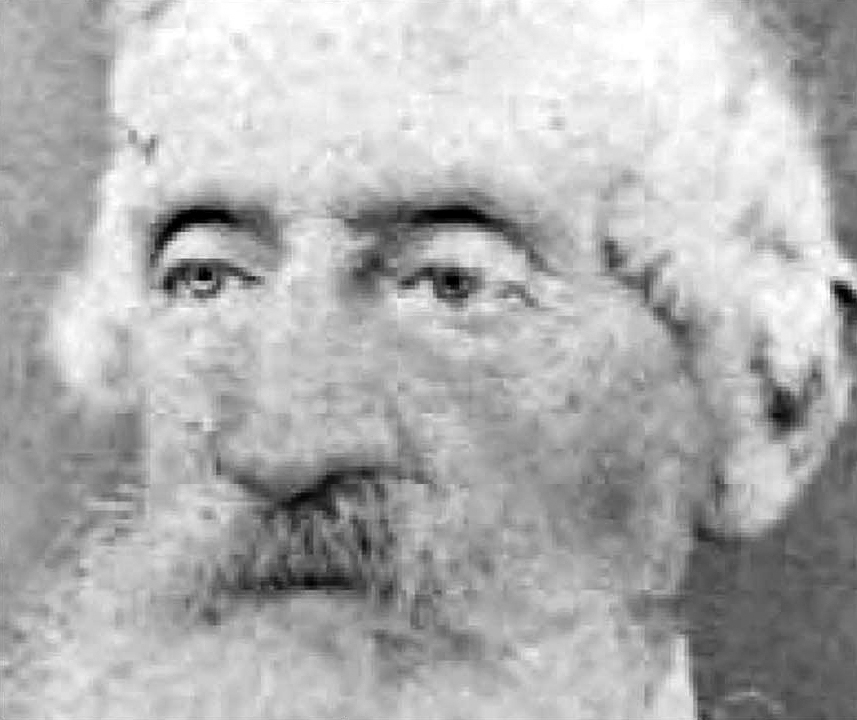
After a fruitless search for coal in South Australia in 1849, Dr George Hermann Bruhn, a 41-year-old German physician, chemist, artist and geologist, switches his interest to gold and treks to Victoria alone, heading to the rugged mountain ranges around Daylesford in his quest. Finding only a few tiny specks, he asks locals in the Pyrenees area (15 miles from Clunes) for advice and is introduced to Donald Cameron. In a remarkably generous gesture, Donald shows Dr Bruhn the quartz reefs he and his brother-in-law William Campbell had found at Deep Creek in Clunes in March the year before. Then Dr Bruhn meets young Irishman James Esmond who had come to Australia after trying his luck in California during the gold rush (but arriving too late to strike it rich). However, the 29-year-old Irishman had gained some experience in gold-mining and passes on his knowledge to Dr Bruhn.
1851 – May

35-year-old German traveller, novelist, and adventurer Friedrich Gerstäcker commences the first “official voyage” down the Murray River. Departing from Albury in a canoe made from a gum tree, he will “travel around the world”. Alas he travels less than 100 miles (160 km) down the vast river when the canoe sinks, forcing him to continue on foot and he walks the 700 miles (1,127 km) to Adelaide, “the wildest and most dangerous march” of his life. However, Gerstäcker’s failure to complete the journey on the water will plant the seed that the Murray could be used for transportation.
1851 – Jun
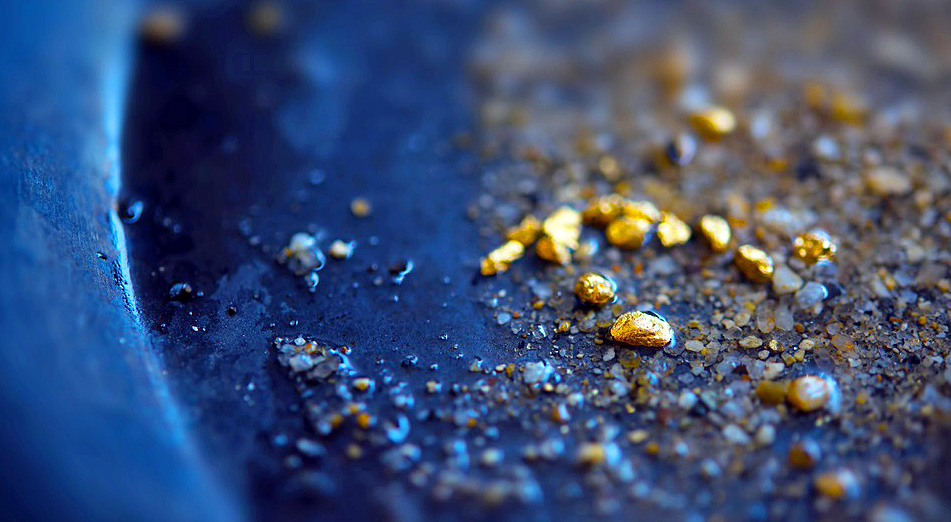
Masses of people are leaving Melbourne to join the newly-discovered goldfields of New South Wales. To stop these desertions, Melbourne Mayor William Nicholson and Governor Charles La Trobe form the Gold Rewards Committee. The Committee offers 200 guineas (about $15,000 today) to “any person or persons who shall discover to them a gold mine, or deposit within 200 miles (320km) of Melbourne, capable of being worked to advantage”. It doesn’t take long for claims to start rolling in – the first just a few weeks later – and within three months, over 250,000 ounces of gold will be obtained, and by 1852 this has increased to a whopping 2,000,000 ounces!
1851 – Jul 1
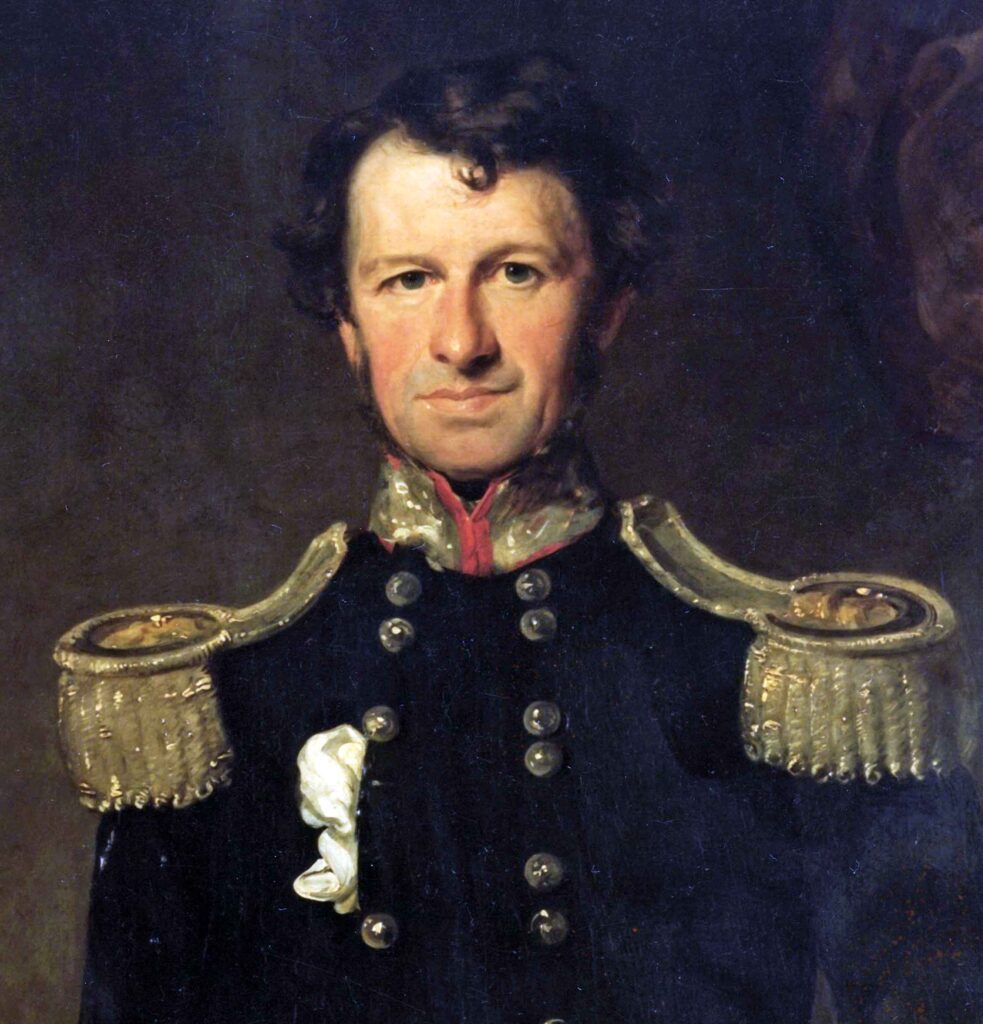
The Port Phillip District officially separates from New South Wales, with Captain Charles La Trobe appointed as Lieutenant-Governor to head the new colony of Victoria. This results in Ovens district squatters winning direct representation in the first Legislative Council of Victoria.
1851 – Jul 5

First Official Gold Discovery in Victoria! 29-year-old Irishman James William Esmond, who had been to the goldfields of California, is now in the settlement of Clunes, 20 miles (33 km) north of Ballarat, where he mines some samples from the quartz, then journeys to Geelong and sells eight ounces of gold to jeweller William Patterson. This is the first commercial purchase of gold recorded in Victoria. Patterson quickly reports the discovery.

| While the original ‘Gold Rewards Committee‘ never actually pays anyone, the Victorian Govenment will later reward James Esmond £1,000 (about $123,500) for organising the first sale of gold, and for introducing Californian gold extraction techniques to Victoria, although he will later claim he had been ‘short changed’ and should have received more. William Campbell will also receive £1,000 for his initial discovery, and Dr George Bruhn will be rewarded with £500 (about $61,750) for his prospecting exploration around central Victoria, and £1,000 is paid to Louis Michel for his discovery at Warrandyte. (see below) |
1851 – Jul 17

Following James Esmond’s discovery of gold at Clunes and other discoveries, including Louis Michel’s find near Major Newman’s run at Warrandyte, the Gold Rewards Committee officially announces that gold has been found. “The Committee appointed to promote the discovery of a Gold Field in the Colony of Victoria, have the satisfaction of announcing that unquestionable evidence has been adduced to them, showing the existence of Gold, in considerable quantity, both at the Deep Creek on the Yarra, near Major Newman’s run, and also at the Deep Creek on the Pyrenees near Mr. Donald Cameron’s house.” This news will forever change the colony as thousands of hopeful migrants rush to Victoria and head for the diggings.
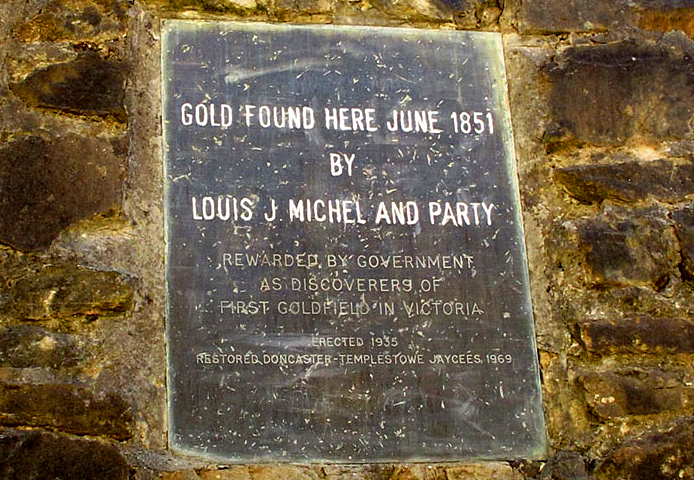
| Although the ‘Gold Rewards Committees’ report says: “Deep Creek on the Yarra near Major Newman’s Run”, this is incorrect as the find is actually on Anderson’s Creek (at Warrandyte) as a later reward to Louis Michel will prove. Major Newman, a former officer of the Indian Army had purchased the property by the creek from Warrandyte’s first white settler, James Anderson. Michel will lead government officials and prospectors to his newly found gold field on August 6th, and his find will be named the ‘Victoria Field’, in honour of the new colony. Within a few days, almost 200 miners are working along the banks of Anderson’s Creek, but the tremendously rich gold fields of Ballarat, Clunes and Bendigo will lure many miners away from Anderson’s Creek, and by December 1851, Warrandyte is almost deserted. However, in 1854, when Michel is finally rewarded with £1,000 by the Victorian Government, interest in the area is revived. By 1855, two stores, an Inn, and an accommodation tent help supply the needs of the 200-odd miners now working in the area again |
1851

Alfred William Eustace arrives in the Ovens Region from England with his wife and two children, gaining employment as a shepherd on the El Dorado Run (near present-day Chiltern) which has been purchased by Jason Withers, who also owns the Ullina Run. With a growing fascination for the landscape around him, Eustace teaches himself to paint, but with canvas and paper not being readily available, he turns to painting on the leaves of the local Red and White Box eucalyptus trees. In 1856 he paints a small picture of the Woolshed gold-rush and during the next few years becomes much admired for his art, holding exhibitions in Albury, Ballarat and Melbourne and, by 1896, Eustace is receiving orders from important European families and acknowledged by Queen Victoria, Emperor Frederick of Germany, the Czar of Russia and the Governors of NSW and Victoria.

| Along with his artwork, Alfred Eustace becomes a renowned poet and writer with a keen interest in spirituality and ornithology. He turns his hand to taxidermy and many samples of his work are now on display at the Burke Museum in Beechworth. |
1852

23-year-old George Briscoe Kerferd from Liverpool arrives in Melbourne aboard the ship ‘Albatross’ and promptly heads to Bendigo to search for gold. After a few months of failing to strike it rich, he gains employment with Bendigo merchants W.M. Bell & Co before deciding to move to the Ovens District.
1852
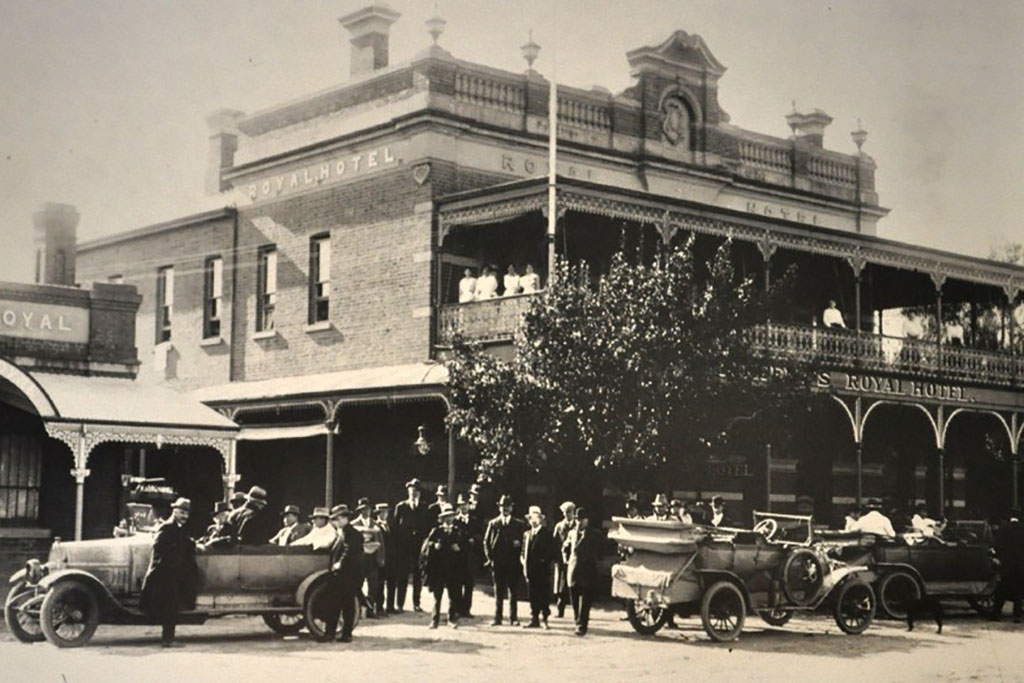
Dr John Gemmell from Wooragee Station – who had purchased a number of blocks of land on Reid Street at Wangaratta’s second land sale on May 15th 1850 – builds a two-storey private brick hospital at 20 Reid Street, the first hospital in the Wangaratta. It will later become the Royal Hotel with John and Mary Crisp as the publicans.
| In 1917 the ‘Royal Hotel’ will be taken over by Anne Edith Pinsent who incorporates parts of the original hospital building, before remodellling and renaming it ‘The Pinsent Hotel’ in January 1923. It becomes a very smart establishment and well patronised for both its accommodation and restaurant. It still stands proudly on Reid Street and operates in Wangaratta to this day. |
1852
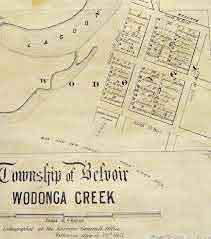
Assistant Surveyor Thomas Wedge surveys the township reserve at Wodonga Creek, naming the new township “Belvoir”. Township allotments of ½ acre each are laid out along the Sydney Road adjoining Paul Huon’s homestead (which he had established in 1836), with 14 agricultural allotments, ranging from 6½ to 28 acres, surveyed at the western end of the township reserve. The first land sales for “Belvoir” are held at Wangaratta on 28th April 1854.
| The indigenous name of Wodonga (with altered spelling) will be restored to the township in 1869. The local Indigenous Waywarra name for the area, “Wordonga”, refers to an edible plant or nut found in lagoons. |
1852 – Feb

33-year-old James Meldrum, an experienced gold prospector and former shepherd and overseer to David Reid, leaves his employment with Reid (which began in 1842) to purchase his own land on the Ovens River at Wangaratta where he runs the Wangaratta Hotel. In his spare time, he begins leading gold prospecting expeditions up to the granite boulders, valleys and gullies of the Mayday Hills and will be the one to suggest gold prospectors Baker and Strickland try their luck at the Mayday Hills (see further entry below). Meldrum is now considered the first person to have faith in there being gold in what will become Beechworth. He will pass away on the 15th of February 1865 at the young age of 47.
| On December 13, 1853 James Meldrum sells his ‘Wangaratta Hotel’ to John Rogers who thinks he will make an easy fortune from the travellers on the way to and from the Beechworth gold rush, but due to the numerous sly grog shops and licensed premises that quickly spring up closer to the diggings, John Rogers fails and transfers the license for the ‘Wangaratta Hotel’ back to Meldrum for a much lesser price. Meldrum then takes a small brick building in Wangaratta, originally used as a fellmongering establishment, and converts it into a brewery and for several years the brewery’s profits exceed £400 per week. With his popular hotel and his successful brewery, Meldrum will quickly accumulate a fortune of £50,000 … which he will later lose. Meldrum Street in Beechworth (above) will be named in his honour. |
1852 – May 1

Visiting the district on the first day of May, Lieutenant-Governor Charles La Trobe, accompanied and guided by Lands Commissioner Henry ‘Long’ Smythe, officially names the area around present-day Beechworth the ‘Mayday Hills’ (just as David Reid had done 13 years earlier), although for many years people simply refer to the area as ‘The Ovens’ after the Ovens River that flows through nearby Wangaratta.
1852 – Jul
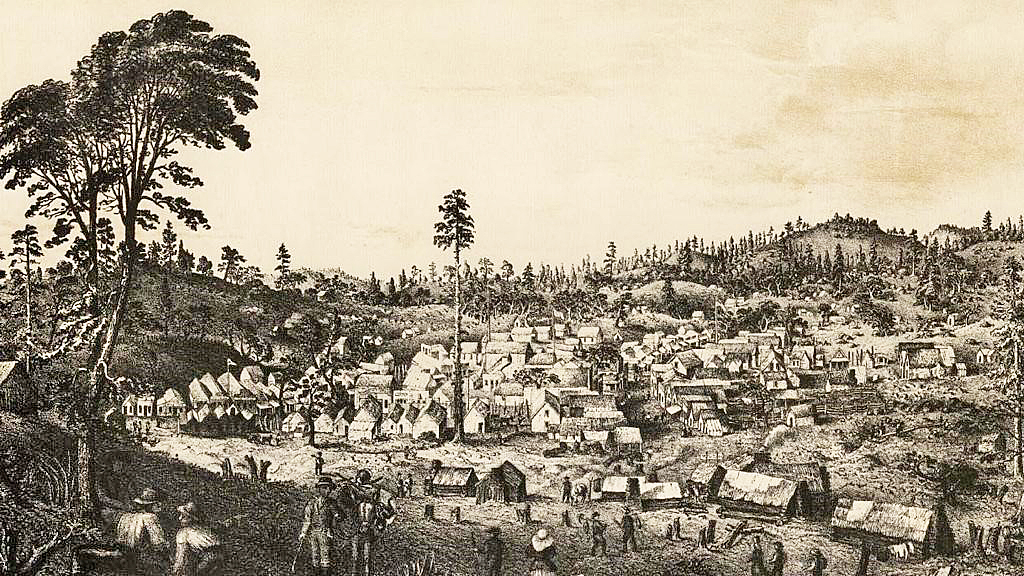
With their recent (and moderately successful) experience of gold mining at the 1849 Californian gold rush, two British gold prospectors named Baker and 25-year-old Yorkshire-born John Strickland (below) arrive in Wangaratta where they meet James Meldrum at his ‘Wanagaratta Hotel’. With his own interest in gold prospecting – and his 10 years’ experience working as the overseer of David Reid’s property – Meldrum advises the two young men to travel the 23 miles (37 km) to Reid’s property at Spring Creek to look for gold, giving them local knowledge and supplying them with rations for a few weeks. When they arrive, David Reid grants them permission to prospect for gold on his run, including the surrounding hills, guided by one of the Reid’s shepherds named William Howell.

| Baker and Strickland had travelled overland from Omeo to Wangaratta before they head to what will become the gold rush town of Beechworth. |
1852 – Aug 3

After 15 days of futile searching, Baker, Strickland and Howell (David Reid’s shepherd) sink a series of shallow holes near William Howell’s hut beside Spring Creek, upstream from Reid’s Creek where, to their delight, they find a pint-pot amount of gold at Cadman’s Point, 80 yards (74 metres) upstream from the present-day Newtown Bridge near the foot of Newtown Hill (where the current Shell Service Station stands).
1852 – Aug 3
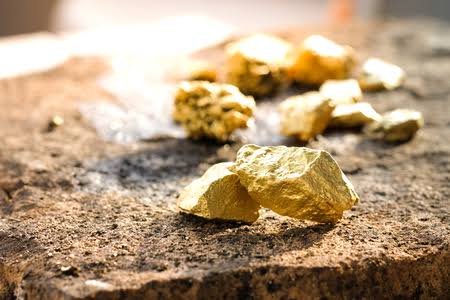
Baker, Strickland and Howell move downstream towards the Woolshed Falls where David Reid, inspecting his property, meets them. He asks if they have had any luck in their search for gold. William Howell replies “Oh, just middling” and shows Reid a small amount of the gold they have found. Reid dismisses their find as “mere moonshine”. Then the three men reveal the full extent of their discovery … a pannikin (pint-pot cup) containing 14 pounds of pure gold (worth over $40,000 today)! News of their gold discovery spreads like wildfire and a new rush to ‘Mayday Hills’ (aka ‘Spring Creek’) begins, with miners rushing from Bendigo, Ballarat, Castlemaine and other goldmining settlements in Victoria.
| The rush for gold in the area is an unexpected development for the 32-year-old David Reid. As the miners literally swarm over his land he realises it will ruin its pastoral value. For a time he sells meat to the new arrivals and establishes a store and a gold-buying business, but by mid-1853 Reid abandons his land at ‘Mayday Hills’ to the thousands of hopefuls who now spread over the alluvial gold fields in search of their fortunes. |
1852 – Sep
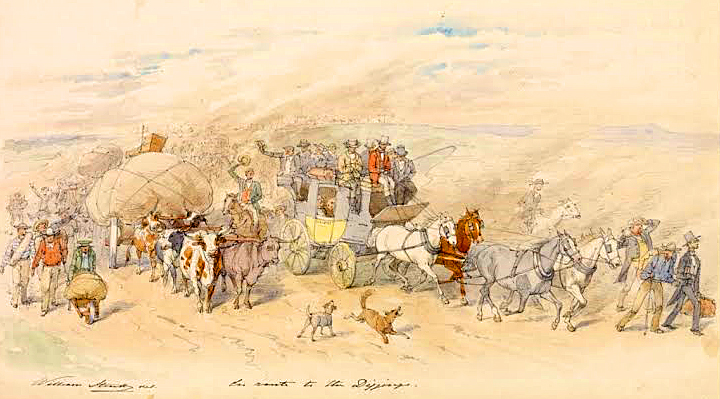
The rush is on towards the Spring Creek goldfields, with prospectors (both on foot and on horse), government troopers, and wagons with supplies, streaming up the ‘Melbourne to Sydney Road’ which is up to one mile wide in places. The suddenly busy road, which goes via the small settlement at Greta – a wayside stop with the small Greta Inn for travellers who are channelled past it as they negotiate the gap in Futter’s Range – soon becomes cluttered with overnight tent towns. Once the excited prospectors arrive at Spring Creek, it doesn’t take long for many to make their precious finds, with the first gold deposits being mostly found in loose nugget and powder forms in the gold bearing soils.
1852 – Sep
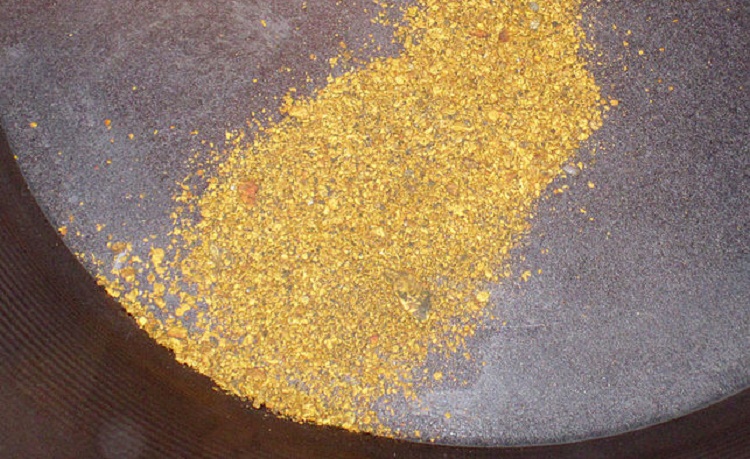
Just days after arriving, Peter McCann is considered the ‘Mayday Hills‘ luckiest early miner, washing an incredible £800 worth of gold from Spring Creek in just two weeks (around $100,000 in today’s money)! By the end of October around 1,620 miners have descended on the new diggings and many men make good quick finds, especially from claims in the bed of the creek. Gold discoveries of £15, £20, and £30 ($3,566) a week-per-man is, at one time, quite common, while very few men fail to raise more than £4 to £5 (approx. $600) a week.
| The success of small parties working together, and the difficulty of working the ground in the upper part of the creek, will lead to the formation of two joint stock companies for the purpose of thoroughly exhausting the deepest and wettest ground. The first of these companies is the ‘Union Mining Company’ which starts with a capital of £2400 – 12 shares of £200 each – in September 1854, followed by ‘The El Dorado Mining Company’ established in October 1854 with a capital of £2, 000 – made up of 100 shares at £20 each. |
1852 – Nov 1

A ‘Gold Commissioner’s Camp’ is established on the northern bank of Reid’s Creek which helps to consolidate its location as the central hub of the rapidly growing settlement. Assistant Gold Commissioner 62-year-old James Maxwell Clow selects the location as it is high enough to overlook the diggings on the other side of the creek, and also high enough to be safe from any marauding miners. With all the trappings of order and authority, the camp features a near row of official tents enclosed by a post-and-rail fence, guarded by sentries.

| In its first two days of operation, Assistant Gold Commissioner Clow will issue a staggering 637 gold mining licences! But not everyone is happy about having to pay for a licence. |
1852 – Nov 3

Protected by five mounted police, the first ‘Ovens Gold Escort’ leaves the Mayday Hills and Spring Creek diggings carrying 2,453 ounces of gold. Subsequent Gold Escorts from Beechworth will go to carry 5,000, then 10,000, then 20,000, then up to 30,000 ounces (worth around £109,000) at a time!
| Over the following 14 years, an incredible 4 million ounces of gold will be taken from the Beechworth gold fields. |
1852 – Nov
The diggings are now sprawling four miles downstream from the newly established Commissioner’s Camp.
1852 – Nov
A few determined miners attempt a search for gold at the ‘Woolshed’ on Reedy Creek, about 6 km below Beechworth, but within a few weeks the difficulty and expense of working at this location means that mining at the ‘Woolshed’ is abandoned. (It is not until the close of 1853 that the ‘Woolshed’, which will soon obtain a most enviable notoriety, becomes popular again).
1852 – Nov

As more and more gold prospectors stream up the Melbourne-to-Sydney Road towards the diggings at Spring Creek (Beechworth) – with most having to pass through the small township of Wangaratta at the junction of the Ovens and King Rivers (38 km from Beechworth) – Wangaratta experiences astonishing growth with its fledgling businesses quickly doing a roaring trade. James Meldrum’s Wangaratta Hotel earns him up to £150 per day from bar and dining takings alone! The hotel’s upstairs ballroom is continually packed with merry-making miners, and a local brewer quickly capitalises on the action, undercutting the price of brands brought up from Melbourne. Local produce finds a ready market, and carters of goods are in much demand, as are the services of blacksmiths, tradesmen, butchers and general storekeepers. Wangratta will soon have its own churches, a Court House, Telegraph Office, Library and Hall, and even a Racecourse. While the first Wangaratta school had opened in 1848, it now swells with new enrolments and has to be enlarged.
1852 – Nov
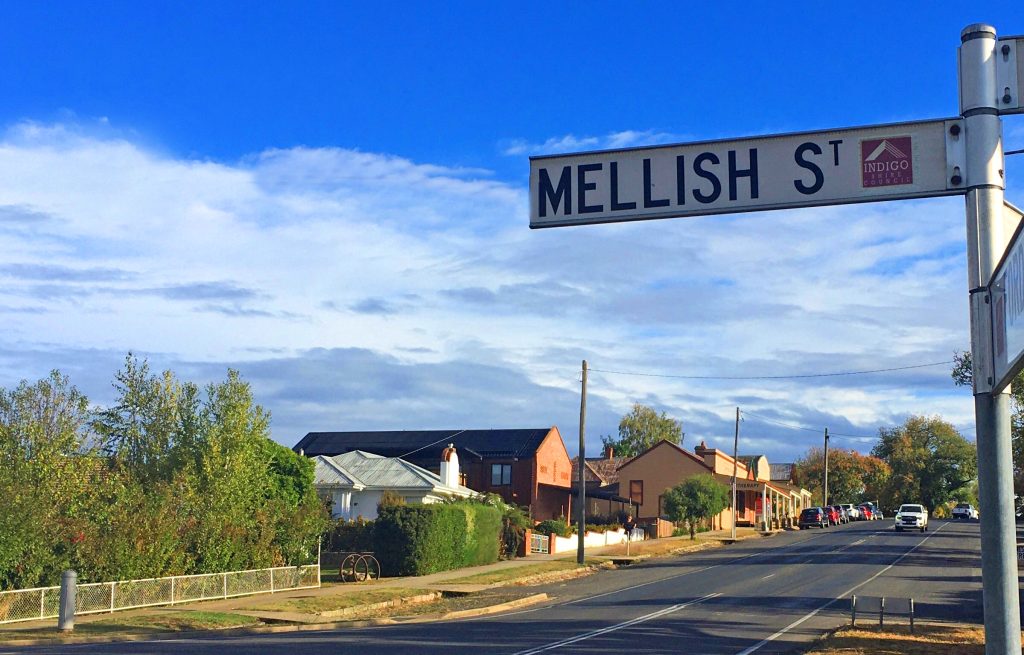
Hearing about the rush for gold at ‘Mayday Hills’, Richard Mellish leaves Melbourne with fully loaded drays and arrives at the start of November to establish the settlements first ‘general store’. The spot he chooses is close to Scott’s Bakery – the settlement’s first bakery business – beside the main road from Melbourne, where the hut of David Reid’s shepherd had stood, close to the western road to Reid’s Creek and the Spring Creek diggings.
| Richard Mellish will be the first person elected to the first Beechworth Municipal Council in 1856. Mellish Street is named in his honour and is located very close to where his first General Store once stood. |
1852 – Nov
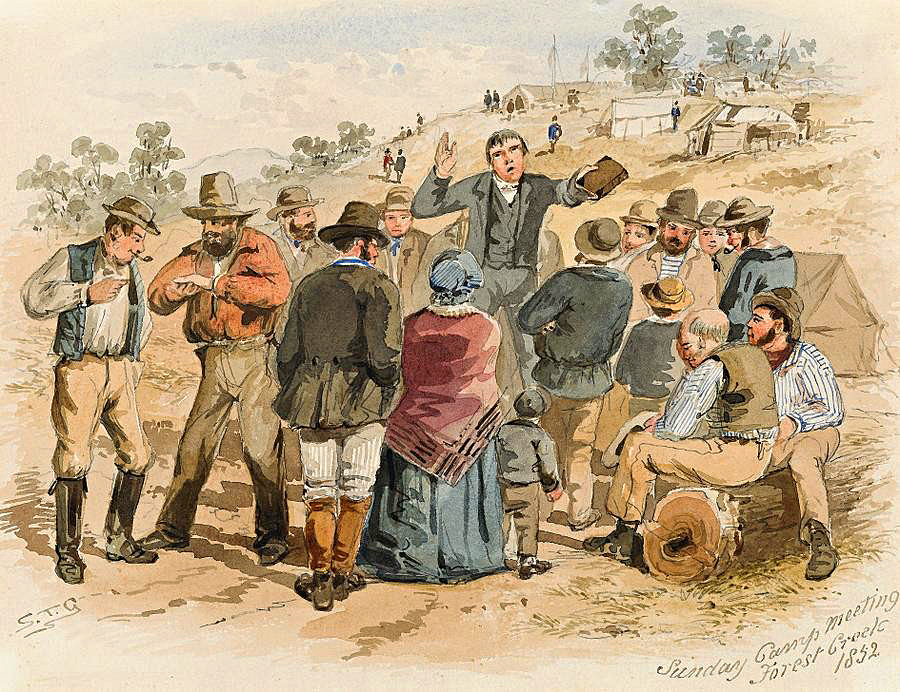
The first Presbyterian church services take place on the Mayday Hills goldfields, conducted by a visiting minister for the benefit of the Scottish and Ulster Presbyterians who have been rapidly arriving and settling in the ‘Mayday Hills’ township.
1852 – Nov 17

The first major confrontation on the May Day diggings occurs when a group of newly arrived diggers gather at the ‘Gold Commissioner’s Camp’ on the northern bank of Reid’s Creek demanding to meet with Assistant Gold Commissioner James Maxwell Clow to protest about the Victorian Gold Licence. They refuse to pay the required “one pound, 10 shilling licence” before they have even started looking for gold. Clow makes it clear – “no gold licence, no digging for gold”.
| The law states that a miner’s Gold Licence must be paid for and then carried at all times. Even if a miner loses his licence or it is destroyed in dirty or wet conditions, very little leniency will be shown, and punishments range from an on-the-spot fine or even gaol. |

1852 – Nov 19

6’ 5” tall Henry Wilson Hutchinson ‘Long’ Smythe arrives to take up his newly appointed position as resident Commissioner in charge of the Ovens goldfield, joining James Maxwell Clow (above) as his Assistant Commissioner. Their work involves considerable responsibility as they are expected to enforce (the unpopular) gold licences over a wildly fluctuating population, receive and guard gold for escort to Melbourne, settle claim disputes, occasionally perform magisterial duties, and maintain law and order throughout the district. 32-year-old Smythe and 62-year-old Clow will soon be joined nine police officers, along with George Mitchell Harper (Police Magistrate) and William Alexander Abbott (the Magistrate’s Clerk of the Bench); Lieutenant Templeton (Mounted and Foot Police) and his Subaltern, James Mackay; and Dr Henry Green (assistant colonial surgeon and coroner – see next entry).
| Smythe decides that a lock-up and a 30-stall horse stable are required and orders 20 more police officers to reinforce the nine already at his disposal. |
1852 – Nov 25

Doctor Henry Green – Assistant Colonial Surgeon and Coroner – is the first doctor to arrive at Mayday Hills and sets up his medical tent at the Commissioner’s Camp. He will be kept very busy, dealing with everything from dysentery, trachoma (chlamydia infection of the eyes), diarrhoea, malnutrition, scurvy and all manner of injuries and illnesses in between. Sadly, Dr Green will last less than four months before succumbing to typhus fever.
| Not to be confused with typhoid, “typhus fever” is a bacterial disease spread by fleas, mites and body lice and are often found on small animals like mice, rats, cats and dogs … and there are certainly numerous flea-ridden dogs running around on the goldfields. People can also carry the infected bacteria on their clothes, skin or hair, and the antibiotics needed to stop typhus fever will not be available for another 90 years. |
1852 – Dec

Gold is discovered near the junction of the Yackandandah Creek and Commissioner’s Creek close to what is known as ‘Rowdy Flat’. Soon the creek along its whole length – from its source at Stanley to its entry into the Kiewa River – is covered with prospectors.
1852 – Dec

Successful miner, storekeeper and entrepreneur 26-year-old Joshua Cushman Bigelow (from Maine in America) becomes the first to discover a small amount of gold about 6 miles south-east of Beechworth in the district known as ‘Snake Valley’. As the area is reached by an uphill nine mile track from Beechworth, it will become known as the ‘Upper Nine Mile’. A proper ‘rush’ to the area will not begin until March 1853.
| The district is now the home of the small town of Stanley, named after Lord Stanley (Edward Smith-Stanley, 14th Earl of Derby) who serves three terms as British Prime Minister (1852, 1858, 1866). |
1852 – Dec

The owners of a little green cradle wash out 7 pounds of gold but, to protect their spot, tell others it comes from a flat south of Spring Creek so miners rush to the location – which looks like a stone quarry – but it yields very little gold, so it is promptly dubbed the ‘Pennyweight Flat’. This flat area will soon be selected as the location of Beechworth’s first racecourse. Today ‘Pennyweight Flat’ is still mostly unoccupied land (below).

| A ‘pennyweight’ is the smallest measurement of gold., equivalent to 1/20th of an ounce. |
1852 – Dec
The first Methodist church service is held in a tent on the diggings at ‘Madman’s Gully’. Its first Methodist Pastor is Mr C. Williams from Tasmania.
1853 – Jan

Gold fever has well and truly hit the Ovens diggings, and the population has swelled from 1,500 in November to over 8,000 miners just two months later! The miners are all now trying their luck at ‘Mayday Hills’, with hundreds upon hundreds of hastily erected tents spreading upwards from the slopes on both sides of Spring Creek. The journey from Melbourne, on foot, takes about three weeks.
1853 – Jan
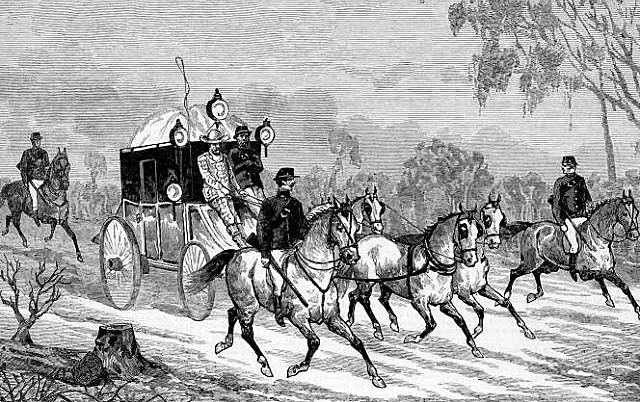
Again protected by mounted police, the second ‘Ovens Gold Escort’ leaves the diggings, this time carrying a massive 19,400 ounces of gold to Melbourne.
1853 – Jan

Assistant Commissioner Edwin Meyer from the ‘Mayday Hills’ travels to nearby Yackandandah where he issues the first gold licenses for the gold diggings spreading beside Yackandandah Creek. Within 6 months, the population of Yackandandah increases from 50 to 150.
1853 – Jan
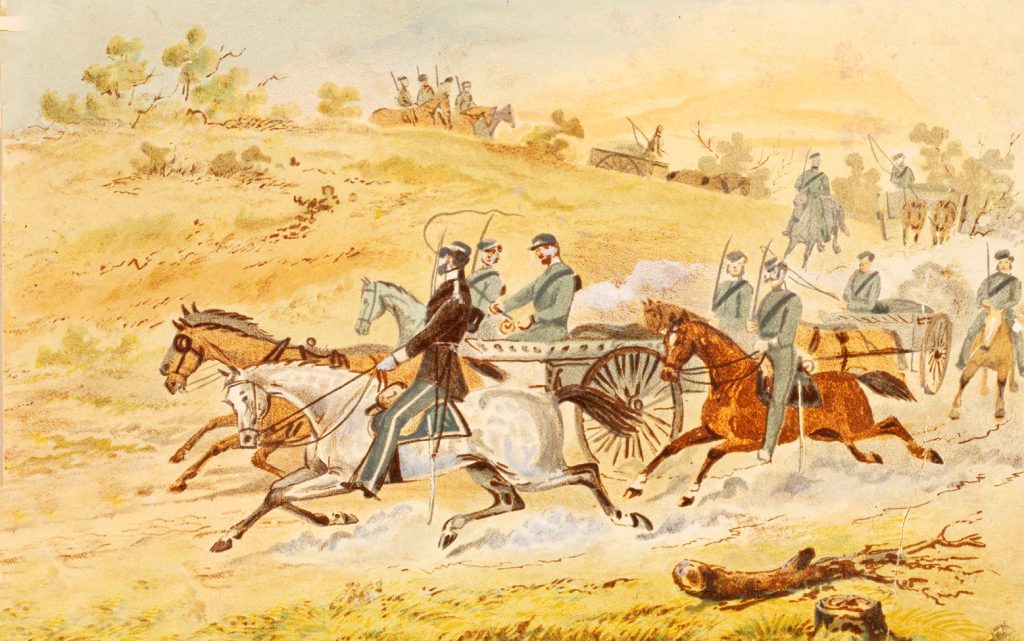
Not be outdone by Melbourne, the newly established Sydney Gold Escort Company launch a regular heavily guarded escort service.
1853 – Jan

After excitedly reading about Australia’s gold rush in his hometown of Oakham, Massachusetts in America, 20-year-old Hiram Allen Crawford arrives in Melbourne after a 105-day voyage aboard the ship ‘Texas’. After trying his hand – unsuccessfully – at gold mining at Back Creek near Bendigo, he returns to Melbourne where he meets fellow Americans Adam Snow and Joshua Cushman Bigelow (the man who had first discovered gold at Stanley in December 1852) who plan to establish a store on the Ovens Goldfields and they invite Hiram to travel with them to Beechworth. He accepts their offer, arriving in Beechworth on his 21st birthday – 22nd of July 1853.
1853 – Feb 3
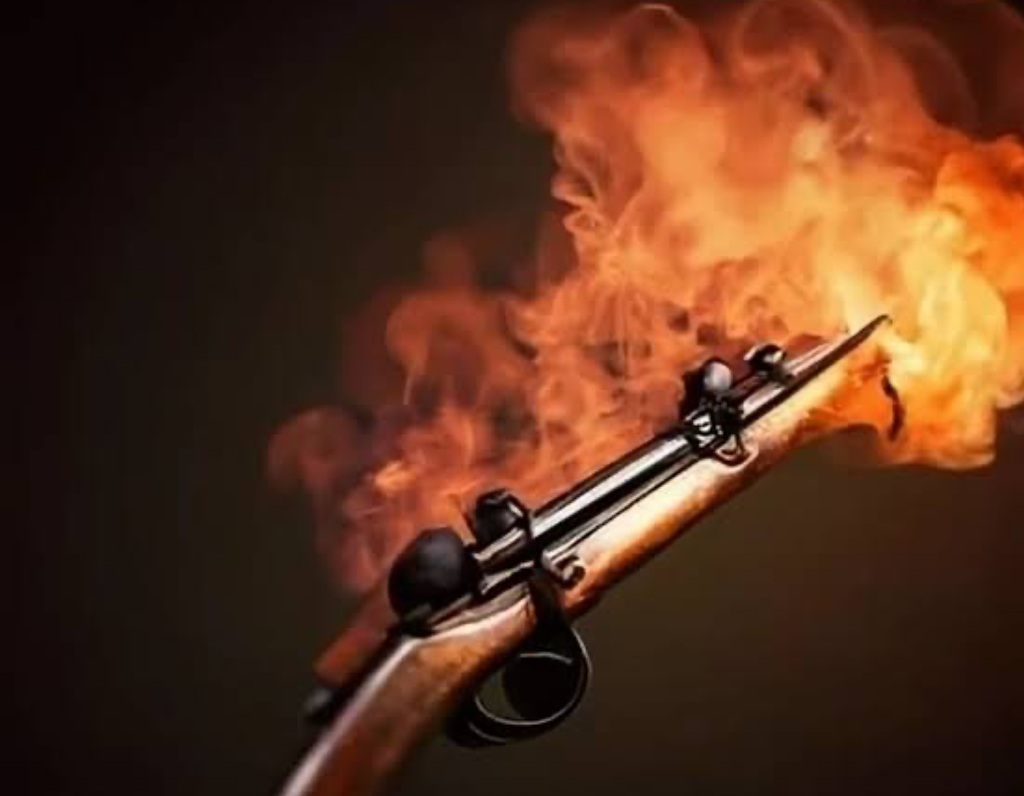
A party of police – attempting to resolve a disputed claim at the Reid’s Creek diggings – climb down into a pit when Constable Hallet falls, accidentally discharging his musket which strikes and kills a miner named William Guest. Hundreds of angry miners rush to the scene and Constable Hallet is almost beaten to death until rescued by other, more cool-headed miners, allowing the police to retreat. However, the anger grows and soon the number of unhappy miners grow to well over a thousand and they all march to the Assistant Commissioner’s Camp, where Assistant Commissioner Edwin Meyer is pelted with rocks, shot at, and very nearly lynched, the mob going so far as to prepare a rope and noose! They also threaten to hang Constable Hallet. The disturbance is eventually quelled, and no charges are ever laid.
| The Reid’s Creek diggings quickly become well known for the number of fights and violent disputes caused, in part, by growing dissatisfaction and unrest regarding the system of mining licences and the method used to calculate licences. 15 murders occur around Reid’s Creek in the first six months of settlement. |
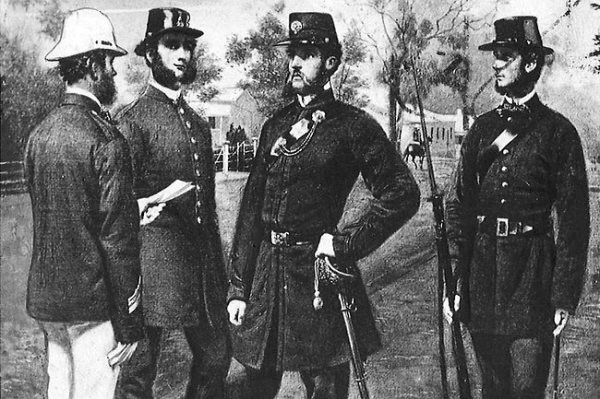
| Prior to the establishment of the Victoria Police Force in 1853, several separate policing groups operate in Victoria, including the Gold Escorts, the Gold Fields Police, the Rural Bench Constabulary, the Water Police, the Border Police, the Melbourne Metropolitan Police, the Geelong Police, the Mounted Police, and a Native Police Corps. |
1853 – Feb 9

Frederick Brown arrives at ‘Mayday Hills’ as an agent for the Port Phillip Gold Mining Co. and quickly becomes involved with all business matters of the rapidly growing community.
| By 1855, Brown is an important member of the local community, operating a gold agency in the township with an Irishman, Michael Monk, and by 1856 is also an agent for the ‘Liverpool and London Fire and Life Insurance Co.’ Brown & Monk purchase several township allotments and for three years manage the general auctioneering firm of J. H. Gray & Co. In September 1856 Brown will be elected to the first Beechworth Municipal Council, supervising financial proceedings, assisting with the framing of by-laws and plans for the municipal waterworks and guiding the Beechworth Council as chairman until 1860 when he returns to England to study law, returning a few years later to set up a legal practice in Camp Street and re-joining the Beechworth Council. |
1853 – Feb

Although no official courthouse has yet been built in Beechworth, and with crime on the rise as the population swells, court cases begin to be heard in a tent at the ‘Gold Commissioner’s Camp’ when ‘Mayday Hills, Ovens River’ is appointed a ‘Court of Petty Sessions’, before being renamed ‘Beechworth Court’ in June the same year. Beechworth is also appointed a ‘County Court’ and ‘Court of General Sessions’, to begin proceedings in 1854.
| A ‘Court of Petty Sessions’ hears both criminal and civil cases of minor offences and disputes. Over 100 years later, these courts will be renamed ‘Magistrates’ Courts’ (in 1971). |
1853 – Feb

There is a lack of an adequate water supply, sewerage, sanitation or basic conveniences on the goldfields which leads to an outbreak of typhoid. As a result of the lack of hygiene and the prevalence of disease, Doctor Harry Green, the first doctor sent to the diggings, dies only four months after his arrival.
| Although the majority of people on the goldfields are men, there are also lots of women and children, brought by their husbands and fathers. Children will suffer the most … Between 1853 and 1860, an average of one child per week will die on the diggings of diseases such as scarlet fever, dysentery, diphtheria, measles, whooping cough, atrophy of the brain and typhoid on Victoria’s goldfields. |
1853 – Mar 2

24-year-old Fredrick Brown (above), Richard Mellish, Charles Williams and other local business owners who have come to sell goods to the miners, send a deputation to the Victorian Government with a request that the ‘Mayday Hills’ goldfields be surveyed, and an official township established. The Government agrees and promptly dispatches experienced Government Surveyor General, 47-year-old George Douglas Smythe to ‘Mayday Hills’ and his survey takes place from April to June, marking out roads, building allotments and reserves based on a clear grid plan.
| Surveyor General George Douglas Smythe is the older brother of Henry Wilson Hutchinson ‘Long’ Smythe (Commissioner in charge of the Ovens goldfield) and brother-in-law of Captain William Lonsdale. |
1853

23-year-old Lincolnshire-born King William Thompson Soulby arrives in Melbourne on board the ship ‘Sir Henry Harding’. A compositor by trade, he quickly gets a job at the The Age newspaper (alongside John Sitch Clark) before moving to the Melbourne Herald. Upon the urging of John Sitch Clark – who had become a landowner in Beechworth in April 1865 – Soulby departs Melbourne and arrives in Beechworth in May to work on The Ovens and Murray Advertiser under Richard Warren, and soon becomes one of the town’s major figures.
| A few weeks after his arrival in Beechworth – on June 16th 1856 – Soulby will marry John Sitch Clark’s sister Martha Margaret Clark at the home of Beechworth’s Wesleyan minister, the Reverend John Christian Symonds. The wedding certificate is the last time Soulby use his first Christian name of ‘King’, favouring W. Thompson Soulby. |
1853 – Mar
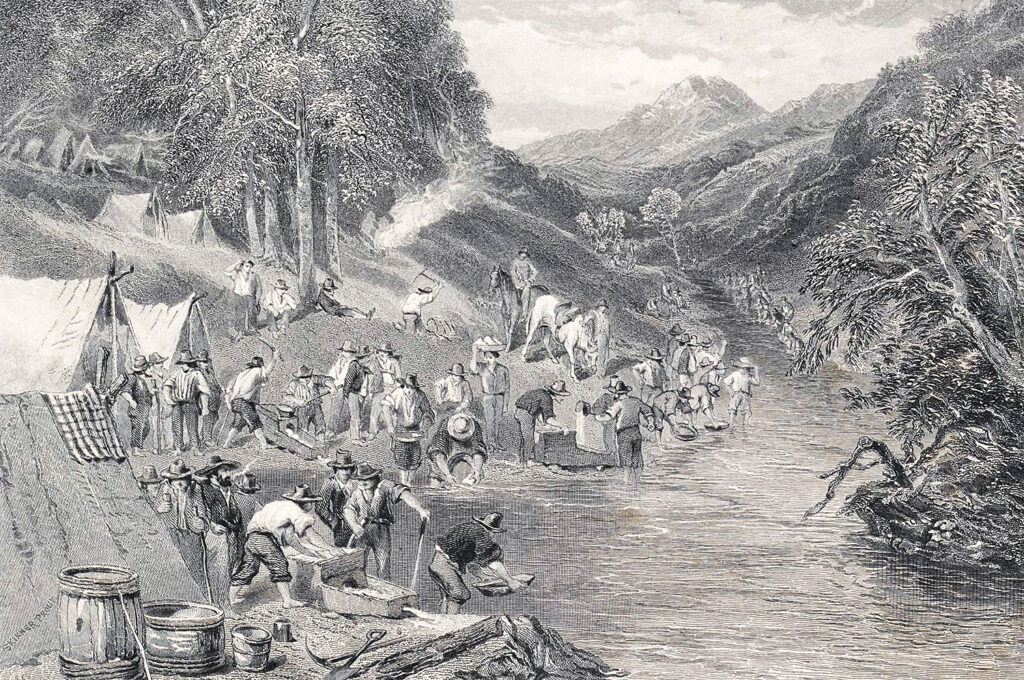
People rush to a new find at ‘Madman’s Gully’ just south-west of Beechworth which quickly proves highly lucrative. This is followed, in a matter of days, by second, bigger gold discovery at ‘Nine Mile Creek’.
| According to one local newspaper story, the Gully got its name as follows – “When it became known that gold was plentiful at this gully (Madman’s Gully) a great number of persons moved there after their day’s labour, and the following morning some altercations about the ground were going on, when one of the diggers, stark naked, ran out of his tent, with a number of small sticks in his hand, and commenced marking out the ground for himself and others, threatening vengeance at the same time to anyone that would oppose him or be dissatisfied; Hence it is said, is derived this singular name, which is likely to pass down to posterity.” |
1853 – Mar

6 miles south-east of Beechworth – at Nine Mile Creek – miners rush to work the ground looking for gold at Long Dick’s Gully. Within weeks more gold will be found at nearby Wombat Gully followed by Nuggety Gully and then, in June 1853, at Europa Gully.
1853 – Apr 2
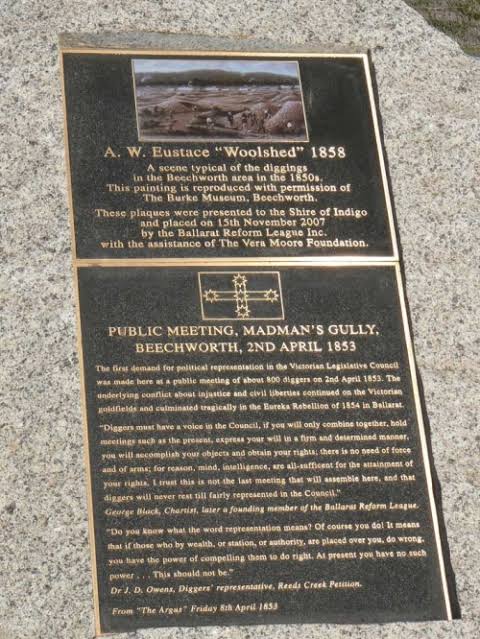
Around 800 miners gather at Madman’s Gully, just south-west of Beechworth, to hold a public meeting where it is agreed to make a demand for political representation in the Victorian Legislative Council.
| The underlying conflict about injustice and civil liberties will continue to grow on all of Victoria’s goldfield and culminate, tragically, in the miner’s rebellion against the government at the Eureka Stockade in Ballarat in 1854. |
1853 – Apr
‘Nine Mile Creek’ and ‘Madman’s Gully’ quickly become popular locations for Scottish, and later Chinese, miners. At the same time, gold is found in Hurdle Flat, Buckland Gap (reef) and a location near Reid’s Woodshed immediately below Reid’s Creek.
| One of Nine Mile Creek’s most famous – and outspoken – Scottish miners is John Scarlett who regularly writes to newspapers, calls meetings, and voices his opinions. Known as “The Nine-Mile Warrior” and the “Water Squatter”, he is originally a ‘dry miner’, advocating rights for this type of operation, then – on acquiring access to water – he switches and becomes an advocate for ‘wet mining’ to the exclusion of dry operators! He stands for mining board elections and then Victorian parliament in 1859, eventually becoming Secretary for the local roads board. In 1871 we will be charged with bigamy. |
1853 – Apr

Gold overtakes wool as Australia’s main export.
1853 – Apr 19
James and Sarah Crampton, who had arrived at the Spring Creek diggings at the start of the year, join the rush up to Nine Mile and, after pitching their tent, Sarah gives birth to their son James, who becomes the first white child born on the Nine Mile diggings.
1853 – Apr

After a year of gold-prospecting in Bendigo, George Briscoe Kerferd moves to Mayday Hills with his new wife Ann (with whom he will have 10 children). George sets up business as a wine and spirit merchant and by 1855 he has started a successful brewery. He will become a very important part of the growth of the new town and one of its most notable residents.
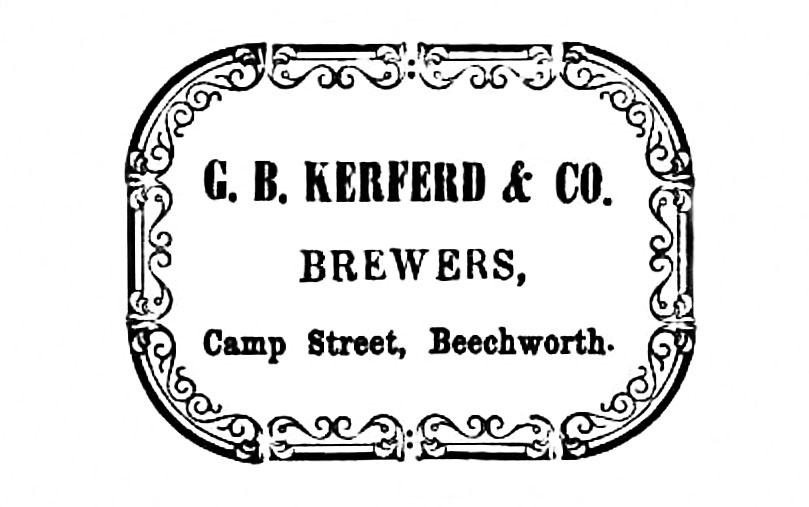
| Confident that Beechworth will become the permanent centre of a thriving mining and farming district, George Kerferd works with energy and imagination for the development of the town. First elected to the Municipal Council in May 1857, he is chairman for three terms between 1858 and 1864, and the driving force behind the establishment of the district hospital in 1856-57 and the ‘Benevolent Asylum’ in 1861-63. He is largely responsible for the town’s unusual water scheme which, though eventually successful and still in use, is not completed until 1874 because of engineering and funding problems. The water storage area is now known as Lake Kerferd. He will graduate to be a Member of Victoria’s Legislative Assembly, a Judge of the Supreme Court of Victoria and, eventually, the 10th Premier of Victoria. He will also be responsible for bringing the railway to Beechworth. |
1853 – May 1
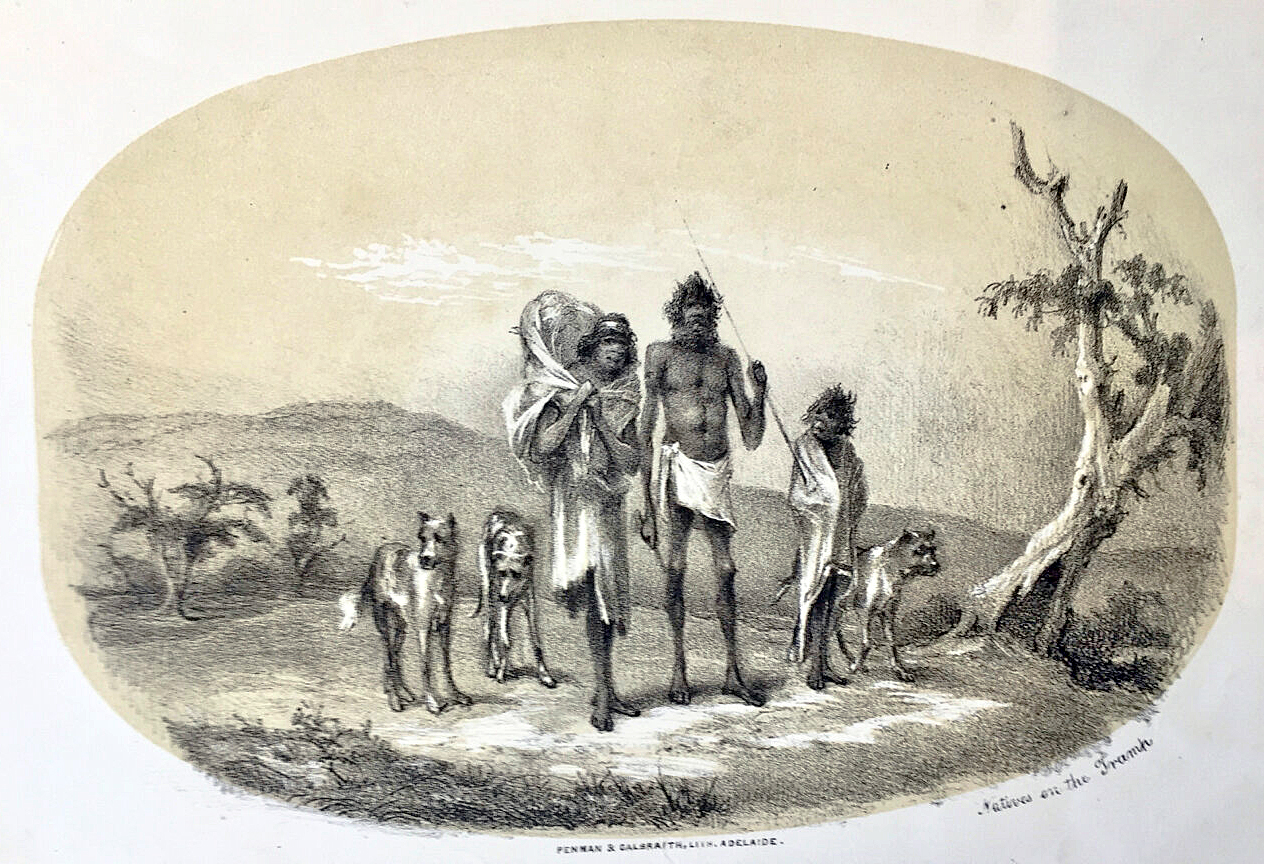
Commissioner of Crown Lands for the Murray district, Henry ‘Long’ Smythe estimates that there are still 399 Aboriginal people living in the Ovens goldmining region, and yet as Smythe notes, “they are not attracted by the prospect of gold due to their natural indolence”.
| Henry’s sister Martha marries Captain William Lonsdale in 1835 and the following year Lonsdale is appointed first resident police magistrate at Port Phillip (Victoria). ‘Long’ Smythe is a founding member of the Melbourne Club, a justice of the peace, and a police magistrate. Smythe drowns in the Broken River on May 8th 1853. |
1853 – May 4
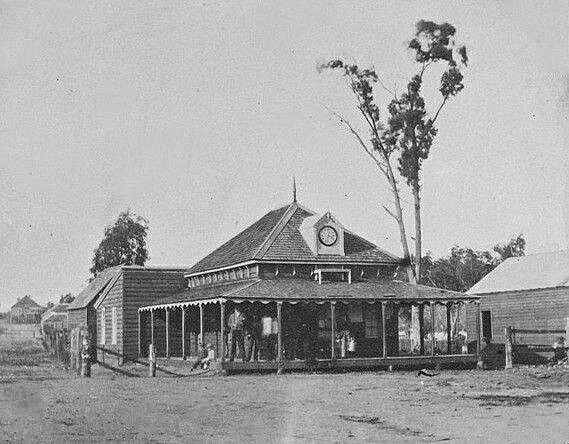
The first Post Office, essentially a rough slab hut, is opened at the Spring Creek diggings. Known as Spring Creek Post Office, Ovens Goldfields, it stands on the Police Reserve and Government Camp, at the spot where the Gold Office and Sub-Treasury will be built between 1857 and 1860. A few months later it will be replaced by a more substantial timber building further south, with a clock later added (image above). It stands on the corner of the soon-to-be-named Camp and Ford Streets. Postal business is carried out on the veranda. By the following year, mail begins to travel regularly between Albury and Melbourne via Beechworth.
| In the early days of the post office in Beechworth, it was not unusual for the postmaster to have to deal with up to 500 unclaimed letters a month waiting to be collected by miners spread over the surrounding goldfields. |
1853 – May 8

40-year-old Henry Wilson Hutchinson ‘Long’ Smythe – the Commissioner in Charge of the Ovens Goldfields – meets an untimely death when he drowns attempting to cross the flood-swollen Broken River at Benalla.
1853 – May 10

William Turner arrives on the Beechworth goldfields to take over as Commissioner in Charge of the Ovens Goldfields following the drowning death of Henry ‘Long’ Smythe. William Turner is married to Mary Anne Smith and together, while they are in Beechworth, they have a son, Sydney Charles Beechworth Turner (above). Although the Turners will depart Beechworth for Ballarat in 1856, William Turner has made himself so popular and respected as the district’s Commissioner and Mining Warden that Beechworth diggers engrave and decorate a gold cup (below) and present it to him upon his departure.

1853
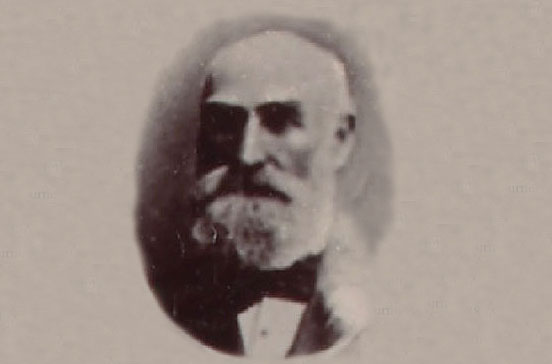
21-year-old qualified pharmacist and druggist George Gammon – who had arrived in Victoria from England in October 1852 with his wife Kate Burgis – settles in Beechworth where he establishes his Medical Hall in a small wooden building at 55 Ford Street.
| In 1857, George Gammon will sell his successful ‘Medical Hall’ to William Henry Neuber and goes home to England. But Gammon returns to Beechworth in 1859, buying back his old premises from Neuber and resuming his Pharmacy. George Gammon’s ‘Medical Hall’ is the largest of the several Pharmacies that operate in Beechworth at the time. |
1853
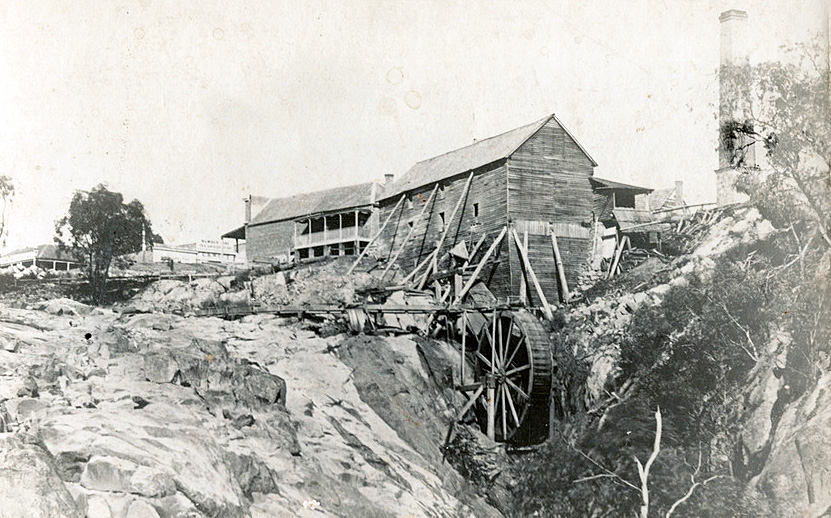
Russian-born Louis Chevalier constructs an impressive wooden water-powered sawmill beside Spring Creek at the top of the Newtown Falls (above), spending two years cutting the tailrace through the solid granite which can still be clearly seen today under the Newtown Bridge. Louis, brother of the artist Nicholas Chevalier, will convert his sawmill to steam in the late 1850s with the timber from the sawmill being used extensively in Beechworth.
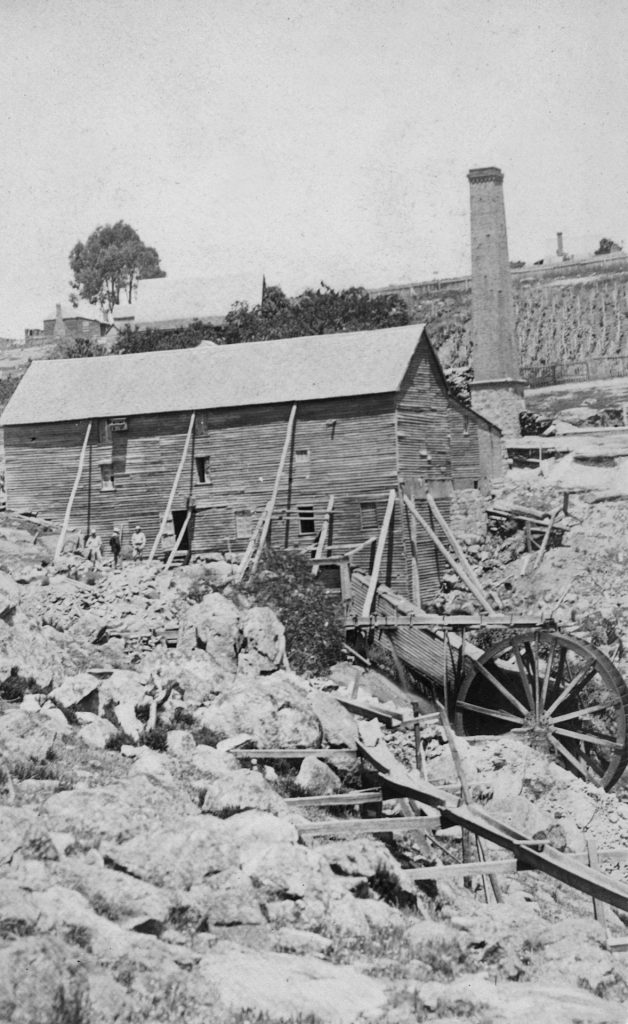
| In 1863 Louis Chevalier imports grindstones from France so that he can convert the mill to flour production, and it will be Beechworth’s main source of flour until it ceases operations in the 1880s. |
1853

Previously an officer on other goldfields, Lieutenant John B. Finch of the 11th Regiment arrives at Mayday Hills as the new ‘Magistrate for the Territory’. He brings with him a ‘military force’ being ‘a detachment of between thirty and eighty pensioners’. George Douglas Smythe will name Finch Street in his honour.
| ‘Pensioners’ are military men who have retired from service and are recruited to assist police on the goldfields due to the shortage of regular police officers. Most of the police have deserted to the Victorian goldfields to try their luck – on one single day in November 1851, 50 of the 55 Melbourne City Police resign! |
1853
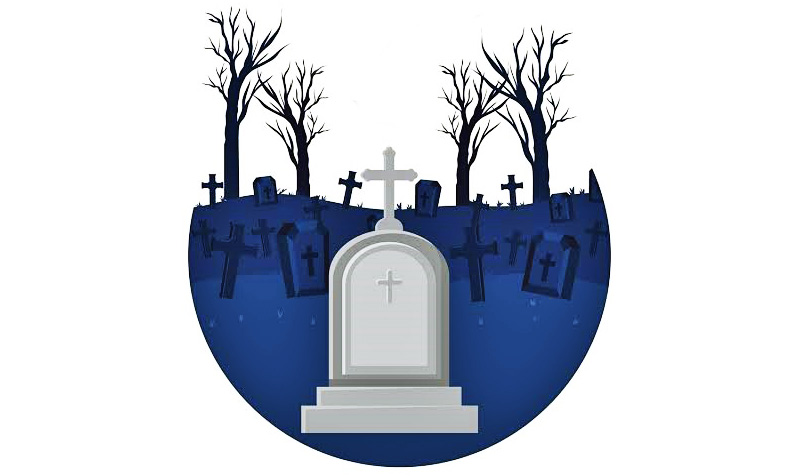
Beechworth’s first official cemetery is created in Loch Street. A total of 145 of Beechworth’s pioneers are buried in the Loch Street Cemetery between 1853 and 1855.
| Before the creation of the official cemetery on Loch Street, burials have taken place on a small piece of land on Lower Stanley Road. |
1853 – Jun
As the need for water in local goldmining increases, newly arrived Canadian-born civil engineer John Reilly becomes the first (recorded) miner on the Victorian goldfields to sell water on the Beechworth goldfields. With his recent experience of alluvial mining in California, he begins building several miles of ‘water races’ from Nine Mile Creek (Stanley), in the hills just south of Beechworth, to supply water for his own sluicing operations and then begins selling his water to miners working downstream, charging each up to seven shillings per day. Reilly earns ‘virtually 100 guineas weekly’ with his local monopoly on water supply. He will make an exceptional amount of money and will soon open the Union Hotel on Ford Street, Beechworth’s third hotel (see further entry below).
| It soon becomes more common for miners to recoup the cost of building dams and races by selling water to other parties. In July 1860, the local mining surveyor reports that a person owning one sluice-head of water (about 36,000 gallons or 163,656 litres over 12 hours) can bring in rent of about £9 per week. By the late 1860s miners have excavated more than 740 miles (almost 1,200 km) of water races in the Beechworth, Yackandandah, Stanley and Buckland mining divisions. This includes some of the longest water races ever built in Victoria, including the ‘Pioneer Ditch’ which runs for 70 miles (113 km) from the Kiewa River at Dederang to Yackandandah. There are dozens of main races, often diverting millions of gallons of water out of one watershed and into another on a daily basis. Secretary of Mines Robert Brough Smyth referred to the “almost embarrassing multiplicity of small reservoirs in the district. Miners at Beechworth have created a complex landscape of mining water systems”. |
1853 – Jul 1

The newly named “Beechworth” is officially proclaimed as a town after the Victorian Government’s Surveyor General, 47-year-old George Douglas Smythe, completes his survey of what had been known as the Spring Creek diggings. He officially re-names it “Beechworth” (apparently) after the name of his family’s home “Beechworth House” in Leicestershire, England. He lays out plans for the main streets and public areas. Much like Robert Hoddle’s “grid layout” for Melbourne 16 years earlier, Smythe divides the town into six 1-acre blocks, each block generally made up of 20 quarter-acre allotments and lays out eight main streets that surround these six blocks. He will name them High Street, Camp Street, Short Street, Church Street, Finch Street and Ford Street (which is essentially a cul-de-sac, accessed only from High Street via Short, Church and Camp Streets, and ending at its south-western end, on the edge of the Gorge and at Camp Street in the other direction). He will name Loch Street after his good friend Henry Brougham Loch (who will become Governor of Victoria from 1884 and 1889) and the last street that Smythe lays out is simply named Last Street.
| Beechworth’s town population soon swells to an impressive 3,000 and, as George Kerferd predicted, becomes the central town of the Ovens Goldfields, and the Victorian government’s administrative centre for North-East Victoria and, for a while, Beechworth becomes Victoria’s richest alluvial goldfield. The settlement’s early administrators realise that gold will not last forever and will make substantial investment in public services. |
1853 – Jul
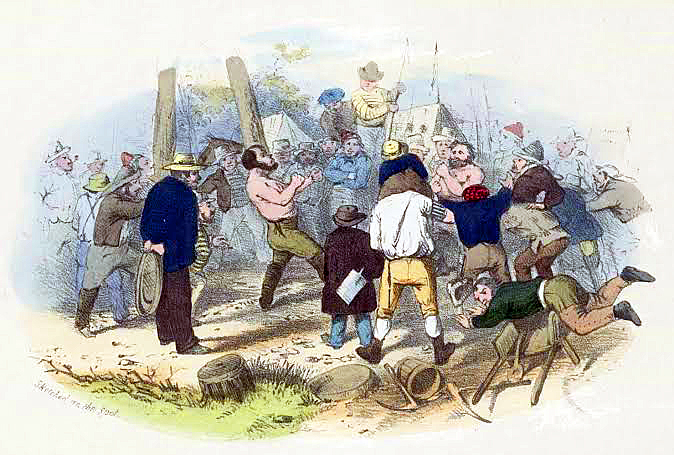
There are reports in the press that illegal prize-fights organised by gold miners are taking place 3 miles outside Beechworth. “The police interfered and in return were interfered with, but there was no riot”. The area where the fights take place is now known as Fighting Gully Road (below).

1853 – Jul
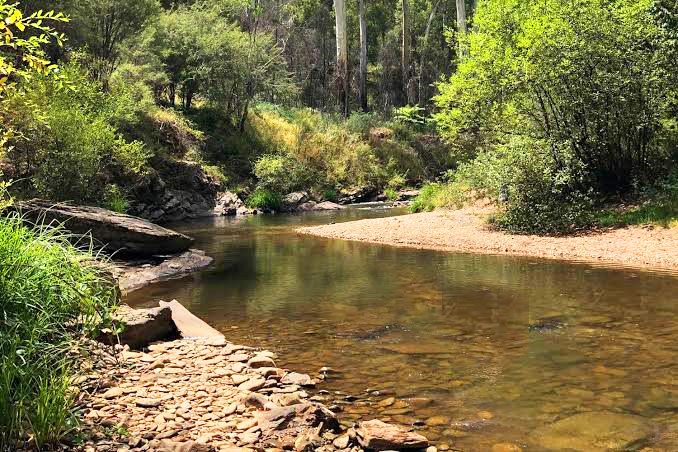
American Henry W. Pardoe and a party of six men depart Beechworth with the intention of prospecting for gold on the Buffalo River. Instead they end up making a big discovery at the nearby Buckland River, obtaining 360 ounces of gold in just a couple of days in the Buckland Valley. Determined to keep their discovery a secret, New York-born Pardoe and a couple of the men return to Beechworth to quietly gather enough supplies to enable the group to “hole up” in the Buckland for several months, enough time (they think) to make their pile. However, one of Pardoe’s men, after having a few too many drinks, brags about how he and his mates are getting £5 of gold per man, per day, on ‘The Buckland’. Within days, a new rush starts to the area and by the end of the year almost 1,000 diggers are working beside the Buckland River – which flows into the Ovens River – with the numbers swelling to almost 3,000 by January 1854. Then typhoid strikes (see 1853 – Dec 15th entry).
1853 – Jul
Another well organised party set out from Beechworth to explore the nearby Buckland Valley. The group is made up of William Howell, Frank Scott, and Daniel Ward, along with brothers Thomas and David Bell. After packing provisions at the Spring Creeks diggings (Beechworth) they begin to pick their way through thick scrub, eventually reaching a spot near the mouth of Murray’s Creek where they commence their search for gold and have some quick success. They are not far from where Henry Pardoe and his party have commenced their own mining operations. Like Pardoe’s group, they will quietly sneak back over to Beechworth for supplies, keeping their fingers crossed that their little secret will remain so for a bit longer.
1853 – Sep 7

Auction Day! Prospective buyers gather at the Beechworth Police Office on the first day of the Government Land Sales, where forty-four of (newly-named) Beechworth’s quarter-acre allotments are auctioned … at extremely low prices! The bargain of the day goes to the first buyer Charles Williams, who pays just £3 for allotments on the corner of Camp and High Streets (where The Beechworth Ice Creamery and The Beechworth Sweet Company now stand).
| By comparison, just three years later, in 1856, the Bank of New South Wales will pay £1,100 for its quarter-acre block on the corner of Camp and Ford Streets – around $575,000 in today’s currency. |
1853 – Oct 22
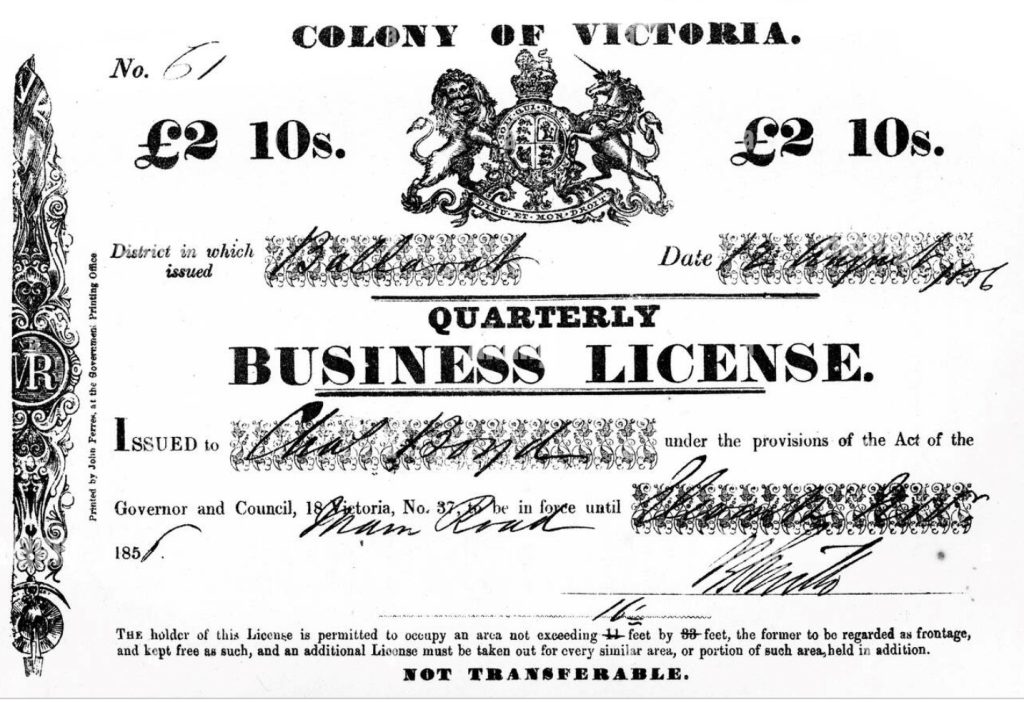
The first liquor licences are granted in Beechworth, and 41-year-old German-born musician William Henry Neuber (a popular sight on the goldfields providing musical entertainments) gets in quickly, opening Beechworth’s first licenced hotel, a basic, wooden structure imaginatively named the Beechworth Hotel (although often referred to by regulars as the Neuber Hotel) on the newly named Ford Street. It will quickly become the settlement’s unofficial ‘civic centre’.
| Born William Isaac Neubauer in Berlin in 1812, he (somewhat) anglicises his name when he moves to London as a young man and gets married. As he struggles to maintain a career in his newly adopted country – including stints as a ‘Professor of Languages’ and ‘Liquid Glue Maker’ – Neuber is imprisoned in October 1850 for bankruptcy. Out of jail (and seemingly out of debt) by March 1851, he will soon make the move to Australia with his wife and children. |
1853 – Oct 28

The auctioneer’s gavel is banged again as the second day of the “Beechworth Land Auctions” are held. Some storekeepers purchase allotments on which they have already erected buildings, with the Chief Gold Commissioner granting them permission to build on the newly surveyed lots with the assurance that the value of their improvements and structures will be added to reserve price of the land. Some allotments are sold at slightly over the reserve price of £2 each, while other township lots sell at prices ranging from £20 to £130.
| Several allotments in the key trading positions of High, Ford and Camp Streets are bought by local businessmen including William Henry Neuber, Richard Mellish, Charles William, E. Vickery, A. Palmer and American baker George Scott and American auctioneers F.H. Morse & Co for its general saleyards. |
1853 – Oct

After being abandoned as “too difficult” a year earlier, new gold discoveries are made at the ‘Woolshed’ on Reedy Creek, about 6 km below Beechworth. Encouraged by the success of the claims on the upper part of the creek, the ‘Woolshed’ diggings gradually extend to the Lower Woolshed, the Sebastopol Flat, the Napoleon and Eldorado – a distance of twelve miles.
| By 1855 the ‘Woolshed’ diggings have become extraordinarily rich with the ‘Woolshed’ township extending for 2 miles, but it will be almost deserted within a few years. |
1853 – Oct
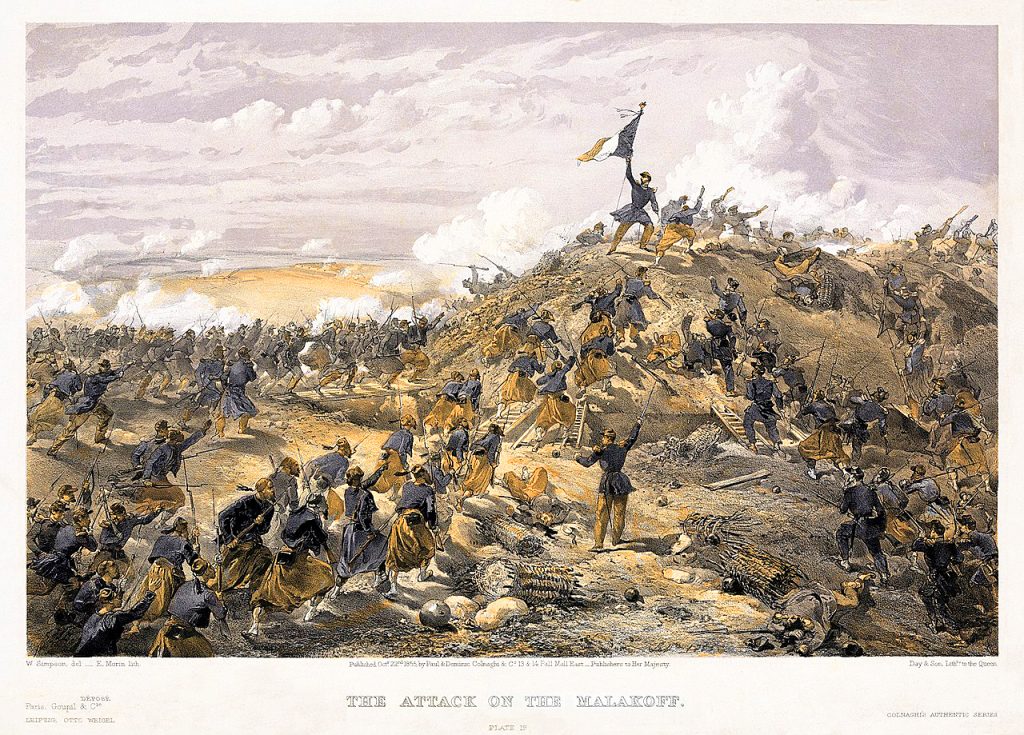
The Crimean War begins in Central Asia (including areas of Ukraine), and a number of streets in Beechworth will be named for famous battles during this war (which ends in February 1856). Street names include Balaclava Road (1854), Inkerman Road (1854), Malakoff Road (1855), Alma Road (1954) and Kars Street (1855). Beechworth’s patriotic citizens also name roads after Queen Victoria (on the throne from 1837 to 1901) (Victoria Road) and her husband and consort Albert (served from 1840 to 1861) (Albert Road).
| The Crimean War is a 2-year military conflict in which Russia is defeated by an allied force consisting of the United Kingdom, France, the Ottoman Empire and Piedmont-Sardinia. |
1853 – Oct 29
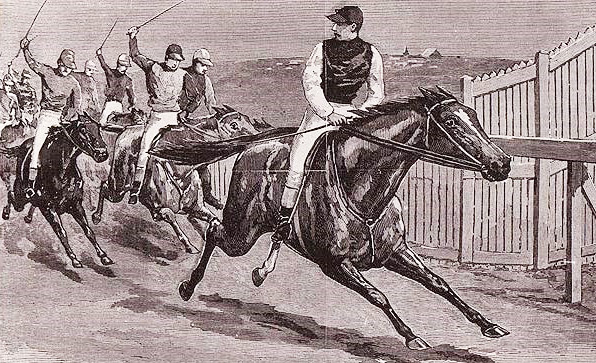
The first official Beechworth Races are held at Woorajay Station (later known as ‘Wooragee Station’). Local man Bob Sawyer wins the ‘Beechworth Tattersalls’.
1853 – Oct 31

Beechworth’s second hotel opens just over a week after liquor licences are granted, with C.H. Palmer’s El Dorado Hotel, a wooden structure built on the corner of High and Church Streets diagonally across the road from where the large wooden Wesleyan Methodist Chapel will be constructed the following year.
1853 – Nov
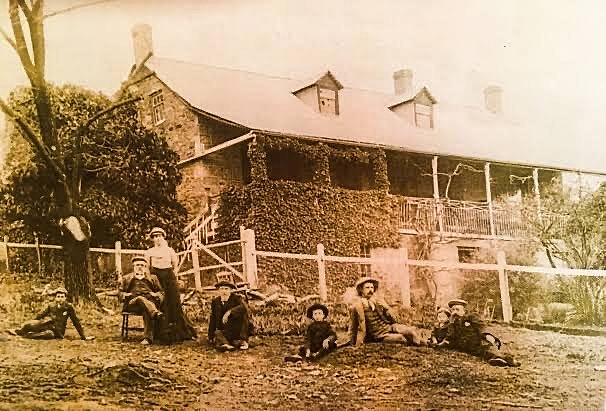
The rush to discover gold in the Mayday Hills, Eldorado, Woolshed, Sebastopol, Magpie Creek and Reid’s Creek are nearly all taking place on land owned by the David Reid and his family, ruining its pastoral value. With so many people invading his land, Reid sells all of his pastoral runs for as much as he can get and turns – with much financial success – to cattle and horse-dealing and general trading between Melbourne and the Riverina and the diggings.

| In November 1856 David Reid uses the profits of his latest business ventures to purchase the ‘Barneywatha Run’ at Barnawartha from George Hume Barber (a relative of his) and builds ‘The Hermitage’, now one of Australia’s most treasured homesteads. Constructed from locally quarried granite, the beautiful cedar doors are reputedly carted from Sydney. Local miners are responsible for the building’s construction. The Reids finally move to Moorwartha near Howlong and David Reid becomes the successful candidate for the Murray District of the Victorian Parliament in 1859. In 1865 Reid finds himself in financial trouble and sells ‘The Hermitage’ to successful pastoralist Reverend Joseph Docker – who has built ‘Bontharambo’ near Wangaratta – for Docker’s daughter Charlotte and her husband John Whitehead. David and Mary Reid (above) are married for over 60 years, and both live to be 86 years old. David dies in 1906 and is buried in the Howlong Cemetery. |
1853 – Nov

60-year-old Joseph Docker – who brought a herd of 300 cattle to the Wangaratta area in 1838 – now capitalises on his much expanded ‘Angus’ herd – now around 3,000 – with his son, 17-year-old Frederick George Docker, droving 30 to 40 cattle the 44 km from the Docker’s ‘Bontharambo’ property to Beechworth every week where he sells them to local butchers for a lucrative £500 cash in sovereigns!
1853 – Nov
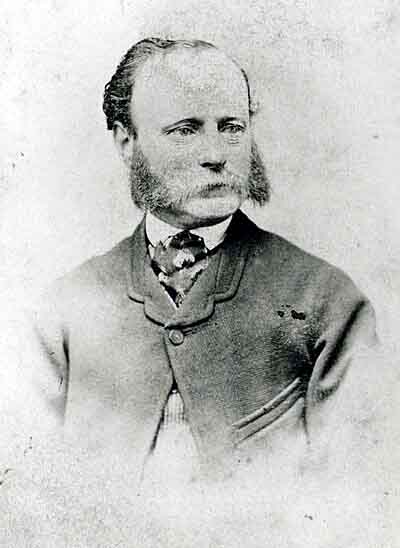
Because of the escalation of both petty and serious crime on the goldfields, a Gaol is considered a priority, so young Government Architect, 22-year-old Francis Hodgson Nixon is sent to Beechworth to design and supervise the building of a strong, wooden stockade. He oversees the construction of his design – a series of 6 long wooden buildings with shingle roofs – each 12 feet wide and 14 feet long – enclosed by 8 foot high wooden walls (built from sawn slabs) with spiked tops. The Beechworth Stockade is built upon a slight hill at the northern end of the Police Reserve and Government Camp.The Stockade can hold 36 convicted prisoners, plus a number of other prisoners awaiting trial. The convicted prisoners will be escorted from the Stockade during the day to break rocks in the nearby quarry or undertake road maintenance, sometimes in chains.
| Francis Nixon decides to stay in the area and becomes Beechworth’s Mining Camp Inspector and Building Supervisor, overseeing the construction of a number of government buildings, before establishing the “Ovens and Murray Advertiser” newspaper in 1855 and becoming its editor, going on to hold the same position in newspapers across Victoria, New South Wales and Queensland. A sufferer of chronic insomnia, 50-year-old Nixon commits suicide (by shooting himself in the head) in Rockhampton in Queensland in 1883, leaving a widow and ten children. |
1853 – Nov

Beechworth’s third hotel is opened by John Reilly, a Canadian with Californian goldrush connections (see earlier entry). Like the other two hotels, Reilly’s Union Hotel is also on Ford Street – near the present day Salvation Army hall – and, during the height of the Woolshed goldrush “champagne flows like water”. It features an ‘American Bowling Alley’ with a floor laid of American pine. John Reilly’s brother Luke Reilly will take over the hotel the following year and the Union Hotel will be re-named the Temple Bar Hotel in 1861 and continue trading on Ford Street until it closes in 1880.
| Ford Street, now Beechworth’s central road, is named after one of the settlement’s earliest bullock dray carriers, Ernest Ford. |
1853 – Nov

After arriving at the gold diggings in Beechworth on his 21st birthday – 22nd of July 1853 – American Hiram Allen Crawford has spent the last four months mining on Spring Creek and along the Two Mile and Three Mile Creeks. Then – along with hundreds of others – he joins the ‘new rush’ to ‘The Buckland’ where, once again, he meets up with fellow Americans Adam Snow and Joshua Cushman Bigelow who offer him the job of managing their latest store on the diggings beside the Buckland River. Crawford agrees and remains on the Buckland until the rush there begins to slow, then is quickly deserted after a break out of ‘colonial fever’ (typhoid) – causing 11 men to be buried on ‘The Buckland’ in just one day! Crawford again returns to Beechworth for a short time and considers returning to America before two more fellow Americans – Adam Casner Kidd and William ‘Billy’ Barnwell Brickell – offer him a job in Albury working on their new Murray River Punt for six weeks at £5 per week with board. He decides to stay in Albury will go on to build a bowling alley with yet another American – Benson Atwood from Maine – at a cost of £400. Selling out, Hiram then builds his own billiard room with a bowling alley attached. During the 18 months he spends in Albury, he falls in love with Anna McNeil, a young woman from the Isle of Skye, and they marry in Beechworth in February 1855.
| The ‘Murray River Punt’ at Albury is certainly a nice income-earner for Adam Kidd and Billy Brickell. They had leased the wooden punt from the government for a reputed £40 per annum – making a total profit of more than £10,000 over the eight year duration of their tenure! Kidd and Brickell had arrived in Australia from San Francisco in 1852 and headed straight to Yackandandah hoping to find gold but soon establish themselves as businessmen in Albury. Along with the Murray River Punt, their numerous money-making ventures, Kidd and Brickell open an Albury General Store, the ‘Exchange Hotel’ on the south-east corner of Smollett & Townsend Streets (where the Quest Hotel is built in 2020) and win the contract to build Albury’s first Union Bridge for £7,500, opened in 1861. Kidd will go on to be one of the first Aldermen in the newly formed Municipality of Albury in 1859, while Brickell will meet Mary Bulmer in Albury and marry her in Melbourne in 1862. The very next day the Brickells depart for America. The fortune that William ‘Billy’ Brickell had made in Albury will finance the purchase of a large parcel of land in Florida that will grow into the towns, and later major cities, of Fort Lauderdale and Miami. |
1853 – Dec 10
Moses F. Pinchin is granted a licence to establish Beechworth’s fourth hotel – the Freemason’s Arms – on High Street. It will open for business on December 19.
1853 – Dec 15
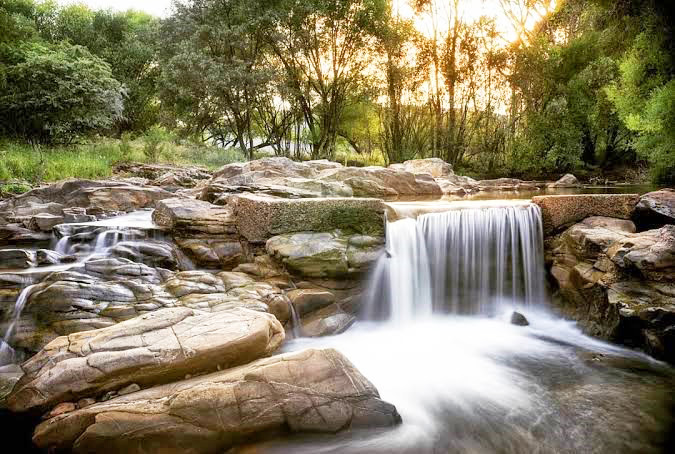
Sub-Inspector of Police, Samuel Furnell, is sent from Beechworth to the new goldrush site along the Buckland River to establish a Police Camp. He reports there are already around 500 miners busy at work digging for gold, with many more arriving on a daily basis. He requests a stronger Police presence and recommends ‘foot constables’, suggesting they will be of more use than ‘mounted men’ as the nature of the country makes it nearly impossible to travel on horseback. However, within weeks disaster will strike, with typhoid disease sweeping through the rough camp and ‘The Buckland’ gains the reputation of having the highest mortality rate of any Victorian goldfield. It is said that the valley is “so thickly dotted with graves that the river seems to wind through a churchyard”.
1853 – Dec 17

A licence is granted to 33-year-old John Duncan Fisher and his brother-in-law 32-year-old Henry Isaac Wyse for the building of their two-storey weatherboard Commercial Hotel on Ford Street. It will be the first two-storey building in Beechworth. Although it will be the fifth hotel to open in Beechworth in just a few weeks, by the end of the following year, local miners and residents will be serviced by an incredible 61 licenced premises! The Commercial Hotel still operates at 50 Ford Street today.
| John Duncan Fisher is married to Emma Rachel Wyse, half-sister of Henry Isaac Wyse. The business partnership between Fisher and Wyse will last until 1856, with Fisher continuing with the ‘Commercial Hotel’ by himself until April 1870 when he sells the highly profitable hotel to Thomas Tanswell. John Duncan Fisher then retires and spends the few short remaining years of his life with his wife Emma at ‘Baarmutha House’ on Victoria Road in Beechworth. He will pass away aged 53 in 1873. Emma will die three years later in 1876 aged 43. |
1853 – Dec
By year’s end, the gold carried to Melbourne on the fortnightly escorts has amounted to a total of 198,436 ounces.
1854 – Jan

Beechworth continues to grow, as more ‘permanent structures’ spread out around the Spring Creek diggings. In just over twelve months, more than 100,000 ounces of gold has been taken out of the diggings around Spring Creek and the Ovens area.
| A minimum of 18,000 ounces of gold (or half a tonne) leave the goldfields on the fortnightly Victorian Government Gold Escorts. |
| The Woolshed and its tributaries yield tin as well as gold and by 1870 tin mining is proving more profitable than gold mining. |
1854
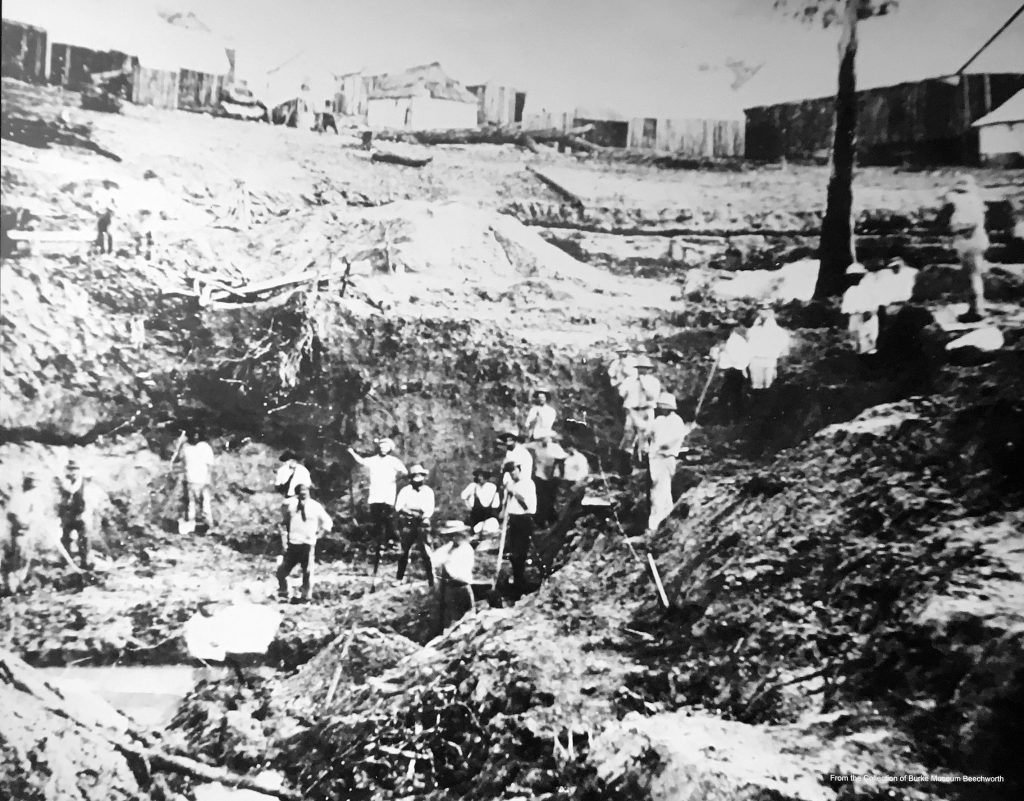
‘Big’ John Johnston takes up a small claim at the Woolshed which is worked by a small steam pumping engine and eight men. After four months without a breakthrough, he informs his labourers that he has run out of money, but his men decide to persevere for one more week and, a few days later, strike it so rich that most of them take up their own claims. Johnston goes on to employ as many as
one hundred men on his claim, which takes about eighteen months to work out, and it is estimated that he wins between £50,000 and £100,000!
1854
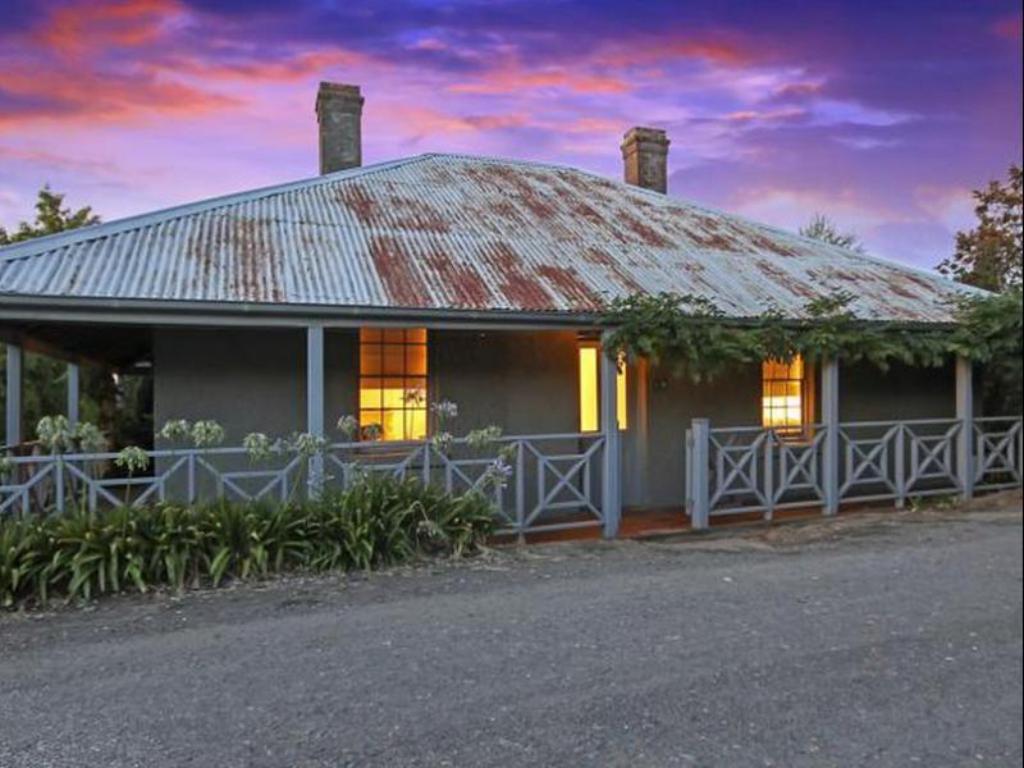
French Cottage is built at 19 Hodge Street. It still stands today. The fully renovated stone home can now be rented as luxury accommodation.
1854
Not long after Francis Nixon completes building the Beechworth Stockade, prisoners are already attempting – or succeeding – in escaping from the large wooden structure that is surrounded by an eight-foot-high wooden wall. After being locked up for the night in one of the Stockade’s huts, 10 prisoners set about tampering with the bottom of the hut’s door and, when discovered, they have made a hole almost big enough to escape through. In another instance, a prisoner uses the cover of a foggy morning to clamber over the wall and make his escape, while the most infamous escape is by a man who rolls a barrel against the wall then takes a running jump onto the barrel, using it to ‘vault’ over the eight foot wall – in full view of a sentry – and is never seen again!
1854 – Mar
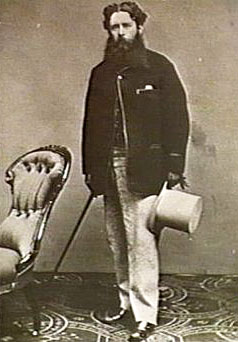
William Henry Gaunt, born in Staffordshire, is appointed Chief Clerk at Beechworth, and quickly gains an intimate knowledge of the district and the ‘temper and disposition of the miners’. Appointed Sub-Warden in the Beechworth district in January 1856 and the first Chinese Protector in August, he is given control of the extensive Woolshed district. When European miners attack a party of Chinese at the Buckland River diggings in May 1857, Gaunt is sent to restore order. One of his proclamations, issued in Chinese characters, concludes: ‘W. H. Gaunt, your protector – tremble and obey!’ Gaunt will eventually become a County Court Judge in 1891.

| In 1860 Gaunt marries Elizabeth Mary Palmer and they will raise an extraordinary family. Two of their sons – Ernest Frederick Augustus Gaunt and Guy Reginald Archer Gaunt will become admirals and be knighted; Cecil Robert Gaunt becomes a lieutenant-colonel and career soldier; Clive Herbert Gaunt a government advocate and Crown Prosecutor in Rangoon; and Mary Gaunt is one of the first two female students to enrol at the University of Melbourne (in 1881). Although Mary does not complete her degree, she will go on to become a successful novelist and travel writer. Her first novel ‘Dave’s Sweetheart’ is published in 1894. |
1854
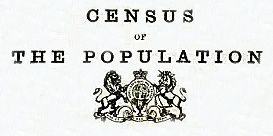
The first census of Victoria is conducted. It records that 236,798 people live in the colony. The population of Melbourne is recorded as 76,565 while Beechworth’s population is recorded as 1,275 (975 males, 300 females). As a comparison, the population of Ballarat is 1,303, Wangaratta stands at 503, Benalla is 297, Wodonga is just 34, Swan Hill is 44, and Williamstown has a population of 2,613.

| Several major Melbourne institutions are established in 1854 including the ‘University of Melbourne’, the ‘State Library’, and the ‘National Museum of Victoria’ along with ‘The Age’ newspaper, the creation of the first (steam powered) passenger railway line in Australia – running from Sandridge (Port Melbourne) to Flinders Street – and the construction of ‘Railway Pier’ (later to become ‘Station Pier’) becoming the official arrival point for ships coming to Melbourne. |
1854

In nearby Wangaratta, Thomas Millard builds the Royal Victoria Hotel and the following year, William Clark – who had purchased the whole of Murphy Street (from Reid to Ely Streets) in the first Wangaratta land sales in June 1849 – builds the two-storey brick Commercial Hotel on the corner of Reid and Murphy Streets (above). It is christened for business with a bottle of champagne by Clark’s small son William, who is hoisted up to smash the bottle against the hotel’s chimney. Wangaratta’s Commercial Hotel prospers and in June 1861 William Murdoch of the nearby Royal Hotel takes over the licence, but Clark resumes the licence of the Commercial Hotel in 1870. It is enlarged and improved a number of times (see photo below) and, when it is demolished in 1968, it had become Wangaratta’s oldest hotel.

1854

With discussions already being held about the possibility of a proper court house being built – the number of cases being heard is growing every month – Beechworth is appointed a place where ‘County Court’ and ‘Court of General Sessions’ can be heard, with proceedings continuing to take place in tents at the ‘Gold Commissioner’s Camp’.
1854 – Apr 27
The Reverend William Butters chairs a meeting at the premises of F.R. Bernard & Co (in which members of the Wesleyan Methodist Church are currently holding their services) where Chales Williams proposes that a proper church building be erected. The proposition is agreed upon by all participants and a committee is formed – led by local store-keeper Eli Abbott – to raise the necessary funds to design and construct a wooden chapel to be used as a place of public worship and school room – on the site at 24 Ford Street which the Government has granted to the Wesleyan Methodist Church. A sum of £300 is immediately donated and construction begins shortly afterwards, with the wooden chapel completed by December the same year at a final cost of £1,500 (see further entry below).
1854

The 1854 Census lists just 33 Chinese people living in the township of Beechworth, but by 1861 there will be 4,568 in the region around the Beechworth, Chiltern and Rutherglen fields, most of them from the Canton Province of Southern China.
| In Beechworth, the Chinese are restricted to living in the ‘Little Canton’ encampment (photo above) near what is now Lake Sambell and a Chinese Protector is employed to maintain good relations with the 4,500 Chinese diggers and trades people. |
1854
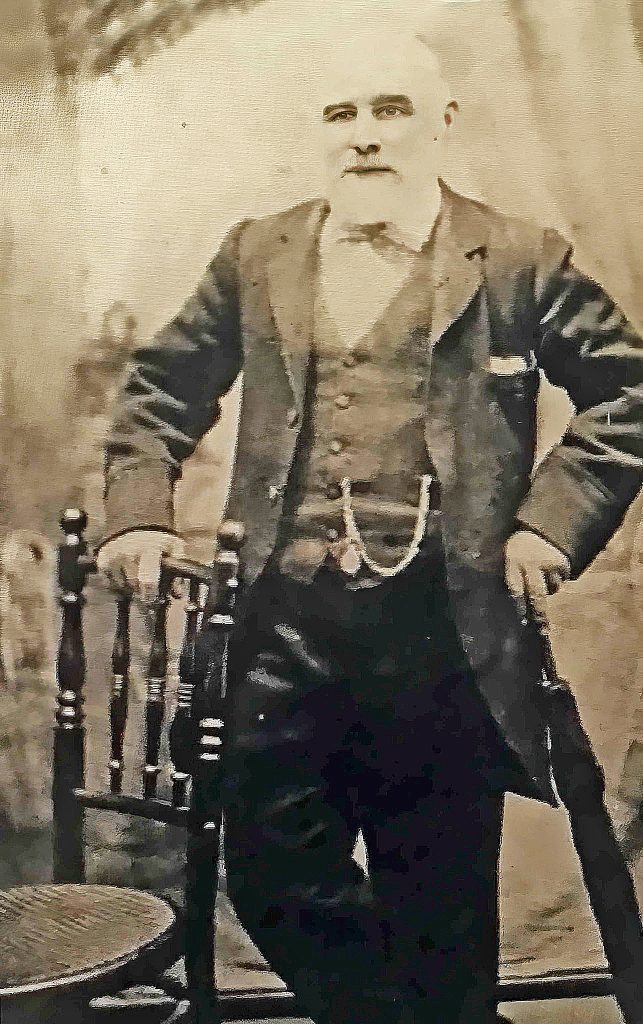
16-year-old Bordeaux chef Camille Réau arrives in Beechworth and his skills as a chef are instantly noticed, despite his young age, being highly praised for his wedding banquet preparations in 1855 for well-known identity John Strickland’s wedding breakfast at the Commercial Hotel. Camille marries Catherine Moonan on February 1, 1859 at Beechworth and they will eventually move to Wahgunyah where Camille becomes the owner and licensee of Wahgunyah’s Empire Hotel. He will go on to establish a number of vineyards, including two at Wahgunyah – ‘Tuileries’ and ‘Medoc’ – followed by a vineyard at Barnawartha which he names ‘Bordeaux’. Camille Réau is among the early vignerons to plant vines in the Rutherglen district where a French community – including the highly respected Monsieur Joseph Gassies – had settled. Camille will die at his home in Barnawartha in 1912 aged in his mid-70s.
1854 – May 8
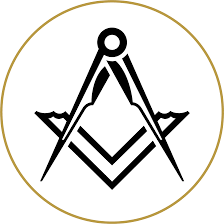
The first meeting of Freemasons in Beechworth takes place at Moses F. Pinchin’s Freemason’s Arms Hotel on High Street. Eleven members of the Craft meet to consider what steps should be taken to form a Masonic Lodge in the township. They agree to form the Beechworth Lodge of St. John, although the matter will lapse until July 1856 when further meetings are held, and permission is sought for approval to form an official Masonic Lodge. The Foundation Stone will finally be laid on September 16 1859.
1854 – May 23
In celebration of Queen Victoria’s birthday, William Henry Neuber throws open the doors of his newly built Beechworth Assembly Room next door to his Beechworth Hotel on Ford Street so that the “entire Beechworth population” can be entertained with dinner, champagne and wine and a “Queen’s Birthday Ball” that will continue into the small hours of the following morning. Neuber will also hold a “Fancy Dress Ball” at the Beechworth Hotel on New Year’s Eve 1954, with a lavish supper from 11pm and dancing until 7am on New Year’s Day 1885!
| By Christmas of 1854, Neuber – with the aid of public donations from Beechworth’s leading citizens – has added an impressive ‘town clock’ above the entrance to the ‘Beechworth Assembly Room’. This is considered to be “of great benefit as well as an improvement to the town”. |
1854 – Jun 1
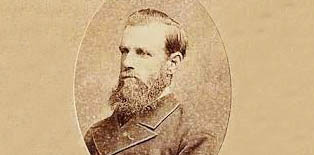
24-year-old Francis ‘Frank’ Augustus Hare – who had dug up £800 of gold in one day at Bendigo – arrives in Beechworth and is employed as a mounted lieutenant on the regular gold escort delivery from Beechworth to Buckland. The 6’3″ tall South African-born Hare will soon become a police lieutenant based at Wangaratta, moving up the ranks to become a Superintendent.
| The track upon which the escort travels is notoriously difficult to traverse, the escort regularly having to swim across floodwaters and rivers and on one occasion a mule bearing 2,000 ounces of gold breaks away from the escort and bolts up a mountain pass and has to be shot to enable the escort to retrieve the gold as it is too treacherous to retrieve the mule as well. It is during this time that the future Superintendent Hare will have his first encounter with bushrangers. |
1854

The apparent problems of the police in Beechworth is noted in Melbourne, where a decision is made to address the matter. 33-year-old Captain Robert O’Hara Burke – a member of the newly formed Victoria Police (1853) – is promoted to District Inspector of the Ovens District on December 31st 1853 and, early in 1854, is sent to Beechworth where he assumes the position of Superintendent of Police. When his 26-year-old brother, James Thomas Burke is killed in the Crimean War, Burke takes leave from Victoria Police and Beechworth and enlists, leaving Australia on the S.S. Marco Polo on 25 March 1856 for England but, by the time he arrives in June, the war has ended and he returns to Beechworth where he remains until 1858. The rather eccentric Burke becomes known for his habit of taking a relaxing bath in the garden of his police residence in Ford Street, clad in only in his helmet, happily reading books in full view of the public. Despite his unconventional behavior, he proves to be very popular in Beechworth, sometimes playing with the Beechworth ‘Goldfields Orchestra’ and gains much respect, particularly following his efficient handling of the Buckland Riots near Bright against the Chinese gold miners in 1857. In November 1858 he is transferred from Beechworth to Castlemaine as Police Superintendent. In 1860 he is again given leave from the Victoria Police, this time to take command of the exploring expedition to cross the continent from south to north organised by the Royal Society of Victoria.
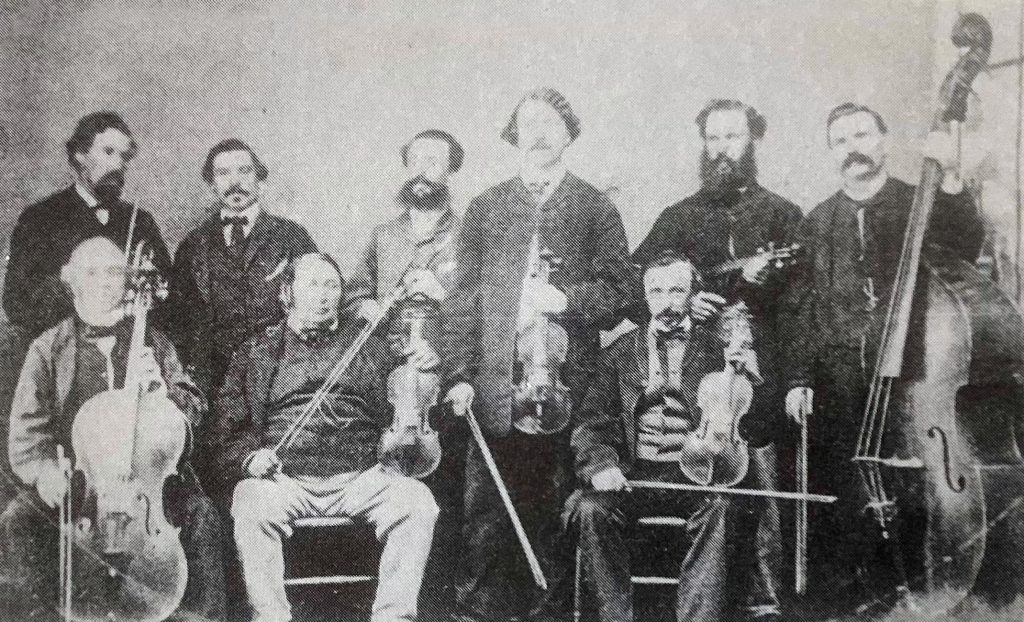
| As a mark of gratitude before he is transferred to Castlemaine, Burke is presented with a set of pistols in appreciation of his service in Beechworth. One of these pistols will be found next to his body after his ill-fated crossing of the Australian continent with William Wills in 1861. It is inscribed: “Presented to Captain Burke by the residents of Beechworth, Victoria”. |

| A beautiful magnolia tree is planted behind the Court House in Ford Street – so some people say – by Burke before he leaves Beechworth for Castlemaine, as a symbol of his unrequited love for the goldfield’s 16-year-old star of light opera Julia Matthews. He first proposes marriage to her 1858 when she performs in Beechworth but is rejected outright. Burke is aged 37 at the time. In 1860, prior to his notorious expedition, Burke reiterates his intentions to the now 18-year-old starlet, ‘whose auburn curls and charming voice captured my heart’. His second proposal is also refused, yet Burke’s infatuation is profound: he amends his will to transfer his estate to the teenager. Julia Matthews will die in 1876 in St. Louis, Missouri at the age of just 33. |
1854 – Jul 4

American-born goldminer Gordon Tucker celebrates America’s “Independence Day’ in Beechworth by going out hunting in the surrounding bush to kill the much-feared “native cats”. He is actually shooting Spotted-Tailed Quolls (also known as Tiger Quolls), the largest marsupial carnivore on mainland Australia. Much like Tasmanian Devils, they have a distinctive ear-piercing and rasping ‘screech’. Although regularly heard at night – and only sometimes seen – around Beechworth at the time, these largely nocturnal and solitary tree-climbing, den-dwelling marsupials are now rarely sighted and classed as ‘endangered’.
| Spotted-tailed quolls have one of the strongest bites of any predatory mammal in the world, coming second to its close relative, Australia’s Tasmanian Devil. Now the largest remaining carnivorous marsupials on the Australian mainland, they are listed as ‘endangered’ in Victoria, with their only known breeding populations located in the Upper Snowy catchment area. It is estimated there are around 14,000 Spotted-Tailed Quolls left in the wild throughout Australia. |
1854
Two hotels are now trading at the Reid’s Creek diggings – The Welcome Inn and the Freemason’s Arms, both bark and slab structures. During the winter of 1854, both buildings are regularly crowded with diggers who “prefer the warmth of hotel parlours to their chilly tents”. Reid’s Creek also has eight ‘Refreshment Tents’, commonly referred to as ‘Grog Tents’.
1854
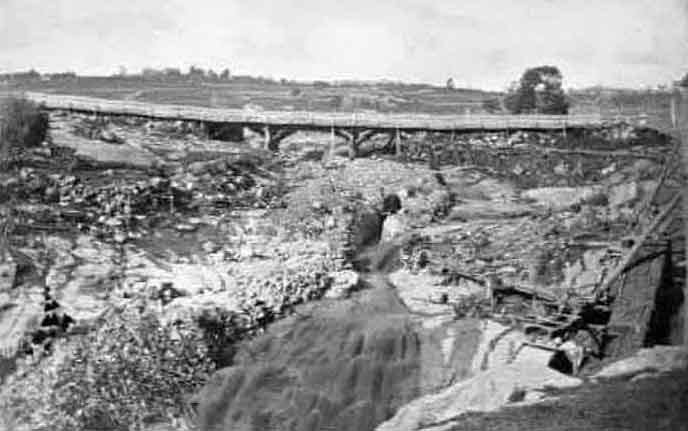
Government surveyor Francis Hodgson Nixon instructs a timber bridge (further upstream of the current Newtown Bridge) be built over Spring Creek to facilitate transport, meaning people no longer need to forge the creek as they come into the settlement. It is lined up to the town’s original main road – High Street.
| Once the timber bridge is completed in 1856, it opens development on the hill on the other side of Spring Creek. This new area of town quickly becomes known as ‘New Town’, later styled as ‘Newtown’. |
1854

18-year-old Num Shing arrives in Beechworth. Born in Hong Kong, he will add ‘William’ to the start of his name and change the ‘Num’ to ‘Nam’ and establish the popular Sun Quong Goon Hotel and General Store on the Spring Creek diggings. With his natural shrewdness and business acumen. he will be highly successful, running the store in Beechworth for the next 40 years, becoming one of Beechworth’s most prosperous merchants. The wealth that Shing accumulates over the years is devoted to the advancement of the district, with his quiet generosity becoming well known, both to the Chinese community and Europeans alike. A big supporter of local charities, William Nam Shing sits on the Committee of Management of the Ovens District Hospital and will later be appointed a Life Governor of the Ovens Benelovent Asylum. He will also be prominent in the introduction of the tobacco industry in the area. Today, Nam Shing Lane near Lake Sambell is named after him.
| On August 22, 1871, William Nam Shing is baptised into the Church of England, and marries Annie Cohen at Christ Church in Beechworth in July 1881. Following a painful foot infection, Shing will die of blood-poisoning on December 19, 1896, aged 63. He is buried in the Church of England section of the Beechworth Cemetery. He is survived by his wife Annie and three of their five children – Percy, Ada and Amanda. |
1854
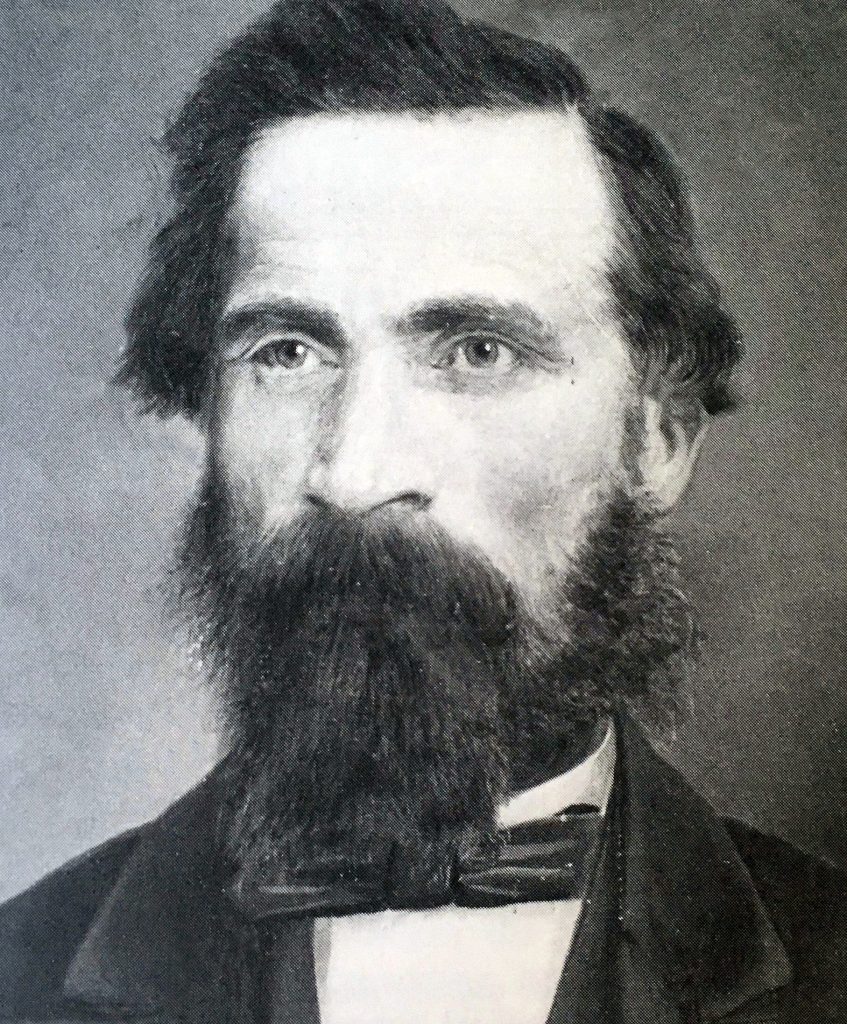
After spending two years in Melbourne, 27-year-old James Ingram from Dumfriesshire in Scotland arrives in Beechworth with his wife Margaret. They set up a home for themselves in a tent in Ford Street where James holds the town’s first Disciples of Christ (Baptist) services. For 12 months he acts as Beechworth’s sales agent and correspondent for the Melbourne ‘Argus’ newspaper. Within two years he has established his own business as a bookseller in Spring Street (in a new part of Beechworth, not surprisingly known as ‘New Town’) before moving his successful booksellers into the centre of town, establishing Ingram’s Beechworth Newsagency, which still bears his name on Camp Street.
| Ingram often walks the 4 miles from his newsagency to the Woolshed goldfields to sell copies of the Melbourne ‘Argus’ newspaper to the miners. His long life in Beechworth will be devoted to public, philanthropic and charitable movements. |
1854
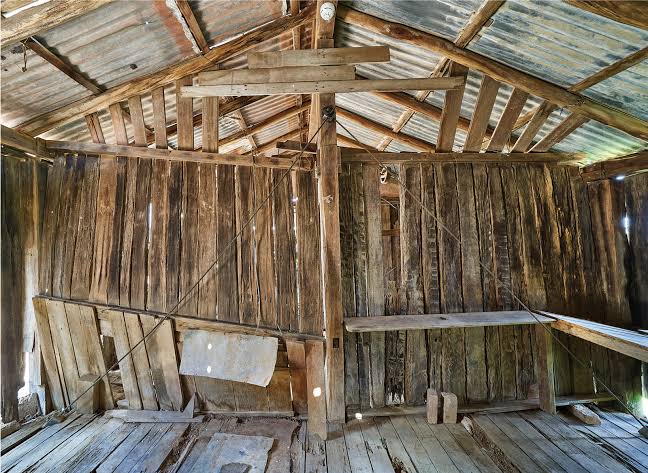
The diggings at the Woolshed Falls continue to prosper. To tame the water at the falls, American prospector Jack Barton decides to pull the Reid brothers old woolshed apart and use the wood to brace and secure the sides of his claim. He builds a waterwheel and then digs deep high-yielding leads. This results in Jack Barton becoming one of the wealthiest men on the goldfields and earns him the nickname of ‘Woolshed Jack’, which sticks fast.

| About a year after the original woolshed had been erected in the 1830s, a well had been sunk close to the end of the building for the purpose of obtaining cool water. The well is only three metres deep. But after the Woolshed diggings begin, a claim is taken out on the well and the surrounds and, at a depth of 4.5 metres, almost 200 ounces of gold is found! |
1854 – Oct

The El Dorado Mining Company is established with a capital of £2000 – 100 shares of £20 each. Under the management of a Mr Hooper, the company obtains a large claim nearly opposite the busy Spring Creek at the centre of town. While the employees set to work with great spirit, the small claim owners below them complain that the company is absorbing all the water for washing, while they are flooding the lower claims with their tailings. These complaints force the government authorities to intervene, and the El Dorado Mining Company is stopped at the very moment when, having got “a good bottom”, there is a good prospect of large returns. The funds of the company are exhausted and the shareholders unwilling to contest their claim, or to make any arrangements to address the complaints against them by the nearby miners. Until the premature dissolution of the company, they had been employing between 30 to 40 men, who were being paid £6 per week wages per man.
1854
The Criterion Hotel opens for business in High Street in Beechworth.
1854
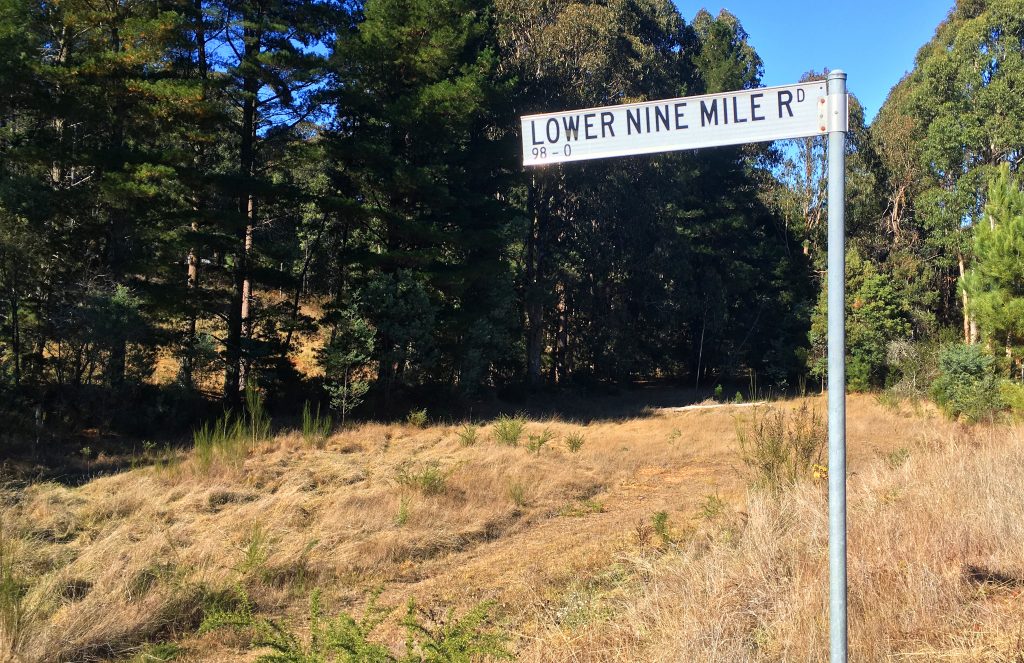
At the ‘Nine Mile’, eight kilometres south-east of Beechworth – in the vicinity of present-day Stanley – the population stands at 650. There are two diggings at Nine Mile – the Upper and the Lower Nine Mile. The locality is named ‘Nine Mile Creek’ as it is roughly nine miles from Beechworth.
1854
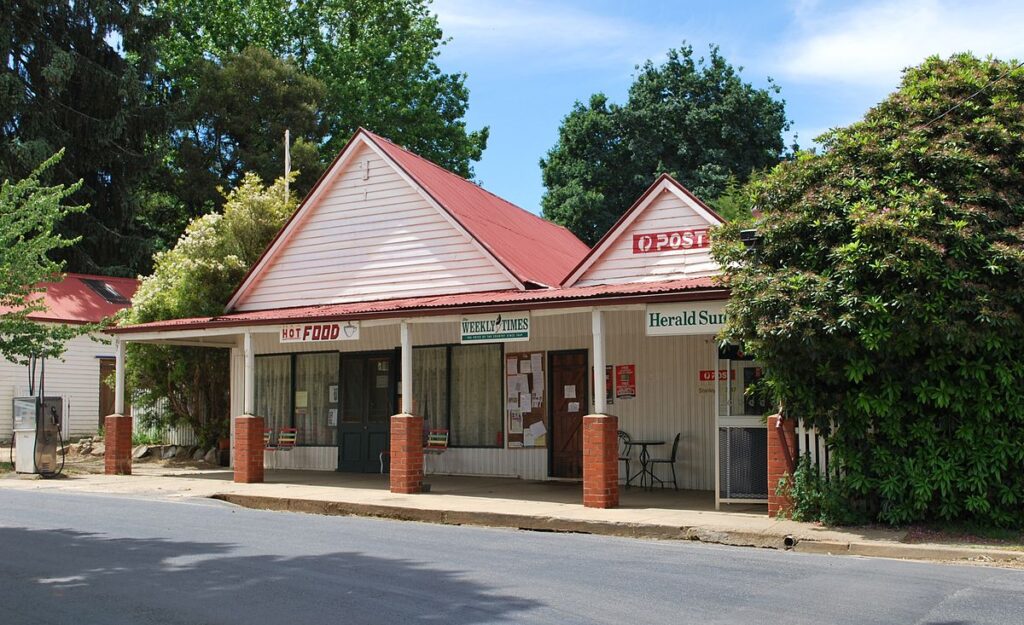
In the hills just south-east of Beechworth, 25-year-old Scottish miner and entrepreneur John Alston Wallace establishes a General Store at the Snake Valley settlement (now known as Stanley). No longer operating as a store, the building still stands today at 4 Beechworth-Stanley Road (below).

| The small township of Stanley features a rare cork tree in the village centre (now classified by the National Trust); a Presbyterian church (1870); the ‘Indigo Inn’ (formerly the Star Hotel); a whitewashed gaol and the Library/Athenaeum (1874) with a gable-roofed hall and central vestibule which is attached to the street façade. An oak tree adjacent the building is planted in 1870. |
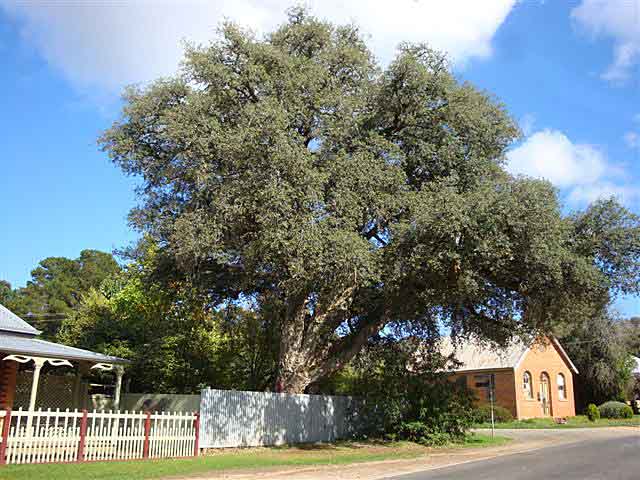
1854
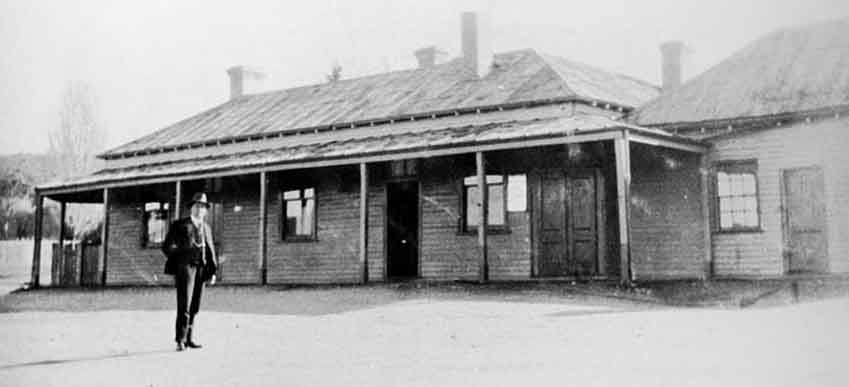
Charlie Rudolf opens the Star Hotel at ‘Snake Valley’ (now the town of Stanley). Scottish entrepreneur John Alston Wallace – who has established a General Store around the corner – will go on to take over Rudolf’s hotel, which still stands and operates today, now known as ‘The Stanley Pub and General Store’.
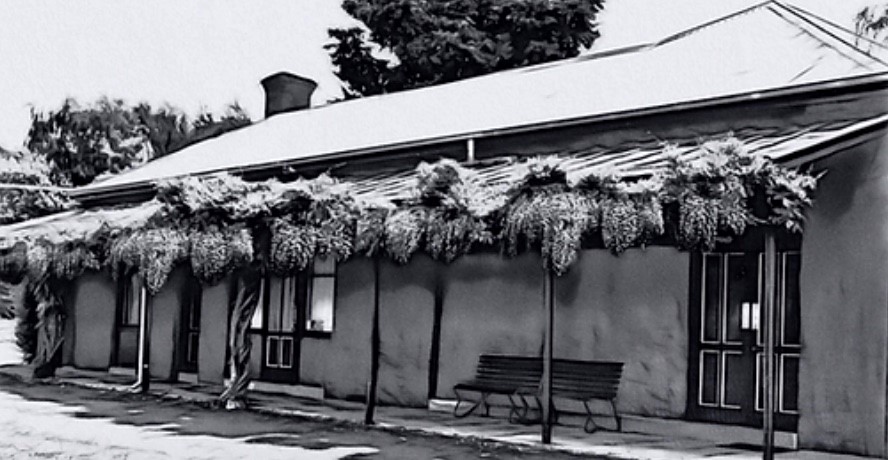
1854 – Dec 3

The Battle of the Eureka Stockade. In Ballarat, 235 miles (378 km) from Beechworth, an armed rebellion by miners against the Victorian government takes place, as the miners protest against mining taxes.
1854 – Dec

Edward ‘Ned’ Kelly is born at Beveridge, 54 km from Melbourne and 197 km from Beechworth. John (‘Red’) and Ellen Kelly will have eight children: Mary Jane (born 1851), Annie (born 1852), Edward (Ned), Margaret ‘Maggie’ (born 1857), James ‘Jim’ (born 1859), Daniel ‘Dan’ (born 1861), Catherine ‘Kate’ (born 1863) and Grace (born 1865).
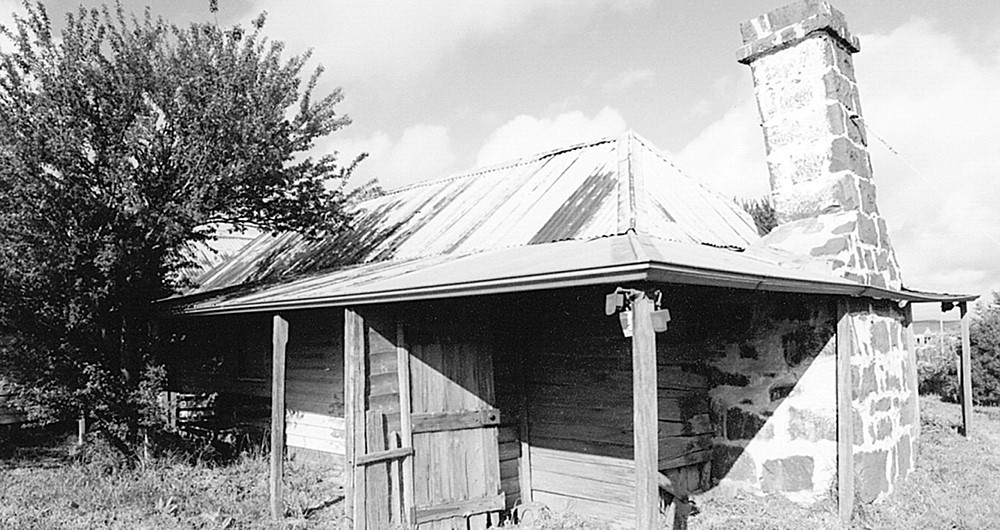
| At the start of 1854, after their recent wedding, John ‘Red’ Kelly and Ellen move from Wallan (near the Merri Creek) to Beveridge after ‘Red’ purchases twenty-one acres for £70 – money he has managed to save from gold digging and horse-dealing. In January 1859, when his son Ned is nearly four years old, ‘Red’ Kelly builds the family a timber cottage. It was a typical Irish style of cottage with an earthen floor and drainage running between rooms. Internally, there are only two rooms and there is no ceiling, while the solid bluestone chimney dominates the house. |
1854 – Dec
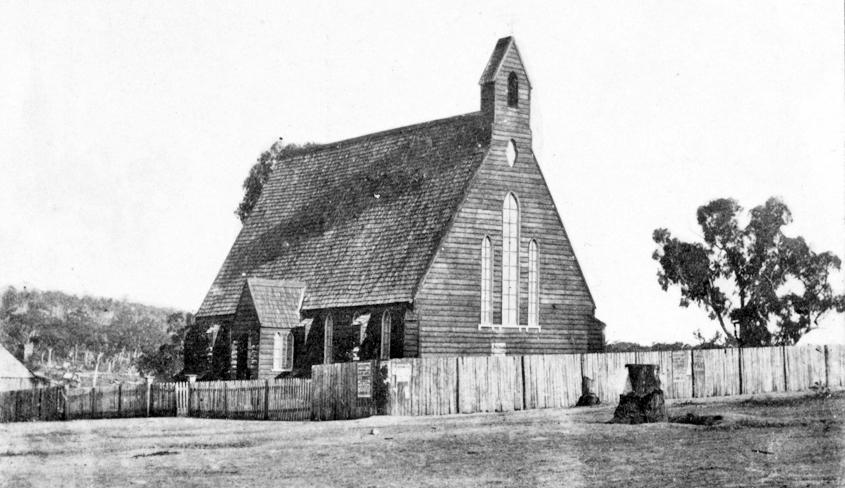
Beechworth’s first Wesleyan Methodist Chapel, a “basic, dark wood building with a high-pitched roof and relatively squat walls and windows” at 26 Ford Street, is completed. Previous services have been held in a tent and at F.R. Bernard & Co. Auction Rooms. The first wedding held in the wooden chapel takes place on December 24th between hotel-keeper Christian Haeffner and Mary Conway.
1854 – Dec
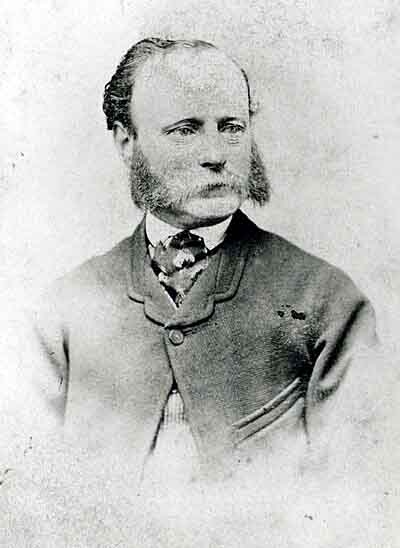
24-year-old architect Francis Hodgson Nixon and his business partner, 24-year-old Canadian-born auctioneer John Henry Gray announce plans (and offer a prospectus) for a local newspaper. They employ Cornishman Richard Albert Warren as the newspaper’s overseer.
| Richard Albert Warren has been working for Melbourne’s ‘Morning Herald’ newspaper, and he and his brother William Warren are tasked with purchasing and transporting a printing press from Melbourne to Beechworth for the new local paper. John Sitch Clark, who works alongside Richard Warren at the Melbourne ‘Morning Herald’, is hired as the Beechworth paper’s Melbourne agent, but will soon move to Beechworth to work with Richard Warren. |
1855 – Jan 6
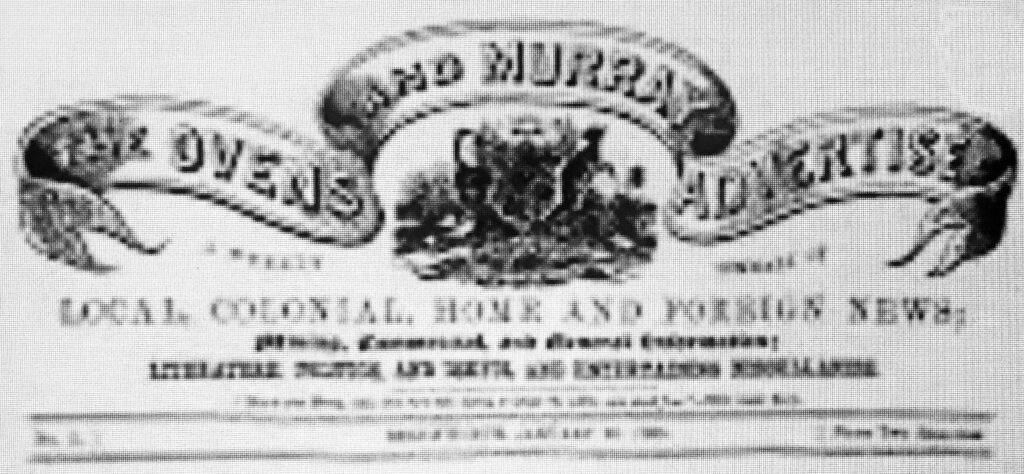
The first issue of The Ovens and Murray Advertiser newspaper is published in Beechworth by Francis Hodgson Nixon and John Henry Gray. Coming out once a week on a Saturday, the tabloid, which consists of just a few pages, is considered “very expensive” at two shillings a copy, at a time when the daily Melbourne newspaper The Argus sells for just sixpence. Despite the high price, The Ovens and Murray Advertiser will (eventually) become required reading and a staple of the town and is still published today – one of the oldest continuously operating newspapers in Australia!
| Within weeks, the relationship between Nixon and Gray has broken down and in April 1855 their partnership is dissolved. Francis Hodgson Nixon continues alone and quickly halves the price of the ‘Ovens and Murray Advertiser’ to one shilling, but increases the size of the newspaper to a broadsheet. However, Nixon will continue to face financial difficulties and will sell the newpaper four months later (see entry 1855 – Aug) |
1855 – Jan

Beechworth’s first day school opens in the wooden Wesleyan Methodist Chapel at 26 Ford Street.
1855 – Jan
The first service of the Congregational Church is held at the Freemason’s Arms Hotel on High Street, followed by services at William Henry Neuber’s Beechworth Assembly Room on Ford Street and later at the 1856-built the Athenæum Hall.
1855 – Jan
William Henry Neuber, the German musician who had established Beechworth’s first hotel on Ford Street in 1853, passes away suddenly at the age of just 43. His widow then offers a short lease of his Beechworth Hotel (aka Neuber’s Hotel).
1855 – Feb
Michael Langford takes up the lease on the late William Henry Neuber’s Beechworth Hotel on Ford Street, along with the Beechworth Assembly Room next door. Operating the businesses in partnership with a man named Mr Atkinson, the two men quickly begin running the Beechworth Assembly Room as a “Dancing & Musical Saloon”, engaging violinist George Griffith and harpist George Zeplin to provide the musical entertainment, while ordering a new piano from Melbourne to ‘enhance the range of music’. The ‘Saloon’ operates from 6.30pm to midnight six days week and quickly proves a hit. Langford and Atkinson soon begin a revamp of the Assembly Room, reopening it on April 1st as the ‘Salle de Valentino’ (‘Valentine Hall’) (see further entry below).
1855

A regular coach service is established between Melbourne and Beechworth. The new coach line – Green and Connolly – open their booking office at John Duncan Fisher’s Commercial Hotel on Ford Street, from where their coaches depart and return. Within a year a rival Beechworth coach service, Foster & Vinge, will open their opposition booking office directly across the road from the Commercial Hotel at the Star Hotel. Eventually both coaching lines will be absorbed by Hiram Allen Crawford and his coach line Crawford & Co, the coaching giant which will defy the mighty Cobb & Co to become the most important coaching line in North-East Victoria and the Riverina.
| The ‘Green and Connolly’ coaches that run from Melbourne – including various stops and changes of horses – take just over 24 hour to complete their journey. A coach departs Melbourne at 11.45am and then reaches Kilmore at 4.20pm, Seymour at 8.00pm, Euroa at 1.45am, Benalla at 6.00am and then (hopefully) arrive in Beechworth by 12 noon. Coaches heading to Melbourne depart Beechworth at 7.00am and arrive in Melbourne at around 6.00am the following day |
1855 – Feb
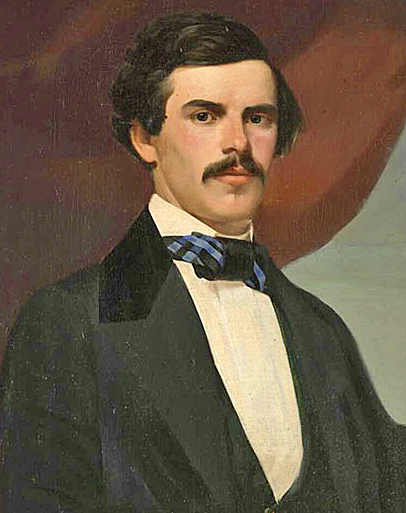
After finishing his job on the punt across the Murray River in Albury, and selling his Albury billiard room and bowling alley, American Hiram Allen Crawford and his new bride Anna decide to move to the ‘Woolshed’ near Beechworth where a goldrush is in full swing. Upon their arrival, Crawford joins fellow American John Barton – “Woolshed Jack” – who had taken up the first prospecting claim on the field. Together Barton and Crawford introduce the first steam engine for mining purposes used in the Ovens district. Crawford – who had received a good technical education at East Hampton in America – is able to take sole control of the engine and steam pumping plant. For the next 18 months, Hiram finally finds great success gold mining and he and his wife have two daughters. Richer by a thousand ounces of gold, Hiram Crawford then travels to Melbourne to seek advice about his future business opportunities from his old Massachusetts friend Freeman ‘King’ Cobb (of ‘Cobb & Co’ coaching fame) who strongly advises Crawford to enter into the coaching business, promising that if he does so, Cobb will agree not to compete with him in North-East Victoria. Hiram Crawford likes the idea and returns to Beechworth … going on to become one of Beechworth’s most important citizens. (see further entries below)
1855
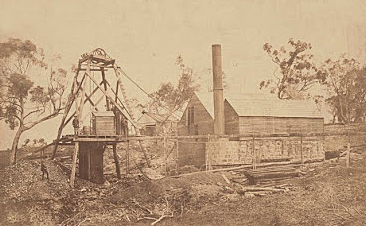
‘Big’ John Johnston follows the lead of fellow Woolshed gold miners – Americans John ‘Woolshed Jack’ Barton and his partner Hiram Crawford – and begins using a steam-driven pump on his Woolshed claim and soon obtains rich rewards. Johnston is said to have made between £50,000 and £100,000, although he will die almost penniless in Queensland’s Warwick Hospital in 1902.
1855 – Feb 12

Although there has been a punt at Wangaratta, allowing people and animals to cross the Ovens River, along with three or four very small ‘rickety’ bridges (for foot traffic only), the first ‘proper’ bridge over the river is completed, making it easier for people, horses, carts, carriages and livestock to reach the goldfields at Beechworth from Melbourne. (A tender is quickly called for the erection of a toll gate on the new bridge.) Built to a Canadian design, spanning the Ovens River in a single narrow arch, the bridge is constructed by gangs of men using newly imported American axes for the first time in the colony. Murphy Street in Wangaratta replaces Ovens Street as the town’s main thoroughfare, so William Henry Clark – the ‘Father of Wangaratta’ who owns dozens of blocks of land all over town – builds the two storey Commercial Inn (later the Commercial Hotel)on the south-east corner of Murphy and Reid Streets. At the same time, Wangaratta’s first church services are being held, and the Wangaratta Agricultural Society is founded.
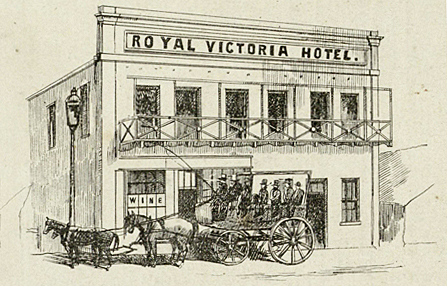
| Previously, a punt, commissioned by William Henry Clark in 1848 and operated by ‘Billy the Puntman’ has been the only way of crossing the Ovens River at Wangaratta. The strong boat is constructed, at a cost of £500, of hand sawn red gum, 30 feet long and 11 feet wide with several rope lines tethered on each side of the river, taking the strength of two men to haul it across the wide stretch of water. The ‘Wangaratta Punt’ will cease operations once the bridge is opened in 1855 and ‘Billy the Puntman’ (real name: John Hyde), now out of a job, turns to bushranging. |
1855
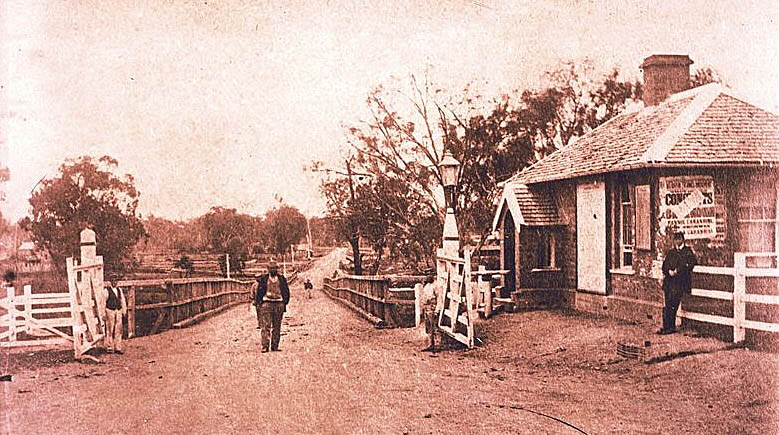
At Wangaratta, a Toll Gate is added to the bridge over the Ovens River. The gatehouse keeper, Mr P. Hanna, lives in a residence at the gates to charge users when they cross.

1855
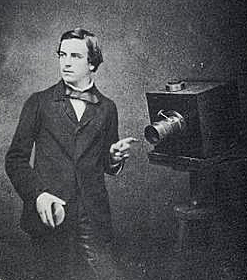
21-year-old inventor and pioneering English photographer Walter Bentley Woodbury bases himself in Beechworth for a few months and, with a business partner named Spencer, establishes a photographic studio, shooting portraits of local miners as well taking many early photographs of the Spring Creek and Woolshed Creek diggings and surrounds. One of his Beechworth photographs is below.

1855 – Mar 31
Thomas Allen, a veteran of the Battle of Waterloo in 1815, arrives in Beechworth. He was wounded in the battle and, after trying his luck on the Ballarat goldfields where he is caught up in the Eureka Stockade and loses his tent and all his possessions to a fire, is now down on his luck, after his horse collapses and dies as he approaches Beechworth. Local miners and storekeepers rally around Allen, running a successful appeal to buy him a new horse, tent and basic supplies.
1855 – Apr 1
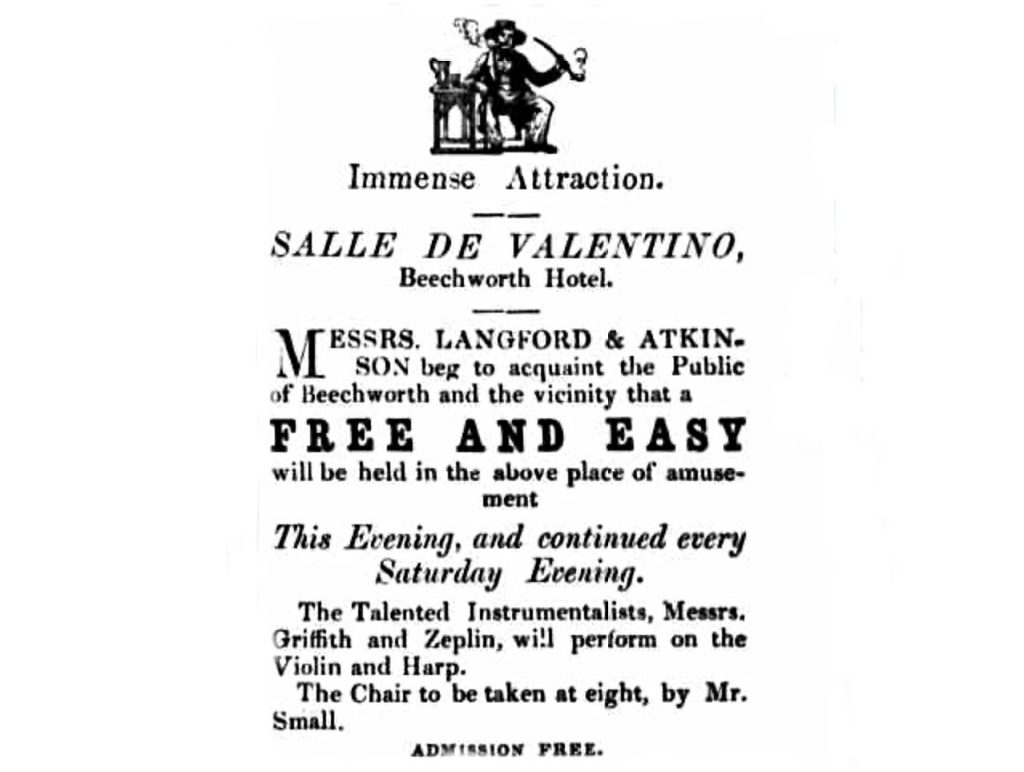
The Assembly Room – adjacent to the Beechworth Hotel on Ford Street – is refitted and reopened as the Salle de Valentino. The transformation of the previously plain and simple Assembly Room will continue over the coming months under the guidance of the two men renting the business from William Henry Neuber’s widow – Michael Langford and a Mr Atkinson. They hire renowned London and Melbourne entertainment maestro James Ellis – the manager of Melbourne’s original Salle de Valentino – to lure the best musicians he can find to Beechworth and advertises a “Grand Ball and Promenade Concert” every evening for the admission cost of one shilling. The opening night concert features renowned performer Robert ‘Billy’ Barlow – “one of the greatest monologue and buffo entertainers of the day” – performing “The Account of the Beechworth Assize Ball”, a musical monologue he has written especially for the occasion.
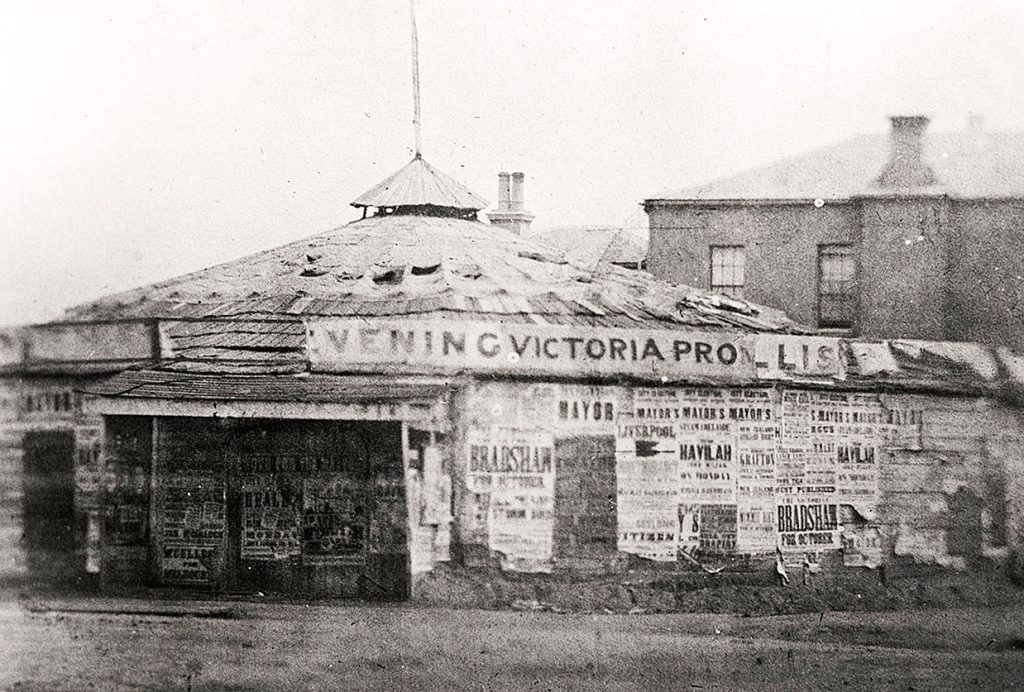
| Beechworth’s ‘Salle de Valentino’ (“Valentine Hall”) is inspired by Melbourne’s ‘Salle de Valentino’ (above) – a popular new circular wooden building – a half-barn, half-tent entertainment venue – on the north-west corner of Bourke and Spring Streets, that had previously been the permanent home of ‘Nobel’s Circus’. When it opens in 1854 – managed by James Ellis – the star attraction at the Melbourne venue is ‘Madame Carandini’ whose husband is the famed dancing teacher at the ‘Old Model School’ on Spring Street. It falls out of fashion by the early 1860s and today, the 1864-built ‘Imperial Hotel’ stands on the site at 2 Bourke Street. |
1855

The ‘Beechworth Gold Fields Local Court District’ is established – as the Ovens district is divided into the Beechworth and Yackandandah districts – and Beechworth will be included in the ‘Supreme Court Circuit’ from 1856 (until 1919).
1855

Linden Cottage is built at 24 Ford Street, next door to the wooden Wesleyan Methodist Chapel.
1855
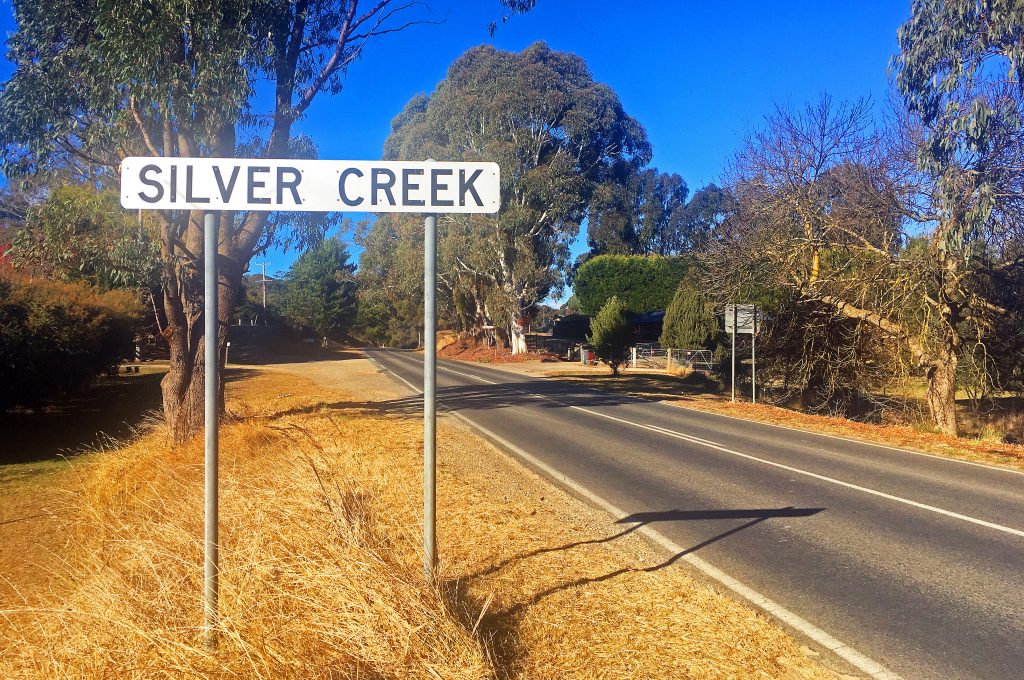
26-year-old Scotsman Donald Fletcher arrives in Beechworth. His first gold claim is a sluicing operation at Pennyweight Flat with partners Alfred Darvall and John Yoxall, followed by his own successful mining operations at Silver Creek, Eldorado, Clear Creek, Hurdle Flat and Yackandandah. In the 1860s Fletcher begins developing his own water supply network and by the 1880s the total length of the ‘Fletcher Water Race Network’ stretches for an impressive 12.5 miles (20 km)! He will also be one of the first miners to use hydraulic sluicing in the Beechworth district, eventually becoming one of the wealthiest men in town, and will build Beechworth’s grandest Victorian-era residence Myrla in 1875.
| In 1859 Donald Fletcher marries Elizabeth Davidson and together the couple have nine children. By the 1870s Fletcher – along with John Pund – has become one of the largest and most successful alluvial miners and water barons on the Beechworth goldfields. One of the first members of the local ‘Mining Board’, later in life Fletcher will take over the ‘Spread Eagle’ mine at Eldorado and continue working it – along with his mines at Yackandandah and Silver Creek – up until his death in 1904. |
1855 – May 19

Rapidly growing Yackandandah opens its first Public Hall. The Hall of Apollo is a 60 ft x 24 ft structure, attached to the Clarence Hotel (built in 1854 by Mr Jarvis). The opening is celebrated with a lavish ball and features the “star appearance” of the hugely popular Robert ‘Billy’ Barlow “the inimitable buffo singer” (a singer who specialises in comic roles) who had, a few weeks earlier, been the opening night act at Beechworth’s new ‘Salle de Valentino’.

| Lancashire-born Robert ‘Billy’ Barlow is one of Australia’s best known and most loved entertainers of the era. After successfully starting his career in Britain – including appearing with showman P.T. Barnum – he arrives in Melbourne in 1852 to appear at ‘Rowe’s American Circus’ before branching out to perform his musical comedy acts all over Australia and New Zealand, becoming particularly well known for his catchy song “The Blue Tail’d Fly” where audiences would join in as Billy sang and chased an imaginary fly around the stage! In 1870, he performs before Albert, the Prince of Wales – the future King Edward VII – who will honour Billy with his patronage for future performances throughout the colonies. After a 60 year career, he gives his final performance whilst on tour in Victoria – singing for two hours – when he is 86 years old! Billy dies in Queensland, aged 87, in 1907. |
1855

Emma Eliza Hazelton establishes her Mrs Hazelton’s Ladies and Children’s Drapery Store on Ford Street Beechworth. Emma and her husband William Styles Hazelton will close the store at the end of 1857.
1855
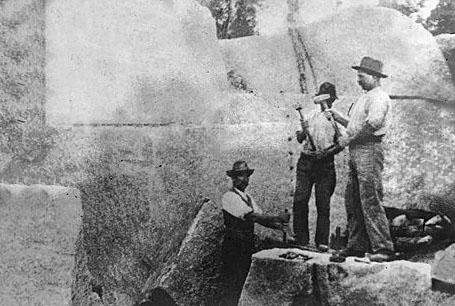
30-year-old architect Donald Fiddes arrives in Beechworth with his younger brother William Fiddes. Natives of Scotland, they had been carried away by the exciting news of the Australian goldfields and booked two tickets on a ship which sailed into Melbourne in 1854. After a few months in Castlemaine, they head to the diggings at Mayday Hills to try their luck. They will remain in Beechworth for the rest of their lives, quickly establishing the Donald Fiddes & Co. Quarry near the Woolshed. Using the granite from his quarry, Donald will supervise the construction of dozens of buildings that begin to make their solid appearance, as Ford and Camp streets take permanent form, along with the Newtown Bridge in 1875. He will also open a thriving furniture and upholstery warehouse at the upper end of Ford Street.
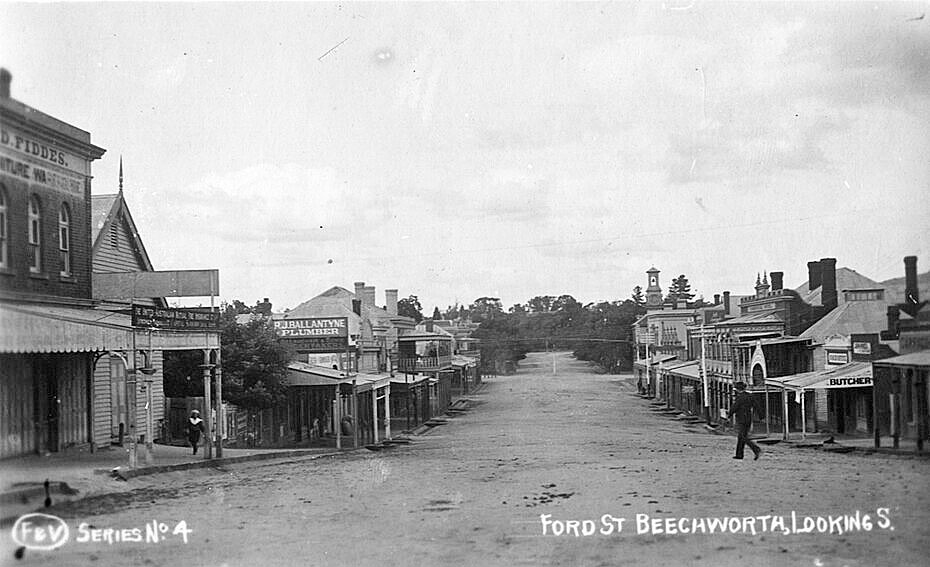
1855 – Jun 23
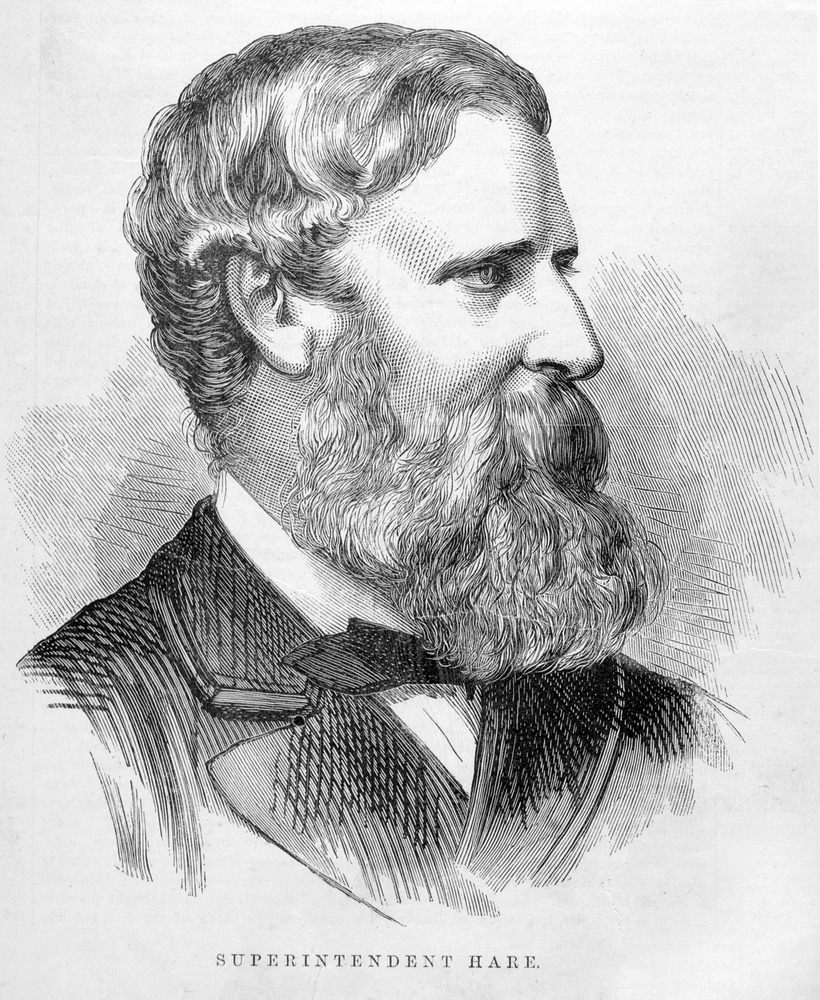
6’3″ tall South African-born Francis ‘Frank’ Augustus Hare (a 25-year-old lieutenant stationed at Wangaratta) is at a dinner party at Dr. George Edward Mackay’s property at Tarrawingee by the Ovens River when they are rudely interrupted by the bushranger Meakin (or Meaken) in search of £700 in cash Dr. Mackay had been paid the day before for horses. Meakin threatens two of the female guests with a gun and a large knife. Lieutenant Hare chases Meakin out into the garden and, after a protracted struggle, grasps Meakin’s colt revolver in his right hand and, with his left hand, repeatedly pounds Meakin between the eyes! Dr Mackay keeps Meakin tied up with saddle straps until a constable arrives from Beechworth the next morning. As a gesture of thanks and respect, Dr Mackay will present Hare with a handsome gold watch inscribed: “Presented to Lieutenant Frances Hare for his gallant capture of an armed bushranger at Tarrawingee, the 23rd June 1855”. Deeply grateful, Hare will carry the watch with him until the day he dies.
| Meakin is tried for burglary, having committed numerous similar offences. Kept under guard by Hare at the Wangaratta police station which is little more than a slab hut with earth floor. During the night Meakin attempts to escape by digging the earth floor of his cell and piling the dirt underneath his blanket to give the impression he is still asleep. Unfortunately, the process takes longer than expected and he is caught in the act the next morning. Later, he will be transferred to Benalla where, still determined, he escapes through the roof of his cell, still in his irons, and this time he is successful … Meakin is never seen or heard of again! On the other hand, Francis Hare will certainly be heard of again … becoming famous for his capture of Harry Power and Ned Kelly and his gang. |
1855 – Jul 9

A record 7,316 ounces of gold are received at the Beechworth Gold Office on this one day! At the current rate of AU $2,2885 per ounce, that would be valued at over AU $21 million today!
1855

28-year-old Scottish-born William Telford arrives in Beechworth. Coming from a family of entrepreneurs – bankers and businessmen – Telford continues the family tradition, becoming a principal shareholder of Beechworth’s busiest agents and auctioneers – John Henry Gray’s firm ‘J.H. Gray & Co’. Telford is active in the Beechworth Presbyterian Church and in 1859 will be appointed a Justice of the Peace and a Magistrate in the Indigo Police Court. In 1876 he will become chairman of the Rocky Mountain Extended Gold Sluicing Company when the company begins the boring of the ambitious 2,600-foot-long tunnel under Beechworth, which will enable mining to continue to a greater depth.
| Following the tragic death of 31-year-old John Henry Gray in 1861, William Telford will marry his widow Jeannie Gray (née Orr) on July 12 July 1864. Jeannie has 3 young children from her marriage to John Henry Gray. William and Jeannie will have 2 more children – John Dempster Telford and William Heugh Telford. |
1855

Cornish-born John Brewer arrives in Beechworth with his new wife Charlotte. He had arrived in Australia in 1849 as a 17-year-old where he was quickly engaged in taking cattle and sheep from Australia to New Zealand on sailing vessels, but once gold is discovered he heads to try his luck Ballarat and is there during the ‘Eureka’ riots. Brewer then makes his way to the Beechworth gold fields and, after not having much luck, establishes a dairy on the Wooragee Road about three miles from Beechworth. He prospers through hard work and later purchases more valuable properties at Wooragee vastly increasing the size of his dairy. John and Charlotte Brewer produce 9 children in the 1860s and 1870s. His successful dairy operates for decades, and Brewer personally delivers milk to his customers, and becomes famous for his punctuality, even into his early 80s. He passes away peacefully a few days shy of his 83rd birthday in August 1915.
| Just before Christmas Day in 1899 John Brewer, along with David Murray, his nearest neighbour at Wooragee, have their homestead leases destroyed by the infamous ‘1899 Bushfire’, with a massive loss of grass, cattle and sheep. Both will rebuild and continue to run their successful farms. |
1855

The widow of the recently deceased William Henry Neuber sells his basic timber Beechworth Hotel (aka Neuber Hotel) on Ford Street to flamboyant Scottish entrepreneur and wealthy miner John Alston Wallace who rebuilds it as a long two-storey wooden structure with weatherboard walls and a shingle roof, renaming it the Star Hotel (to add to his existing ‘chain’ of hotels, including the Star Hotel in Stanley and the Star Hotel in Yackandandah, which still operates today). Wallace also replaces the Beechworth Assembly Room next door – which had been operating as the Salle de Valentino – by building a new ‘Assembly Hall’ next to his new hotel, with seating for 500. It will later be renamed as Beechworth’s Star Theatre.

| Known as the ‘Mining Colossus of the North-East’, Wallace creates a new type of hotel in Beechworth, with the ‘Star’ featuring 24 bedrooms, a dining room seating 100 people, a theatre that can seat up to 500 people, rear stables containing 40 stalls and a Blacksmith, and its own orchid and vegetable garden. The ‘Star Hotel’ dominates the commercial centre of Beechworth and is claimed to be the biggest and most commodious hotel in the Ovens district. Peter Wallace, John’s brother, manages the Beechworth hotel in John’s many business-related absences. |
1855

One, Two and Three Mile Creeks reach their peak when Chinese miners arrive at the previously worked One and Two Mile Creeks. By 1857 there are 2,000 miners at Three Mile Creek, with many miners washing up to 17 ounces of gold a day!
1855

Having arrived in Australia from England at the age of 13 with his older brother 21-year-old Thomas Taylor Ladson, the now 15-year-old Alfred William Ladson and his brother move to Beechworth when it is basically still a ‘canvas town’. After a largely unsuccessful trip to the Californian goldfields, teenage Alfred returns to his brother in Beechworth and builds himself a hut on the Sydney Road and puts in a couple of years at wood chopping before gaining a position as a warder at the new Beechworth Gaol in 1859 which he does not enjoy. Alfred turns to manufacturing ink, blacking, and baking powder, successfully travelling around the country in a waggonette. He will eventually open a number of popular and profitable ‘Ladson’s Stores’ in Beechworth.
1855
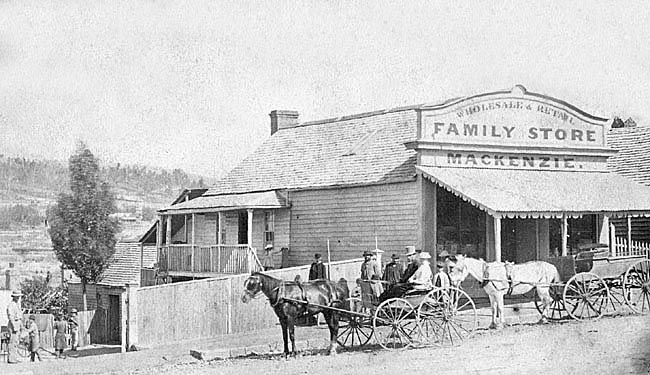
28-year-old Scottish-born Robert McKenzie establishes the Mackenzie’s Family Store on the very steep Newtown Hill. The family store will remain in business for over 100 years, with McKenzie and his family opening a second store at Milawa a few years later. In the late 1940s it is run by Harry Price, and in the 1950s John Hunt takes over and the main building becomes his grain store. In the 1970s it is run as a fruit and vegetable shop by George and Mary Harding. It is finally sold in the mid-1990s.


| Born in Greenock, Scotland in 1827, Robert McKenzie begins working in a provision and shipping store in Greenock – with his friends Archibald Macnaught Morrison (later an accountant, auditor, and financial agent in Camp Street) and J. C. Gray (later running a business in Wodonga) – where McKenzie holds the position of clerk in connection with bonded goods. The three men leave Scotland for Australia in 1852 aboard the ship ‘Hurricane’, arriving in Melbourne where McKenzie finds work at an ironmongery business at Geelong, while Archie Morrison and J.C Gray head for the Ovens Goldfields where they establish a drapery store at Silver Creek, eventually inviting McKenzie to join them. The three men later move their store to Beechworth, when Robert McKenzie withdraws from the firm and starts on his own ‘family general store’ at the Three Mile but, soon after marrying Jane Roxburgh, moves to Beechworth and builds his ‘McKenzie Family Store’ on the Newtown Hill close to the Newtown Bridge. Robert and Jane will later acquire a business at Milawa which they will run in conjunction with their Beechworth store. McKenzie is a firm adherent of the Presbyterian Church, of which he is an active supporter, holding the position of ‘Beechworth Elder’ for over 30 years. |
1855
36-year-old William Lawrence Zincke becomes the Clerk of the Court in Beechworth before setting up his own legal practice with his senior legal partner Frederick Martin at 22 Camp Street in 1863. The building has been a solicitor’s office ever since.
| Born in Jamaica in the West Indies in 1819, Zincke is educated at Bedford in England – studying law – before traveling to Australia in 1846 to take up a pastoral lease in the New England district of New South Wales. In 1851 he moves to Bingera to dig for gold – and has some success – before moving to the newly discovered Ovens diggings at Yackandandah, where he works with Captain Dickey near the township until 1854. By 1855, recognising the disabilities under which miners have to work, Zincke begins to use his London legal training to help them and then moves to Beechworth to take up his position as the Clerk of the Court. |
1855 – Aug

After just a few months in business, and facing financial difficulties, Francis Hodgson Nixon sells The Ovens and Murray Advertiser newspaper to its overseer Richard Albert Warren and his friend John Sitch Clark for £600. With the offer of quarter share in the newspaper, Warren and Clark recruit George Henry Mott, the Melbourne Herald’s Castlemaine correspondent, to become the paper’s editor, as well as recruiting American George Judah Lyon from the Mount Alexander Mail to come to Beechworth. Although it is always printed as a weekly newspaper (on Saturdays), it will be published as a ‘daily’ paper during three separate periods: January 1, 1857, to March 31, 1860; January 11-16, 1866 (during the final stages of an election campaign); and, under Richard Warren’s determined leadership, from April 2, 1872 to December 31, 1873. Warren will remain the newspaper’s proprietor and editor right up until his death in 1906 at the age of 75, considered to be the oldest active newspaper proprietor in Victoria at the time.
| Richard Albert Warren becomes a wealthy and respected member of the Beechworth community, one of Beechworth’s ‘pioneers’. He is a committee member and trustee of important organisations including the Board of Directors of the Beechworth Hospital, the Beechworth Asylum, and the ‘Rocky Mountain Sluicing Company’. Despite his up-coming jail conviction, he will even serve as the Sunday school teacher at the Christ Church in his later years. He survives financial ups-and-downs and, at the time of his death in 1906, he owns twenty-six properties in Beechworth. His wife Mary Ann, a very strong and community minded woman, becomes President of the ‘Women’s Christian Temperance Union’. It is said that she convinces many of the 170 Beechworth women to sign the ‘Women’s Suffrage Petition’. This petition plays a large part in women gaining the right to vote when Australian Federation is established in 1901. |
1855 – Oct
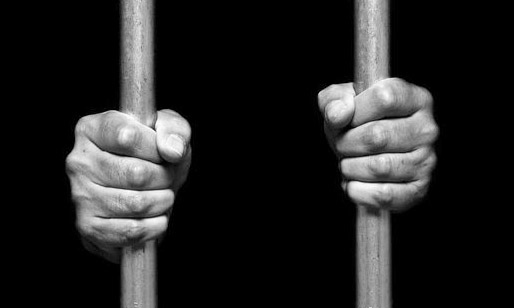
Richard Albert Warren, the new owner of the Ovens and Murray Advertiser is “indicted for wilful and corrupt perjury” and sentenced to nine months hard labour after falsely denying, under oath, that he had advised “the men employed by Francis Hodgson Nixon should sue him for wages … and smash Mr Nixon” and recommending “a Melbourne print-broker refuse Nixon credit”.
| Not long after Warren’s release from prison in 1856, George Henry Mott moves to Albury to establish ‘The Border Post’ and John Sitch Clark decides to go back to running hotels, so Richard and William Warren buy out both men from ‘The Ovens and Murray Advertiser’ for a total of £2,000. |
1855 – Oct

A new rush to Eldorado! After miners had tried their luck (with limited success) at nearby Eldorado sixteen months earlier – due to the gold being too deep for small-scale prospectors – a new rush begins utilising a new system of sluicing and water races constructed for up to a mile and a half and, by 1859, the first deep mineshaft is excavated. As this type of organised or ‘syndicate’ mining requires capital and equipment, the McEvoy Company is formed with 14 shareholders and James McEvoy as Chairman. More mines at Eldorado follow, including the Champion, United Ovens, Wellington, Warrior, Golden Stream, Golden Lake, Great Extended, North Wellington, Endeavour, Kangaroo, Spread Eagle, Tribet, Cornwell, Washington, The Tin Pot, and Try Again. The mining companies soon discover that the black sand in the wash dirt of their workings (previously considered a hinderance) contains tin, and some of companies set themselves up to mine both gold and tin, including the Kneebone Gold & Tin Mining Company (see photo above) who sink a 65 feet deep shaft which will be worked by 20 men aided by two steam engines to pump out the water and haul up washdirt. Tin will add an enormous amount to the total value of Eldorado mining operations and the first smelting of tin in Australia will be undertaken at Eldorado.
| By 1861 there are about 40 huts, 13 houses, 5 hotels and a range of businesses in Eldorado, including eating houses and clubs. After just ten years of mining, the population of Eldorado reaches over 1,500 residents and – with three newspapers – Eldorado even out-publishes Beechworth in its reporting of events. A Wesleyan Chapel and an Oddfellows Hall will be built in 1867 are soon joined by other public buildings including a brick Catholic Church, St Jude’s Church of England, a Congregational Church, a Courthouse and a brick school. At one stage there will be 20 hotels, some with their own theatres. The Eldorado township will peak with 4,000 residents in the 1870s before a gradual decline, although many of the more substantial original buildings remain in the small town today. |
1855 – Nov 15
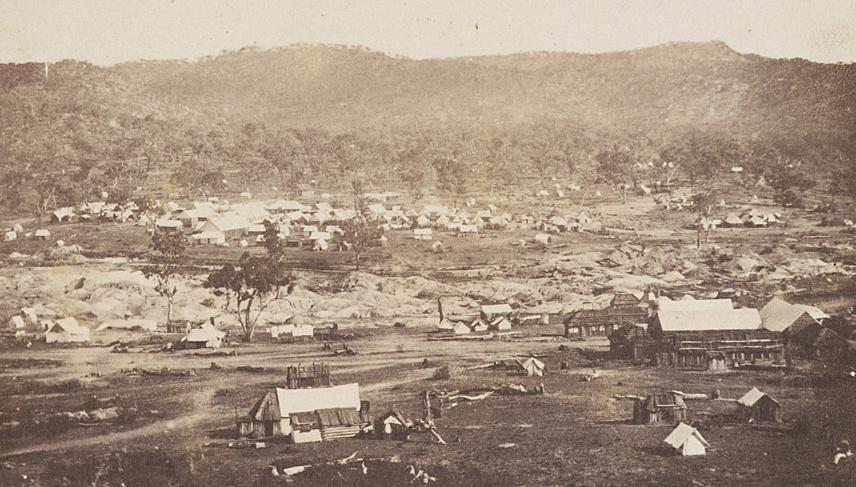
A school opens at the Woolshed diggings to educate the settlement’s growing population of children. Mr Ednot Burbank is employed as Head Teacher at the Woolshed School No. 660 which is situated between Reid’s Creek and Eldorado. Another school – O’Donoghue’s Catholic School – will be established a few months later in 1856 by Cornelius O’Donoghue, where both Aaron Sherritt and Joe Byrne (later members of Ned Kelly’s gang) are students. Their teacher is James Doherty.
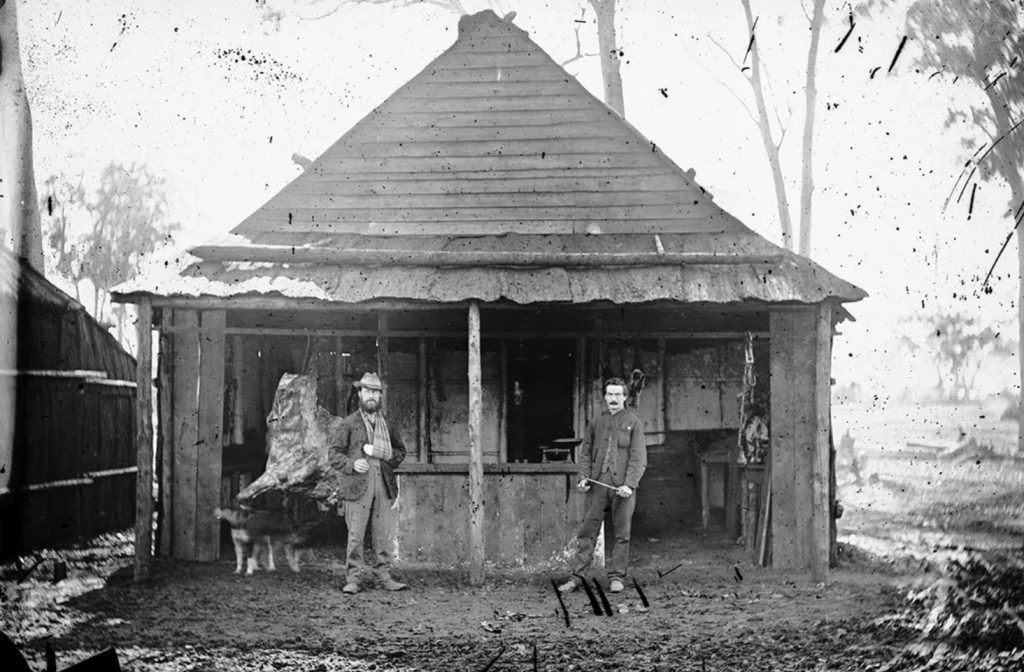
| At the height of the mining activity in 1857, businesses and traders at the Woolshed include 29 storekeepers 7 butchers, 14 hotels and 6 bookmakers. |
1855 – Nov 15
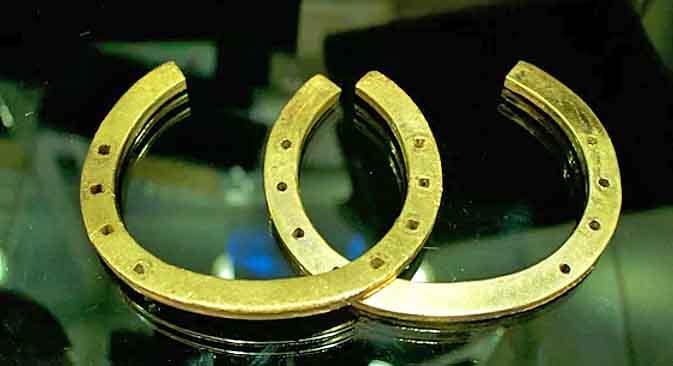
Election Day. Rivalry between two local mining groups, the “Monkeys” and “Punchers” sees them both forward a candidate to represent them in the ‘Ovens Electorate’ in Victoria’s first ever parliamentary elections. The “Monkeys” (or ‘wet diggers’) work the creek at the Woolshed and wear black woollen trousers and large, coloured handkerchiefs, while the “Punchers” (or ‘dry diggers’) work the dry banks and gullies and wear moleskins. On nomination day, a large procession of flag-waving, banner-carrying “Punchers” follow their candidate – prominent civic leader, American John C. Lyons who runs a pharmacy on High Street – to Beechworth, while the “Monkey” miners are led by their candidate – 36-year-old Woolshed storekeeper Daniel Cameron. The “Monkey” miners and Cameron march from the Woolshed to the Vine Hotel, a mile out of town, where Cameron’s horse ‘Castor’ (also referred to as ‘Tinker’) is shod with horseshoes made from 24-carat gold supplied by American ‘Big’ John Johnston (or Johnson), who now has the biggest gold mining lease in the whole district. Each shoe weighs 7ozs and 4dwts (pennyweight). When the procession sets off again, Cameron jubilantly rides at the head of the procession while his supporters run beside him handing out free pannikins of beer, which are replenished by runners from the Vine Hotel. As the procession nears the centre of town it is joined by colourfully dressed members of “William Brown’s Circus”, brass bands and 80 men on horseback. (The horseshoes are quietly removed when Cameron dismounts ‘Castor’ at the rear of the Star Hotel.) The huge crowd and free beer add to the day’s chaos, and although the police place a cordon across the main street, they eventually give up trying to control the crowd. Finally, both candidates – Lyons and Cameron – appear at the balcony of the Star Hotel and, by a simple show of hands (holding their miners’ rights documents), Daniel Cameron is declared “elected” but, not surprisingly, the “Punchers” demand a ‘formal poll’ rather than a show of hands, which will be duly held two days later. More festivities will follow when the result of the recount is announced (see next entry).
| At today’s prices, Castor’s golden horseshoes would be worth approximately $10,000 each. Since the 1960s a “Golden Horseshoe Festival” and Parade has been annually in Beechworth on the Easter Weekend. |
1855 – Nov 17

In the recount of the election, Woolshed storekeeper Daniel Cameron is again declared the elected candidate for the ‘Ovens Electorate’ and “Big” John Johnston (or Johnson) celebrates the ‘official win’ with a £300 shout of “champagne for all” at Reilly’s Union Hotel, where five hundred bottles of champagne are (reportedly) brought out and poured into buckets for the crowd! Daniel Cameron ends the day by making a tour of his new electorate in a gaily decorated carriage. That night, the local Chinese community stage a display of “several huge and marvellously illuminated fish that float across the sky with tails and fins flapping” and end the celebrations with “the greatest display of fireworks ever seen in Beechworth” featuring “huge rockets lighting up the entire reserve with the brilliancy of daylight”.
| Born in Perthshire, Scotland, Daniel Cameron arrives in Beechworth as a 34-year-old at the start of 1853, initially mining for gold, before becoming a gold buyer for the Bank of New South Wales and then establishing a store on the Woolshed diggings. Deciding to run for the unicameral (single legislative chamber) Victorian Legislative Council for the seat of Ovens, he lacks the £2,000 required to run, so his friends on the Woolshed raise the funds for him. Once he is successfully elected, Cameron will hold the seat until the original Council is abolished in March 1856. He will then be elected to the Legislative Assembly seat of Ovens in November 1856 before resigning in March 1857. He dies in Lilydale on 3 January 1906 aged 87. He never marries and leaves no descendants. |
1855 – Dec
Ford Street is extended, beyond where it had ended at the junction with Camp Street, as far as the junction with the newly named Kars Street (named after the Siege of Kars which had taken place in the Crimean War a month earlier).
1855 – Dec

With miners being regularly injured on the goldfields, and some becoming invalids – with no source of income – 28-year-old James Ingram calls a public meeting to discuss the urgent need for a public hospital. The meeting ends with a ‘hospital committee’ being formed – led by Ingram and George Briscoe Kerferd – and fundraising commences immediately. The idea of a hospital is met with a generous response across the Ovens goldfields and funds are raised quickly. The committee choose a site for the proposed hospital – land that slopes down to the Gorge south of Church Street – and it is quickly procured. Plans are drawn up by architect James Harold Dobbyn and, ten months later, on September 1st, the foundation stone for the new Ovens Goldfields Hospital will be laid. (see 1856 – Sep 1 entry below)

1856

Beechworth’s second coach line company – Foster & Vinge – is established, with John Alston Wallace’s Star Hotel on Ford Street becoming the headquarters of the new coach service, in direct competition with the Green & Connolly coach service, established a year earlier across the road at John Duncan Fisher’s Commercial Hotel. George Foster and George Vinge offer the daily 35-hour trip to Melbourne for £5 (see advertisement above) and then add ‘Royal Mail’ and passenger coach services between Beechworth and Sandhurst (Bendigo), Castlemaine and Maryborough.
| At the age of 21, London-born George Vinge had been transported to Australia in 1830 for stealing £37. After completing his sentence in Van Diemen’s Land, he moved to Melbourne in 1838, where he appeared before Magistrate William Lonsdale, charged with absconding from his master Mr Charles Hodden and is given one month imprisonment. Then, amazingly, one month later, he is appointed a Police Constable by the same Magistrate, because he can read and write! In 1842 Vinge marries Elizabeth Hale in Melbourne and they have 13 children. Moving with his family to Beechworth in 1855 he establishes his coach line and mail service with George Foster – contributing £6,000 to start the business. George Foster dies suddenly in 1857 and the following year George Vinge will sell their ‘Beechworth to Melbourne’ service to Hiram Allen Crawford’s newly established Beechworth coach company, with their other routes sold to ‘Cobb & Co.’ |
1856
Beechworth is referred to as “Ultima Thule” – “[the place to the furthest north] of North-Eastern Victoria”.
1856

Having already been in use for three years, Beechworth’s ‘Police Reserve’ is officially gazetted. Between 1857 and 1867 the numerous makeshift timber government buildings around the reserve will be replaced by more substantial and solid public buildings, constructed of local honey-coloured granite. These buildings (below) are now considered unique and historically significant in Victoria, and have been given an ‘A’ classification by the National Trust, the highest classification possible.

1856 – Mar
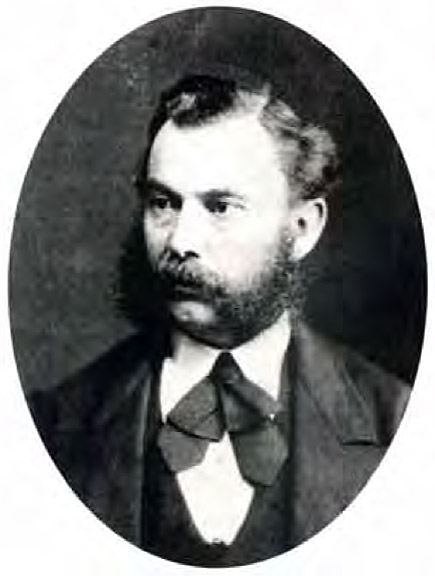
26-year-old John Buckley Castieau is appointed Governor of the Beechworth Gaol. When he arrives the Gaol is still a wooden stockade but, in 1858, he will oversee the beginning of construction of the granite Gaol that stands today (referred to as ‘Castieau’s Castle’ in Bill Wilson’s fascinating 2018 book).

| Throughout his career in the colonial prison service, Castieau keeps a detailed diary which is later edited by Mark Finnane and published in 2004 as “The Difficulties of My Position: The diaries of Prison Governor John Buckley Castieau, 1855-1884”. |
1856 – May 13
A new Beechworth society is founded – the Young Men’s Mutual Improvement Development Group – which is made up of around 120 of the more scholarly-minded in Beechworth’s mining community. Desiring a permanant Reading Room and a Hall for discussions and lectures, the ‘Beechworth Athenæum’ is officially instituted.
1856 – May 17

The first issue of Beechworth’s second newspaper – The Constitution and Ovens Mining Intelligencer – is published by George Henry Mott (formerly of Beechworth’s Ovens and Murray Advertiser) and his editor George Henderson and within weeks a second office of the newspaper is opened at the Two Mile near the bridge. Printed by Francis Hodgson Nixon and Co. of Camp Street, The Constitution and Ovens Mining Intelligencer is initially printed twice a week – Wednesdays and Saturdays – then three times a week, before becoming a daily paper on August 17, 1857. Quickly referred to by locals simply as ‘The Constitution’, the anti-Catholic paper quickly becomes a fierce rival of The Ovens and Murray Advertiser. It will cease publication on March 28, 1863.
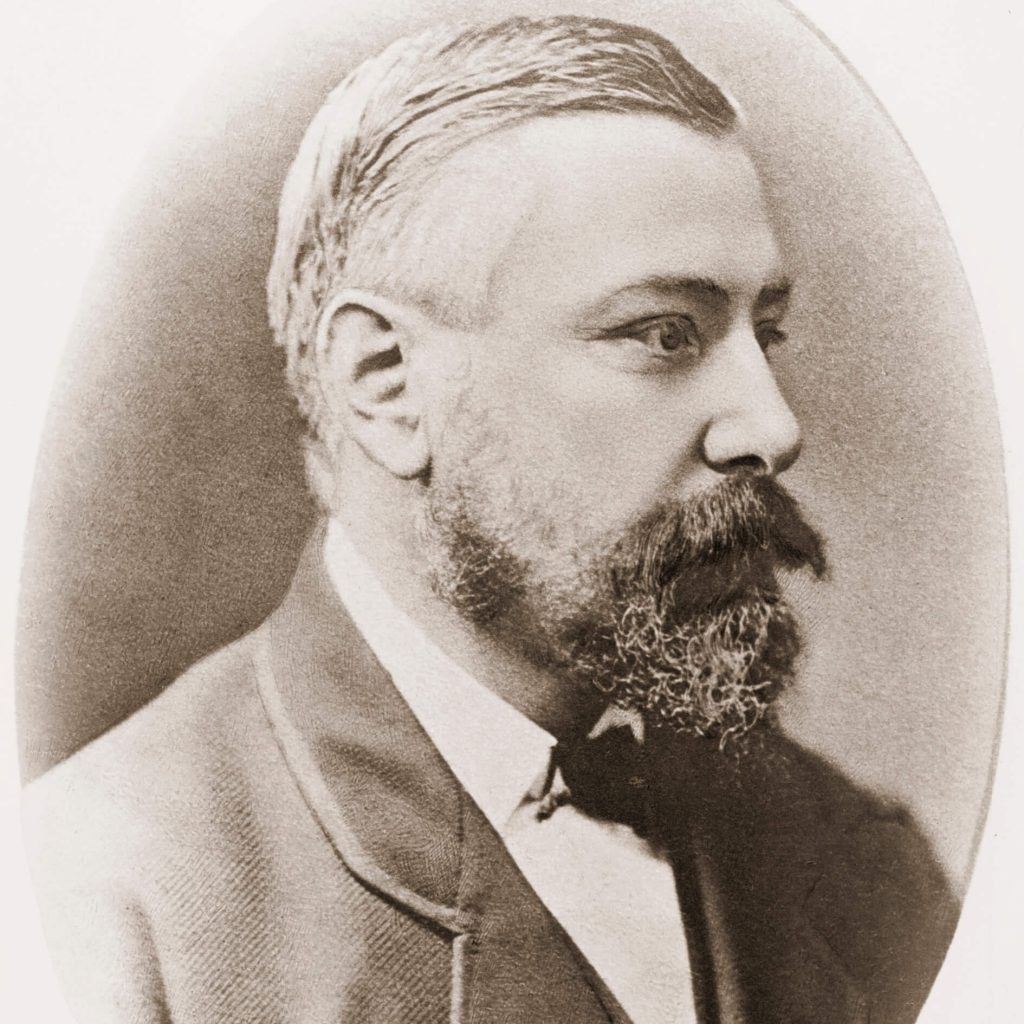
| The personal conflicts between the Advertiser’s editor, Richard Warren (an Anglican) and the Constitution’s editor, George Henderson (a Freemason), result in a libel case in 1859, where Henderson wins one shilling in damages. Both editors generate loyalty or opposition among Beechworth’s competing social groups. The ‘Advertiser’ and the ‘Constitution’ both follow a four-page format, with the front page reserved for advertisements, and both papers comprise broadsheet formats across 7 columns, devoid of artwork or pictures, with blocks of (quite small) print. |
1856 – May 22
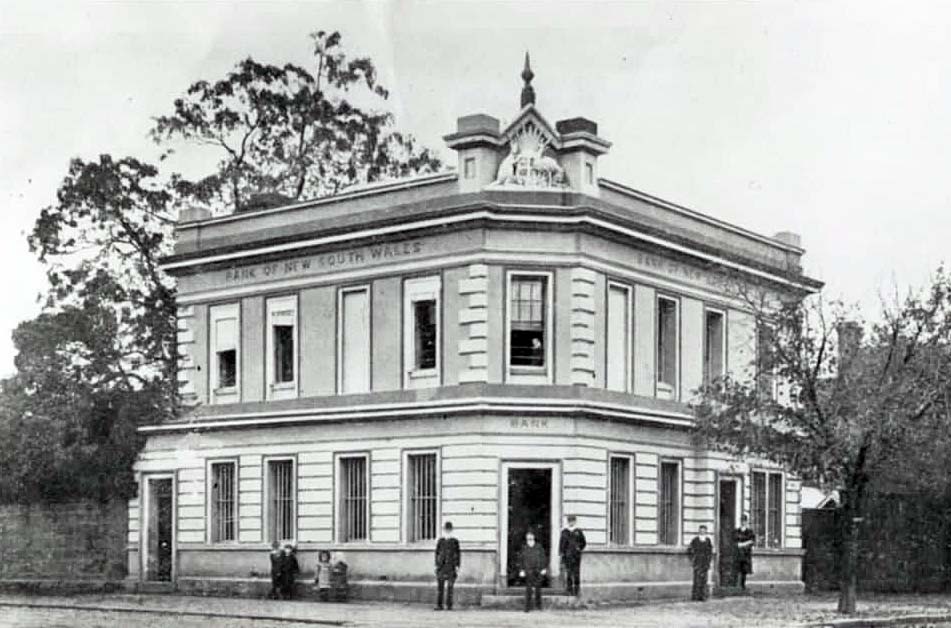
The Bank of New South Wales pays the astronomical sum of £1,000 for a prime site – a quarter-acre block – in the centre of Beechworth and starts to build an impressive branch on the corner of Ford and Camp Streets – the town’s first proper bank building – which will open in 1857. (An agency for the ‘Bank of New South Wales’ had been opened in Beechworth in 1853). It is designed in the conservative classical style known as ‘Renaissance Revival’ by the renowned architectural firm of Robertson & Hale. (Today it is one of the few known surviving works in Victoria of Robertson and Hale). The two-storey building is built for maximum security, with thick stone walls, a strong, heavily-bolted corner entrance door, barred ground floor windows and a high rubble wall enclosing the rear. The business interior, with its solid cedar fittings and stunning semi-circular cedar bank counter, is designed to inspire confidence in the bank’s proceedings. The front of the building features a unique parapet decoration with a superb coat of arms. A separate entrance in Ford Street provides direct access to the ‘Gold Buying Office’ with a recessed strong room, where gold can be stored while awaiting transfer to the nearby Gold Office and Sub-Treasury for escort. The upper floor features a comfortable Bank Manager’s Residence. High granite walls, which surround the rear yard of the property for security, still stand today, albeit with minor alterations, and is the home of Beechworth Honey Discovery.

| Between April 1855 and March 1857, the Beechworth branch purchases 303,582 ounces of gold for £1,148,545. |
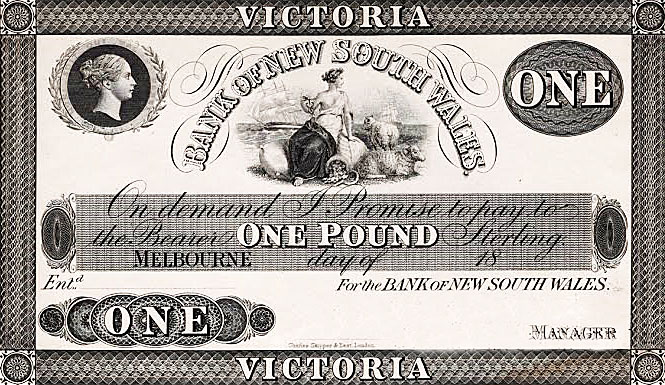
| The Bank of NSW building in Beechworth is one of the few 1850s bank buildings still proudly standing in Victoria. It is now the ‘Beechworth Honey Centre’ but most of the bank’s original features remain intact. The former bank manager’s residence on the first floor now operates as the “Hive Apartment” luxury accommodation. |
1856 – Jun 1
The Belvoir Post Office opens and will retain that name until 26 July 1869 when the name of the town is changed from Belvoir to Wodonga.
1856

Hungarian photographer Julius Albert von Rochlitz plants the region’s first major vineyards on his Havelock Road property. His 10 acres of vines include 95 varieties of grapes that he has imported from Adelaide. Rochlitz also creates a market garden and nursery business, growing rare types of vines, fruit trees and vegetables. Rochlitz’s gardens will supply Beechworth with much propagation material and his knowledge and experience with plants will lead him to win the design competition for the layout of Beechworth’s ‘Botanical Reserve’ in 1861.
| Born in Hungary in 1824, Rochlitz had been a professional soldier in Europe before arriving in Geelong in 1853, then relocated to Beechworth. He is also a music and language teacher and an accomplished composer. |
1856
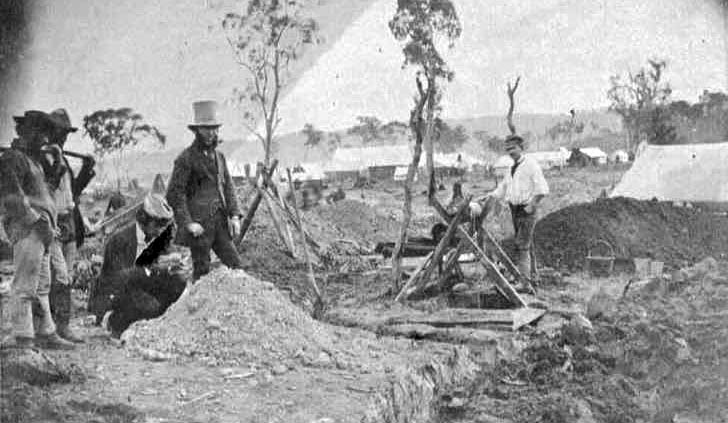
Miners rush to a new gold discovery between Beechworth and Yackandandah at Magpie Creek. The small township that grows there – just 9 km north of Beechworth – is soon renamed Wooragee – an Aboriginal word describing a peppermint-scented tree.
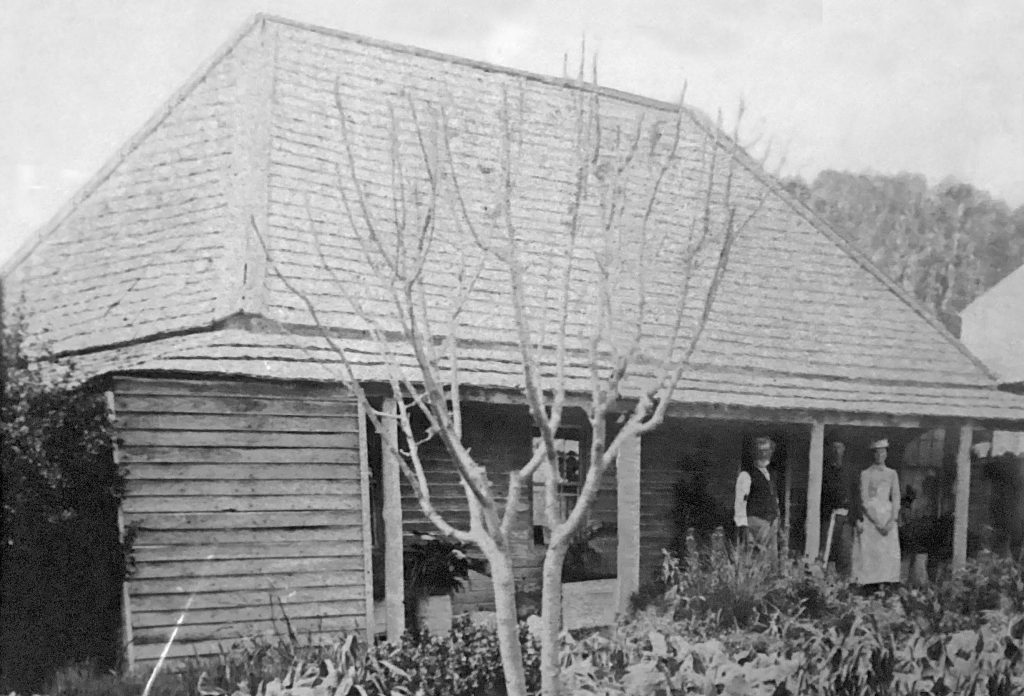
1856

Coaches operate between Beechworth and Eldorado via Sebastopol in the Woolshed Valley, with the heavily forested track between the locations becoming a popular spot for bushrangers. A man named Buttrey hides on his horse behind a massive rock and then springs forward, ambushing a coach carrying gold. Although Buttrey is caught shortly afterwards, the gold – believed to be carefully hidden – is never recovered. The rock the bushranger hides behind is now known as “Buttrey’s Rock” (above).
| Gold had been discovered at the Sebastopol Flat in late 1853 and by 1856 it has boomed, with a population of close to 6,000. Sebastopol will support numerous businesses and services along with a number of hotels offering nightly entertainment including balls, dances and concerts, with Sebastopol even receiving visits from ‘Wirth’s Circus’ and will become the location of Victoria’s first tin smelter. Future Ned Kelly associates Joe Byrne and Aaron Sherritt grew up at Sebastopol. Today, there is very little evidence that a township ever existed at the spot. |
1856
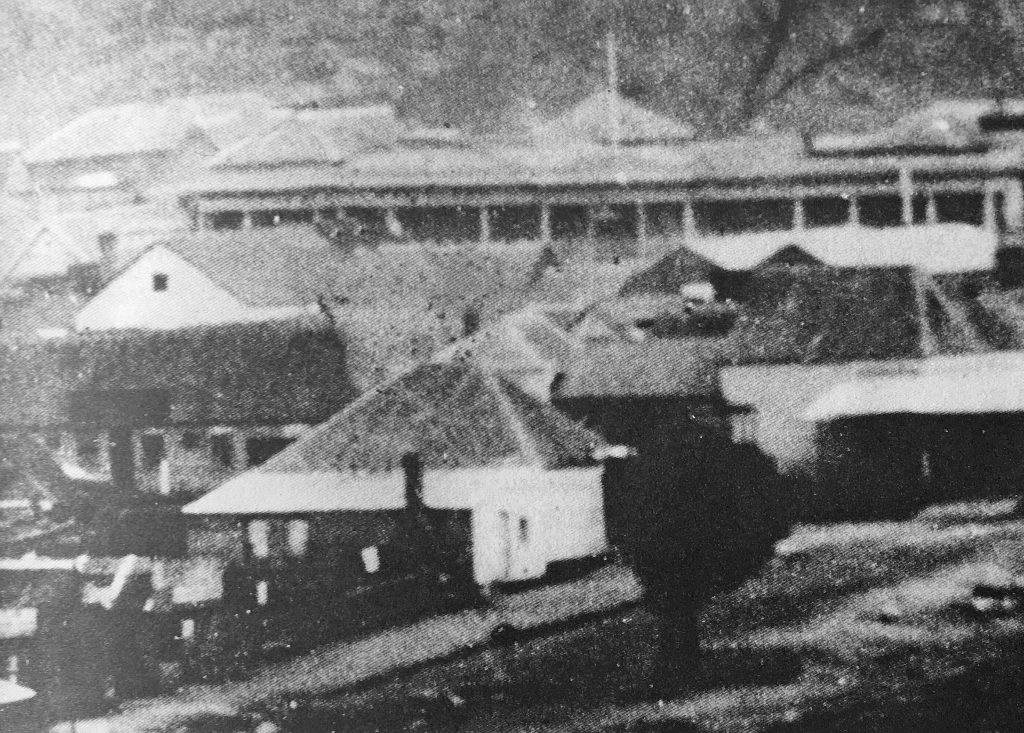
A Casino for Beechworth?! The Constitution and Ovens Mining Intelligencer newspaper reports that flamboyant Scottish entrepreneur and wealthy miner John Alston Wallace plans to open a casino at his newly built Star Hotel on Beechworth’s Ford Street … This does not eventuate! (And today, Beechworth is a “no pokies zone’!)
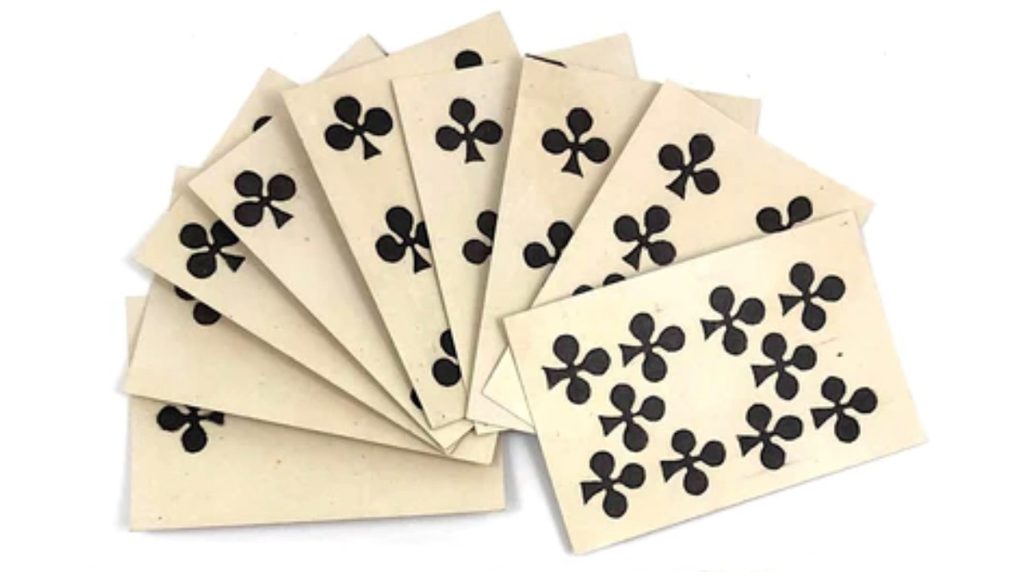
1856
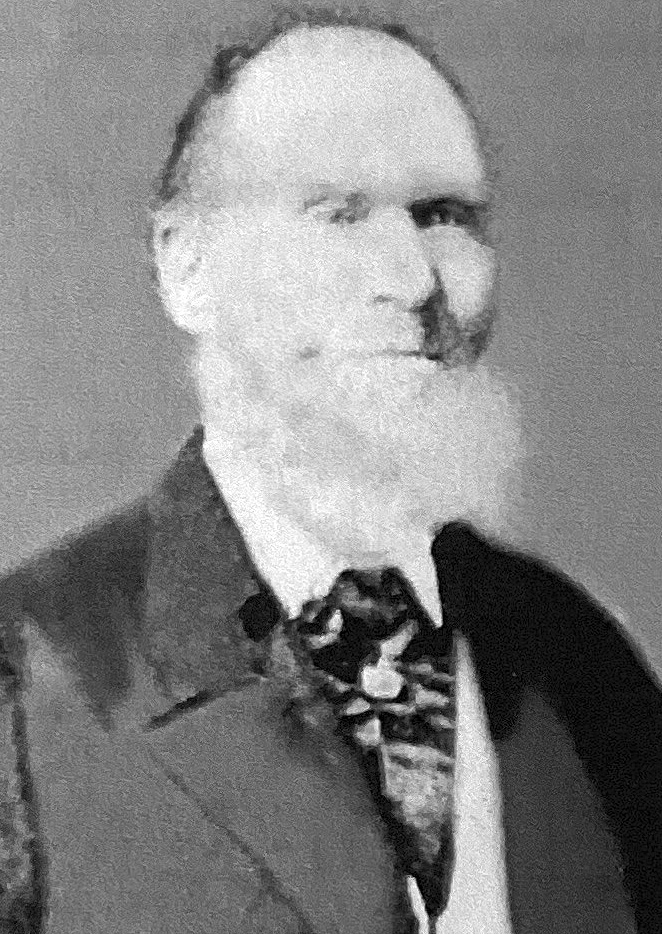
Lincolnshire-born King William Thompson Soulby arrives in Beechworth and, a few weeks later, marries John Sitch Clark’s sister Martha Margaret Clark. Employed as a compositor and printer for The Ovens and Murray Advertiser, the business-minded 26-year-old quickly sees other opportunities in Beechworth and on March 23rd 1857 he has built and opened the two-storey weatherboard Victoria Dining Rooms on the corner of High and Short Streets. By December, the affable pipe-smoking Soulby secures a publican’s licence and renames the business The Victoria Hotel and Dining Rooms. It features seven guest bedrooms. As he intends to expand his businesses in town and needs help, he sends for his parents – 50-year-old Michael Soulby and 45-year-old Jane Soulby – and they arrive in February 1858. W.T. Soulby then purchases a quarter-acre block of land on Camp Street on which he will build the London Tavern – the first hotel in Beechworth built of brick.
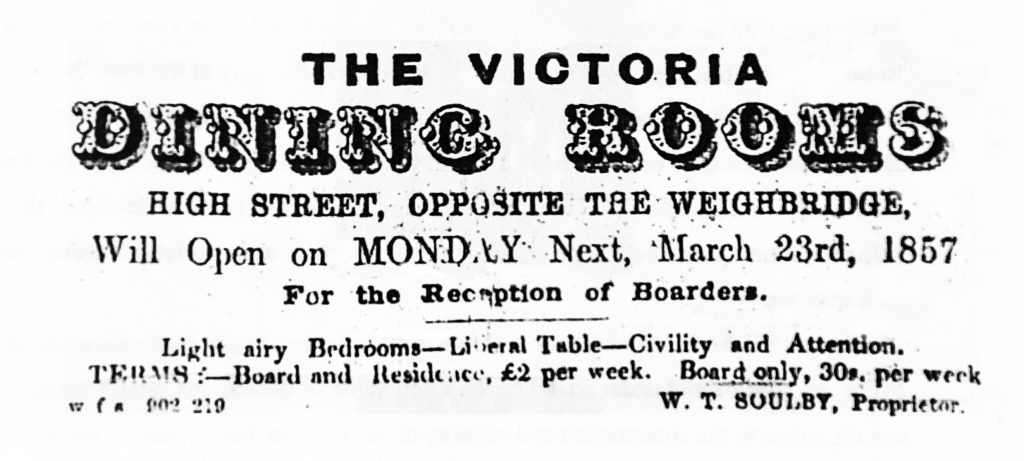
| Once William Thompson Soulby has opened his new ‘London Tavern’ in September 1859 he will install his father Michael Soulby as the new licensee of the ‘Victoria Hotel and Dining Rooms’. In June 1869 the Soulby’s sell the freehold of the ‘Victoria Hotel’ to Mark Baldwin for £350. The hotel will finish trading – and be demolished – by around 1888. |
1856

Scottish-born Andrew Love Galbraith (above) arrives in Beechworth as a 19-year-old and quickly establishes a Bakery and Confectionary business (his trade since the age of 14) at 51 Ford Street. Andrew marries Sarah Ross in 1859 and they will have 7 children – 5 sons and 2 daughters – moving to William Turner’s recently built Beechworth house ‘Nithsdale’. After 20 successful years in Beechworth with his bakery and confectionary shop, in late 1876 Andrew and Sarah and their children move to take up land in Gippsland, taking advantage of the Government Land Act which is opening up settlement selections at Tyers. Once established, Andrew Love Galbraith opens a successful bakery in Traralgon and becomes one of the districts leading citizens.

1856
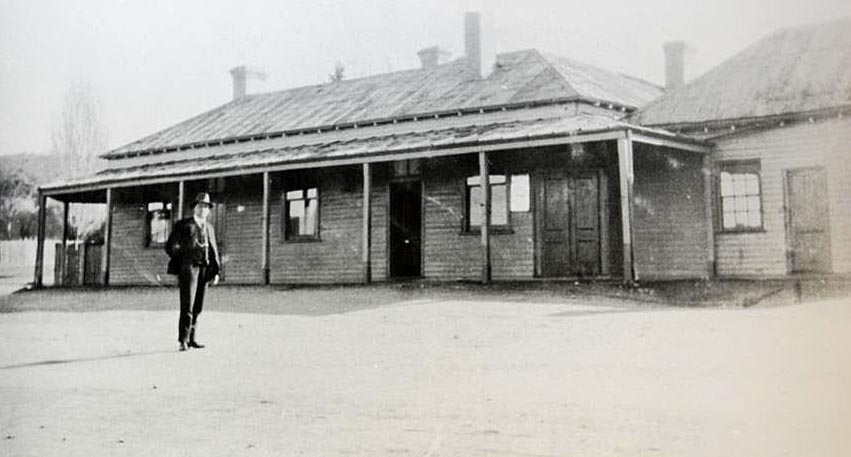
A party of Chinese working on the rise behind John Alston Wallace’s Star Hotel in Stanley uncover several good sized gold nuggets, the largest weighing over 5 ounces.
1856
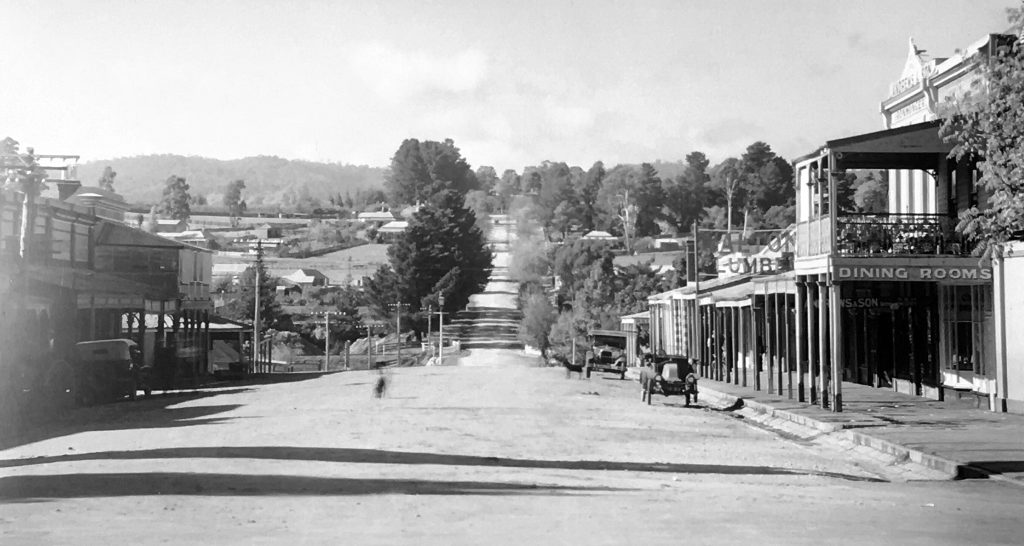
E. Forman & Company is established in Beechworth and will become the longest-lasting ironmongery and furnishing businesses in the North-Eastern district. In 1880 the Forman brothers business will be taken over William Frederick Andrews and his son William Jnr and W. Andrews & Son will steadily increase the business.
1856
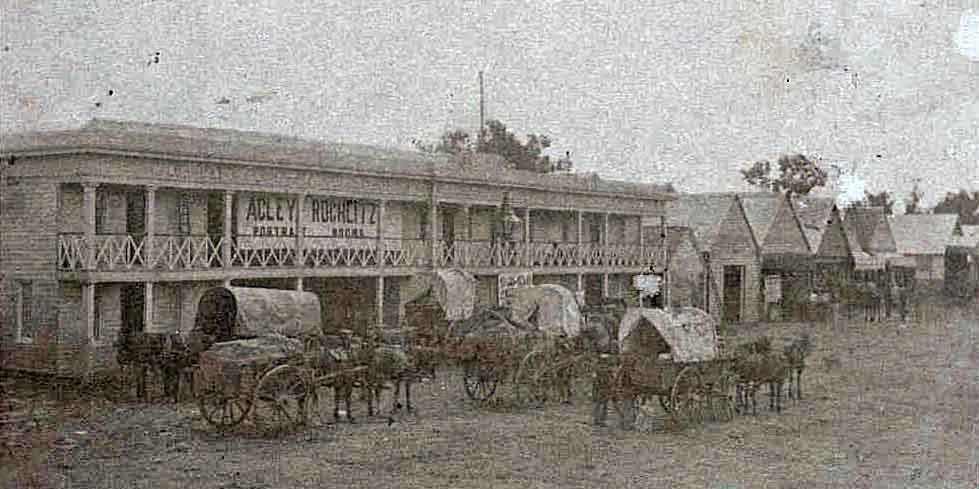
Julius Albert von Rochlitz begins a partnership with fellow photographer, American R.H. Acley, at their Acley and Rochlitz: Daguerrean Artists Studio, operating initially from the Star Hotel on Ford Street. A daguerreotype is an early photographic process employing an iodine-sensitized silvered plate and mercury vapour.
| Rochlitz is not only a professional photographer but also a composer, music and language teacher, author, civil engineer, landscape gardener and winemaker. He later returns to Hungary, where he dies in 1886. |
1856

39-year-old George Billson Senior – who had experienced life on the Californian goldfields – arrives at Wooragee (9km from Beechworth) where he purchases 140 acres of land and builds a two-storey hotel. He marries Isabella on 26 March 1864 at St. Pauls Church in Melbourne. From 1864 to 1867 Billson will be a publican in the Wood’s Point District near Mansfield, before finally settling in Beechworth where he will quickly become one of Beechworth’s most prominent citizens.
| British-born Billson had arrived in Adelaide in 1848 at the age of 31 before heading to the gold rush in California the following year. Attracted back to Australia in 1852 by the local gold rushes, he opens a store at Sandhurst (Bendigo) which he runs for the next two years before heading back to England. He returns in 1856 and, at the age of 39, settles at Wooragee. |
1856
A weatherboard house is erected on the corner of Camp and Loch Streets which will become home to a succession of Beechworth’s doctors and their families. Dr David Skinner builds the current brick building on the same site in 1892 and it still stands proudly today.
1856

The massive trunk of the 400 year old ‘But But Tree’ beside Spring Creek has now become the place for miners to leave messages and announcements – including missing persons notices – like an unofficial post office. The vast number of steel spikes and horseshoes nailed to its trunk will eventually cause the Apple Box tree (probably a union of two trees with a cavity in the centre) to become extremely galled.
| Originally the site of the first miners’ church services, the distinctive tree is also used by blacksmiths as a canopy to shield the sun. The ‘But-But Tree’ still stands on the corner of Tanswell Street and Dowling Court but suffers severe storm damage in 1991 necessitating the removal of several major branches. |
1856
Beechworth becomes the major administrative centre for the whole of north-east Victoria. There are five courts held in the town – Police, Petty Sessions, Mining Board, County and Supreme Court.
1856

29-year-old Yorkshire-born William Robinson arrives in Beechworth with William Dyson, and they are quickly engaged by general storekeepers Gregory, Taylor and Co to take charge of the store’s hides and skin department. Robinson and Dyson subsequently start their own fellmongery business (as dealers in hides and skins, particularly sheepskins, and prepare the skins for tanning) at Sheep Station Creek near Black Springs, 6 km from Beechworth. Their business partnership will run successfully until finally being dissolved in May 1890, at which time Robinson purchases an orchard and vineyard at Newtown near the Zwar Bros Tannery and turns to making honey. Robinson is a member of Beechworth’s Methodist Church congregation before joining the Salvation Army. He is also a member of Beechworth’s Oddfellows’ Lodge, of which he will become the oldest member in Victoria. He will marry Esther Vinall – who had immigrated to Australia in 1849 – and they will have eight children – four sons and four daughters. Esther will die at the age of 68 on December 26th 1896, and William will die from influenza at the age of 76 in August 1903 and they are buried next to each other at the Beechworth Cemetery. Robinson Road is named in their honour and the descendants of the Robinsons run the popular and renowned Beechworth Honey business to this day.
| Sadly, William Robinson’s property will be one of the many destroyed by the massive bushfire that sweeps through the area around in Beechworth, just before Christmas Day in 1899. |
1856
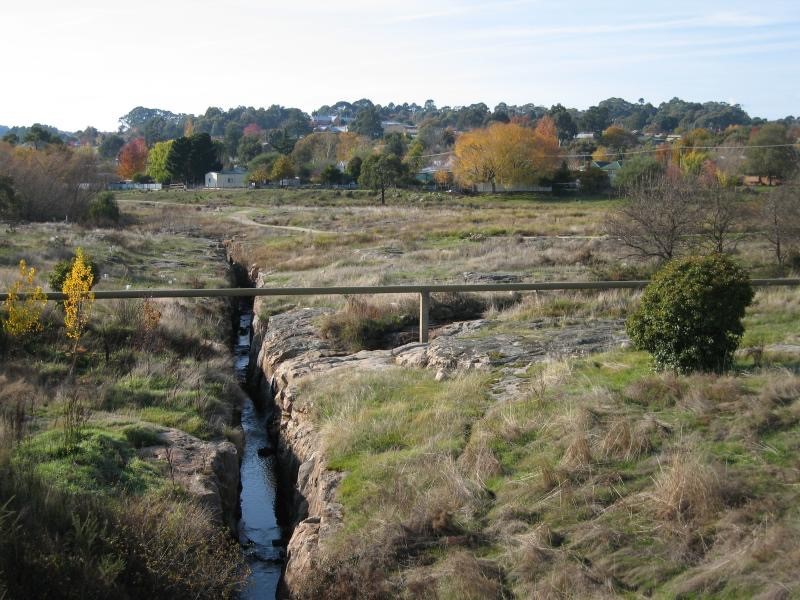
With a combined capital of £2,400, a small group of miners form the Union Mining Company when they win the right to run a tail race to drain the Spring Creek Flats. by draining water from the ‘Flats’ it will lower the water table so shafts can reach bedrock. A thin layer of gold is often found on top of the bedrock, covered with black sand. The company procure cheap labour from Melbourne – around 100 workers – and the work proceeds slowly. About a quarter of a mile of the great drainage race is cut, and a tramway is built to assist in carting the refuse down to the falls. Over the course of 18 months – and at a cost of £3,500 – the Union Mining Company cut the tail race through solid granite rock to a point above the Spring Creek Gorge (later known as the Newtown Falls) below the town, that give a fall of 2 inches in 12 feet. However, they aren’t able to drain the lower part of the flat with the race’s current depth and, with the company’s finances exhausted (the small quantities of gold obtained are insufficient to justify greater outlay) the shareholders agree to close the company. The men are sadly now each £150 out of pocket beyond the amount of their shares.
| The miners sell the rights to their ‘Union Mining Company’ to William Telford and Robert Ransom in 1863, who also purchase the three adjoining leases. A new company is formed – ‘The Rocky Mountain Company’ – with a capital of £6,000 in 600 shares of £10 each. Between October 1867 and July 1869, the existing tail race is cut again, even deeper, to a depth of 8 feet, through 450 yards of solid rock. Tragically, a contractor is killed during the blasting operations. Over the following seven years ‘The Rocky Mountain Company’ obtains 6,500 ounces of gold from its claim. |
1856

Beechworth’s second horse racing course, along with a new cricket pitch, is laid out on the Public Recreation Reserve (now Baarmutha Park). Early race meetings are usually a three or four-day affair!
| The first Beechworth horse races are held on a makeshift course at ‘Pennyweight Flat’ as the ground is desirably flat! |
1856
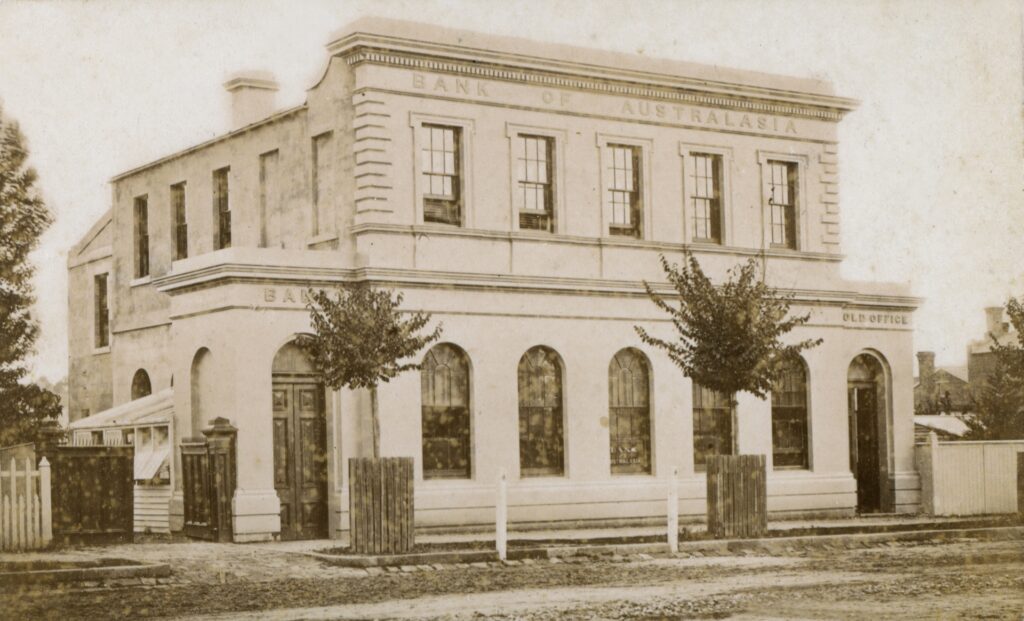
A Beechworth branch of the Bank of Australasia opens at 86 Ford Street. The grand building features 6m ceilings, ornate rosettes, arched windows, and a large bank vault built with thick granite blocks. The building stills stands today.
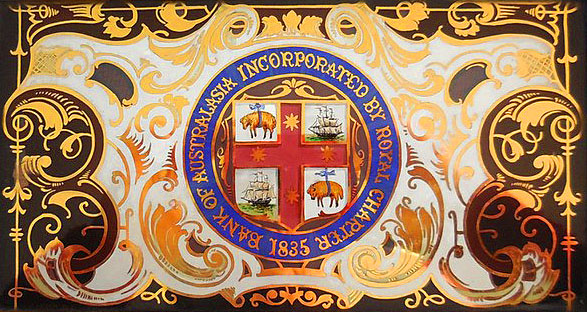
| Although headquartered in London, the Bank of Australasia is an Australian bank which operates from 1835 to 1951. Its first branch opens in Sydney in December 1835, followed by Hobart and Launceston in January 1836, and Melbourne in August 1838. In 1951 it will merge with ‘Union Bank of Australia’ to form the ANZ – the ‘Australia and New Zealand Bank’. |
1856
Plans are made for ‘New Ford Street’ (later known as ‘Upper Ford Street’) allowing Ford Street to continue in a curve along the rim of the Gorge so that it can connect with the Spring Creek diggings.
| Although Government Surveyor George Smythe designs High Street as Beechworth’s main thoroughfare, following along beside Spring Creek, it soon becomes apparent that High Street will not work in that capacity. Firstly, it is very difficult to build on the creek side of High Street because the land falls away too steeply towards the creek; of all Beechworth’s streets, it is the narrowest (because of the creek) at just 66 feet wide (while the others are 99 feet wide); and the success of so many new hotels and other businesses on Ford Street, it is where most of the people gather. Inevitably Ford Street will become the ‘centre of town’. |
1856
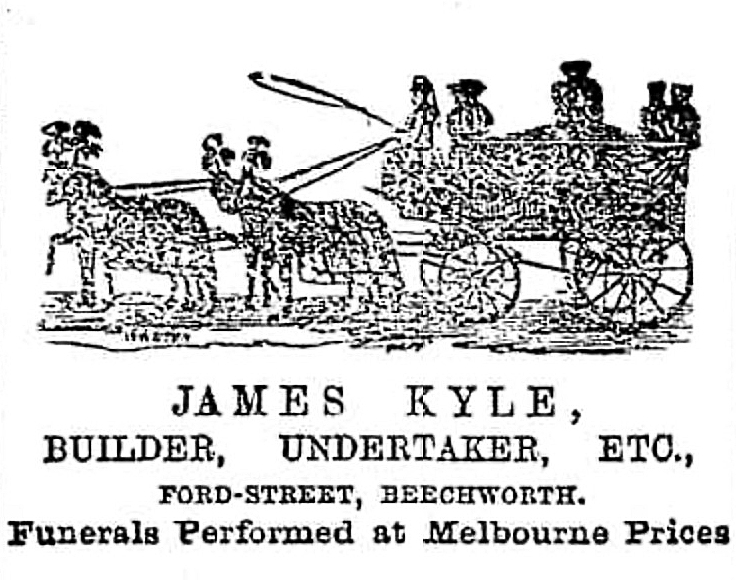
30-year-old Scottish builder James Kyle arrives in Beechworth with his wife and young son. He builds a new shop at 39 Ford Street (below) from where he will run his ‘Beechworth Undertaker’ business, and as the base for his successful building company, which will carry out a number of successful building works throughout Beechworth. James Kyle will also be one of those responsible for building Albury Railway Station in 1881.
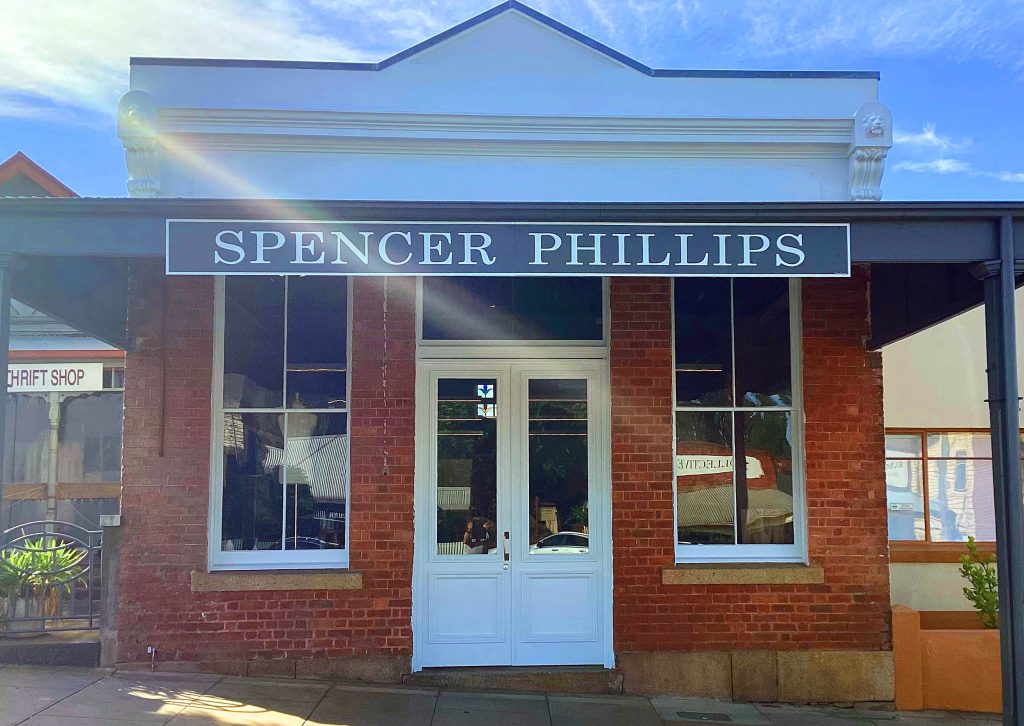
| Kyle arrived from Scotland on 13 September 1853, landing at Port Phillip Bay in Melbourne aboard the ship ‘Sophia Burbidge’ (which he had purchased for the voyage with a syndicate) with his wife Elizabeth and their 3-year-old son Alexander. (Another son, 10-month-old David, had died during the sea voyage.) James and Elizabeth will go on to have 8 more children, of which only 3 survive to adulthood. James Kyle will live a long life, passing away aged 90, on July 8th, 1916. He is buried at the Beechworth Cemetery. |
1856
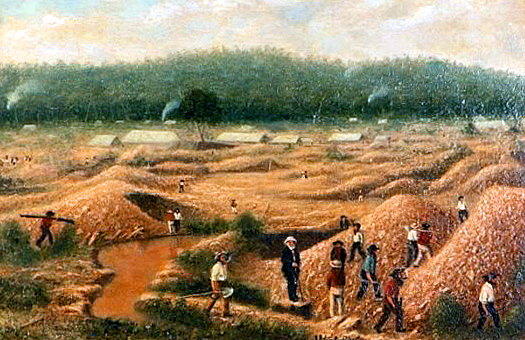
Chiltern artist Alfred William Eustace paints a small picture of the Woolshed gold diggings and during the next few years becomes well known in North-East Victoria, holding exhibitions of his art in Albury, Ballarat and Melbourne and by 1896 he is receiving orders from many of Europe’s most important families. Examples of his work are acknowledged by Queen Victoria, Emperor Frederick of Germany, the Czar of Russia along with the Governors of NSW and Victoria.
| Eustace is also a skilful taxidermist and many pieces prepared by him are now among the collection of birds and animals in the Beechworth Museum. He is a contributor of letters and verse to the Chiltern newspaper and in the 1870s shares in a lively debate on spiritualism. |
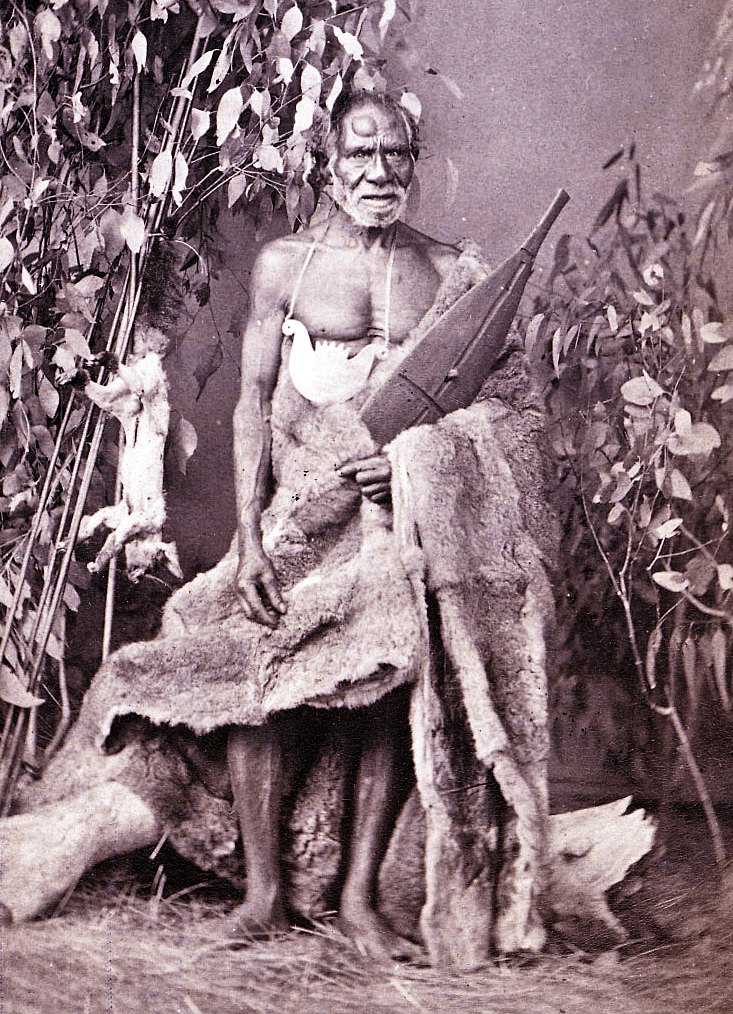
The Ovens and Murray Advertiser newspaper reports local Aboriginal people continue to hold their annual corroborees in Beechworth – “camping a short distance from town, near the [race]course” (now Baarmutha Park). Similar reports are published in the newspaper over the following three years.
| Towards the end of 1856, a remnant of the Barwidgee aborigines is still in existence, King Billy Barwidgee (or King Billy Elengeist) (above), their leader, being a familiar character. He is “adorned with a brass plate suspended from his neck with his name engraved on it, which he was very proud”. “The moon was at its full. They were painted with white lines that gave them the resemblance to skeletons, and danced round a fire, while two old gins kept up a tattoo with sticks and made a droning kind of noise. There was no melody in it, but the time was perfect.” |
1856
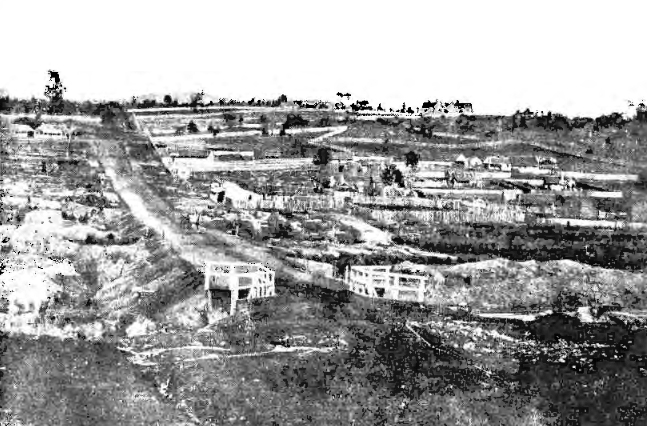
A second bridge is built in Beechworth. This one is a small wooden bridge over Spring Creek at the foot of Camp Street (leading up to what is later named Albert Road towards the Mayday Hill). In June 1863 the little bridge is seriously damaged when Spring Creek floods. It is quickly repaired but in June 1870 it is “entirely swept away” when the creek floods again, then rebuilt … again, where it will stay in use until 1929 before being replaced by the current stone and concrete structure.

| Albert Road is named for Queen Victoria’s husband Prince Albert who dies in December 1861. |
1856

After arriving in Victoria in 1854 and heading straight to the Ovens district to try his hand at gold mining at Stanley, 25-year-old English-born Richard Finch takes over the business operated by G.W Withers at 68 Ford Street and operates his men’s outfitter shop until his retirement in 1902 when his sons Richard Jnr and Willie take over the business.
1856 – Aug 5

A large contingent of Chinese arrive on the diggings at Beechworth, watched by large crowd of curious miners. Around 500 Chinese men – all seemingly dressed the same and carrying their worldly possessions on their shoulders – make a procession through the town. They have walked 400-kilometres overland, along the old cattle route, from Robe in South Australia, escorted by a European man who acts as their guide.
| Much easier than droving a large and unruly mob of cattle, it is a lucrative business for the guide who charges the Chinese ten shillings per head for the cross-country trek. Picking up the new arrivals at Robe in South Australia – to escape the Victorian Government’s £10 immigration tax on the Chinese – he travels across the state to whichever goldfield they wish to go, before returning to Robe to gather the next ‘consignment’. During the 1850s and 1860s about 16,000 people land in the town of Robe, which has a population of about 200. |
1856 – Aug 7

30-year-old plasterer Philip Le Couteur arrives in Beechworth to help lay the floor of the new Bank of New South Wales building. Le Couteur, who had arrived in Australia from Jersey on January 1st, 1855, quickly becomes involved with the early development of Beechworth’s Congregational Church.
1856

Ebenezer Gladstone Flint builds ‘Gladstone House’ at 56 Camp Street.
1856 – Aug 11

After the first Anglican services in Beechworth began in a tent in 1855, a small granite church / hall is now completed at 29 Ford Street – on the corner of Church Street – to service the township’s Anglican followers and for use as a school. The first Rector is the Reverend Cooper Searle and a rectory is built for him next door.
| The following year a new, larger granite church – Christ Church – will be constructed, and James Goldsworthy will take over the hall to establish his ‘Beechworth Grammar School‘. Today the building is known as ‘The Old Stone Hall’. |
1856

26-year-old Scottish-born Archibald Macnaught Morrison arrives in Beechworth and commences a drapery business at Silver Creek before establishing a general grocery store near the Newtown Bridge in Beechworth, which he will conduct very profitably for a number of years. After marrying Maria Dexter in 1859 he will change course and establish an accountancy and legal business in Beechworth and become the local auditor of the Beechworth United Shire Council. Morrison is active in the management of the Ovens Benevolent Asylum, serving as both President and Treasurer; as a committeeman of the Beechworth Public Library; and helps establish the Third Beechworth Building Society and serves as one of its first presidents. For almost 25 years he will serve as the legal manager of the ‘Rocky Mountain Extended Gold Sluicing Company’. Archie Morrison will pass away in his beloved Beechworth at the age of 81 in 1911.
1856 – Aug 23

By the proclamation of Sir Edward Macarthur – Acting Governor of the Colony of Victoria – Beechworth is officially created as a Municipality which will be “under the control of a Council of seven”. It embraces an area of 1,562 acres (approximately 2 square miles and 282 acres), including the portion of the Ovens Gold Field known as Spring Creek. The Beechworth District Road Board is also established on the same date.
1856 – Sep 1
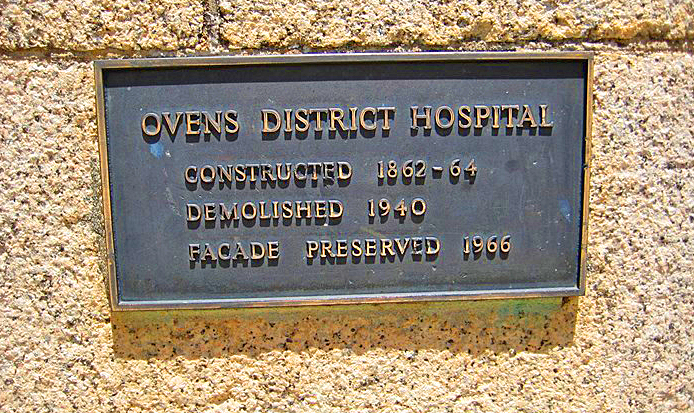
Beechworth holds one of its first big processions and pageants for the official laying of the foundation stone for the new Ovens Goldfields Hospital on Church Street. Led by a German brass band and the two men instrumental in promoting the idea of a hospital in Beechworth – James Ingram and George Briscoe Kerferd – they will be followed by an estimated crowd of 4,000 people! Mr Price, the Beechworth Gold Warden, wields a specially created trowel – with a blade of solid gold and a handle crafted from Woolshed tin – to cement the foundation stone. This will be followed by a sumptuous banquet in the newly designated ‘Hospital Reserve’.
| The Ovens Goldfields Hospital will be built, in stages, between 1856 and 1864 with the hospital’s ‘crowning glory’ – the magnificent (and still standing) stone façade – completed in 1862. Further additions are made in the 1890s including the creation of the ‘Isolation Ward’ which will become known as ‘Little Canada” after the Canadian miner who loved the similarity of Beechworth’s pine covered slopes to those in his native country so much that he built a log cabin on the spot where the ‘Isolation Ward’ later stands. The Ovens Goldfields Hospital will receive patients from all over the district. |
1856 – Sep 26
The first ‘Beechworth Council’. Following the declaration of Beechworth as a ‘Municipal District’ under the presidency of William Corbett Jones Parry, a local barrister, elections are held for the first Beechworth Municipal Council with Richard Mellish the first person elected, followed by Alexander Pritchard, Frederick Brown, Robert Winter, John C. Gray, Charles Williams and Henry Robertson, while John Alston Wallace is disappointed to be unsuccessful in getting a seat on the council. The first meeting of the new eight member council will take place two weeks later on October 10th where Richard Mellish is unanimously elected Chairman of the Municipal District with Alexander Pritchard elected Honorary Secretary.
| The main township of Beechworth comprises 10 main streets, laid out at a uniform width of 99 feet, and 15 roads with a uniform width of 66 feet, with the exception of two, each of 3 chains in width. |
1856 – Sep 26
Eli Abbott, popular local grocer and a founding member of the Wesleyan Methodist Church in Beechworth, is the eighth member elected to the first Beechworth Municipal Council and will serve two terms.
| Eli Abbott and his wife Emma arrive in Beechworth from England in 1853 where Eli quickly finds employment as an assistant in Edmund Vickery’s grocery store in the Spring Creek diggings. Eli does well and soon buys out Vickery, taking over the business. His brother-in-law, pharmacist William Witt and his wife Sarah arrive in Beechworth four years later and join Eli and Emma, William’s sister, in establishing a combined grocery store and pharmacy on Ford Street in 1857. Sadly, Eli will die on May 16th 1861 after a short illness. |
1856 – Sep 26-30
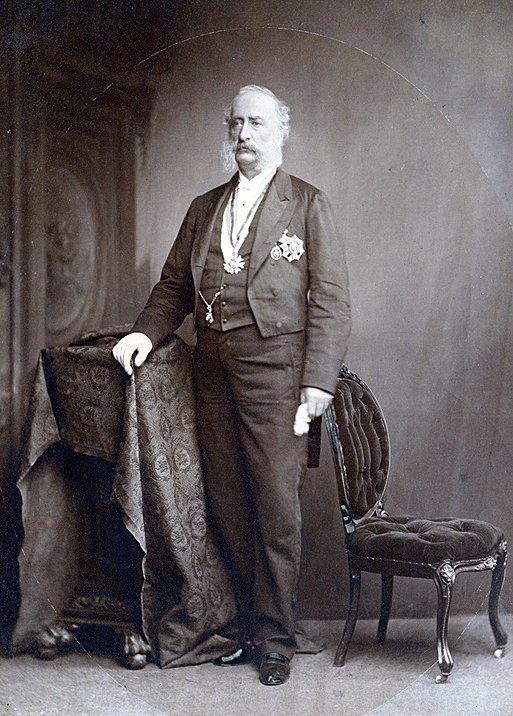
The Governor of South Australia, Sir Richard Graves Macdonnell and his wife Lady Blanche Macdonnell, visit Beechworth. The official party travels from South Australia by river, travelling up the Murray on board the City of Melbourne – the first river steamer to ever make the trip all the way to Albury, with Captain Cadell (pioneer of the Murray River navigation) piloting the vessel past the many shoals and snags. The Governor’s party then travel to Beechworth on horseback where they stay at the El Dorado Hotel. At noon the following day they are met by a welcoming committee, in front of an audience of 200 people, at the Star Assembly Room. They will go to visit the Woolshed and other nearby goldfields, then honour photographers Julius Abbott von Rochlitz and R.H. Acley by posing for daguerreotyypes (photographs) at their Acley and Rochlitz: Daguerrean Artists Studio at the Star Hotel in Beechworth.

| Beechworth composer and photographer Julius Albert von Rochlitz composes a popular piece of music in honour of the Governor’s visit – the ‘Lady MacDonnell Schottisch’ – which is performed by Rochlitz on piano “to much delight” upon their arrival. The composition is later included in a collection of Rochlitz’s musical works which also features ‘The Geelong-Melbourne Railway Polka’ (either composed in celebration of the inaguration of the Geelong Railway project in 1853, or its official opening in 1857) (below). |
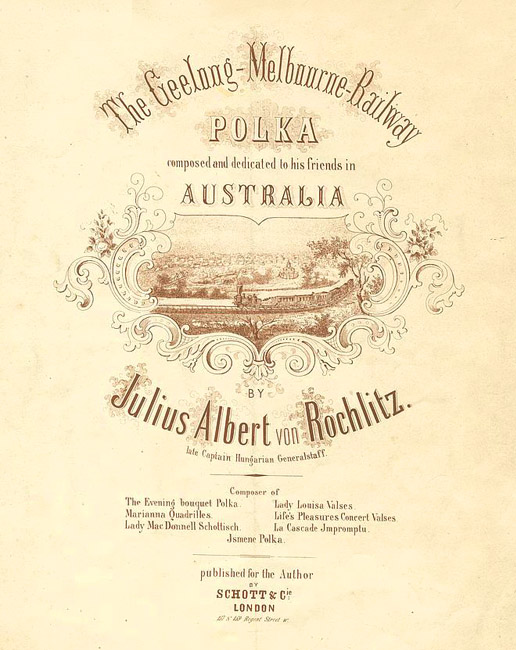
1856 – Sep 29

A most lavish evening banquet is presented in Beechworth at the Assembly Room (at the Star Hotel on Ford Street) for the visiting Governor of South Australia, Sir Richard Graves Macdonnell. The dinner has been financed by John Alston Wallace, with Beechworth’s finest chefs and culinary experts spending the weekend preparing the sumptuous menu – entrees of Murray cod, oysters and lobsters; main dishes of turkey, pork, tongue, chicken pie, jellied fowl, cutlets of port, mutton and veal, and roast mutton; followed by souffles, puddings, fruit pies, jellies, blancmanges, cakes and pastries. The entire menu is written in French. Preparations are supervised by James Ellis, renowned in London for managing Laurent’s Casino (meaning a place of entertainment, rather than a gambling den), famous for its Louis XIV-themed ballroom with a 50-piece dance orchestra led by Émile Laurent, and London’s Adelaide Gallery – the ‘National Gallery of Practical Science, Blending Instruction with Amusement‘ – on Adelaide Street, between Covent Garden and The Strand.
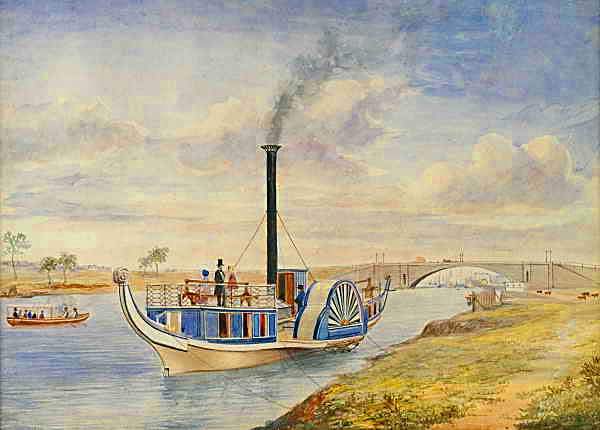
| Originally a confectioner, English-born James Ellis also started the ‘Cremorne Gardens’ on the banks of the Thames River in London in 1845 before migrating to Australia in 1852 where he recreates the ‘Cremorne Gardens’ beside the Yarra River in Melbourne (above). Opened in December 1853, the ‘Cremorne Gardens’ at Richmond are Melbourne’s first ‘Pleasure Gardens’ and ‘Amusement Park’. By 1867 Ellis has become the manager of Melbourne’s ‘Princess’ Theatre’ on Spring Street. |
1856 – Sep 30

Departing Beechworth, the Governor of South Australia Sir Richard Graves Macdonnell makes the point of saying how impressed he is with the 1854-built Wesleyan Methodist Chapel – “The largest and most conspicuous place of public worship at Beechworth”.
1856
A local by-law is introduced, prohibiting the erection of any further canvas-built shops or homes in the main streets of Beechworth. (Until the mid-1850s most buildings in the town are of wood, bark or canvas.)
1856

The Beechworth Athenæum Lecture Hall and Reading Room is opened. It is used exclusively for the meetings of Beechworth’s newly formed Young Men’s Mutual Improvement Development Group. By 1858 the group will have 150 members and subscribers and appoint a permanent curator to look after their rapidly growing collections. They hold discussions at the Athenæum Hall on subjects as varied as local geography and geology, local flora and fauna, and current political events. Admission is restricted to subscribers of the Young Men’s Mutual Improvement Development Group. However, by 1860 the subscribers are obliged to ask the Beechworth Municipal Council for financial assistance in maintaining the building. This is granted – on the condition that the building should be open to the public – and the building becomes the Beechworth Athenæum and Public Library (above).
| In 1863, following the tragic death of Robert O’Hara Burke at Cooper Creek in June 1861 in his attempt to cross Australia, the Beechworth Council will purchase the ‘Athenæum and Public Library’ outright and add a ‘Museum of Science’ to the building, renaming it the ‘Beechworth Public Library and Burke Memorial Museum’ as a tribute to Beechworth’s former Police Superintendent. The popular ‘Burke Museum’ still operates today, and is one of Victoria’s oldest. |
1856 – Oct 10
The first meeting of the newly elected Beechworth Municpal Council is held, led by Richard Mellish. One of the Council’s first tasks is achieving a secure water supply for the town, which it has been lacking. The initial (proposed) water scheme consists of bringing water from the Little or Ovens Rivers with a canal to be cut from the Ovens River, via Stanley (9km from Beechworth) and through to Beechworth. Although The Ovens Diggings Water Company is formed specifically to undertake this work, the scheme does not eventuate.
| The water scheme will take 19 years to come to fruition, with the eventual official supply of water in 1874 filled with setbacks and disputes, all at a substantial cost to the fledgling Council. |
1856 – Oct 10
The new Beechworth Municipal Council looks through the 31 applications it has received for the new position of a Beechworth Town Clerk. The man selected by the Council (by six votes to one) is 26-year-old solicitor William Henry Charles Darvall, a stranger who has only just arrived in the township! He proves both successful and popular in the role and stays in the post for many years.
1856

With the formation of the Beechworth Municipal Council, a grant of a large section of land on Ford Street – opposite the Police Reserve – is made for the new council’s use, with plans to (eventually) build Council Chambers. Today, this is the site of the Beechworth Visitor Centre.
1856 – Oct 14

The population of nearby Albury continues to grow and now stands at 645 people. Seeing the future for potential growth, George Henry Mott (former editor of Beechworth’s ‘Ovens and Murray Advertiser‘ and owner of Beechworth’s ‘Constitution and Ovens Mining Intelligencer’) and his printer friend George Robinson publish the inaugural issue of Albury’s first newspaper, the Border Post. George Mott will later own the Ovens Tribune and the Chiltern Standard newspapers.
| George Henry Mott will become an important citizen of Albury. He agitates for the separation of the Riverina from NSW; establishes an ‘Anti-Customs League’ and, in 1868, becomes the Mayor of Albury. He also helps form the ‘North-Eastern Railway League’, which works for the completion of the Melbourne to Wodonga line. He will pass away on January 7, 1906 and his wife Allegra dies nine months later on October 16, 1906. |
1856

On the advice of fellow American Freeman ‘King’ Cobb, 24-year-old Hiram Allen Crawford uses his winnings – ‘a thousand ounces gold’ -from the Woolshed goldfields to establish the coach firm ‘H.A. Crawford and Co’ in Beechworth. Starting with a single cart and two horses, he begins with runs between Beechworth and Yackandandah before his first official ‘big run’, in September 1857, from Beechworth to Albury. He grooms, feeds and breaks in the horses himself. The small business grows rapidly and the ‘H.A. Crawford and Co’ coach routes expand to include regular mail contracts.

| Hiram Crawford’s stables at the rear of 44 Ford Street burn down in 1891 but are subsequently rebuilt. Crawford goes on to purchase the ‘Star Hotel’ in nearby Chiltern, eventually becoming the Mayor of Chiltern in 1863 then the Mayor of Beechworth, and is instrumental in bringing gas light to Beechworth, the formation of the Victorian Fire Brigade Act and the Fire Brigade Board. He will later turn to farming on a property by the Ovens River near Everton which he names ‘Brookfield’ after his birthplace in America. ‘Brookfield’ will have its own railway stop on the Wangaratta to Bright Railway Line. Hiram Crawford dies in 1916 at the age of 84. |
1856 – Nov 18
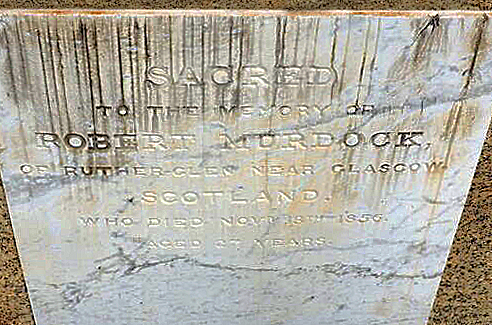
Murder in Beechworth! Charles Jansen (or Johanson or Johnson), a Swedish miner working the diggings at Woolshed, visits John Wallace’s Star Hotel and, after becoming drunk and aggressive and refusing to pay, is asked to leave by a waiter. A fight breaks out and Jansen is punched to the ground by the waiter. Jansen then produces a knife. The hotel’s landlord, 27-year-old Scotsman Robert Murdock attempts to calm the situation when Jansen stabs Murdock who screams “I am stabbed! I am stabbed!” Jansen is arrested in the hotel and Murdock dies from his injuries two days later. A post-mortem is carried out on the stage of the Star Hotel’s Assembly Hall (aka the Star Theatre). Murdock’s funeral is one of the largest seen in Beechworth. As the coffin is carried out of the Star Hotel to a carriage, all businesses in the town close and all the shop windows have their curtains drawn whilst their owners stand in mourning as the carriage goes past. Over 3,000 men, women and children are waiting for the carriage at the cemetery for Murdock’s burial and he will become the first person interred at the new cemetery. He leaves a widow, Isabella.
| In Jansen’s murder trial, Judge Whipham agrees that “under circumstances of provocation, the offence be reduced to manslaughter” as “Mr Jansen was proved to have been under the influence of liquor, and while in that state he had been struck and beaten very harshly by a man, his superior in size and strength”. The jury returns a verdict of manslaughter and Jansen is sentenced to seven years hard labour on the roads. After the trial, it is revealed that Jensen had murdered a person in Egypt on his way to Australia. |
1856 – Nov 21
Future member of the Kelly Gang, Joseph ‘Joe’ Byrne is born in the Woolshed Valley to Patrick and Margaret Byrne.
1856 – Nov
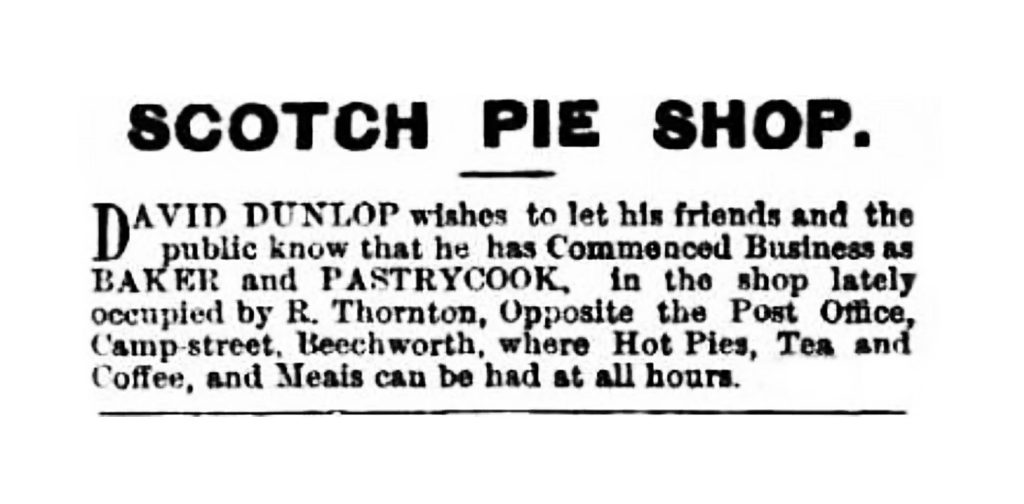
38-year-old Scotsman David Dunlop arrives in Beechworth with his wife Mary (sister of baker James MacMaster). Dunlop, who has been running a confectionery business in Collins Street in Melbourne, soon establishes a successful bakery and pastry shop – the Scotch Pie Shop – on Camp Street. Originally a single-story shop, a second storey and balcony are added in 1900.
| The building will continue to be associated with food, dining, baking and pastry cooks, later becoming the ‘Ideal Café & Milk Bar’. In 1984 it is renovated by Tom O’Toole who will relaunch it as the ‘Beechworth Bakery’. |
1856

24-year-old Irishman Sidney Henry Rundle establishes the London House store on Ford Street. It will serve the citizens of Beechworth for many years, selling everything from manchester, drapery, and a vast range of men’s and women’s clothing. A few years later Sid’s younger brother Charles Alfred Rundle, a trained chemist, will arrive from Ireland and also find work in Beechworth, as a 21-year-old assistant to pharmacist William Witt. Impressed by the younger Rundle’s pharmacy work, Witt puts him in charge of Witt’s new branch in Chiltern, a business which Rundle eventually buys. In February 1865, Charles Rundle purchases Ford’s Pharmacy in Wangaratta and successfully runs the Wangaratta business – with his wife and one of his daughters (who are also qualified chemists) – until his death 30 years later in 1896.
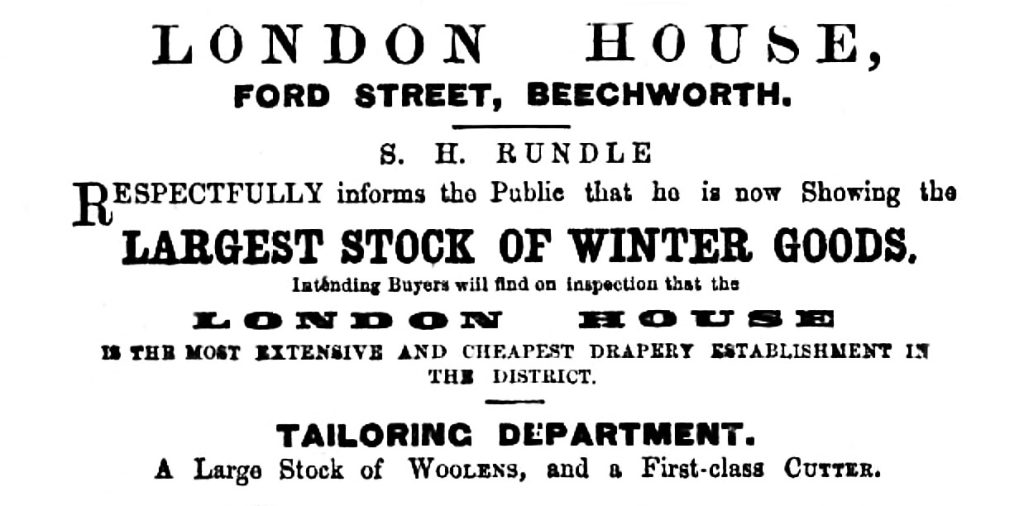
| Sidney Henry Rundle will build a home on 5 acres of land on Sydney Road. His ‘Mayday House’ will become known for its beautiful gardens. He will pass away in 1902 aged 70. |
1856
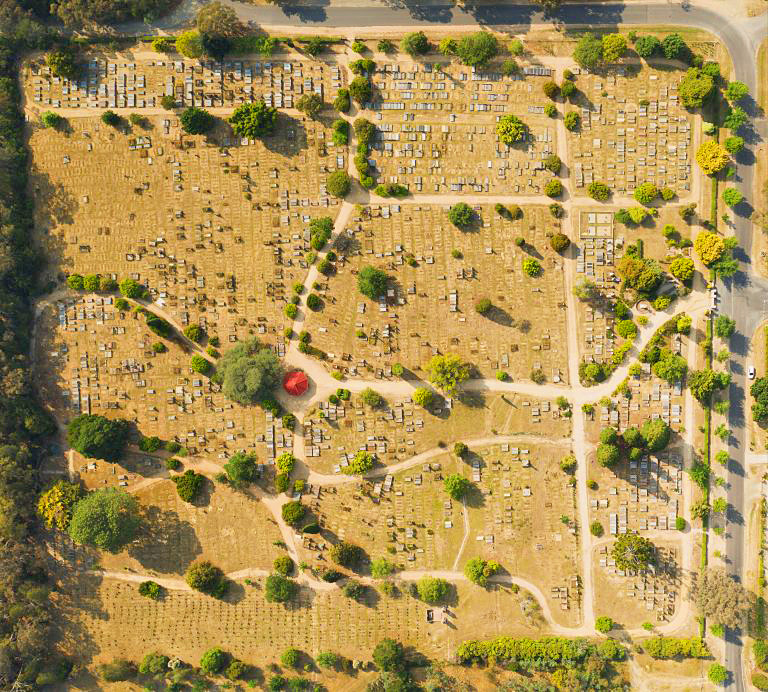
Beechworth’s third Cemetery (the current cemetery) is opened on Balaclava Road. Representatives of each of the six local churches make up the Cemetery Trust and each church is allotted a section of ground within the new Cemetery, each section reflecting the size of the congregation of each church, with the sections given the name of the church it represents. Thus the Cemetery is laid out in denominational order with denominational names. There is also a section for Beechworth’s large Chinese community which, during the gold rush, and for a long time afterwards, numbers over 5,000.

| The Trustees of the Cemetery create one more section – the ‘Strangers’ area (above), where those who do not belong to the main-stream churches, or who are non-Christian – such as Hindus and Buddhists – can be buried. Those whose religions are non-denominational, or unknown, are also buried as ‘Strangers’. In this section today there are also a vast number of unmarked graves, little humps and hollows, side by side, in long rows. |
1856-58
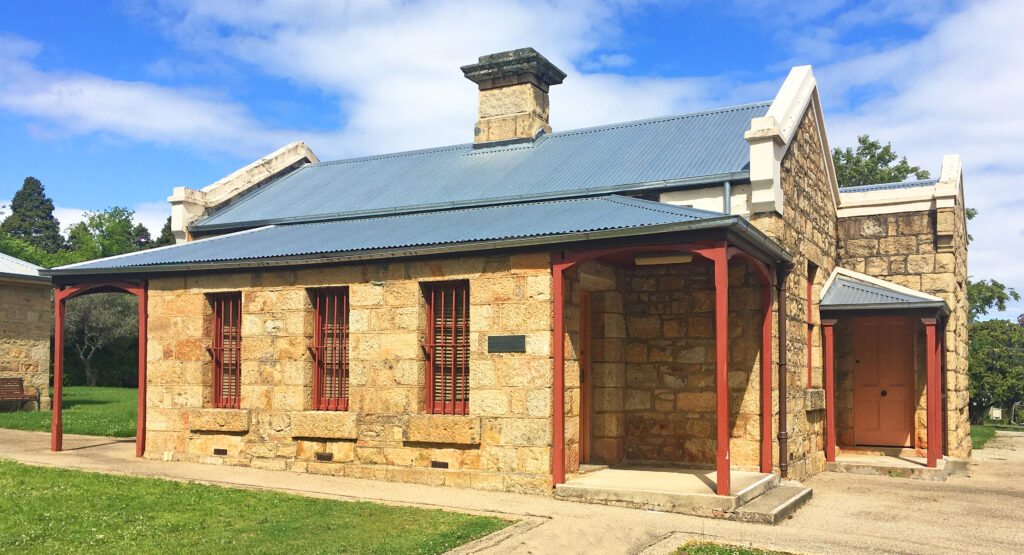
Building is now classified by the National Trust.
Construction commences on the Gold Office and Sub-Treasury building in front of the Police Reserve on Ford Street. Built over 18 months by contractors Martell & Rogers at a cost of £892, it features distinctive local granite, a slate roof and comprises two offices in the principal gable roof section with a projecting stone vestibule at the front of the building which is entered from either of the flanking verandahs. In 1861 a substantial addition is made to the rear of the building which includes a large strong room and two more offices at a further cost of £525. All gold from the diggings are deposited at the Gold Office before being transported to Melbourne. In the 1880s the Gold Office and Sub-Treasury is converted into the Beechworth Police Station which remains in operation until the new Beechworth Police Station is built around the corner in 1997.

| At the peak of the goldrush the ‘Sub-Treasury’ is used to store up to 14,000 ounces of gold each fortnight which, at the end of each fortnight, would be escorted to the Treasury in Melbourne. |
1857 – Jan 1

Reverend John C. Symons lays the foundation stone for a new Wesleyan Methodist Chapel – to replace the wooden chapel (above) – and construction starts immediately. The architects are Powell & Clarke. The stone building will be completed by Easter Sunday, April 12th the same year.
1857 – Jan
Following the murder of his friend Robert Murdock at his Star Hotel on Ford Street in November 1856, John Alston Wallace decides to sell the Star to Henry Robertson and Robert Quirk for £9,000 (Robert Quirk had previously owned the Freemason’s Arms Hotel on Reid’s Creek). But Robertson and Quirk quickly default on their payments and Wallace (and his brother Peter Wallace) take back control of the Star Hotel, which they will retain until 1863.
1857 – Jan 15
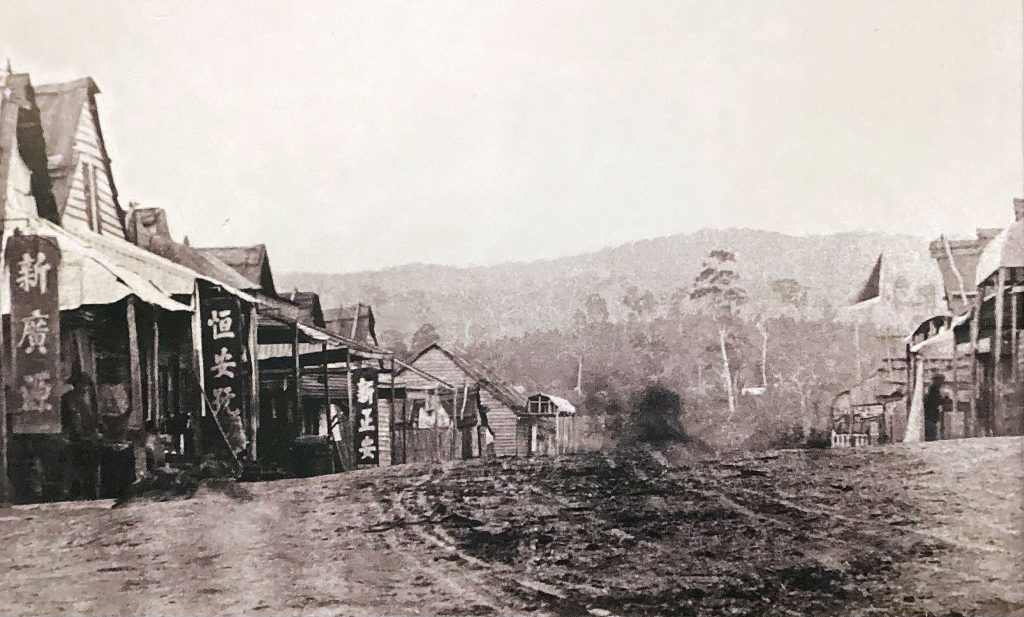
With much ceremony, the flourishing Beechworth Chinese community open their Beechworth Joss House in the area affectionately known as ‘Little Canton’. Initially an elaborate wood and canvas structure, it will be the first of many Joss Houses constructed in Beechworth. The Chinese leaders invite a number of European guests to the opening to watch a display of fireworks and partake in a range of Chinese dishes especially prepared for the occasion. The guests are also encouraged to smoke pipes of Turkish tobacco (opium) and try their luck at a gambling table.
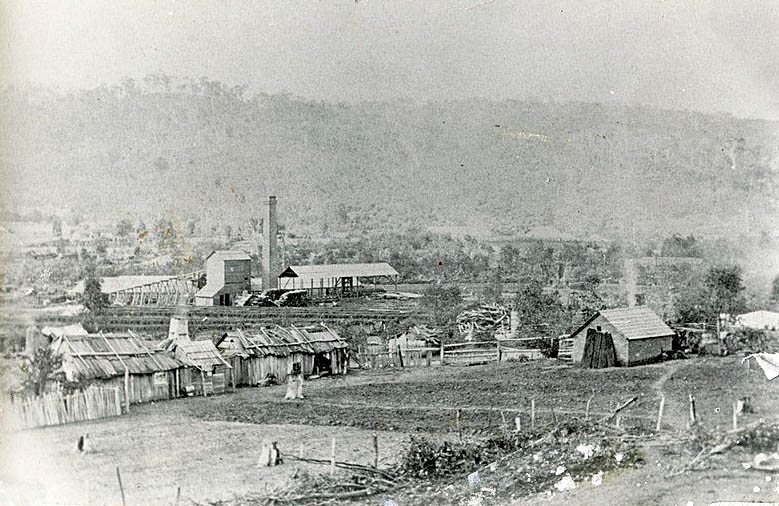
1857
A temporary wooden Catholic Church is erected at 9 Church Street.
1857
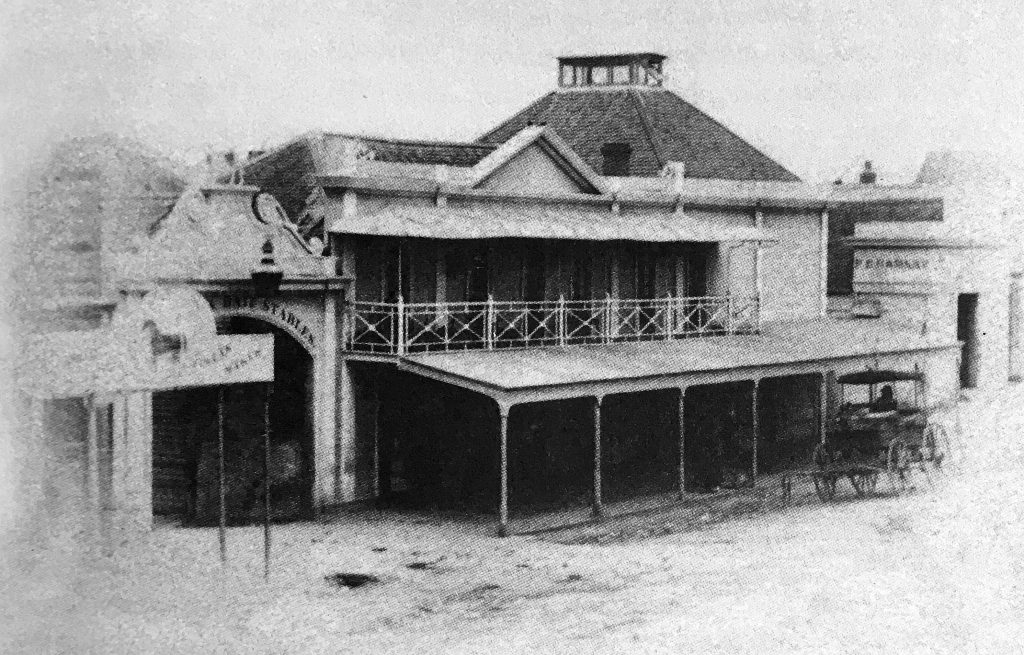
John Duncan Fisher extends and improves his two-story Commercial Hotel on Ford Street. Remodeling inside and out, he adds a larger bar, additional accommodation rooms, a large dining and concert room, a billiard room, and an ‘Oddfellows Lodge’, along with larger stables next door.
1857

At least 14,000 ounces of gold is leaving Beechworth for Melbourne each fortnight on the gold escorts.
| Between 1852 and 1866 the Ovens goldfields yield 3,121,918 ounces of gold! |
1857 – Feb 7

With much fanfare and ceremony, the first stage of the Ovens Goldfields Hospital is officially opened to patients on Church Street. It is completed at a cost of £2,347 pounds – with the aid of public subscriptions and Government grants – and for the next 50 years it will be North-East Victoria’s leading hospital. The initial building, designed by James Harold Dobbyn in the classical ‘Palladian’ classical style, comprises two wards accommodating 20 patients, along with apartments for the resident surgeon and matron and an area that serves as a dispensary, operating theatre and board room. The hospital cares mainly for those who cannot afford to consult doctors. Within a year, the rapidly increasing number of patients will lead to the construction of another wing in 1858 costing £1,000. This two-storey wing – with five medium-sized wards – doubles the size of the hospital and is built entirely by subscription. In 1861 a further wing, costing £1,158, is added to accommodate a further 20 patients. A ‘Chinese Ward’ will be added in 1883 and an ‘Isolation Ward’, designed by Donald Fiddes, is completed in 1890. In 1874 the ‘Hospital Gardens’ are laid out by R.H. Jenkyns and planted with over 200 species of trees, including fruit trees, and shrubs, as well as colourful flower beds and orchards and kitchen gardens for food production. The hospital receives many generous donations and gifts, especially from the local Chinese community.
| The hospital will close in 1940 and, except for the façade, is demolished in 1941. The hospital grounds become known as ‘Centennial Park’ and the Beechworth Scout Hall will be built in ‘Centennial Park’ in 1962. Restoration work on the hospital façade is undertaken in 1964 by the Beechworth Lions Club. |
1857

The St Joseph’s Catholic School begins as a wooden structure beside the temporary St. Joseph’s Catholic Church at 9 Church Street. By 1886 the school is staffed by lay teachers until negotiations with the Superioress of the Brigidine Convent at Abbeylei in Ireland secures four Brigidine Sisters to come to Beechworth. The ‘Brigidine Sisters’ arrive in December 1886 and take permanent charge of St Joseph’s Primary School in January 1887.
1857
The population of the Beechworth township and the various goldfields in the surrounding Ovens District has reached 16,000. (By comparison, the current population of Beechworth is around 3,000.)
1857
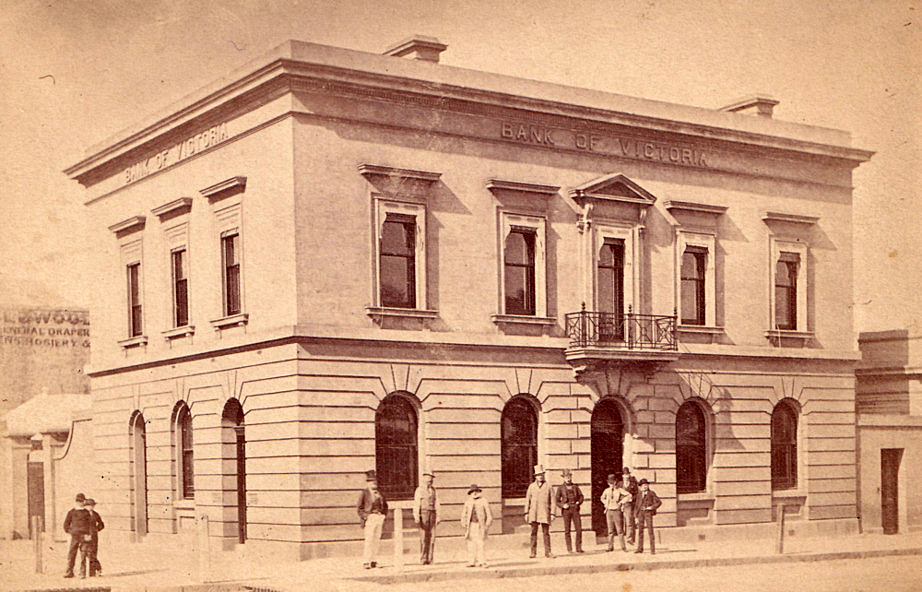
The architectural firm of Robertson & Hale, who designed Beechworth’s impressive Bank of New South Wales a year earlier, now design a new branch for the Bank of Victoria on the opposite corner of Camp and Ford Streets. It will be destroyed in the ‘Great Beechworth Fire’ and replaced in 1867 by a larger stone building erected by Smith & Watts (photo above). The Bank of Victoria Limited had been founded in Melbourne in 1852 by Dr Thomas Black, a physician from Richmond.
| In 1927 ‘The Bank of Victoria’ amalgamates with the ‘Commercial Banking Company of Sydney Limited’ (CBC) and subsequently with the ‘National Bank of Australia’ (NAB) in 1981 to become part of the NAB group. The Beechworth branch building will later become the home of the ‘Rock Cavern’ and the ‘Beechworth Gold Gemstone and Gold Gallery’. |
1857
The Congregational Church purchases land in Loch Street with plans to build a church. Until it is built, the land is used for open-air meetings and services. The site is originally a cemetery; those interred are removed to Beechworth Cemetery. The Congregational Church’s Sunday School will open on January 19 1858, and used as a church until 1869, located behind the present church.
1857
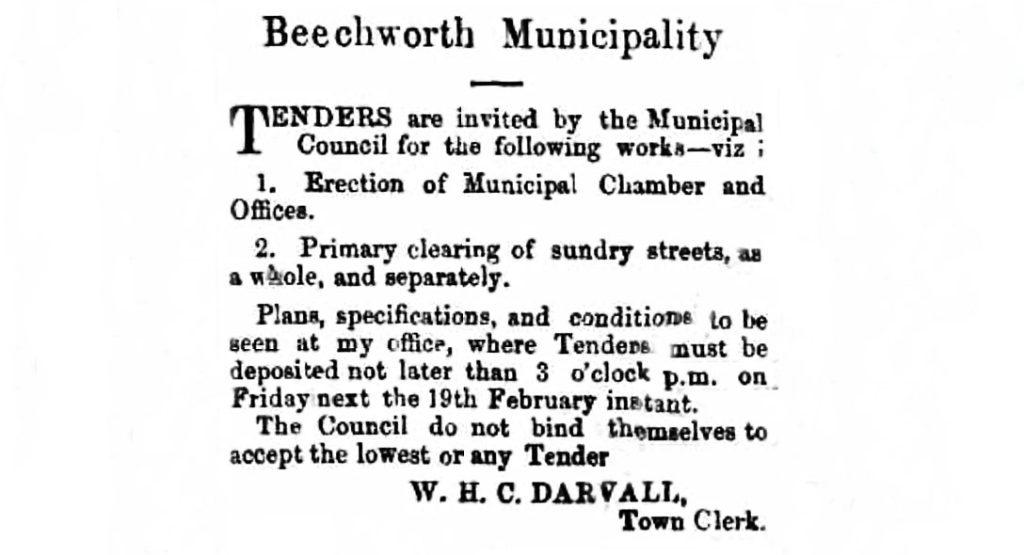
A year after the election of the first ‘Beechworth Municipal Council’, plans are submitted for the construction of Beechworth’s first Council Chambers. A tender of £1,580 will finally be accepted in May 1858 and work begins on the solid single-storey building at 103 Ford Street, with plans to include an impressive Clock Tower.
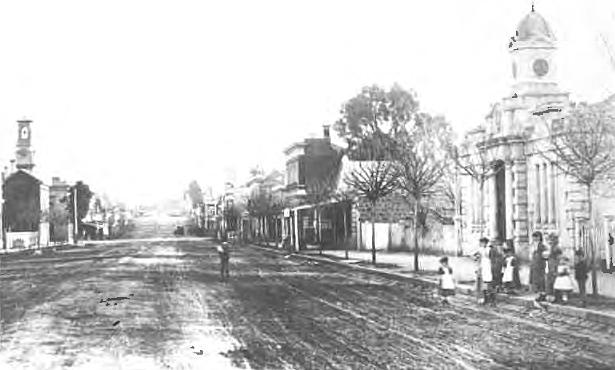
1857
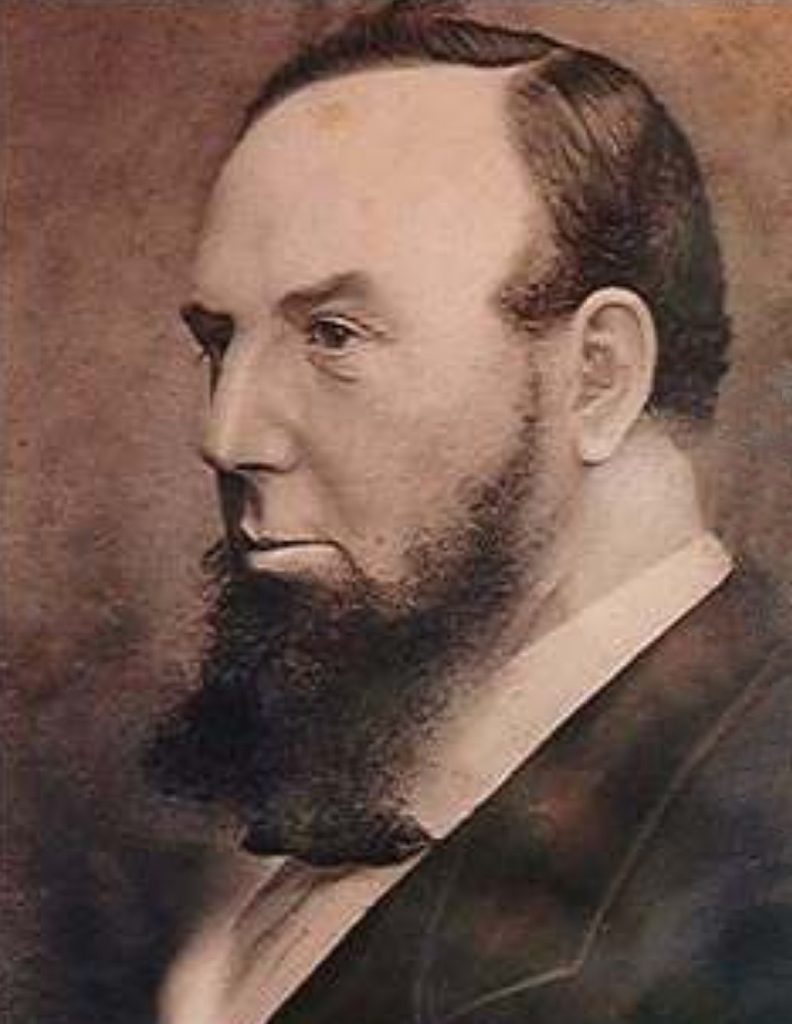
Pharmacist William Witt and his wife Sarah arrive in Beechworth and join Eli Abbott and his wife Emma – William Witt’s sister – in establishing a combined grocery store and pharmacy on Ford Street.
| William Witt’s Beechworth pharmacy is very successful, and Witt will go on to open further Victorian branches in Chiltern, Tallangatta and Rutherglen, along with Wagga Wagga and Parkes in NSW. He also establishes a sales and auction business in Beechworth; will act as the Beechworth agent for the ‘Colonial Insurance Company’ (see below); and sit on the board of three local mining companies. Within two years of his arrival in town, Witt will be elected to the Beechworth Council and will later serve a 12-month term as the Beechworth Mayor. |
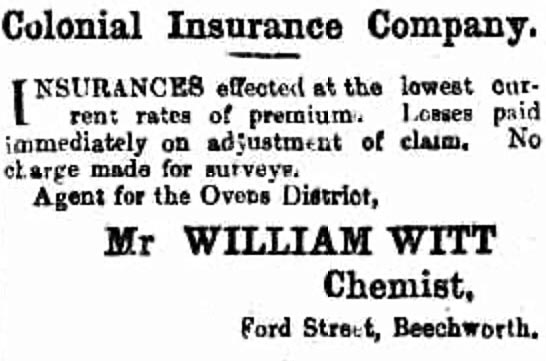
1857
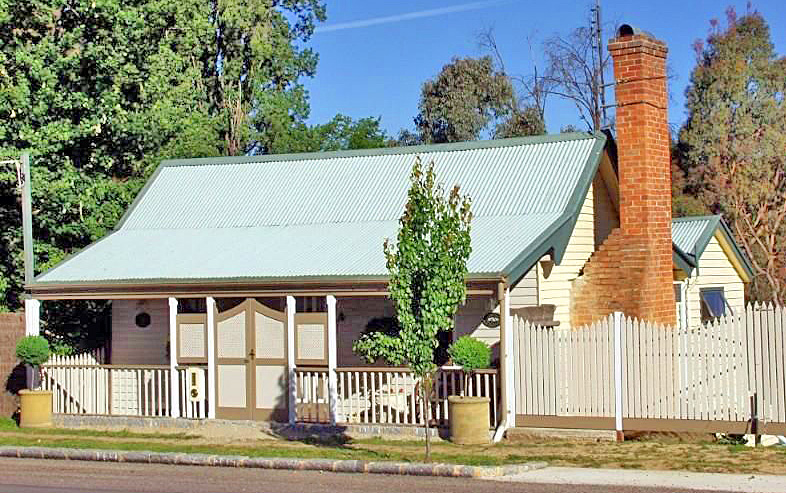
Construction is completed on Farland Cottage at 50 High Street. The delightful cottage, with rear access to the creek, still stands today.
1857
The Star Theatre at the Star Hotel on Ford Street hosts a performance by Madame Della Casse & Company, where “Madame will perform her grand leap over 12 soldiers and their 12 bayonets”! Anna Della Casse tours the country performing a range of feats and stunts, including walking the tightrope and is promoted as a “fair and daring artiste”.
1857
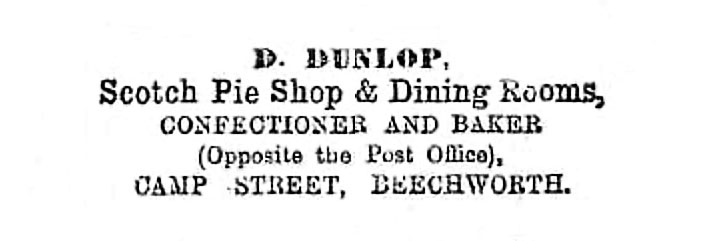
22-year-old James McMaster – whose sister is married to David Dunlop who operates the successful Scotch Pie Shop on Camp Street – arrives in Beechworth and joins his sister and Dunlop in their successful baking, pastry and confectionary business.
| A popular local citizen, David Dunlop will be elected to the Beechworth Shire Council in August 1876. Sadly, he will die after suffering a very bad cold in June 1887, aged 67. James McMaster will take over Dunlop’s popular ‘Scotch Pie Shop’ on Camp Street. |
1857
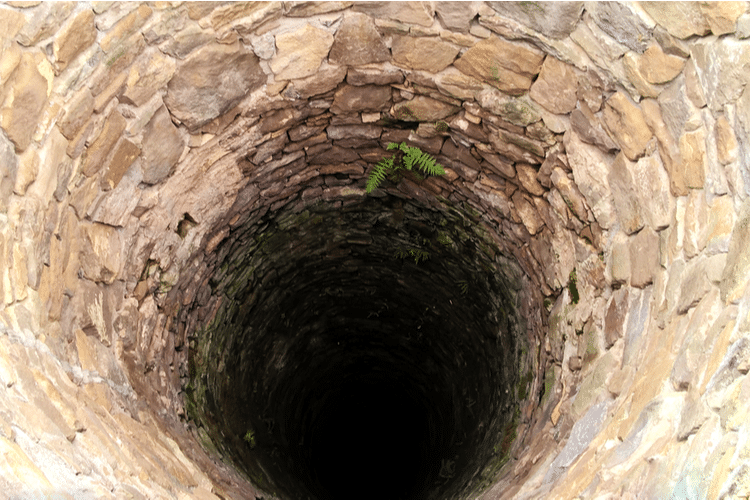
Beechworth Municipal Council sinks a well at the bottom of Short Street and then builds a horse-driven pump above it. In November 1858 the Council will appoint a special ‘Water Committee’ to plan a better water supply for the township.

| The Water Committee initiates what is later known as ‘Brown’s Folly’ (named after Councillor Frederick Brown). An immense iron tank is installed upon massive granite pillars at the intersection of Ford and Church Streets – the highest point in town – into which water is pumped from the town well (see above). The tank is 20ft x 25ft x 6ft and holds 22,500 gallons of water. The tank and well are connected by pipes, with pipes also connecting the tank to the centre of town. However, the size and positioning of the tank impacts on the room available for vehicles to pass and this, together with the cost (some thousands of pounds) and much negative public opinion about the aesthetics of the tank, result in the tank being removed within two years. |
1857 – Apr 7

The first sitting of the Supreme Court (Circuit Court) is held in Beechworth, with the first case – heard under the court of ‘Criminal Assizes’ – is that of the unfortunate Rosanna Nicholls. She is convicted and sentenced to death for the murder of her three-month-old son who had died of neglect and starvation. The evidence at both the Inquest and the trial focuses on Rosanna’s “dissolute way of life” and she is branded an “unnatural woman”. However, her case attracts public sympathy and, following the intervention of the trial judge, J. Williams – to the effect that her crime is really one of manslaughter – Rosanna’s sentence is commuted to seven years imprisonment.
1857 – Apr 12
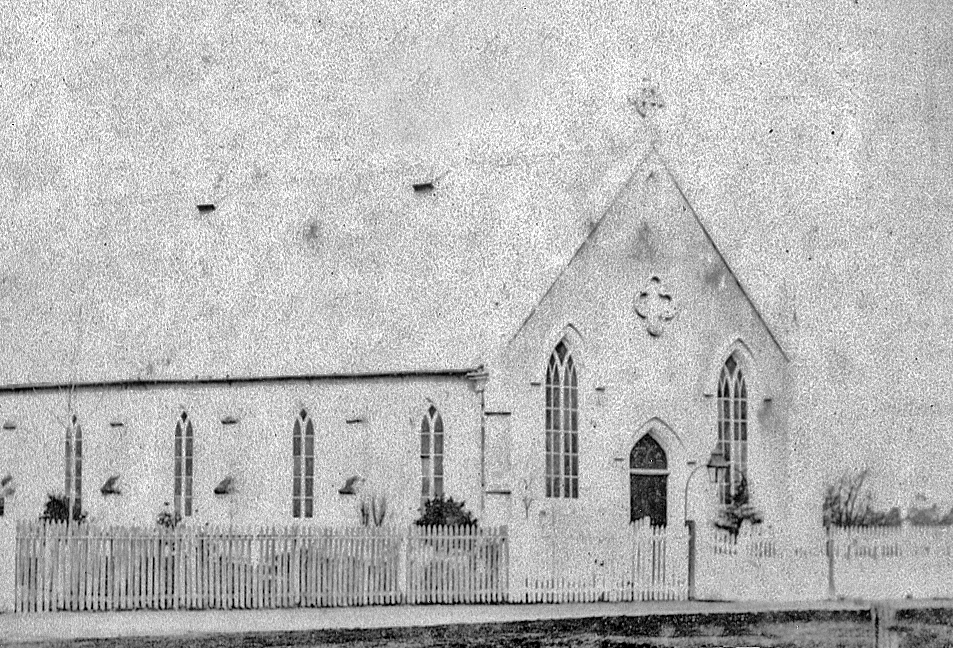
It’s Easter, and the new Wesleyan Methodist Chapel is completed, becoming the first permanent stone church building on the Ovens goldfields with the ‘official’ opening taking place on Easter Sunday, conducted by Wesleyan pastor Mr C. Williams from Tasmania. Located at the top of Ford Street (24 Ford Street) the ‘gothic-style’ building will replace the wooden structure next door for all church services, with the original wooden chapel building converted into one large schoolroom, known as the Wesleyan School. Extensions to the new chapel will be made the following year.
| Still standing today, the stone church features a stuccoed facade distinguished by angled corner buttresses with stylised pinnacles, a quatrefoil and blind lancet in the gable and drip moulds over the windows and door. |
1857 – May
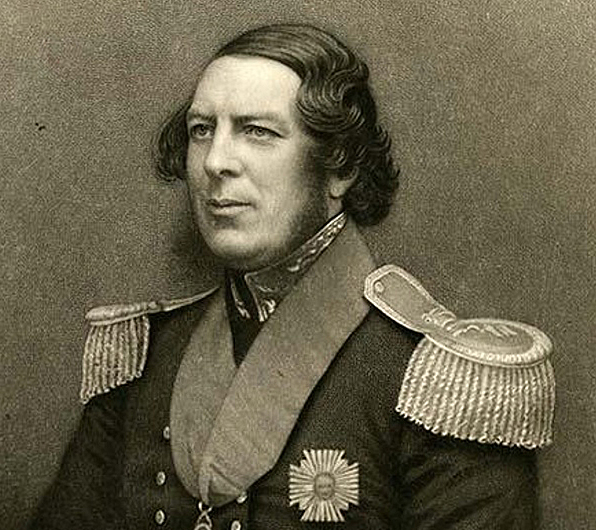
His Excellency Sir Henry Barkly, the Governor of the Victoria, and Captain McMahon, the Commissioner of Police, head to Beechworth for a private visit. John Buckley Castieau (Governor of the Beechworth Gaol), Robert O’Hara Burke (Superintendent of Police), various Beechworth Government officials, an escort of mounted troopers, and a cortege of leading citizens of the town, meet his Excellency and the Captain at Black Springs, then escort them the 3 miles into Beechworth. They are keen to inspect “the system of working peculiar to the Ovens Goldfields”. During their three-day visit they stay at John Alston Wallace’s Star Hotel on Ford Street. Owing to heavy rain, they are unable to visit the Woolshed as planned, but during the intervals of fine weather, they visit the Ovens Goldfields Hospital, the Bank of New South Wales and the Beechworth Stockade. His Excellency also inspects some of the Camp buildings and, having been shown the locality of the present Camp Garden – on which the Municipal Council propose to erect more public buildings – the Governor intimates his opinion that it is a better site than the vicinity of the “huge rock beyond the camp”. His Excellency also traverses several Beechworth streets, noting the Public Baths, at the intersection of Ford and Camp Streets, generously provides for all classes of human beings and animals.

| The British Sir Henry Barkly serves as Governor of Victoria from 1856 to 1863 and is noted for his support of philanthropic and intellectual movements. He is a founder and president of the Royal Society of Victoria from 1860–63, and helps to found the National Gallery of Victoria, the Acclimatization Society, and the National Observatory. |
1857 – Jul 1
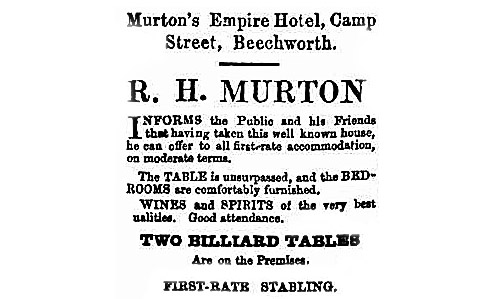
The Empire Hotel opens its doors for the first time in Camp Street. The building is in fact the Smithville Hotel which has been transported, in pieces, by owner John Sitch Clark from its original location at Upper Woolshed where it had once been described as “the glory of the Upper Woolshed”. The single-storey wooden building, which includes eight bedrooms and three sitting rooms, is re-erected at 24 Camp Street in Beechworth (where the Beechworth Emporium stands today) and a brick frontage is promptly added to the wooden structure. The first licensee of the newly named Empire Hotel is 21-year-old American Abram Tanner. However, within a few months, ill health will force young Tanner to pass on the hotel’s licence to 28-year-old Canadian Richard H. Murton in March 1858 (see image above).
1857 – Jul 4

An anti-Chinese race riot – known as the Buckland Riot – takes place on the goldfields of the Buckland Valley near the present-day towns of Porepunkah and Bright. Approximately 2,000 Chinese and 700 European gold miners are living and working in the Buckland area. After deciding they will attempt to expel all the Chinese in the Buckland Valley during a heated public meeting at the Buckland Hotel, around 100 white men – mostly Americans who are “inflamed by liquor” during their July 4th celebrations – head out to attack Chinese settlements. During the riot, Chinese miners are beaten and robbed then driven across the Buckland River. At least three Chinese miners die and entire Chinese encampments, and a recently constructed Joss House, are destroyed.
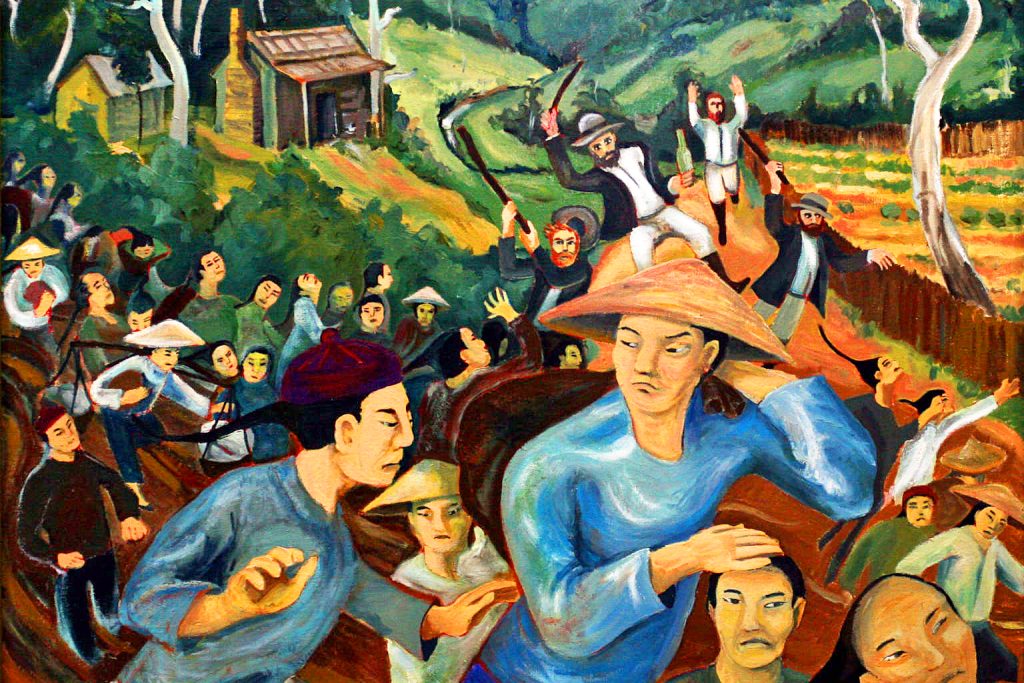
| Police, including Beechworth’s Robert O’Hara Burke, arrest 13 of the accused American rioters, however a jury acquit all 13 “amid the cheers of bystanders”. The Chinese miners are invited to return to the Buckland Valley, however only fifty do so. The ‘Buckland Riot’ is sometimes compared to Ballarat’s Eureka Stockade uprising in size and intensity. |
1857 – Jul 6

The Foundation Stone for Beechworth’s first Presbyterian Church is laid by the 32-year-old Reverend James Nish from Sandhurst (Bendigo) as plans for St. Andrew’s Church are drawn up by architect Thomas Turnbull. It will be built on the corner of Ford and Williams Streets, across the road from the Beechworth Stockade and completed by February 25th 1858 (see further entry below).
| Presbyterian church services have previously been held in the ‘Assembly Room’ at the ‘Star Hotel’. |
1857
There are now almost 800 houses in Beechworth, with new houses replacing the tents that have previously been erected in the central part of the town.
| The first brick houses begin appearing early in 1855 in Camp Street, and soon brick, stone and weatherboard houses are being constructed. With the introduction of building regulations in 1856, housing standards in Beechworth improve markedly. Substantial residential building continues during the 1860s-70s, and many early makeshift houses are converted into more substantial structures. The main residential streets are gradually filled with rows of houses of weatherboard or brick, and occasionally granite, with gables or hipped roofs, often decorated with ornamental bargeboards in the gables or iron lacework on the verandahs. Occasional grander residences are also built. |
1857
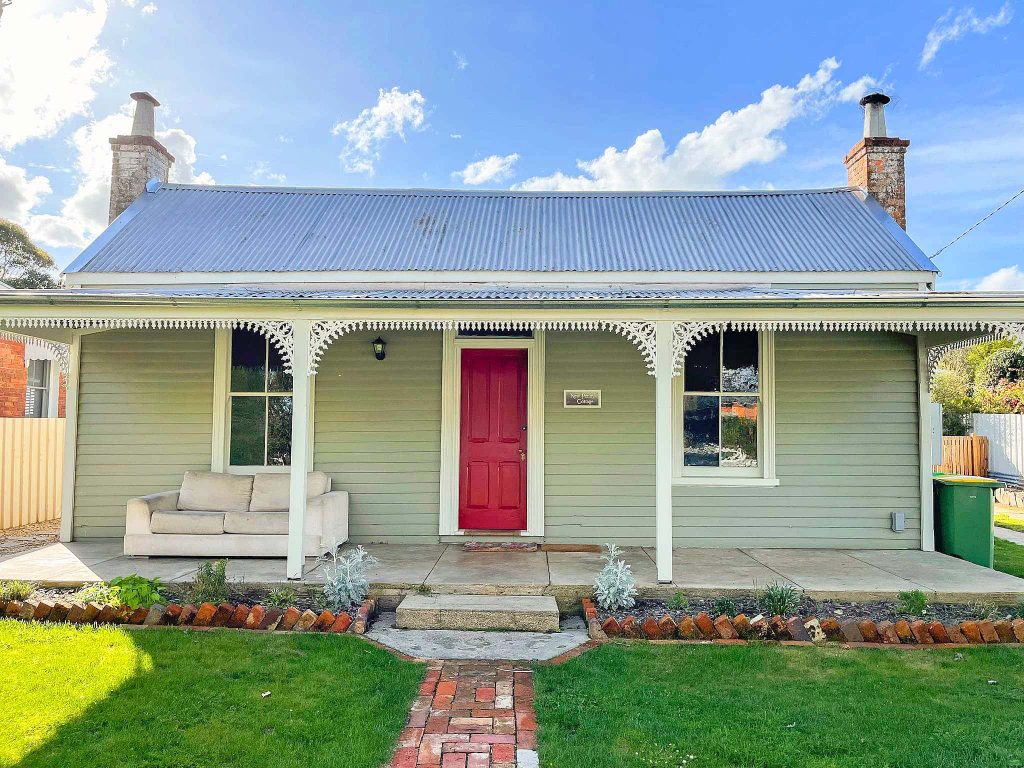
‘New Penny Cottage’ is erected at 18a Bridge Road. It still stands today, operating as ‘Bridge Road Retreat’ holiday accommodation.
1857

In an effort to forge better relations on the Spring Creek goldfields, the Chinese Protectors Office is established. It will look after the local Chinese community and collects Chinese miner’s rights and licenses.
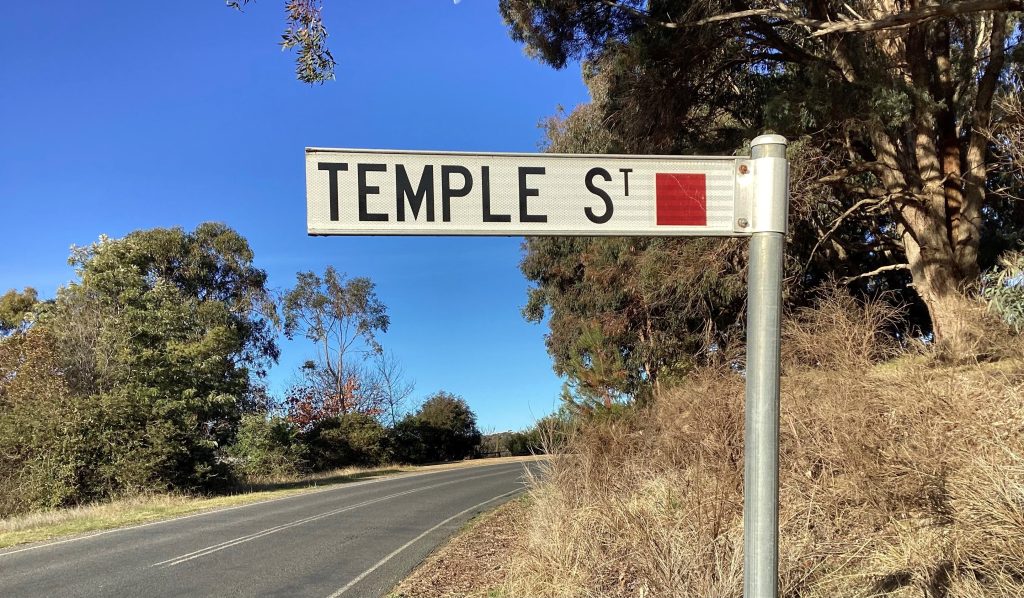
| The Chinese population of Beechworth grows quickly during the gold rush in the wake of the Buckland Valley riot that drives the Chinese to Beechworth from the troubled areas around Porepunkah and Bright. The Beechworth Chinese community become centered in an area now named Temple Street (off the Lower Stanley Road – above) where a temple, four ‘Joss Houses’ and several stores operate. At the time, the area on the high side of where Lake Sambell is now situated, is dubbed ‘Little Canton’ and ‘Chinatown’. |
1857 – Aug

William Henry Drummond is appointed the Chinese Protector on the Ovens Goldfields. A stern and disciplined soldier of the British Empire who had served with Queen Victoria’s 89th Regiment of Foot, he approaches his new role in Beechworth with firm resolve and a strong arm, although he relies heavily on the support of his assistant wardens and protectors John Stephen Morphy and William Henry Gaunt. Drummond is transferred to the Rutherglen District in 1861 and from there he moves to Daylesford in 1864 to become their Police Magistrate. He will die four years later in Melbourne – as a result of allowing a tiger snake to bite him (below), in order to disprove the effectiveness of an anti-venom being promoted by Joseph Shires, a self-proclaimed ‘medicine man!

1857 – Aug 8

A sitting of the Beechworth Court Quarter Sessions is “crowded to suffocation” as the trial of July 4th ‘Buckland Rioters’ begins. A number of men are charged with offences involving ‘rioting’ and ‘unlawful assembly’. One of the defendants, American Thomas Healy – better known as ‘Yankee Tom’ – is also charged with robbing a Chinaman during the riot, and when the jury return a verdict of ‘Not Guilty’ the cheering of the (European) crowd can be heard along Ford Street. Most of the other men are also acquitted. However, the court deals with the ringleaders of the riot more severely, and they are sentenced to various terms of imprisonment at the Melbourne Gaol.
| While ‘Yankee Tom’ Healy initially escapes punishment, he is committed to stand trial, again, in Beechworth at the beginning of November on a charge of arson. Appearing before Justice Redmond Barry and Crown Prosecutor Mr MacDermott, Healy is accused of setting fire (during the July 4th Buckland Riots) to Ah Sim’s General Store, which had been completely destroyed by the flames. After hearing from Healy and Ah Sim, along with other witnesses, Justice Barry sums up the case to the jury at some length, and within minutes the jury return with a verdict of ‘Not Guilty’ and more cheering erupts from those gathered in court, much to Justice Barry’s dismay and annoyance. |
1857 – Aug 12

When the ramshackle Chinese camp near the Beechworth township becomes “too polluted”, William Drummond – the newly appointed Chinese Protector – evicts all the Chinese inhabitants and lays out a plan for a new Chinese Camp at a fresh location. He gives instructions that they should mark out a a new camp with properly aligned streets and drainage channels. The new Chinese Camp is built to the Protector’s design, each tent has to be well spaced from its neighbour and each tent must have a numbered metal tag so that he, or the police, can keep a tally of the number of residents occupying each tent. From now on, every Chinese person must have their name recorded and each new arrival must be noted on the record and each departure logged out. This will also assist in collecting to Protection Tax levied on the Chinese.
1857 – Aug 13

After buying a vacant block of land on the corner of Camp Street and High Street – a prime location – local barrister William Corbert Jones Parry finances the building of a single storey premises that opens to the public on August 13. Originally registered under the name – the Miner’s Rest Hotel – the name is changed to the Alliance Hotel just before opening. For the first four years, it will be run by 19-year-old Bordeaux-born chef Camille Réau who had been working as the chef at the nearby El Dorado Hotel on High Street and the Commercial Hotel on Ford Street.

| With the coming of the Great Northern Railway to Beechworth in 1876, the ‘Alliance Hotel’ is renamed the ‘Railway Hotel’ as it is the closest hotel to the new Beechworth Railway Station. Walter John Nicholas will purchase the hotel in 1931, add a second storey and change the name again, this time to ‘The Nicholas Hotel’, the name that remains today. |
1857

The Woolshed goldfields now have a population of around 8,000 people, with numerous businesses flourishing, including 29 stores, 8 restaurants, 14 hotels, several breweries, four doctors, a professor of music and two racecourses.
1857
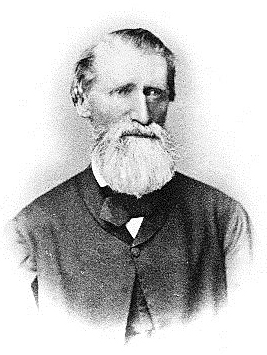
At ‘Bontharambo’ near Wangaratta, 64-year-old Joseph Docker’s farming industry continues to grow on a large scale with some 1,500 acres of land being cropped by him between 1857 and 1865. At an auction sale in November 1858 Docker purchases a further 4,000 acres of land adjoining his selection at £1 per acre. This additional property is rapidly fenced, wells are sunk, and cottages built on areas of about 200 acres each and then leased for seven years from February 1860 to tenants at £1 per acre. Also in 1858, Docker hires Thomas Watts to design and build a two-storey brick and granite ‘Bontharambo‘ Italianate mansion and improve other station buildings on the large property.

| Always financially astute, just a year after he arrived at the Ovens River, Joseph Docker travels to the recently named settlement of Melbourne in 1839 where he sees land for sale in an area near the Yarra known as ‘Richmond’. Impressed with the blocks on the hill that overlook the river and small but growing town of Melbourne, he purchases 50 acres (200,000 square metres) for £975. Later, in the 1850s, seeking to take advantage of the dramatic increase in the people arriving in Melbourne after the discovery of gold, Docker and his nephew, William Workman, will subdivide and develop both Richmond and Clifton Hill, building numerous houses in both areas. It is a profitable exercise and by 1857 Docker owns 57 houses in the Richmond area alone! He will go on to invest in property in the new beachside area of Elwood. |
1857

Twin Chinese ‘Burning Towers’ are erected at the Beechworth Cemetery in the section allocated for the Chinese. They are used for ceremonial purposes like burning paper money and prayers in memory of the dead. A Shrine (or Altar) is added in front of two towers in 1883 so that Beechworth’s many Chinese citizens may leave food for the dead.
| Around 2,000 Chinese gold seekers and settlers are buried in the Chinese section of Beechworth Cemetery. Male Chinese miners are often referred to as ‘Celestial gentlemen’ or the Chinese as a whole as ‘The Celestials’. |
1857
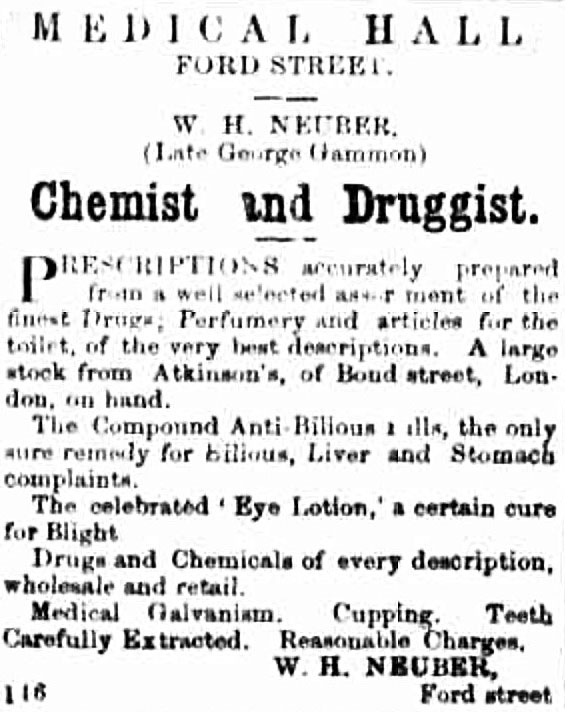
George Gammon sells his successful ‘Medical Hall’ on Ford Street to W.H. Neuber – son of the late William Henry Neuber – and goes home to England. But Gammon will return to Beechworth in 1859, buying back his old premises from Neuber and resuming his Pharmacy. George Gammon’s ‘Medical Hall’ is the largest of the several Pharmacies that operate in Beechworth at the time.
1857 – Aug 25
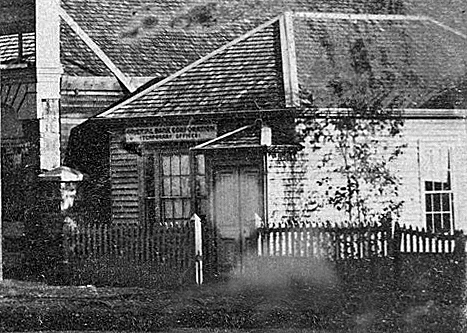
The Oriental Bank – a British Imperial bank founded in India in 1842 – is granted land at 97 Ford Street and a small Beechworth branch building is constructed. In 1876 it will be demolished to make way for a larger brick building to house the Beechworth branch of the Oriental Bank.
1857

An impressive two-storey building, with a large cellar, is completed at 8 Albert Road (on the corner of Albert Road and the Buckland Gap Road, now Kerferd Road) and trades as a wine and spirit merchant. The two-storey brick building still stands today (below).

1857

A splendid stone house is built at 67 Finch Street. Featuring a bullnose veranda, the home’s formal entrance leads into the 30 foot hallway with four large rooms leading off from the hallway, all with open fire places with mantles, and 12 foot high ceilings. The house includes ornate cornice and ceiling rose plaster moulds, decorative stencilling and a claw foot bath. An extension will be added in 1925, with a kitchen and large living room featuring a ‘Wunderlich’ ceiling and rose coloured, gold infused windows.
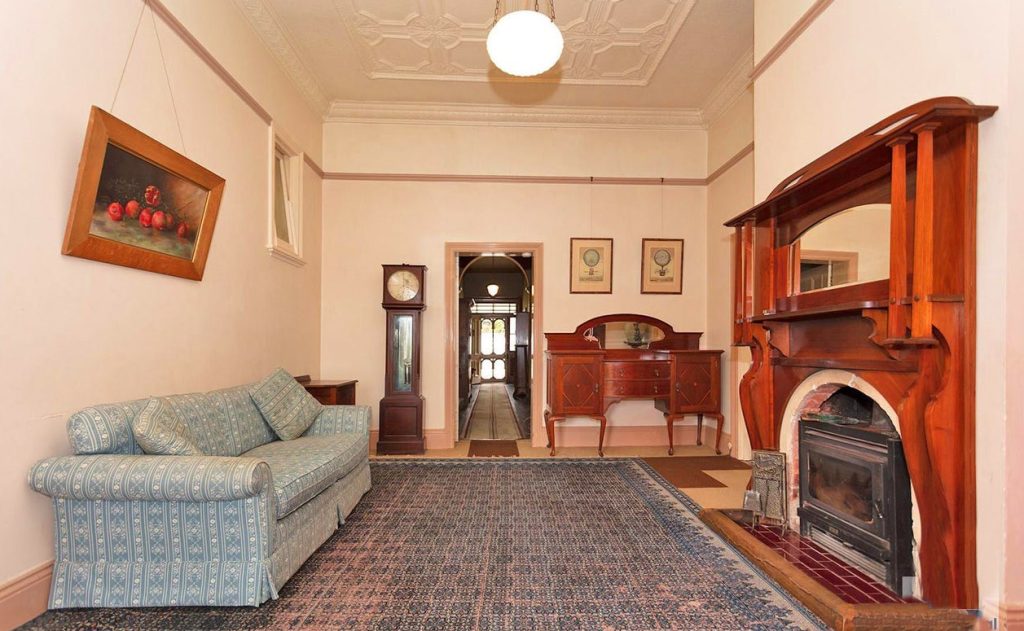
1857

A solid stone-built shop, with a private residence on the second story, is constructed at 89 Ford Street next door to the Bank of New South Wales. The original custodian of the property is pharmacist J.H. Mathews and the small original dispensary and serving window is still visible at the bottom of the stairs. (The building is fully renovated and restored in 2022, below).

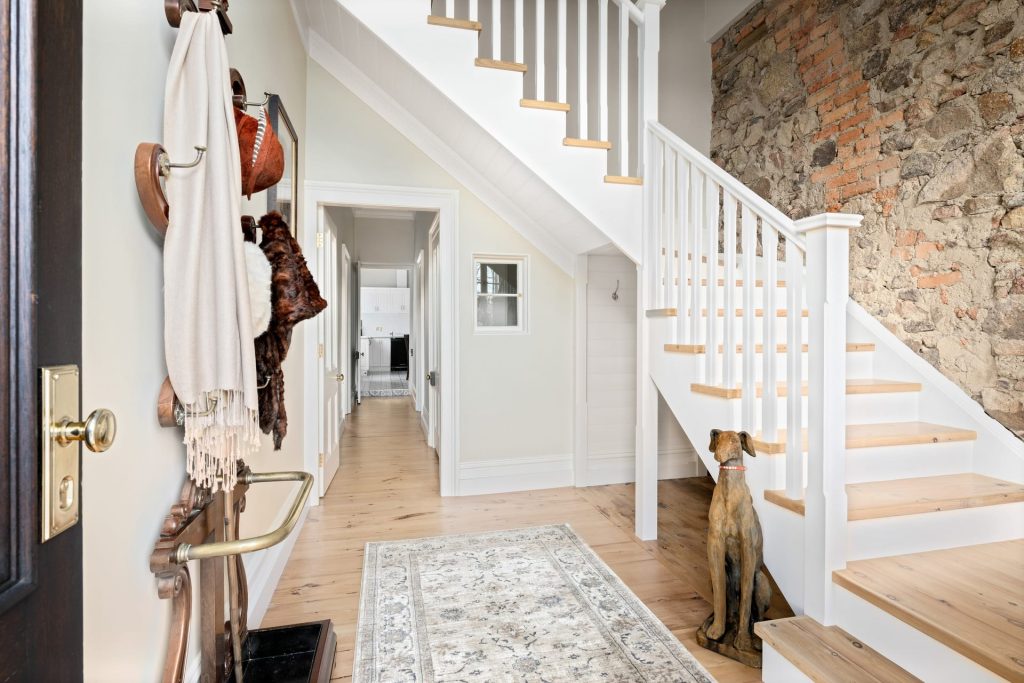
| It would appear that Police Superintendent Robert O’Hara Burke (briefly) resided in the upstairs residence at 89 Ford Street before he departed Beechworth late in 1858. |
1857
Isaac Phillips, one of the first Jewish settlers in the area, is granted 1,900 acres of land at what is now 1175 Beechworth-Wangaratta Road, Everton Upper. It is the first piece of Crown Land sold off by the government in the Everton parish. Phillips names his new property Golden Ball after a spherical piece of gold found nearby and the granite house he builds on the property will soon be converted into the Golden Ball Hotel – frequented by passing travellers on the road to Beechworth.
| Although no longer a hotel, the granite building still stands today. The property will be purchased in 1996 by James McLaurin who plants vines on the property and establishes ‘Golden Ball Wines’. |
1857

The London Chartered Bank of Australia opens a branch on Ford Street in Beechworth. The London Chartered Bank of Australia had been established in October 1852 with the issuing of a prospectus and granting of a royal charter for the new London-based joint stock bank, to operate in the colonies of New South Wales and Victoria. A manager and clerk staff are sent from England to New South Wales on the ‘Harbinger’ in May 1853 and by July the same year the first branches open – in Collins Street in Melbourne and George Street in Sydney – with a Geelong branch opening in October 1853. By 1893, the bank will have 34 branches in Victoria, but in May 19212 the English, Scottish & Australian Bank (ES&A Bank) assumes control of its business.
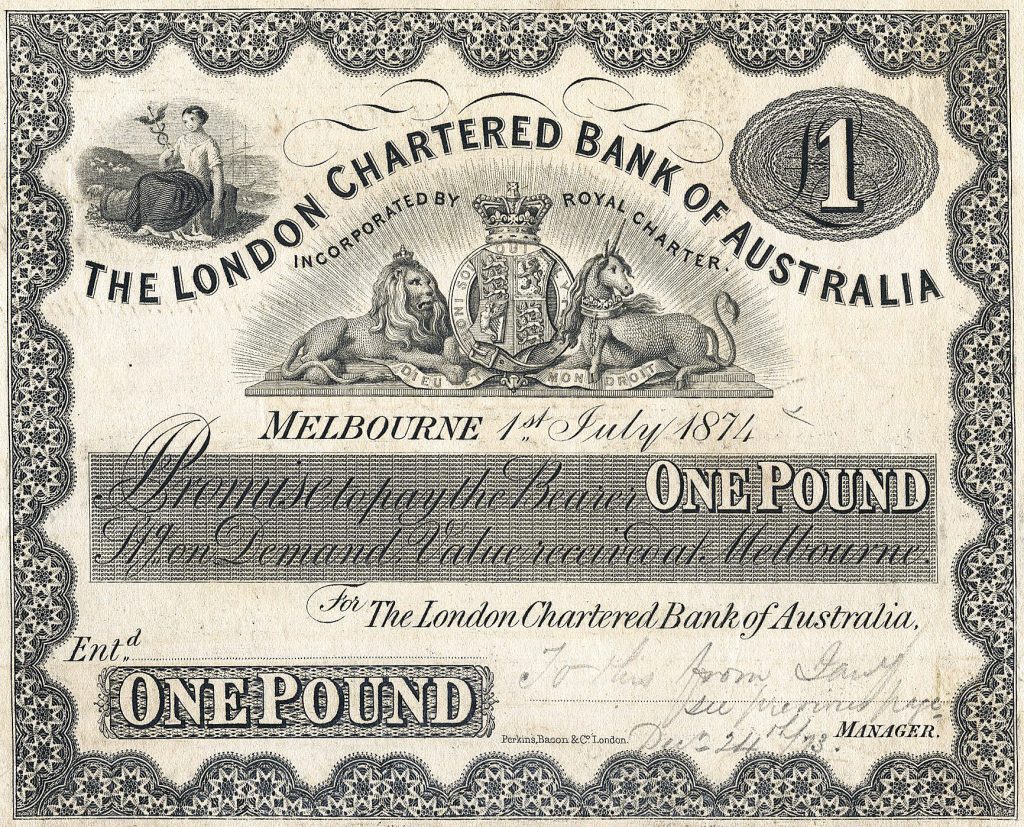
| In deference to Beechworth’s main source of wealth, the town’s early banks will sometimes display gold purchased during the week in their windows on Saturdays, which often draws a crowd of admiring spectators. |
1857
The Oriental Hotel opens on the corner of Bridge Road and Mellish Street, a few yards away from the Newtown Falls and the site of the original discovery of gold in Spring Creek.
| The ‘Oriental Hotel’ is destroyed by fire on April 1st, 1886. The owner, William Andrews, his wife and children escape the blaze, but all their possessions are lost. A private home now stands on the site. |
1857 – Sep 1
A solemn procession takes place to accompany 64 exhumed bodies (out of the 145 buried) from the earlier Beechworth cemetery at the site of the soon-to-be built Congregational Church Hall in Loch Street to where they will be re-buried in a special ‘Pioneers Section’ of the new Beechworth Cemetery in Balaclava Road, opened the previous year.
| Sadly, the original Cemetery Burial Records will be destroyed in the ‘Great Beechworth Fire’ of 1867, resulting in the loss of these burial records. James Ingram, head of the Cemetery Trust at the time, will painstakingly reconstruct the names and dates of death of these Pioneers from newspapers and church records meaning that the Beechworth Cemetery now has a complete list. |
| Among the many interesting graves at the new Beechworth Cemetery are those of Beechworth’s ‘grand old man’ James Ingram; Dame Jean McNamara, world authority on myxomatosis; John Watt, shot and killed by bushrangers Smith and Brady; and German immigrant Anton Wick who was used as a pawn in the shooting of Ned Kelly’s nemesis, Aaron Sherritt. |
1857 – Sep 1
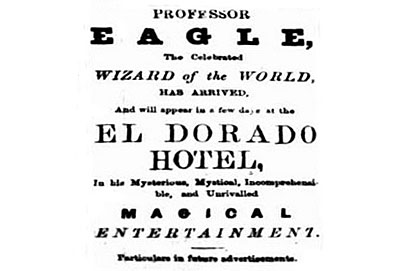
English magician ‘Professor’ James Eagle – The Wizard of the World – opens a season at Beechworth’s El Dorado Hotel on High Street “and every evening during the week”, supported by a concert troupe of five. From September 16 to 18, the Professor performs at the Freemason’s Arms Hotel in High Street supported by his comic assistant, named “Sprightly” (James Bodell) and from September 24 to 26 he will perform at John Wallace’s Star Hotel at Nine Mile Creek (Stanley), for what he announces will be his “last appearance in the district”.
| The hundreds of diggers in Beechworth and surrounds demand constant entertainment and recreation and, during the same month that ‘Professor’ Eagles is performing in Beechworth, newspapers are also advertising ‘Ashton’s Royal Olympian Circus’, the ‘Chinese Brothers Gymnastics’, a singing concert by a Mrs. Vincent, along with four dances and Grand Balls in the township! |

1857 – Sep 7
To ease the now chronic shortage of accommodation, four ‘transportable buildings’ arrive in Beechworth. Manufactured in England, mainly using corrugated iron, they arrive in numbered sections with attached instructions for easy erection. These iron buildings will initially be used to house the swelling number of local police members which have increased following the Buckland Riots.
1857
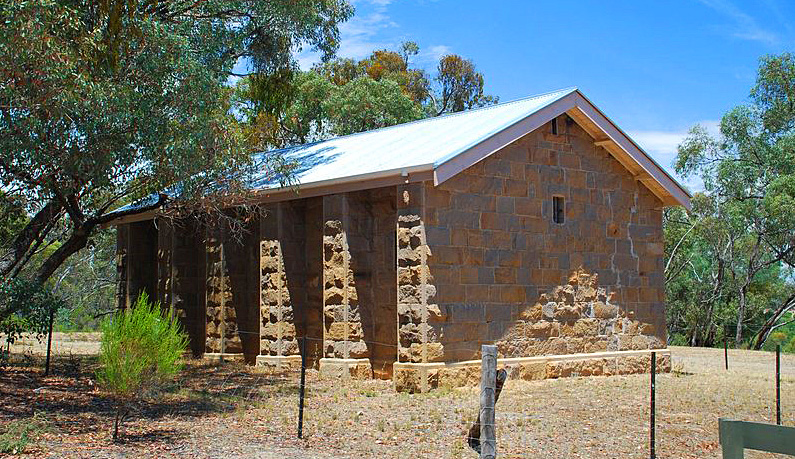
The Victorian Government passes an “Act to Regulate the Importation, Carriage and Custody of Gun Powder” which provides for the construction of ‘Powder Magazines’, to be paid for by the Treasury, but administered locally. Anyone bringing more than 100 pounds of powder into a district possessing a ‘Powder Magazine’ must store it in the district’s magazine and pay a small rental. Within the next few years over twenty five new ‘Powder Magazines’ will be erected in Victoria, and older magazines will be improved and extended. Beechworth will get its own ‘Powder Magazine’ in 1859. (see further entry below)
1857
10km from Beechworth, citizens of Snake Valley (Stanley) get together to construct a ‘Public Room’. It will serve a number of purposes including a meeting place, a church and a school.

| When the ‘Public Room’ is destroyed by fire in the late 1860s, it is replaced with a brick building – the ‘Stanley Athenaeum and Reading Room’ – which is completed in 1874 and still stands at 2 Beechworth-Stanley Road today (above). |
1857
Jacob and Christina Vandenberg (or Van Den Berg) and their five children arrive at the Woolshed diggings and take over the Brittania Hotel, established by William Hill in 1856. Originally from Rotterdam in Holland, after a stay in England, they travel to Australia and choose to head to the north-east.
| One of Jacob’s sons, Henry Vandenberg becomes a Justice of the Peace and Shire Councillor and will serve as Shire President. He forms Beechworth’s first orchestra, he himself later gathers together his own musical contemporaries into ‘Vandenberg’s Beechworth Brass Band’ which is the forerunner of the later ‘Beechworth Town Band’. He also conducts an orchestra of seven, which includes his daughter Christina and sons Jack, Harry, George and Bob, each of whom play many different instruments, and are in great demand together and individually. The next generation to be reared in Beechworth are three of his grandchildren – Mary and Nola, and their cousin, Moyra. Each generation in turn is connected with any activity where the cultural, social, or sporting progress of Beechworth has needed active support. |
1857

A beautiful cottage is built at 26 Finch Street. Set in a magnificent garden allotment, Stonehaven is a two-storey Gothic Style home that is now classified by The National Trust and listed with Heritage Victoria.
1857 – Sep 12

Beechworth is full of excitement as James Henry Ashton brings his Ashton’s Royal Olympian Circus to town.
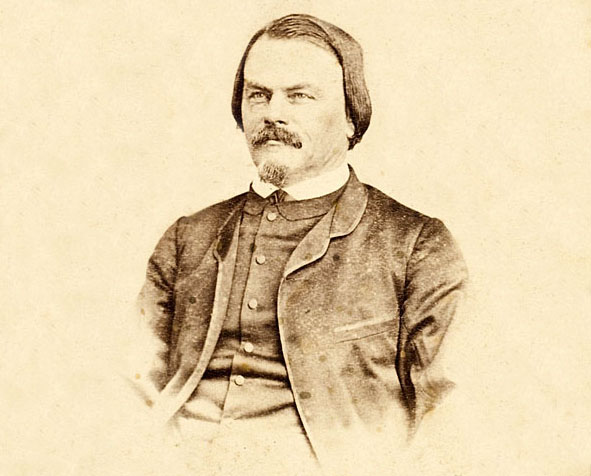
| Henry James Ashton (born in Colchester, Essex in England) begins his performing career as a child clog-dancer and circus performer. Migrating to Australia in the 1840s, he finds success as a ‘bold and fearless’ equestrian at Radford’s Amphitheatre, Hobart Town, in 1848-49. In February 1850, Ashton acquires ‘Mollor’s Circus’ founded in Hobart in 1847 by Thomas Mollor. Renaming the circus after himself, James Ashton grows the business substantially and, at its height, ‘Ashton’s Circus’ has more than 180 personnel and 80 animals and thousands of pounds worth of equipment. He will tour the Australian colonies for at least 40 years, along with New Zealand and Papua New Guinea. He will die at the age of 70 at the Metropolitan Hotel in Gladstone on January 17, 1889 while on tour on Queensland. |
1857
The Ovens gold rushes peak, and during the following two decades the population of Beechworth decreases (though the last mining company in the district won’t close until 1956).
1857 – Dec

After inviting tenders for the “fitting up of a Bar” and “building of a four-stalled slab and bark stable”, Robert Thornton obtains his publican’s licence and opens the small white two-storey Yorkshire Hotel on the north side of High Street – midway between the popular Criterion Hotel and the Freemasons’ Arms Hotel – on land where Thornton has previously been operating the Beechworth Restaurant. But the competition from the bigger hotels is tough and within 12 months Thornton is bankrupt, and the Yorkshire Hotel is sold to fervent Welshman Robert R. Jones who soon renames it The Prince of Wales Hotel and uses the words ‘Cymru a’r Chymraeg’ (‘Wales and the Welch’) in all advertising for the small weatherboard pub.
1857 – Dec 28

The Victorian Government releases 6,000 acres of Crown land for purchase around (present day) Milawa on the Oxley Plains, 29 km from Beechworth. One of the blocks – 120 acres – is purchased by 41-year-old Scottish-born John Graham who will plant one of the first vineyards in the district on his land in the 1860s, growing table grapes to sell to passing gold-seekers. His daughter Rebecca will marry George Harry Brown in 1864 and, in 1885, their 18-year-old son, John Francis Brown, will plant the first wine grapes on his grandfather’s Milawa property – 10 acres of Riesling, Muscat and Shiraz grapes – and by 1889 the first vintage of wine is produced in the Brown family’s hay and grain barn (which still stands on the property today – below). John Francis Brown names his new wine venture Brown Brothers hoping that his brothers will join him … they never do. Instead, John and later (in 1933) his 18-year-old son John Jnr (John Charles Brown) build on the promising start, and today Brown Brothers is one of Victoria’s most famous and respected wine producers, now managed by the fourth generation of the Brown family.

1858 – Jan

Built by Edwin Carter and William McLuckie, the Beechworth Telegraph Station is opened in front of the Police Reserve on Ford Street, quickly becoming the key point of communication throughout the district and the main connection hub from regional centres to Melbourne and Sydney. It will operate for many years, functioning as an independent branch of the Postal Service. A single telegraph line connects Melbourne, Kilmore, Seymour, Euroa, Benalla and then Wangaratta to Beechworth, which then proceeds to Belvoir (Wodonga), crossing the Murray River into New South Wales at Albury. In the late 1850s, Woolshed, Stanley and Yackandandah still lack telegraphic links to Beechworth or the outside world.

| In 1865 the telegraph line from Beechworth to Belvoir is re-routed from Wangaratta to Albury via Chiltern, leaving Beechworth connected via a spur wire. In the 1880s the ‘Telegraph Station’ is remodelled to become the ‘District Survey Office of the Lands Department’. |
1858 – Jan 4
The Governor-in-Council officially establishes six mining districts in Victoria, including the ‘Beechworth Mining District’. This District is further divided into seven Divisions: Spring Creek, Snake Valley, Three Mile Creek, Buckland, Woolshed, Yackandandah and Omeo.
| By 1890 these seven Divisions has grown to seventeen Divisions within the Beechworth District, but that number falls to fourteen by 1917, twelve by 1934 and six by 1967. |
1858 – Jan 4

Following the Friday and Saturday Races at the Reid’s Creek settlement, Smith’s Welcome Inn hotel is destroyed by fire at around 2am on the Sunday morning. While Daniel and Mary Smith and many patrons are rescued from the crowded slab and bark building as it goes up in flames, six bodies will be recovered from the hotel’s charred remains the next morning. Four more will die from the injuries over the following days. The victims include Sarah Ann and William Newey (the daughter and son-in-law of Daniel and Mary Smith) and their two-year-old son George; a musician, name unknown; and a tall athletic man, a splitter from Woorajay.
| The shock of the fire and loss of 10 lives will bring about the formation of a basic ‘Beechworth Fire Brigade’ within a few weeks. |
1858
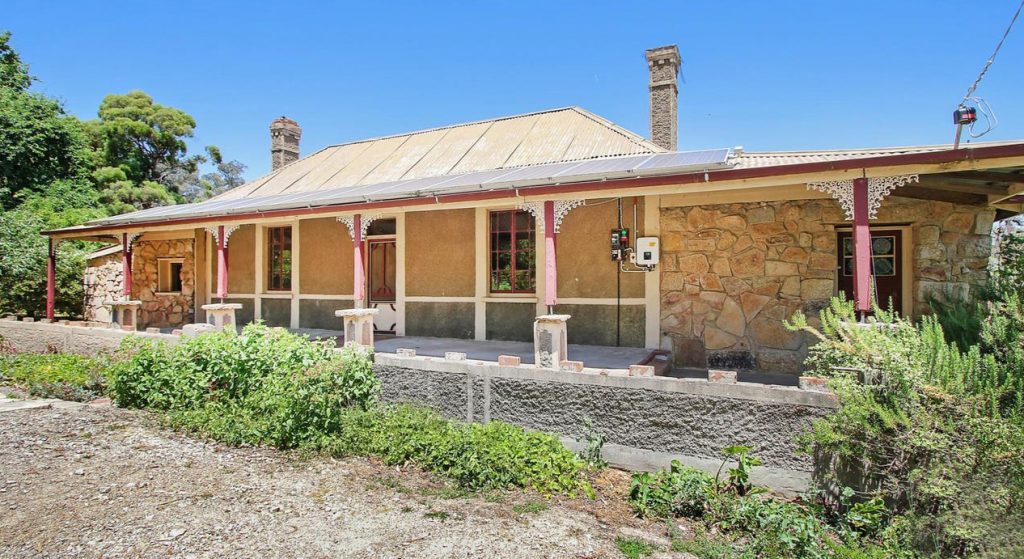
Built of hand-hewn timbers and local granite stone, an impressive new home is completed at 37 Malakoff Road. Timber shelving in the kitchen is later added from reclaimed materials from the Melba Theatre (later renamed the Odeon Cinema) in Melbourne during the house’s refurbishment in the pre-war years. The large stone cellar below the house features a small stage at one end for musical performances.
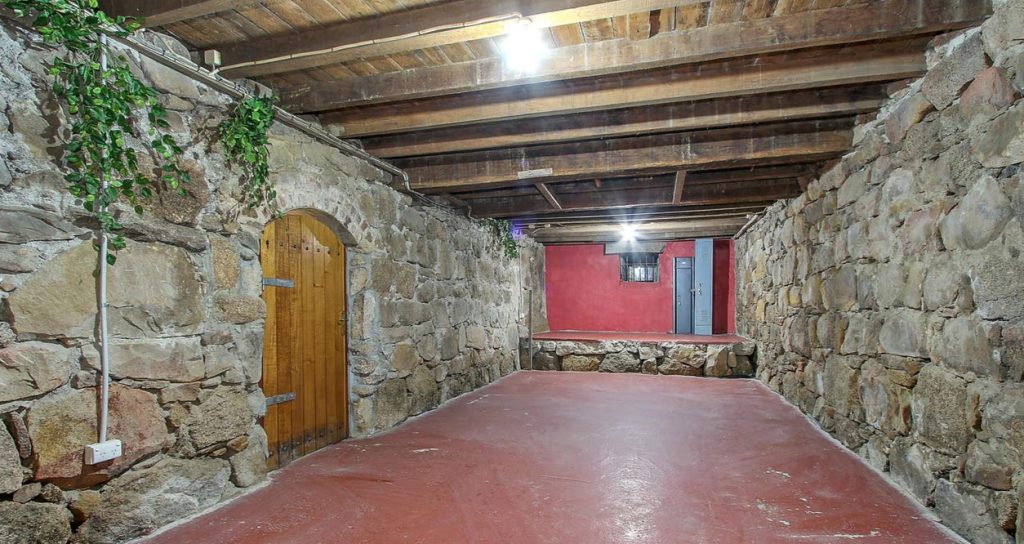
1858 – Feb
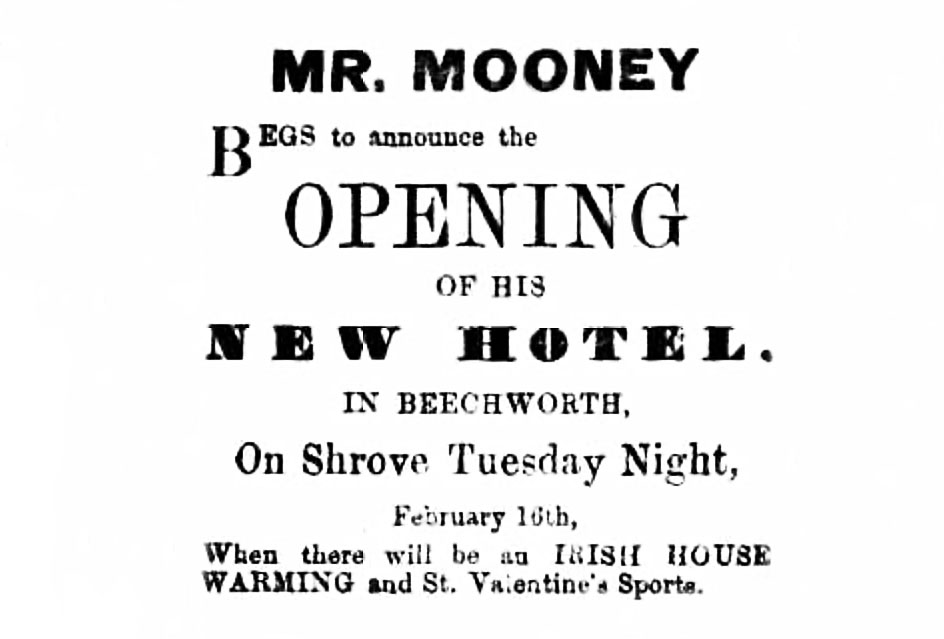
Thomas Mooney is the first licensee of a new single-storey wooden hotel on Ford Street. Standing next door to the ‘Oriental Bank’, it has been constructed by builder James Kyle and has a 66-foot frontage on Ford Street and extends 132 feet back towards Loch Street. Mooney had previously been a publican at the Woolshed where, in November 1856, he had been implicated in a “sly grog case” but escaped conviction. ‘Mooney’s Hotel’ will operate for only a few months before being taken over in June by 47-year-old John Cox Gimeson (formerly a butcher on High Street) who changes the name to the ‘Telegraph Hotel’ due to its proximity to the newly opened Telegraph Station directly across the road.
| In September 1861 the ‘Telegraph Hotel’ will be renamed again, this time becoming the ‘Albion Hotel” (‘Albion’ is the 4th century Greek name for ‘England’) under new licensee Robert Ransom. In the 20th century the site will become the site of ‘Parkinson’s Garage’. |
1858 – Feb 8

Sporting a new balcony and other improved amenities for theatrical performances, crowds flock to the newly renamed Star Theatre (formerly known as the Assembly Hall) at the Star Hotel for opening night, where they will witness the premiere performance of the opera “La Sonambula” starring Walter Sherwin and Julia Harland. However, the audience is dismayed to discover that most of the scenery and costumes have failed to arrive in time for the performance, having been sent by a slower means of transport than the passenger coach! The first show goes on despite the lack of ‘dressings’.
| In 1866 Walter Sherwin loses a forearm in a shooting accident, but continues to perform in concerts throughout Australia, New Zealand, America, Japan and China. In the 1870s he survives a shipwreck, but on his return from Asia in 1881 Sherwin is taken ill and dies soon after in hospital in Sydney. |
1858 – Feb

The attempted abduction and rape of Catherine Morton. Catherine lives with her brother and her father in a tent on the gold diggings. One night, Michael Meard, who lives in a tent about 200 yards away, cuts the wall of the Morton’s tent, attempts to anaesthetise Catherine with (what appears to be) chloroform, intending to carry her off and “have his way with her”. But Catherine wakes up and screams, and her father and brother seize Meard and call for the police. Meard is arrested and the subsequent investigation is quite scientific. Amongst other procedures, the police take Catherine to J.H. Mathews, the pharmacist at 89 Ford Street next to the Bank of New South Wales, and get her to smell the contents of three different bottles, and from her reaction they confirm that chloroform was used. Beechworth’s other pharmacist William Witt then confirms that Meard had purchased some chloroform for his pharmacy sometime previously. Michael Meard is found guilty at trial and sentenced to “five years forced hard labour on the roads”.
| The ‘Bank of New South Wales’ building is within twenty metres of the Beechworth Courthouse on the Police Reserve. It is now the ‘Beechworth Honey Discovery Centre and Bee School’. |
1858 – Feb 24
Independent minister, the Reverend Thomas Hinton Jackson, arrives in Beechworth and conducts his first service in the hall of the 1856-built ‘Beechworth Athenæum’ (now known as the Burke Museum). The ‘Independent Church’ (also known as the Congregational Church) quickly put together a committee and hold their first meeting at James Ingram’s reading room. Presided over by Reverend Jackson, 13 members are in attendance, including Philip Le Couteur.
| From the time the goldfields developed in the Beechworth area, efforts are made to establish a church of the ‘Independent Order’ but owing to various circumstances – and the want of a minister – the movement fails; not, however, without the ‘Independents’ leaving to their successors a block of land on the corner of Camp and Loch Streets on which a church will eventually be built as the fruit of their labors – not as a gift received from the state – but with their own voluntary offerings of £275. |
1858 – Feb

Waterloo-veteran John Drummond, and now Beechworth resident, donates his valuable military pension to the widows and children of soldiers who have died fighting in the Crimean War. Born in Scotland, at age 15 Drummond joins the army (lying about his age, telling them he is 18) and fights against Napoleon’s troops in 11 battles beginning in 1807, culminating in fighting in the ‘Battle of Waterloo’ in 1815. Discharged from the military in 1828, he immigrates to Australia in 1831 and works for a number of years on a farm in Goulburn in New South Wales before moving to Beechworth in the early 1850s to work for David Reid. He will pass away at the age of 74 in 1865 and is buried at the Beechworth Cemetery – one of only a handful of Waterloo veterans buried in Victoria.
1858 – Feb 25
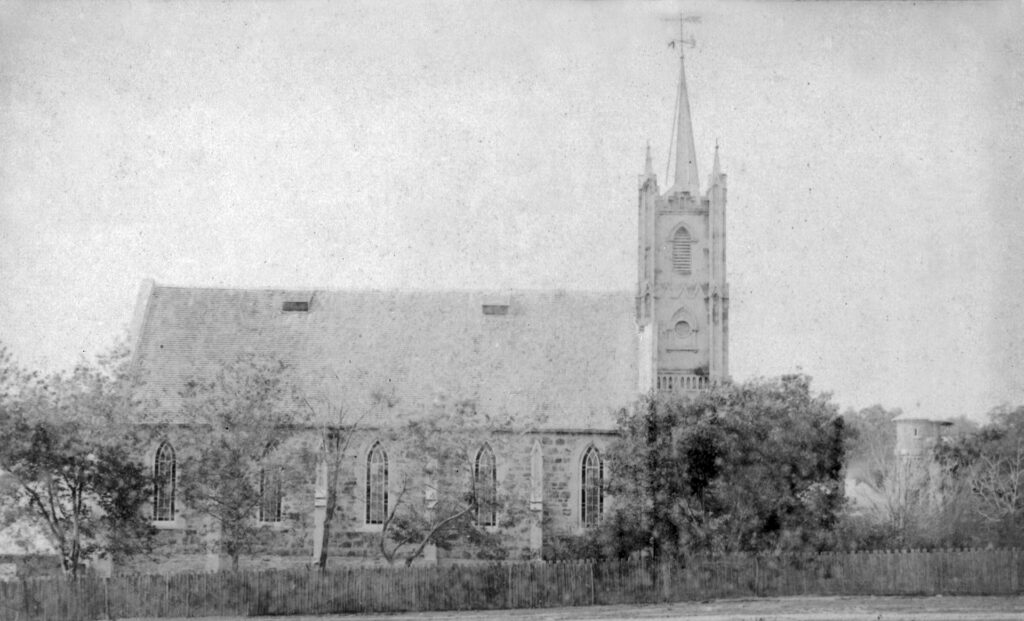
The congregation gathers for the first Sunday service held at St. Andrew’s Church – Beechworth’s recently completed Presbyterian Church. The first minister is the Reverend John Grant. Following the laying of the foundation stone a year earlier, the solid walls have gone up quickly and the 65ft x 37ft church is officially opened by the Reverend James John Grant at 115 Ford Street, on the corner of Ford and Williams Streets, across the road from the Beechworth Stockade. The town’s first Presbyterian church is designed by architect Thomas Turnbull and built by Smith, Bank & Cranston at a cost of £2,500 (around $300,000 today). The rendered brick hall church features buttressed walls and lancet windows with label mouldings and is dominated by a square tower with a short spire. The tower has pairs of tiered buttresses in each corner which are surmounted by pinnacles. (A wooden ceiling and shingle roof are added in the early 1870s). On March 21, 1883 the Foundation Stone for the ‘Sabbath School’ – to be built of exposed brick at the rear of the church – is laid the Reverend John Gordon Mackie. It will be completed by the July 17th the same year.

| St. Andrews will become a ‘Uniting Church’ when the Methodist & Presbyterian congregations combine in 1977. St. Andrew’s Uniting Church of Beechworth today consists of the 1857 stone church, the 1883 red brick Sunday school and hall at the rear, the gateposts on the Ford Street corner and the Grey Myrtle (Backhousia myrtifolia) in front of the church. |
1858
23-year old John Cock arrives in the goldmining settlement of Eldorado, 30km from Beechworth. The son of a Cornish miner, young John will soon become the youngest mining manager in Victoria, being employed by the Ovens Gold and Tin Mining Company. He and his wife Mary and their family will stay in Eldorado until 1879 before moving to Chiltern. Well respected for his mining skills, he goes on to work for the Wallace group of mines, extending between Rutherglen and Howlong. J. A. Wallace develops the mining technique known as “pump hydraulic sluicing” or “hydraulic dredging”. This technique will show its best results came when it was used by John Cock back at Eldorado, working the gold-bearing gravel beds flanking Reedy Creek. The formation of Cock’s Pioneer Electric Gold and Tin Sluicing Company in 1899 which will herald a new era in Eldorado mining, changing from ‘deep lead mining’ to ‘open cut sluicing’, and finally ‘bucket dredging’. Projects using these new extraction methods will last at Eldorado until 1954.
1858

A small hall is finally completed and opened on the site of the (recently moved) Beechworth Cemetery on the corner of Loch and Camp Streets, to be used by the Congregational Church for their services and their Sunday School. The Congregational Church will erect a proper church on the block next door in 1869.
1858

Beechworth Councillor George Briscoe Kerferd puts forward a proposition that tollgates should be installed at the north and south entrances to the town. Kerferd proposes one tollgate should be installed at the Newtown Bridge (below) and another near the Vine Hotel, at the junction of the Woolshed, Chiltern and Yackandandah Roads. Although the proposal is discussed, at length, it is eventually dismissed as “Tollgates would effectively cut Beechworth off from the outside world”.

1858 – Mar

The name of the settlement at Upper Nine Mile Creek (also known as Snake Valley) is officially changed to Stanley in honour ofthe British Prime Minister Lord Stanley (Edward Smith-Stanley, 14th Earl of Derby) who will serve three terms as British Prime Minister (1852, 1858, 1866) and (to date) the longest serving leader of Britain’s Conervative (Tory) Party.
| By 1858, the newly renamed township of Stanley has numerous thriving businesses, including ‘The Star Hotel’, Hopton Nolan’s ‘Sun Hotel’, Peter Donald Ramsay’s ‘Bush Inn’, John Dowling’s ‘Times Hotel’, W.H. Manton’s Butcher Shop, John Alston Wallace’s General Store and many more, along with Stanley’s own newspaper, the ‘Stanley Times’ published by Thomas Affleck who will go on to become editor of the ‘Albury Border Post’. |
1858
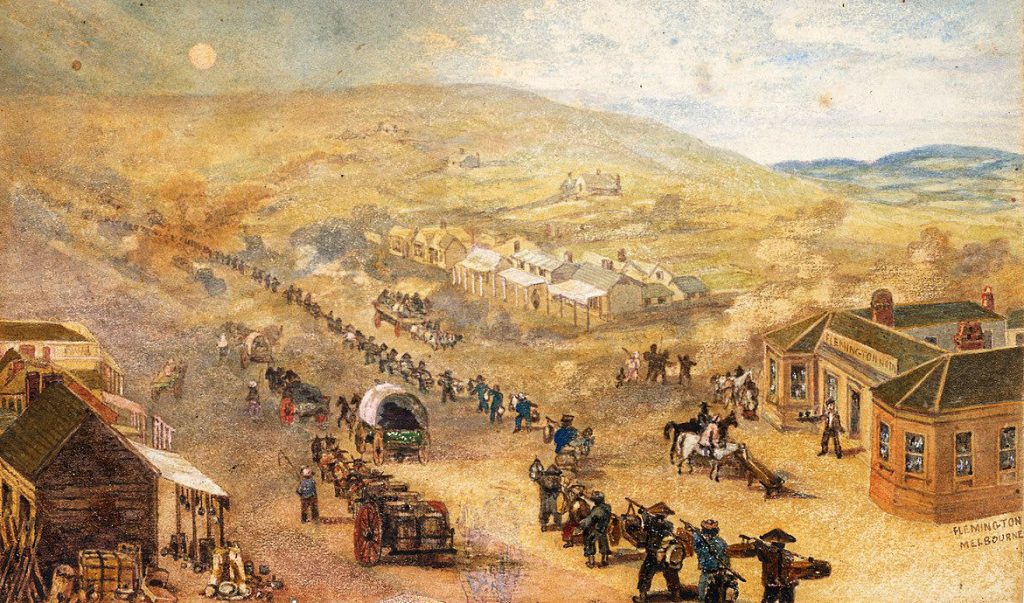
Not only are Chinese miners heading to Beechworth from Melboutrne, but in 1858 The Constitution and Ovens Mining Intelligencer reports that in just one week, 150 Chinese cross the Murray River at Albury as they head towards the Beechworth diggings and that some attempt to avoid the £1 entry tax.
| After the Buckland Riots of 1857, the Victorian government enact a series of anti-Chinese laws that regulate movement, living areas and mining laws and impose a ‘residence tax’ of £4 per immigrant. The Chinese Emigration Act denies Chinese holding ‘The Miner Right’ from voting in a Mining Board election, providing penalties up to £10 for Chinese failing to pay the residence tax within two months of entering the Colony. The Act also prohibits any immigrant from instituting proceedings in the Mining Court, or any other Court, or before a goldfields Warden ‘to recover possession of any land occupied by virtue of a miner’s right’. In short, the Act decrees that the Chinese, though taxed, are non-citizens. |
1858 – Apr 23-25
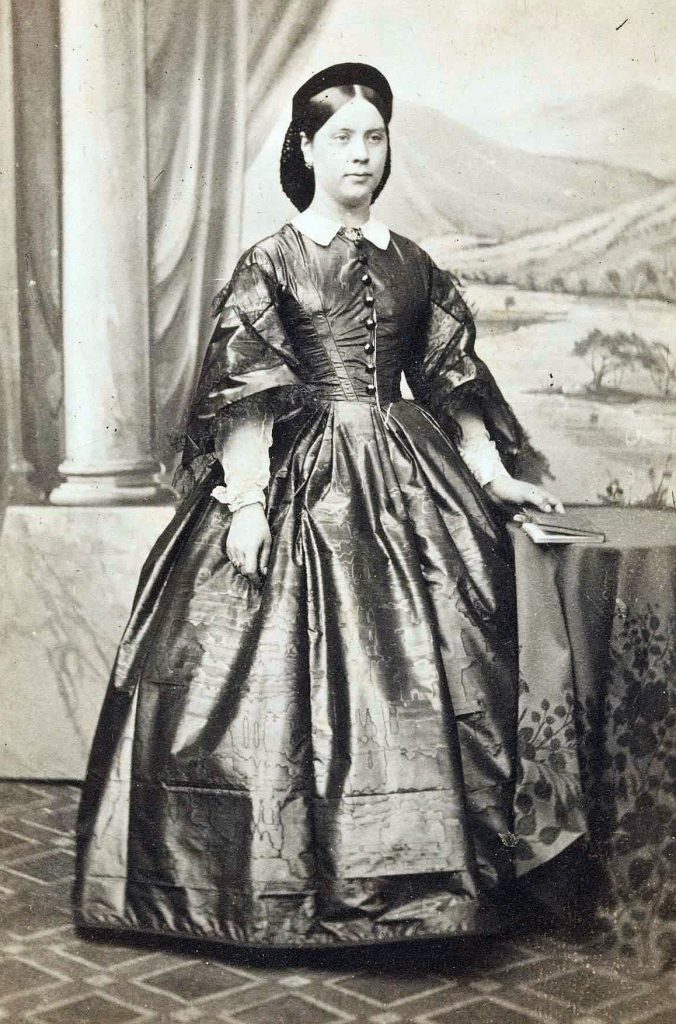
The infamous ‘Spider Dance’ finally comes to Beechworth! After Lola Montez had to cancel her performance in Beechworth in May 1856 (for undisclosed reasons), young Julia Matthews arrives in town and performs the much discussed ‘Spider Dance’ to an enchanted audience, including Beechworth’s police inspector, 37-year-old Robert O’Hara Burke, who is so smitten by the 16-year-old English-born actress and singer that he propses marriage, telling people her ‘auburn curls and charming voice captured my heart’. She declines the proposal. Two years later she will receive a second marriage proposal from Burke shortly before he leaves for his great Expedition in 1860. Again, she declines.

| On tour in New Zealand in 1864, 22-year-old Julia marries her manager William Mumford and they have three children. In 1867, with their children, they travel to England where Julia has the distinction of being the first Australian-trained singer to appear at the Covent Garden Opera House. In 1870 Julia obtains a judicial separation from the faithless and alcoholic Mumford who, it is said – “is a machine for grinding out golden sovereigns for him to waste in drink and debauchery”. Julia then goes on tour, performing in Europe and then America to support her three children. Sadly, in St Louis, Missouri, she contracts a malarial disease and dies at Mullanphy Hospital on May 19th 1876, aged just 33. |
1858 – Jun 2

The Beechworth Chamber of Commerce is established, the first of its kind in north-east Victoria. The President is Mr. A.H. Lissack with John Sitch Clark elected as Vice President.
1858 – Jun
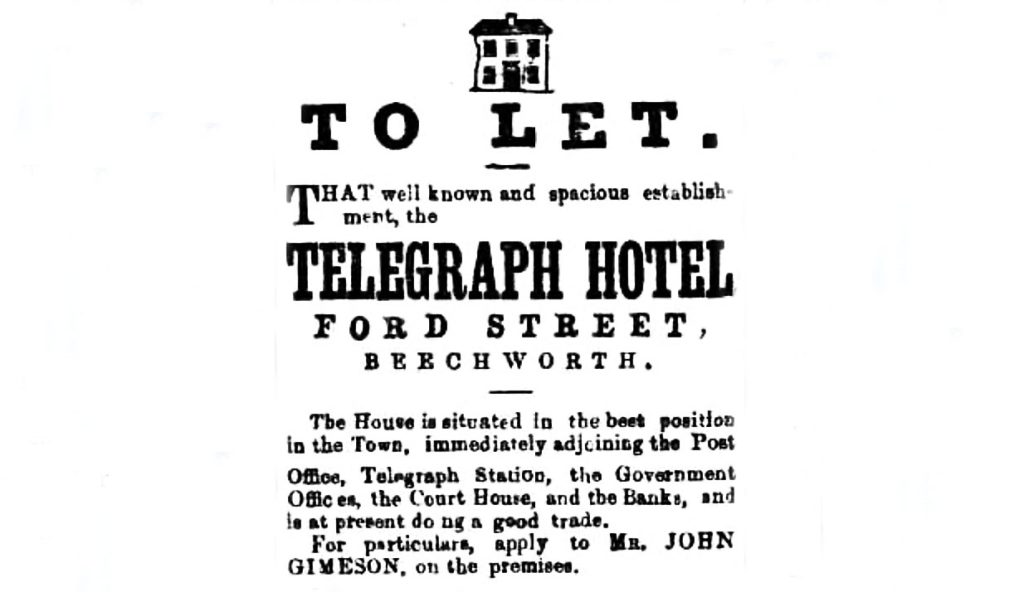
47-year-old John Cox Gimeson takes over the licence of the recently opened ‘Mooney’s Hotel’ on Ford Street and he and his wife Elspeth rename it the ‘Telegraph Hotel’ due to its proximity to the newly opened Telegraph Station directly across the road. By the end of 1859 he will put his hotel up for lease (above).
| Transported to Australia as a convict, John Cox Gimeson will work for a time as a butcher on High Street in Beechworth before becoming a publican. After leaving the ‘Telegraph Hotel’ he will return his former occupation, opening the ‘Meat Mart’ next to the ‘Temple Bar Hotel’ in 1862. But four years later – in January 1868 – John Gimeson is admitted to the Beechworth Hospital for the Insane with incipient general paralysis. Despite treatment he will die at the Asylum on June 2nd the same year. |
1858
A timber grandstand is erected at the Public Recreation Reserve.
1858 – Jun 22
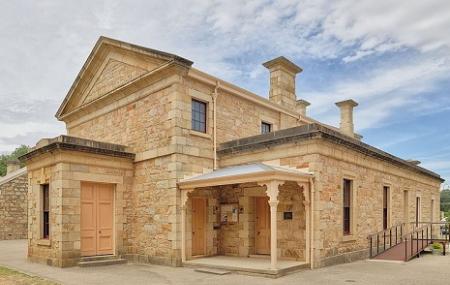
The new Beechworth Courthouse is officially opened. Built of granite by contractors Smith, Bank and Chambers at a cost of £3,730, it stands next to the Gold Administration buildings in Ford Street. It will be the scene for countless trials involving the likes of bushranger Harry Power, Ned Kelly and his mother Ellen, and Elizabeth Scott. As the number of cases being heard in Beechworth grows, sometimes the small building proves inadequate and other buildings are occasionally called into use to hear cases, including the Beechworth Town Hall. The Beechworth Courthouse will be in use until 1989, and be officially closed on January 1st 1990, after 131 years of service.

| Sir Redmond Barry presides over several cases at the Courthouse. Ned Kelly appears at his committal hearing at the Beechworth Courthouse in August 1880 before his murder trial continues in Melbourne. |
1858

With the opening of the new Beechworth Courthouse, the ‘Local Court District’ is reappointed as the ‘Beechworth Mining District’, and the ‘Beechworth Court of Mines’ is established, with cases heard in the Beechworth Courthouse.
1858

37-year-old Thomas Spencer Cope, LL.B. – who had studied law at the London University and been called to the bar in 1845 – arrives in Beechworth after being appointed Judge of the Court of Mines and the County Court and Chairman of General Sessions for the district of Beechworth. He makes frequent and difficult journeys to other townships and mining centres, including Buckland, Morse’s Creek (Wandiligong), Yackandandah, Bright and Woods Point. Famously, during a flood, he once climbs – slowly and carefully – along the top of a series of fences to avoid getting wet but determined to reach the local Court House! He becomes a highly respected community leader in the district and remains in Beechworth as a respected judge for the 10 years before being appointed a County Court Judge in Melbourne where he will spend the rest of his life.

| Initially living in a wooden cottage (above) with his wife Maria on the outskirts of Beechworth, the beautiful home ‘Walworth’ is built for the couple in the early 1860s (below). The two-storey solid red brick Victorian residence at 12 Kars Street still stands today. |
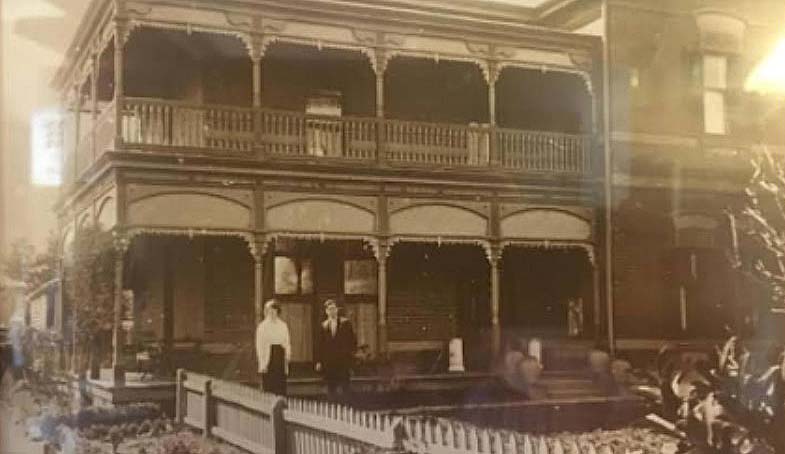
1858 – Jul 2

Charles Albert Ewins, a 26-year-old American, opens the Carriers Arms Hotel on Bridge Road. Built of stone, it is a small but comfortable hotel with a well- stocked cellar. It will later be renamed the Newtown Hotel before closing in 1870.
1858 – Jul 5
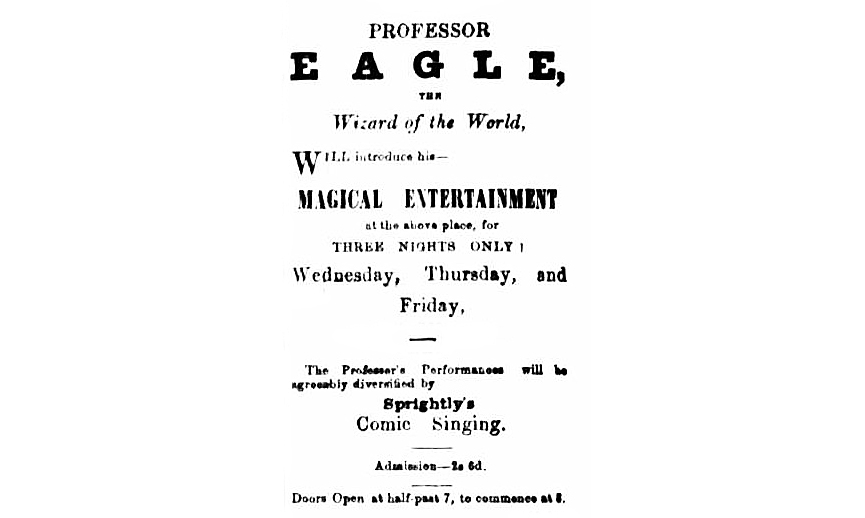
English magician‘Professor’ JamesEagle – The Wizard of the World – has returned to the Beechworth area and is performing his show at Yackandandah when a member of the audience disputes his “catching a bullet in his mouth trick”, claiming the gun could not have been loaded. So, ‘Professor’ Eagle invites the audience member to watch as he reloads the gun with a real bullet and asks him to fire it again. This time, the bullet hits “The Wizard” and he goes down! Some in the crowd initially think it’s all part of the show, but it soon become obvious that it is not a joke, as blood flows from a flesh wound in James Eagle’s arm! (He is not seriously injured and goes on to continue his tour).
| Eagle lists the names of some of his feats as ‘Le Chancelies Cabilistiques’, ‘Mysterious Lavatory’, ‘Devil’s Punch Bowl’, ‘Rifle Gallery’, ‘Inexhaustible Bottle’, ‘Half-an-hour with the Spirits’, and placing one of his audience in the ‘Mystic Sleep’! |
1858 – Jul 26

17 miles from Beechworth – near the crossing place (a ford) over the ‘Myrtle Creek’ on the Buckland Road – the Myrtle Creek Post Office opens shortly after the settlement has been officially surveyed. Standing on the corner of the newly named Albert and Myrtle Streets, the small post office is also the settlement’s general store, serving the needs of diggers flocking along the Buckland Road to the Ovens goldfields. Mail is conveyed to and from the post office by several coach companies – including Beechworth’s H.A. Crawford and Co – on the difficult roads from Beechworth, enroute to Porepunkah, the Buckland, and further afield. Deliveries initially arrive twice a week but, by 1865, have grown to six times a week.
| First settled in 1837 by overlander John Hillas as the ‘Myrtle Creek Run’, when gold diggers begin to flock to the Buckland Valley from late 1852, a small township develops around where the Buckland Road fords the Myrtle Creek. The ‘Myrtle Creek’ settlement will be officially renamed ‘Myrtleford’ in 1871. ‘Myrtle Creek’ has since been renamed ‘Barwidgee Creek’. |
1858
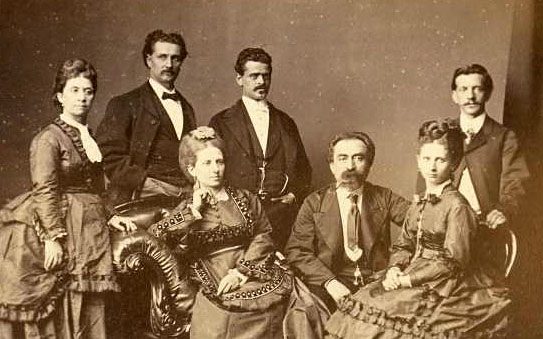
Now the central hub of entertainment in Beechworth, the Star Theatre at the Star Hotel on Ford Street present a marvellous array of entertainment including the popular U.S. Minstrels, Howard Payn’s thrilling drama “Heroes of Waterloo”, the screaming comedy “The Quiet Family”, the popular farce “Irish Tutor” and an evening of dance by The Chambers family “featuring J. Chambers Jnr appearing in his burlesque of the infamous Lola Montez Spider Dance”! The Star Theatre will also present the first performance of opera in Beechworth – Bellini’s “La Sonnambula”. Other touring performers who are booked at the Star Theatre include Walter Sherwin, Octivia Hamilton from Lyster’s Opera Company, and Julia Harland, the leading lady of Henri Corri’s English Opera Company.
1858
Land on the ‘Wahgunyah Plains’ is opened up for sale and as farmers begin to take up land, gold is discovered at Indigo, 11 km south-east of present-day Rutherglen. By November 1858 Indigo has eight hotels and forty-one stores. By early 1859, 13 000 people are thought to be in the district.
1858
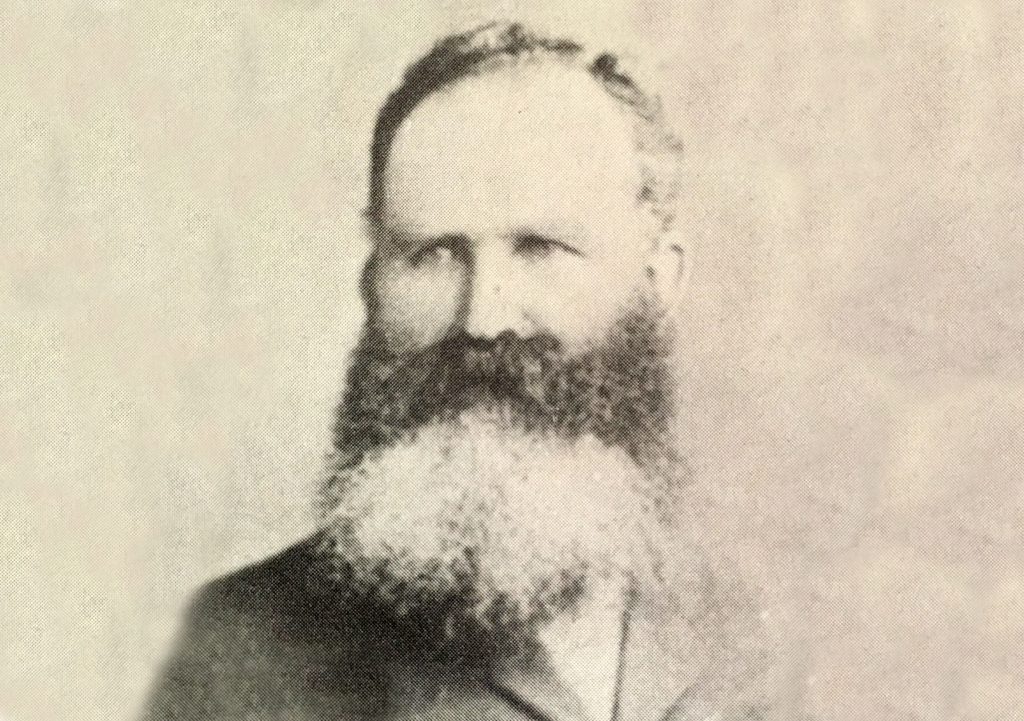
The Ovens Tannery is established by two young Irishmen – 23-year-old Dennis Hallahan and 22-year-old Matthew Dodd from County Cork. The tannery, which initially consists of four small buildings, is built adjacent to Gimlet Creek in remote bushland about 3km south-west of town, on what is now known as Malakoff Road and Old Tannery Road. Hallahan leaves the partnership after 8 years and Dodd’s brothers 30-year-old Thomas and 34-year-old John join the company. The Ovens Tannery becomes a major source of regular employment in Beechworth and remains under the control of the Dodd brothers for the next 30 years
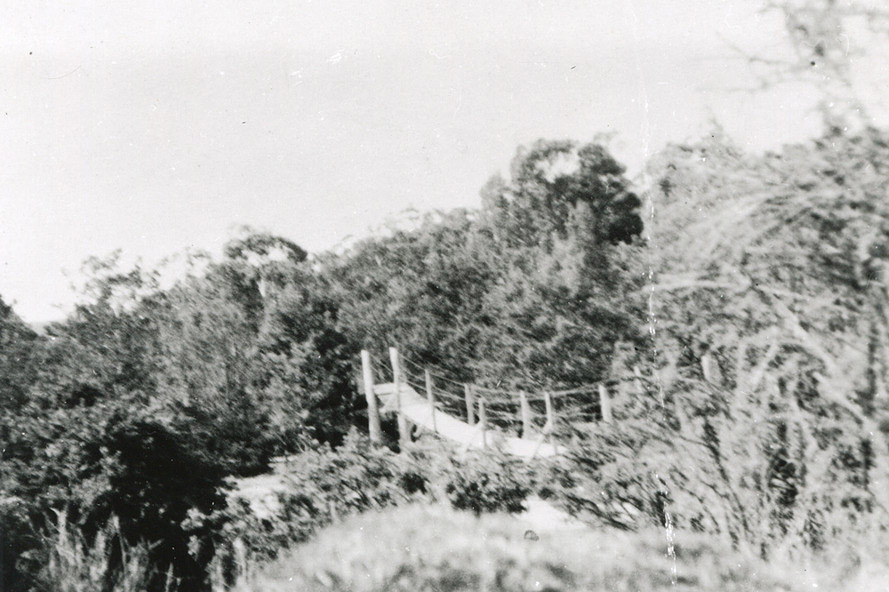
| Due to the remote bush location of the ‘Ovens Tannery’ beside Gimlet Creek south-west of Beechworth, a suspension rope and wooden plank bridge is built to span the gorge across Spring Creek so that workers who have walked the three kilometres from Beechworth through bushland can more easily reach the tannery. By 1870 a small village with gardens of vines and fruit trees has been created around the tannery, and by 1887 the Tannery employs fifteen men. |
1858

After serving 4 years as the town’s popular and high-profile Superintendent of Police, Robert O’Hara Burke departs Beechworth to take up a new position at Castlemaine.

| As a mark of gratitude before he is transferred to Castlemaine, Burke is presented with a set of pistols in appreciation of his service in Beechworth (above). One of these pistols will be found next to his body after his ill-fated 1860-1861 crossing of the Australian continent with William Wills. It is inscribed: “Presented to Captain Burke by the residents of Beechworth, Victoria”. |
1858

The New Ford Street Foundry is established by Alexander Rodgers in New Town at the entrance to Beechworth. The foundry is vital to the industry of the developing township and surrounding districts. The foundry stands close to the popular Mackenzie Family Store on the steep Newtown Hill.
| Alexander Rodgers will go on to twice serve as Mayor of Beechworth before becoming the ‘Superintendent of Works’ and ‘Borough Surveyor’ for the ‘United Shire of Beechworth’ in the early 1870s. His ‘New Ford Street Foundry’ will be taken by over by Mark Straughair and Scotsman John Laidley Duncan (below) in 1867. |

1858 – Aug 19
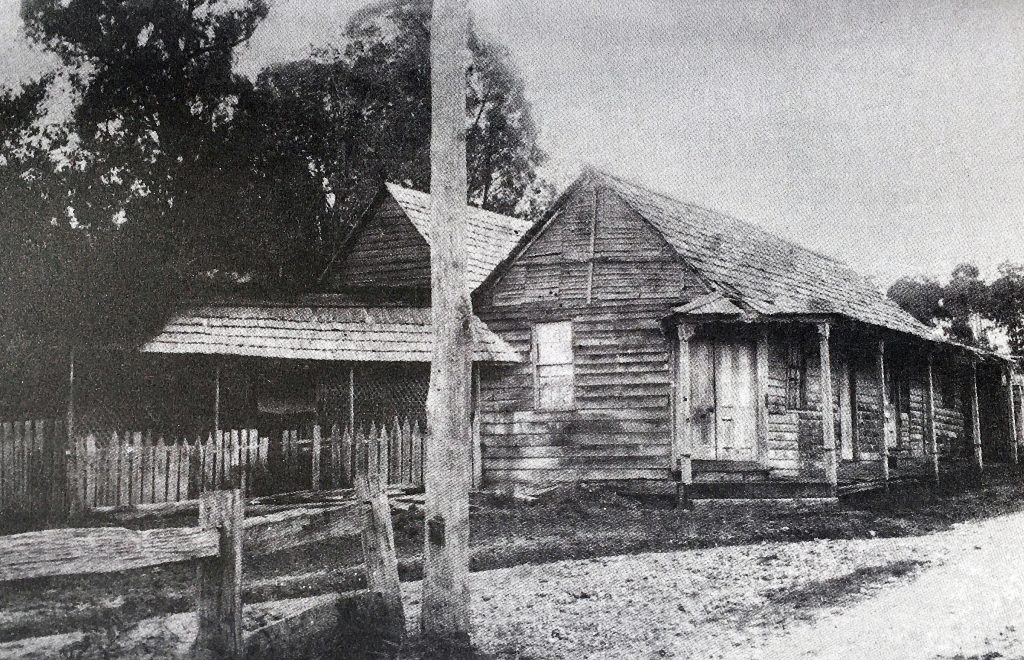
Having made decent money from their goldmining activities at the Silver Creek diggings, Edwin ‘Teddy’ Warden and William Henry Foster establish the Australian Arms hotel at the growing settlement of Silver Creek, 5km from Beechworth. In 1869 they will sell the hotel to George Ellis of Yackandandah for £300 and Warden will move into Beechworth where he establishes the Midland Counties Hotel (later known as Warden’s Hotel)
| In January 1872, George Ellis is advertising that the ‘Australian Arms’ hotel now has ‘swimming baths’ with “fresh water three or four times a week – two days reserved for ladies!” |
1858 – Sep
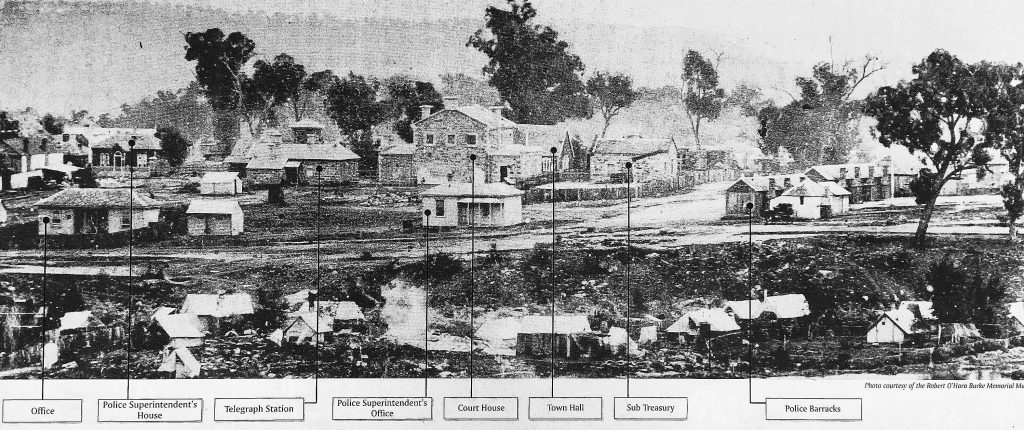
The Mining Surveyor reports a growing population in the Beechworth regional mining vicinity. It now stands at 12,343 people, up from 10,800 in June.
| However, much of the mining population are experiencing hard times and there are concerns about the restlessness surrounding Beechworth. Within a year, enrolment at the Catholic school falls by 30 pupils as miners depart for new goldfields. The Surveyor’s report suggests there have been few new leads or discoveries, and that many miners are simply reworking old claims and that not enough water is available for sluicing, with many miners resorting to rocking cradles for a hard-won income of 5/- per day. Were more sluicing water available, the report says, the area of Pennyweight Flat outside Beechworth, could sustain 1,000 miners for three years. |
1858 – Sep 22
Another new rush begins, this time after reports of gold discoveries along the Indigo Creek, 8km south-east of Rutherglen. The excitement about the ‘Indigo Gold Lead’ is intense and miners begin to abandon the diggings at Beechworth and the Woolshed to head to the ‘Indigo’. Carts start every morning, heavily laden with ropes, buckets, tools and swags, and every evening sees horsemen returning home elated with hope and crying out “It’s all right mates, it’s all right!”. Within four months there are over 12,000 miners on the field and numbers grow over the next few months to an estimated 20,000. A gold town of hessian and canvas, sly-grog shops and 32 hotels are established.
| By the end of 1859 it will all be over. The easily-obtainable gold from the ‘Indigo Gold Lead’ had been worked out and the majority of alluvial miners will push on to other fields. |
1858
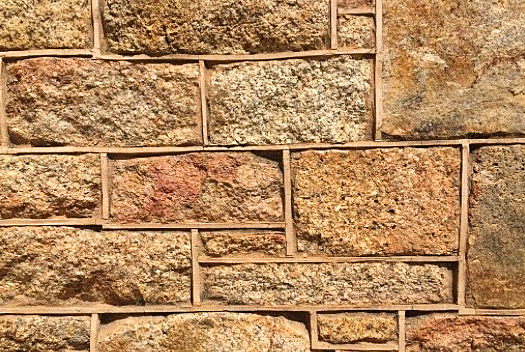
Following the suicide of prisoner John Williams – who drinks strychnine in front of a guard at the Stockade in 1857 – and the growing number of prisoners, it is decided to replace the now outdated wooden Beechworth Stockade with a bigger, stronger granite Beechworth Gaol. It will be built around the existing wooden Stockade huts (which will later be demolished). Work begins on the construction of the first section – two Cell Blocks radiating from a central Observation Tower. Originally designed to have five two-storey wings, it will be scaled back to just two wings, an observation circle and an administration wing, due to high costs and an over-estimation of the number of potential prisoners. Fireplaces will be built to provide heating for prison staff, while the cells have no heating. Each of the two Cell Blocks will have a fireplace in the roof space, but this will be used to draw stale air out of the building, and louvered ventilators will also be built on the roof of each cell block (later replaced by skylights). The two Cell Blocks will take in their first prisoners at the start of July 1860, with staff quarters, watch towers, perimeter walls, entrance gateways, underground water tanks and cesspits completed over the next few years, although the gaol will not be fully completed – with a watch tower behind the north-eastern cell block – until 1873.
| The cells in Beechworth Gaol are not sewered and remain so until 1993. Prisoners – both male and female – use buckets for toilets which they have to take out of their cell each morning and empty into a trough in the exercise yard. |
1858

The (much disliked) 1853 timber Beechworth Post Office, on the corner of Camp and Fords Streets, is replaced by a single-storey granite building at the same location in the centre of town. The new Beechworth Post Office features a slate roof and a triple arched arcade. Like the earlier building, postal services are conducted through an open window onto the arcade’s arches. A square granite tower with provision for a clock is set above the arcade.
| Funded by public subscriptions, the clock is imported from England in 1860 and finally installed into the post office tower in 1862. |
1858
Successful Beechworth jeweller and businessman 26-year-old Thomas Taylor Ladson and his wife of three years, Mary Ann Crawford, move to Tarrawingee to open a post office in the small settlement 21km from Beechworth.
| Thomas and Mary Ladson will have 13 children but, tragically, only one of them – a daughter named Miniam – will survive to adulthood. Most of the children – born between 1864 and 1913 – will die from tuberculosis. |
1858
Beechworth Council, assisted by the Central Board of Health, secures a public garden – ‘The Botanical Reserve’ – of 18 acres and let a contract for fencing, with a main gate and turnstile. It will eventually feature a picket fence; an ‘Acacia Walk’ along Sydney Road; a rotunda; a bowling green and even an open-air theatre, showing silent films from the early 1900s.
| Known by many locals simply as ‘The Rock Park’ and the ‘Giant’s Grave’ for its large granite dome, since 1891 it has featured two cannons mounted on top and facing to the South. It will be officially named ‘Queen Victoria Park’ in 1902 in memory of the recently deceased Queen. It is also known as ‘Beechworth Park’. |
1858 – Nov
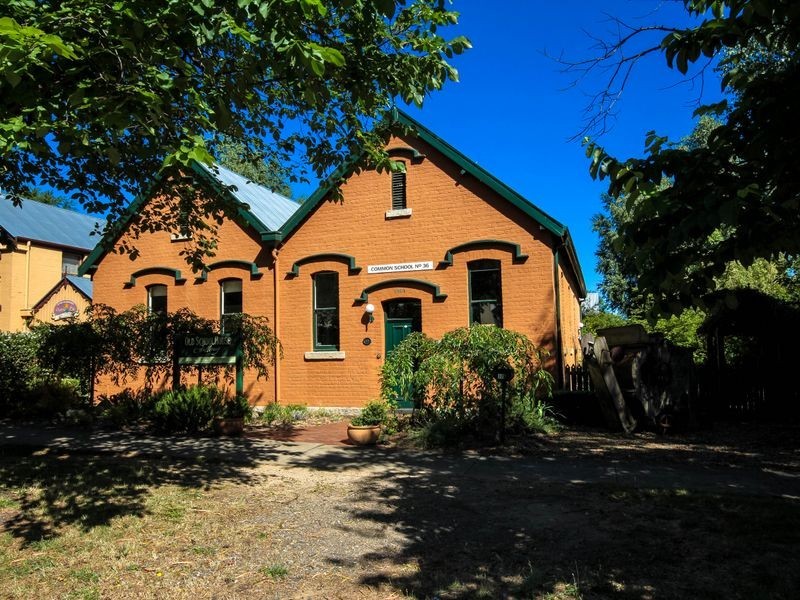
For some time, the citizens of Beechworth have been lobbying the government to establish a public school, as the only schools in the town have been conducted solely by the denominational schools of the Church of England, the Methodists, Wesleyans and St. Joseph’s Catholic School (opened in 1857). Finally the first government school – the Beechworth National School – opens with 65 pupils in a small building on Loch Street, before moving to a slightly larger building on Ford Street near the Wesleyan Methodist Church. In 1861 it will move again, this time to a purpose-built schoolhouse at 17 Loch Streetand be renamed ‘Common School No. 36’ in 1862. The school’s new red brick building – which still stands today (above) – is designed by Thomas Dalziel. The school will go on to be re-named the Beechworth Academy before being taken over by the Education Department in 1873 but, within two years, it has outgrown the building at 17 Loch Street.

| Once the new ‘Beechworth Primary School’ is completed in 1875, the original red brick school building in Loch Street will become the office of the ‘Ovens & Murray Advertiser’ newspaper (above in 1900). The building is now a private residence. |
1858 – Nov 19
Mrs. Mitchell, wife of the landlord of the Foundry Hotel at Newtown, receives a blow to the head after intervening in a group of men who are “quarrelling and fighting in the bar” and dies from her injuries four days later. One of the men, blacksmith George Dowdon, is apprehended and committed to trial on a charge of manslaughter.
1858 – Dec 2
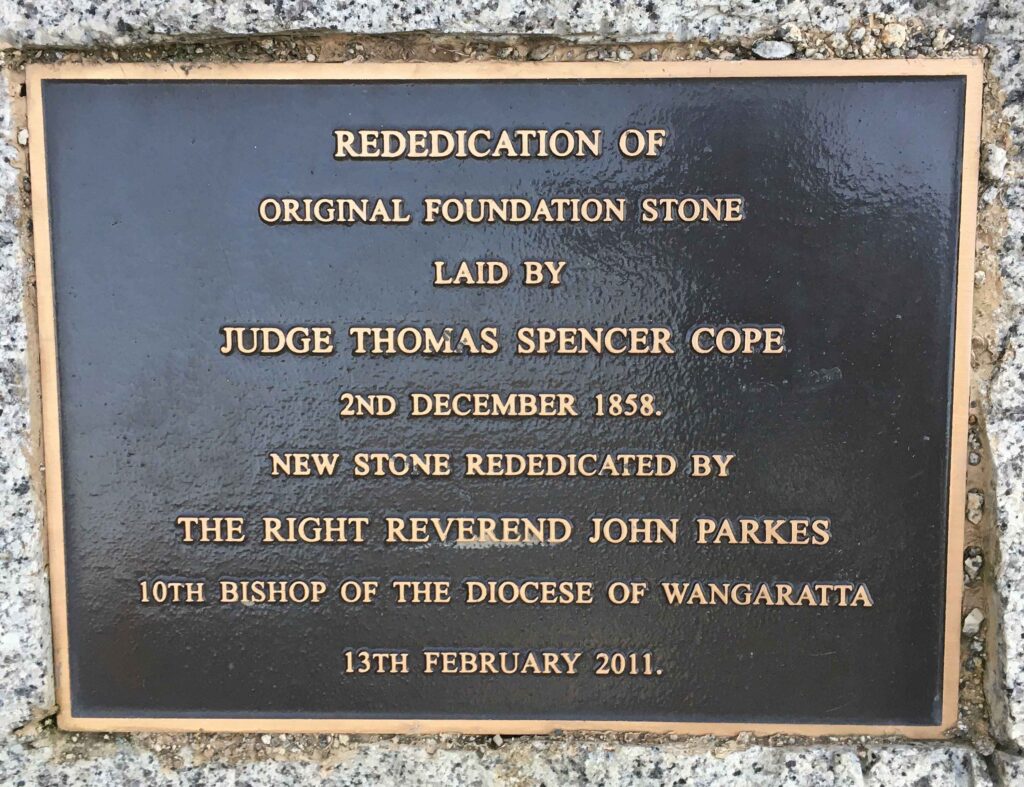
The Foundation Stone for the first stage (the nave) of Beechworth’s Anglican Christ Church is laid by Court of Mines and County Court judge Thomas Spencer Cope, chair of Beechworth General Sessions. Located on a landmark position – the crest of Ford Street (on the corner of Church Street) – it is to be designed by local architect James Dobbyn and constructed by Stevens and Balfour. Built using local granite – hand-chiseled and cornered on site – the Victorian Government will provide two-thirds of the cost.
| The stone and brick 1857-built Hall to the rear of the new building is used as both the church and a Sunday school until Christ Church is completed at the start of October 1859 (see further entry below). |
1859
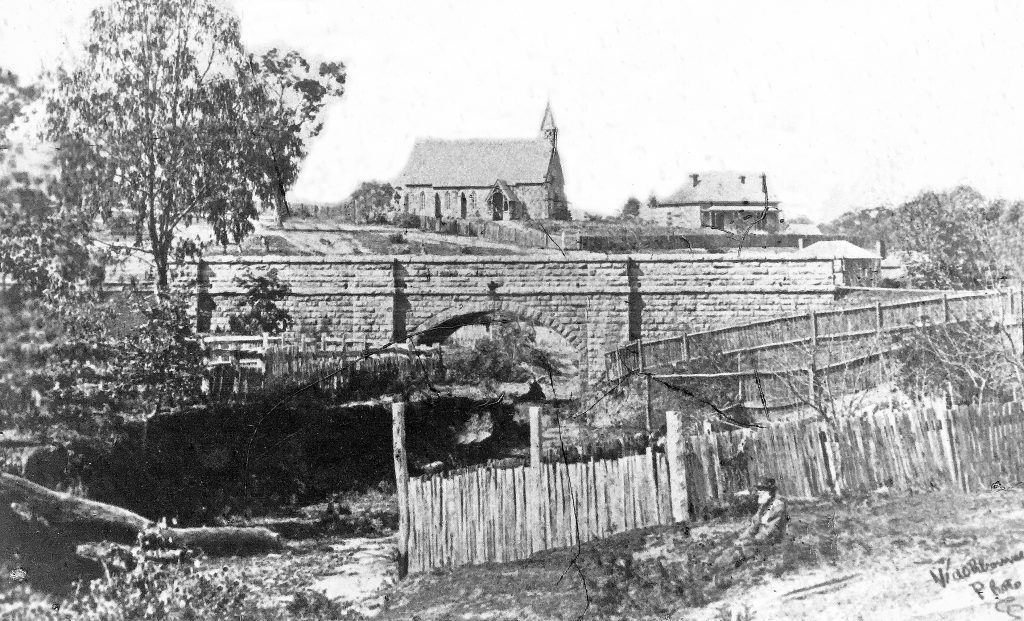
A stone bridge is constructed to allow easier crossing over Commissioner’s Creek at Yackandandah on the main Melbourne to Sydney route, via the Beechworth goldfields. However, not long after the completion of the bridge, authorities agree the grade is easier and flatter near Chiltern, so the main route is changed. Coaches travelling to Sydney begin to bypass Beechworth and hilly Yackandandah and instead travel between Wangaratta and Wodonga, via Chiltern … the route that will become the Hume Highway. Despite this, the fine stone Yackandandah Bridge still stands today and is on the register of the National Estate, the Victorian Heritage Register and is classified by the National Trust.


1859

The Reverend John Kennedy MacMillan – who had arrived in Australia from Inverness in Scotland in 1858 with his new Scottish bride Janet Manson Clarke – becomes the new minister at Beechworth’s St. Andrew’s Presbyterian Church. 27-year-old McMillan will remain at St. Andrew’s Church until 1869, during which time he also establishes Presbyterian congregations at Bright, Benalla, Chiltern, Mansfield, Wangaratta and Yackandandah.
| In the 10 years they are in Beechworth, John and Janet MacMillian will have four children, three sons – Duncan Ballantyne, Alexander Ronald, Eric Cope and a daughter Maryann Kennedy. MacMillan is a strong advocate of the Education Act. The MacMillan’s will move to Hamilton in 1869 and the Reverend John Kennedy MacMillan will become moderator of the ‘Presbyterian General Assembly of Victoria’ in 1878. |
1859
With all the miners now digging at the ‘Indigo Gold Lead’, the small settlement of Indigo begins to grow along the Indigo Creek and it will become one of three small gold-mining villages located at intervals of about 1 km on the ‘Indigo Gold Lead’, the others being Cornishtown and Christmastown.
| In 1865, ‘Bailliere’s Victorian Gazetteer’ describes Indigo as “a postal and road board town situated among several gold diggings”. There is an Indigo Mining Division with 1,634 miners, over a third of them Chinese, mainly working alluvial claims. The ‘Shire of Indigo’ is created in 1994. |
1859 – Feb 19

Realising that the ‘Indigo Gold Lead’ is starting to run out, John Connors and his prospecting party travel about one mile from where they have been digging – with thousands of others – along the Indigo Creek and travel to a small settlement known as ‘Black Dog Creek’ (reputedly because a black dingo is shot by a white settler in the area in the 1830s). They promptly discover gold and word quickly reaches Beechworth, 15 miles away, with many miners deserting Beechworth for this new find, and the small town grows very rapidly and quickly christened ‘New Ballarat on the Lower Indigo’ until it is given the official name of ‘Chiltern’ (after the Chiltern Hills in England) when the first post office opens in September on 1st 1859. Chiltern’s first town allotments go on sale on September 20th 1861.
| At its gold-mining peak, Chiltern’s population will swell to almost 20,000 with numerous mines working full shifts. One of them, the ‘Chiltern Valley Mine’ will produce an impressive £1,250 of gold between 1878 and 1914 when big mining operations in the town cease. |
1859
While most miners give up on the ‘Indigo Gold Lead’ after realising the ‘easy finds’ are becoming exhausted, a few miners remain and decide to sink a shaft (now in Chiltern Park) and will soon strike the ‘Chiltern Gold Lead’. A new rush begins, until these leads become too deep, and the water too difficult to remove for the small parties to continue work. It is then left to larger companies to recover the deeper gold through the use of better lifting and pumping gear. Shaft depths of 80 to 150 metres are common. Some of the companies which work the field are ‘Barambogie’, ‘Chiltern Valley Consols’, ‘Great Southern and Chiltern Valley United’, ‘North Prentice’, and the ‘Chiltern Scotchman’s Company’.
1859
Many nearby towns are still known by the original ‘white-settler’ names – Separation (Shepperton), Belvoir (Wodonga), New Ballarat on the Lower Indigo and/or Black Dog Creek (Chiltern), Barkly (Rutherglen) and Morse’s Creek (Bright).
1859

27-year-old Hiram Allen Crawford is joined at his Beechworth coach firm ‘H.A. Crawford and Co’ by Irishman Michael “Mick” Connolly who manages the firm’s horses. They will soon open a new coach booking office at 44 Ford Street, with stables and a large coach house at the rear of the Commercial Hotel, followed by their own stables in Wangaratta. The company will eventually be renamed ‘Crawford and Connolly’. Both great innovators, Crawford and Connolly will develop massive 16-seat coaches to carry more passengers per trip – with an extra brake to handle the steep north-east Victorian roads, especially the Buckland Gap! ‘Crawford and Connolly’ coaches eventually run all over North-East Victoria and into New South Wales and will become the longest running and most successful coaching company in Victoria.
| Sadly, Michael ‘Mick’ Connolly will die young, but Hiram Crawford will continue the ‘Crawford and Connolly’ business with Mick’s brother Thomas Augustus Connolly, who will become managing director of the firm. |
1859 – Feb 25
The Beechworth Council’s Botanical Garden Committee select a design from five competition entries for the layout of the new Botanical Reserve. The winning design is by Hungarian photographer and artist, Beehworth citizen Julius Albert von Rochlitz. By November the Council has received a government subsidy of £300 for work on the garden. Prison labour is employed to help clear the site and by February 1861 the first exotic trees are planted and one pathway has been completed, with another to be formed parallel to High Street.
| It is unclear whether Rochlitz’s design is ever fully implemented. The ‘Botanical Reserve’ suffers from neglect for most of the 19th century. In September 1876 the Ovens and Murray Advertiser’s article on the primary school, newly erected in part of the Garden, observes: “Beyond the school lies the other half of the so-called Botanical Reserve. It was bad enough before, but now, by contrast it is simply abominable and disgraceful”. |
1859 – Jun

A tree is planted on the corner outside the Beechworth Post Office, growing to become a well-known landmark at the ‘centre’ of town. As it grows larger and the trunk gets thicker, it will replace the ‘But-But Tree’ in Tanswell Street as Beechworth’s unofficial “noticeboard”, with locals pinning, nailing and tacking thousands of signs into the large tree’s trunk.
1859
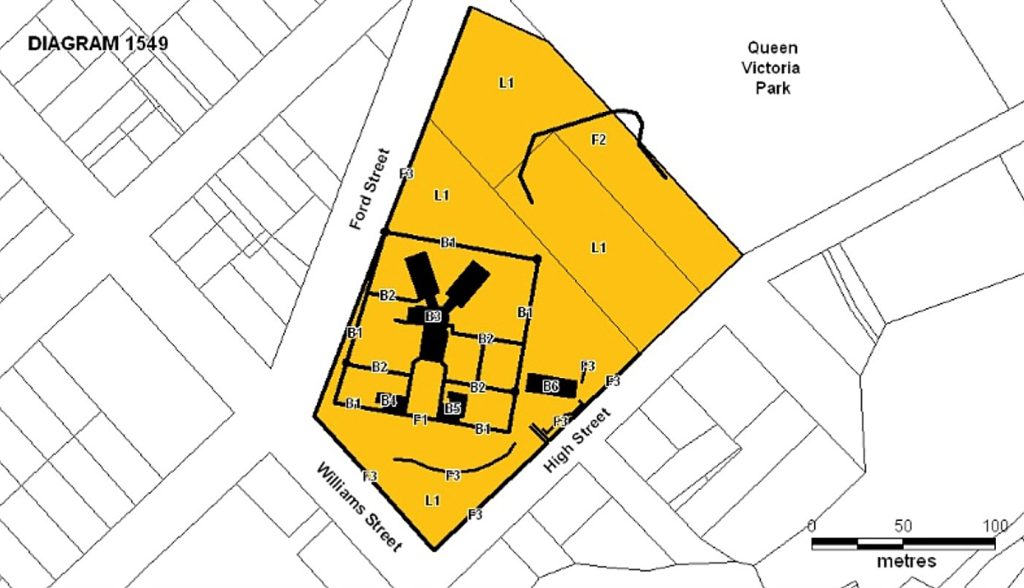
Work continues on the construction of the new Beechworth Gaol using granite quarried, on site, by inmates of the Beechworth Stockade – as part of their ‘hard labour’ – under the watchful eye of Prison Guards and Stone Masons. The cost to the Victorian Public Works Department will be £46,763 (roughly $3.7 million today), with work contracted to H. Dalrymple and George Simmie. The Beechworth Gaol is originally designed by architect Carl Gustav Joachimi (the Old Melbourne Gaol, Pentridge Prison, Victoria Barracks, Benalla Courthouse), based loosley on Sir Joshua Jebb’s model prison in Pentonville, although William Wardell of Melbourne will become the chief architect from 1859 and will have the final say in design decisions. Beechworth Gaol will be one of nine prisons constructed around Victoria between 1859 and 1864.

| The Gaol’s slate roof – which sits on top of a solid brick roof completely enclosing the space beneath – will be replaced by corrugated iron laid on wooden battens in 1925. |
1859 – May 22
Protesting the Victorian government’s new ‘Chinese Poll Tax’, between 300 and 500 Chinese miners and storekeepers gather outside the ‘Shang Yick’ store at Beechworth to stage a rally. They resent having to pay the £4 tax which clearly discriminates against them. In the days leading up to the rally, Chinese placards circulate around Spring Creek warning their countrymen not to pay the new ‘residence tax’ and threatening those who do. An elderly Chinese man is observed urging a ‘knot’ of his countrymen to go to prison rather than submit to the tax. To lead the rally, noted orator and agitator, Pig Mon, arrives from Bendigo and urges the Beechworth Chinese to take action as the miner’s had done at the Eureka Stockade (for a different tax four years earlier). As the Sunday morning rally swells, Sergeant Kelly arrives on the scene and drags Pig Mon back to the Beechworth Stockade as reinforcements rush from Beechworth to curtail any ‘molestation of the police’. Twenty or more Europeans armed with ‘sticks’ stand at the edge of the camp, ready to assist police. Twenty-four Chinese later appear in court and receive fines for failure to pay the tax, while one receives three months imprisonment with hard labour. Pig Mon is fined £20 and returned to Bendigo.
1859
The Municipality of Albury is formed with the first meeting of the new municipal council held at the Rose Hotel on Kiewa Street on July 27.
1859
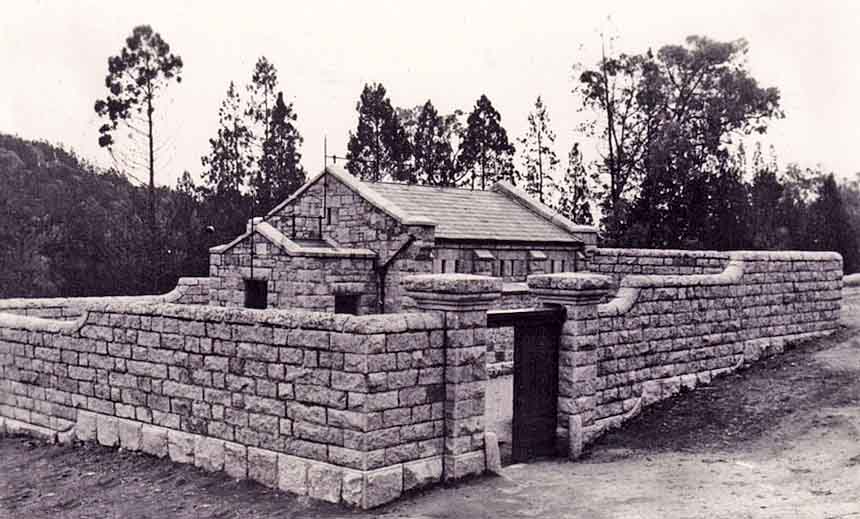
The Beechworth ‘Powder Magazine’ is constructed by T. Dawson and Company as a place to safely store all the gunpowder used by miners. A different building firm, Atchison and Lumsden, is employed a year later to construct the massive walls around the building. Total cost is £1,500. Holding large quantities of gunpowder, the building’s safety features include double arched foundations and an arched inner roof, which will deflect any explosive blasts upwards, minimising damage. Also, a series of lighting conductors, ventilation and heavy granite walls are incorporated into the design. It will operate for almost 60 years without an explosion ever taking place!
| The ‘Beechworth Powder Magazine’ is one of many constructed by the government for the storage of gunpowder. Beechworth companies such as the ‘Rocky Mountain Extended Mining Company’ store their black gunpowder in the ‘Powder Magazine’, always keeping records and receipts for the expense of storing their powder in the solid building with the ‘Post-Keeper’. The ‘Post-Keeper’ is a part-time position, as the building is only used on request. As mining decreases in the area at the start of the 20th century and the invention of nitro-glycerine compounds become more commonly used, the ‘Powder Magazine’ eventually stops being used in 1918 and falls into disrepair. |

1859
Religious differences – particularly Protestants and Catholics – continue to simmer. In a court appearance, the magistrate is told that Helen O’Brien and Ann Brady argued in public, exchanging the words “bloody God-damned Protestant” and “Papist whore”. Ann Brady is fined £3 with 8/6 costs, plus a £25 surety on both women to ‘keep the peace for 6 months’ and both are locked-up until their sureties are paid.
| The 1861 census lists the following for the township of Beechworth – Church of England, Protestants: 384, Presbyterian, Church of Scotland: 302, Catholic: 344, Wesleyan Methodists: 272, and Congregational Baptist Lutheran Unitarian: 160. |
1859
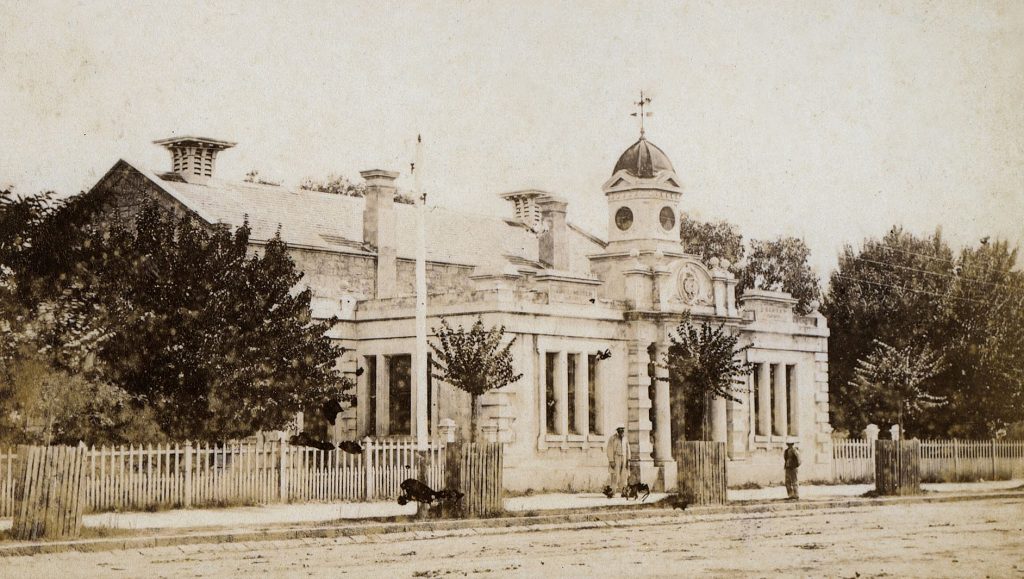
With the Beechworth Council Chambers and Clock Tower completed at 103 Ford Street, a new tender is announced … to build a formal Town Hall behind the Council Chambers. The tender is awarded to architects J.J. Coe and Thomas Dalziel and built in granite by local contractors Donald and William Fiddes. The formal hall is designed in a classical idiom and will consist of five bays intersected by pilasters. However, as plans for the new building are being designed, things change when the Council acquire a new Fire Engine which they decide should be housed under the new Town Hall. The building plans are quickly altered, and the height of the building is raised accordingly to accommodate the Fire Engine. To obtain further funds to complete the new building, the Council offers the use of the Hall as a second Courthouse, and the project proceeds as a joint “Town Hall and Courthouse”. It will now include three small ‘holding cells’ in the basement (next to the ‘Fire Engine House’) with a small staircase leading directly from the cells up to the Town Hall so that prisoners can be brought up to appear before a magistrate in the ‘Court of Petty Sessions’. While the Formal Hall still stands today (below), the Council Chambers at front of the building will be replaced by a larger two-storey building in 1888.


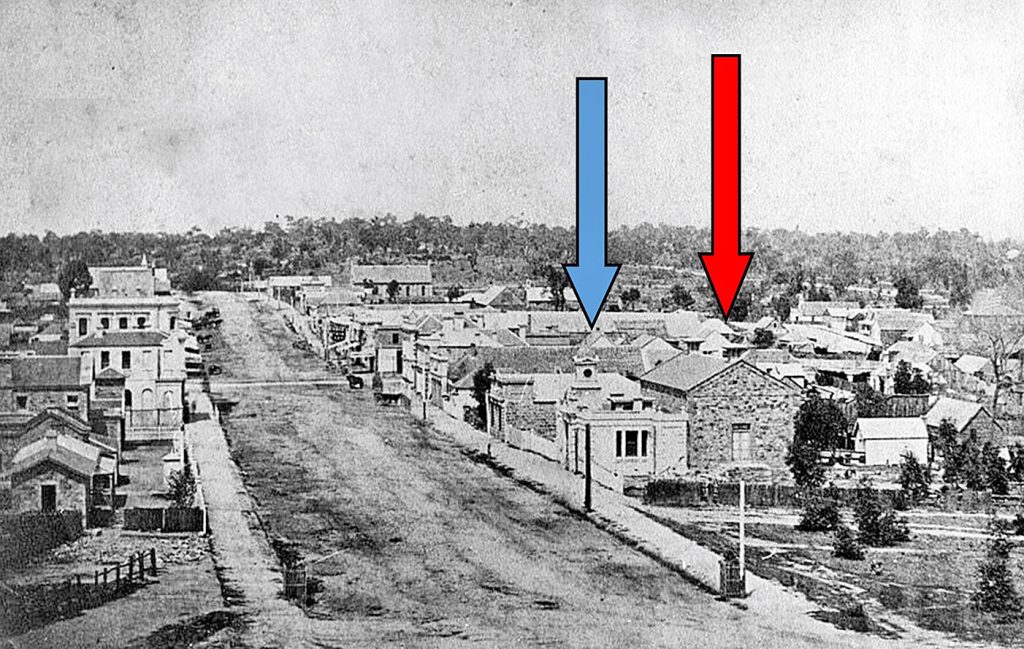
1859

With the opening of the Council Chambers and the construction of the new Town Hall, and a growing number of other important buildings – including the Bank of Victoria, the Ovens Goldfields Hospital and the new Courthouse, Beechworth becomes the major administrative centre for the whole of north-east Victoria.
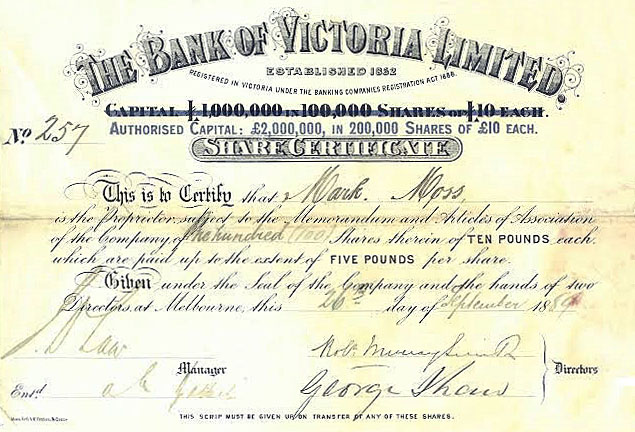
1859
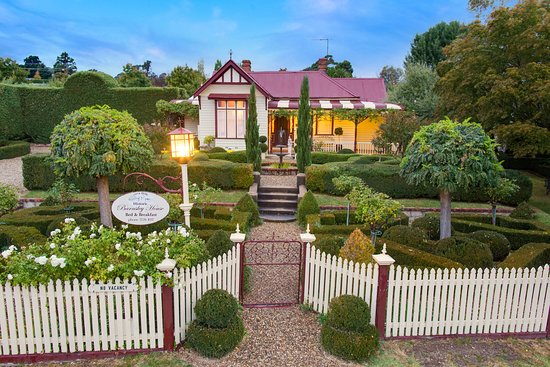
Robert Barnes – owner of a popular Beechworth grocery store and a photographic shop, and a stalwart of the town – builds a beautiful weatherboard family home at 5 John Street, just across the tailings-strewn gully from High Street. In 1987 the house is fully restored, and new landscaped formal gardens are added, and the property is named Barnsley House.
1859 – Aug
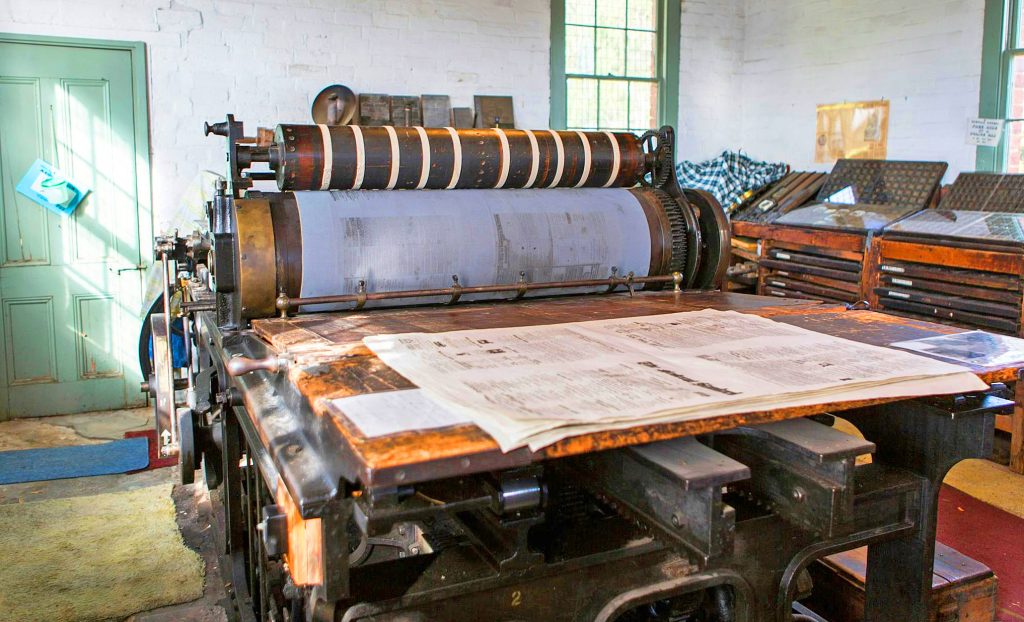
Publishing of Beechworth newspaper The Constitution and Ovens Mining Intelligencer is moved to the printing press at the newly established Chiltern Standard newspaper and Printing Works in Chiltern. The Constitution and Ovens Mining Intelligencer will cease daily issues on March 28, 1863.
| ‘The Chiltern Standard’ – established by Felix Ashworth, George Boyer and George Henry Mott – has its first issue printed on August 24, 1859, and will later be renamed the ‘Federal Standard’. It is published in conjunction with George Mott’s other newspapers – Albury’s ‘Border Post’ and Beechworth’s ‘Constitution and Ovens Mining Intelligencer’. The three newspapers – which often share some of the same stories – will become fully owned by Mott whose descendants will be involved in the publishing of some 45 newspapers throughout Victoria – almost without interruption – for the next one hundred years. The Mott family will launch what is now Albury’s ‘Border Mail’ on October 23, 1903. |
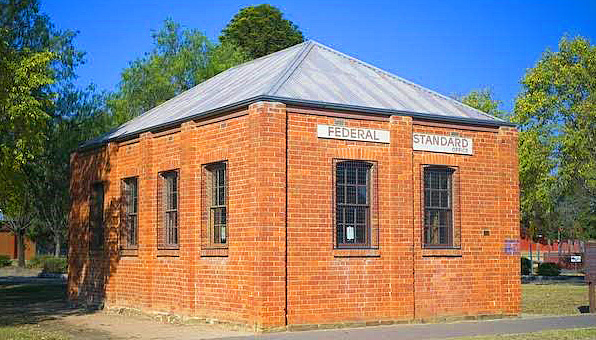
1859 – Aug

Having successfully planted various vegetables and flowers at his ‘Beaumont Farm’, Philip Le Couteur now starts planting vines and “the first vinegar plant in Beechworth”. Jersey-born Le Couteur also breeds what he calls ‘Fleury’ Jersey cows, renowned for the quality of their milk, and supplies fresh milk to many families in Beechworth.
| In about 1815 Thomas Le Couteur had married Elizabeth Fleury which probably gives rise to Philip Le Couteur naming his Jersey milking cows ‘Fleury Jerseys’. |
| Much of the land where Beechworth Secondary College, The Beechworth Motor Inn and the Beechworth Hospital now all stand along Sydney Road was originally owned by the Le Couteur family and their Beaumont Farm. Fleury Court behind the Hospital is named in honour of the Le Couteur family and their milking cows, as is Beaumont Drive. |
1859 – Sep

25 km from Beechworth the first (small wooden) Chiltern Post Office opens before being replaced by a brick Chiltern Post Office in 1863. It still stands and operates today.

1859 – Sep 5
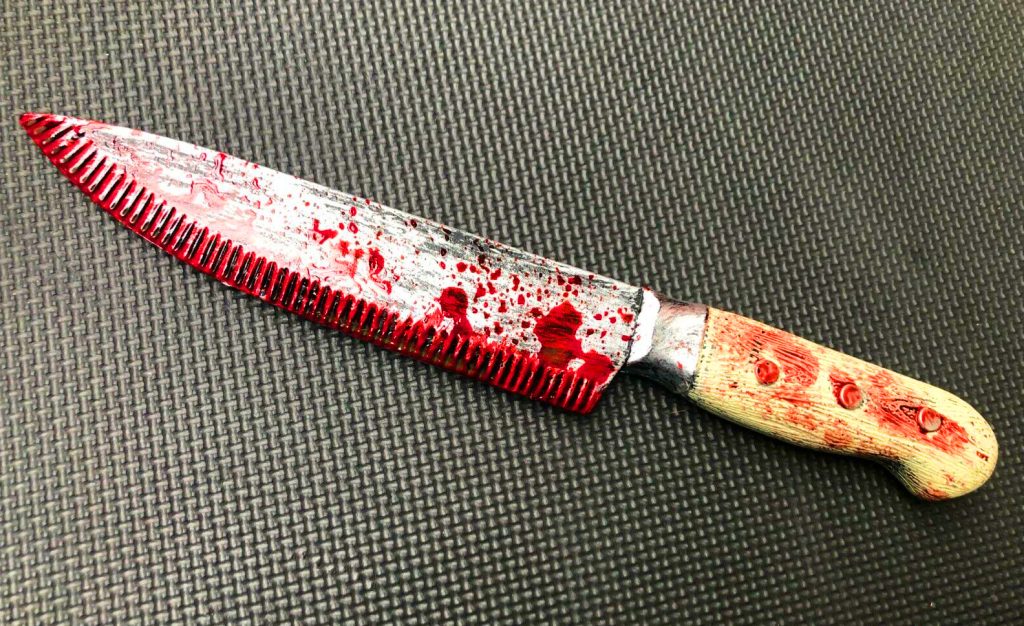
Tragedy strikes at the Star Theatre when 29-year-old actor James Coyne Riley (stage name James C. Campbell) is accidentally stabbed by his leading lady during a production of “The Flowers of the Forest”. Although it is assumed after the performance that he has not been seriously injured, Riley becomes more and more ill as infections from the stab wound spread and, as death seems imminent, he marries his 7-months pregnant sweetheart Mary Ann Lake (a seamstress with the theatre company) in a bedside ceremony on January 17th, 1860, then dies two days later on January 19.
1859 – Sep 6

William Thompson Soulby, owner of the Victoria Hotel on High Street, opens his brand new London Tavern – Beechworth’s first “men only” hotel – on a quarter-acre block on the corner of Camp and Finch Streets. Arranged around a courtyard with a verandah, it is the first complete brick and stone hotel in Beechworth and includes public rooms at the front and bedrooms opening off rear verandahs, with all rooms ‘plastered throughout’. The bedrooms all feature 13 foot high ceilings. In 1862 further structures are added, including an new accommodation wing and a bath house in the courtyard – at a time when separate bathroom facilities in goldfield hotels are rare. The bath house also doubles as a ‘Summerhouse’. The new additions also incorporate ‘Judge’s Apartments ‘which are larger and more lavishly decorated rooms for ‘any visiting members of the judiciary’. The ‘Tavern’ at at 43 Camp Street quickly becomes one of the most popular hotels (for men) on the Beechworth goldfields.

| Over the following 40 years a number of judges, including Sir Redmond Barry and Sir William Stawell, often choose to stay in the warm comfort of the ‘Judge’s Apartments’ at the ‘London Tavern’, rather than the cold austerity of the Judge’s Rooms at the Courthouse. |
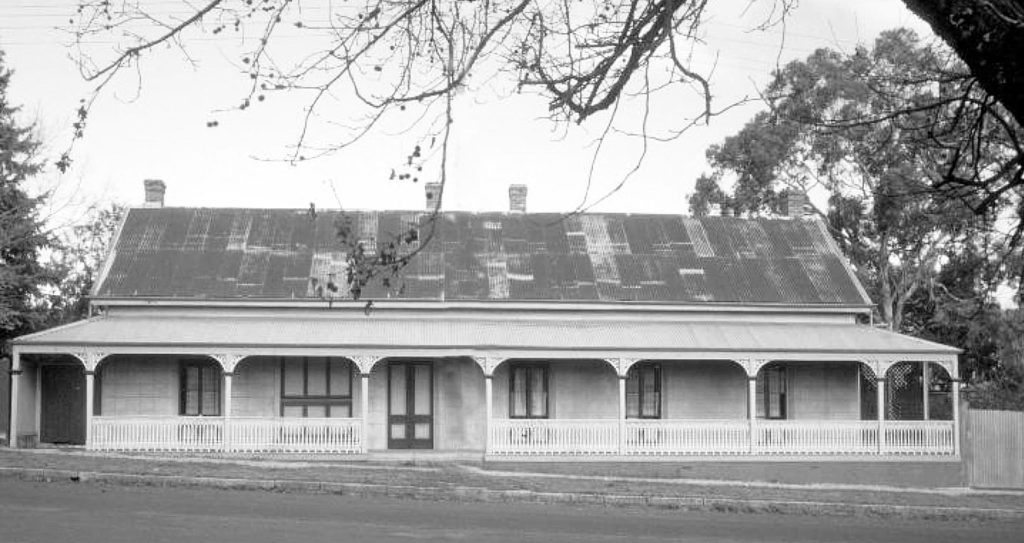
1859
Beechworth traders Gray and Co. recognise the commercial value of the local Chinese population, displaying ‘two placards in Chinese characters’ in their shop window advertising that they sell ‘sundry Chinese fixings’. The Constitution and Ovens Mining Intelligencer reports that Gray and Co. have for, “the first time since the Asiatic element entered upon these diggings, acknowledged the uses and advantages of Chinese as customers”, suggesting “the next step will be the issue of a Chinese Newspaper”.
1859
After the failure of the ‘Brown’s Folly’ water scheme, the Beechworth Municipal Council accepts a recommendation from Surveyor Henry Grimes to build a dam at Hurdle Flat Swamp. However, this is fraught with issues. The area contains several private springs and is under the control of the Mining Board, with a number of leases already sold. After making the area into a reserve, Council’s application is turned down.
1859

George Briscoe Kerferd, chairman of Beechworth’s Municipal Council, proposes that William J. Turner, the respected Beechworth Watchmaker and Jeweller, should arrange for the purchase of a large clock for the Post Office tower, built in 1858. Funded by public subscriptions, it will be purchased from England at a cost of £150, payable over two years. Kerferd states that the clock “will be heard at a distance of two miles” and he will “apply to have the post-office tower raised”. The clock is finally installed in 1862 and is to have four faces (later just three faces), each three feet in diameter. In 1911 the clock faces are painted black with silver numerals.
1859 – Sep 16

– Foundation Stone laid on September 16 1859
The Foundation Stone is laid for the Beechworth’s Lodge of St. John Masonic Hall at 19 Loch Street, and the building will be completed in 1860 ready for its first official meeting. Today it is the longest continuously used purpose-built Freemason Masonic Lodge in Australia.
1859

‘Constructed of 400 tons of granite – carted from Beechworth by bullock-wagon – 66-year-old Reverend Joseph Docker’s magnificent ‘Bontharambo‘ mansion – dominated by a sixty foot tower – is finally finished and a lavish Grand Ball is held to celebrate the occasion. Designed by architect Thomas Watts, the two-storey Italianate mansion has taken two years to complete – at a massive cost of £19,000 – and stands proudly on Docker Plains – fifteen square miles of land on the north side of the Ovens River, 10 km from Wangarratta. The vast property features several other buildings including the original smaller homestead, a Chinese gardener’s cottage, a private family cemetery, along with stables and other outbuildings. Docker plants an orange grove, 35 acres of vineyards for wine production, an olive grove covering 8 acres, a large acreage under crop, and herds of sheep and cattle as well as stud horses.

| ‘Bontharambo’ remains in the possession of the Docker family to this day and has become famous for its stud of ‘Aberdeen Angus’ cattle. The house is preserved in almost its original state, but the pioneer’s vineyard, orange grove and some other features have disappeared. Docker dies on 10 April 1865 at the age of 72, survived by six of his eleven children. |
1859 – Oct 2

With the first part of the new Anglican Christ Church completed at 29 Church Street, the inaugural service is held in the church on this Sunday morning. Before the new church’s construction, services had been held in a tent, followed by the church hall, which still stands behind the new church today.

| A castellated 17 metre-high square tower (above) and a polygonal apsidal chancel will be added in 1864 as will a set of beautiful stained-glass windows dedicated to early parishioners. The original church at the rear of the new church continues to be used as a hall, adjoining the ‘Beechworth Grammar School’ established in 1856. |
1859 – Nov

Standing well over 6 feet, 33-year-old Edward Thomas Barnard, formerly a Gold Commissioner in Bendigo, arrives in Beechworth to take up the position of Resident Warden and Coroner. He will also become a Police Magistrate and Justice of the Peace.
| In 1865, Barnard becomes involved in a dispute with Judge Thomas Spencer Cope – allegedly caused by the wives of two men – during which Barnard strikes Judge Cope. This unforgiveable “breach of manners” leads to Barnard being forced to leave Beechworth. Despite this ‘black mark’ on his reputation, Barnard Street in Beechworth is named in his honour, while no street is named after Judge Cope! |
THE STORY CONTINUES IN THE 1860-1869 TIMELINE